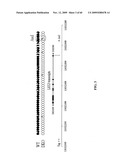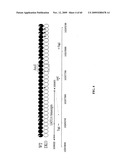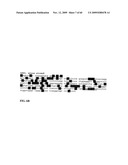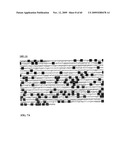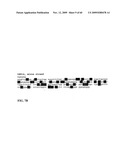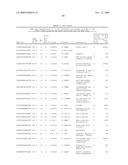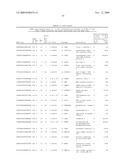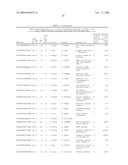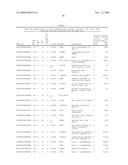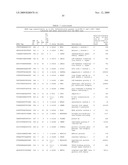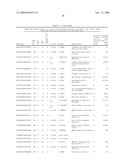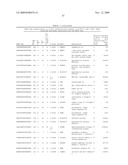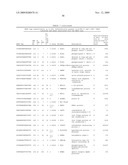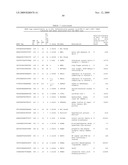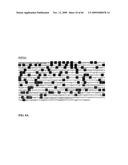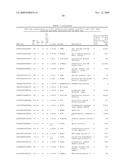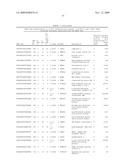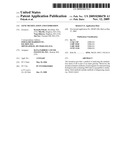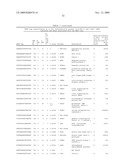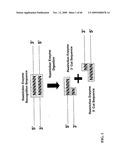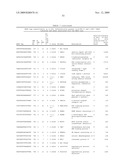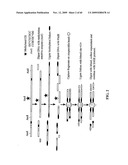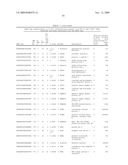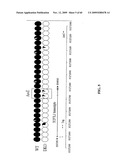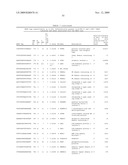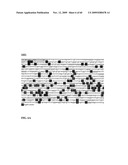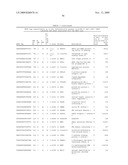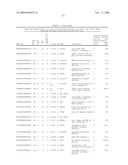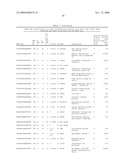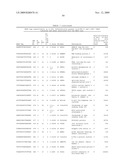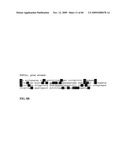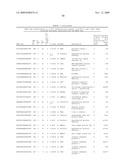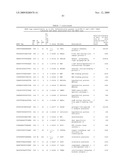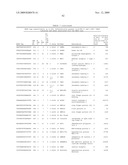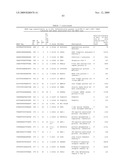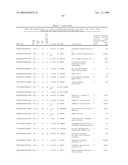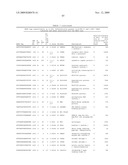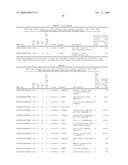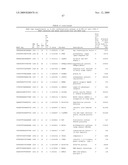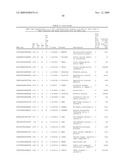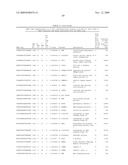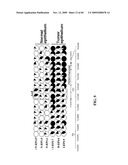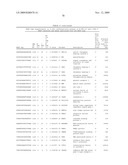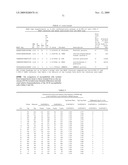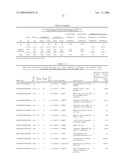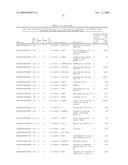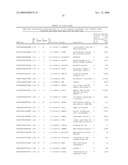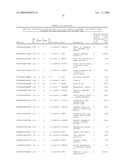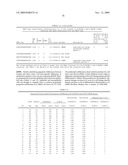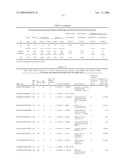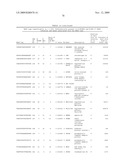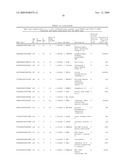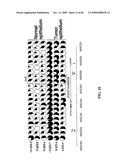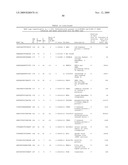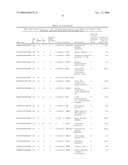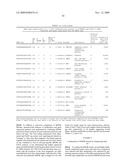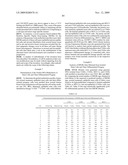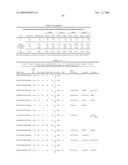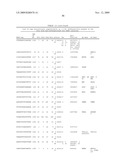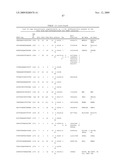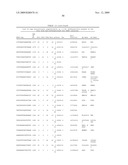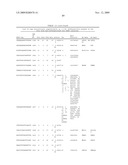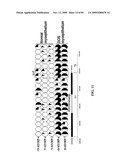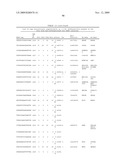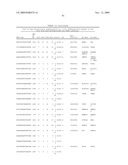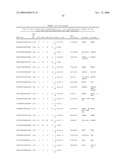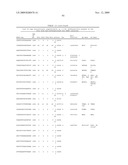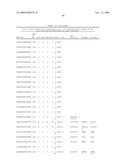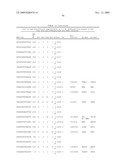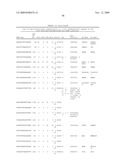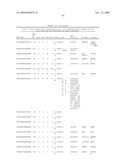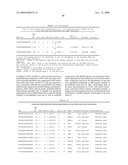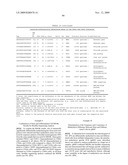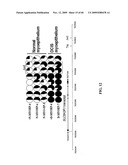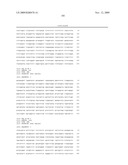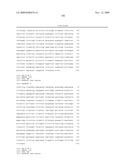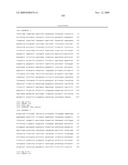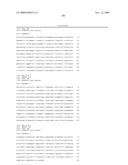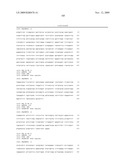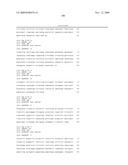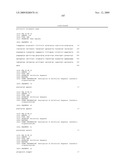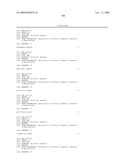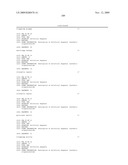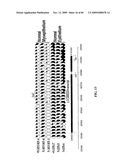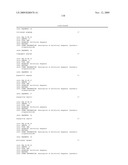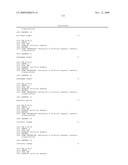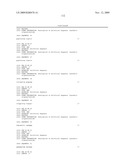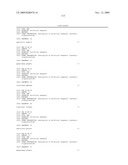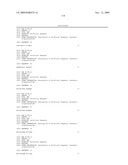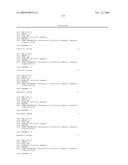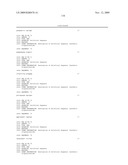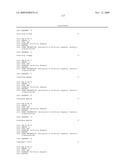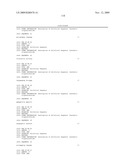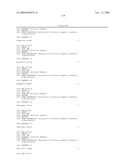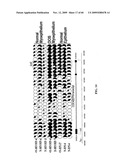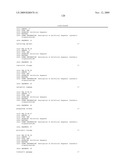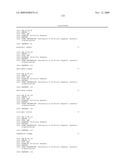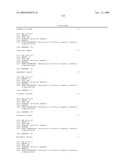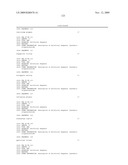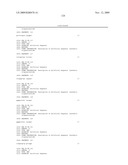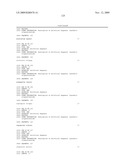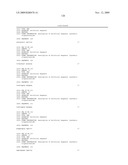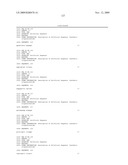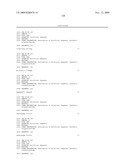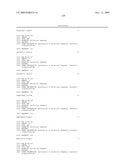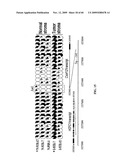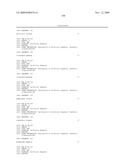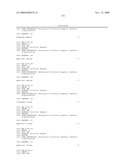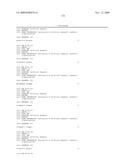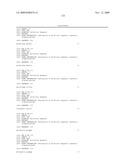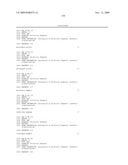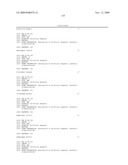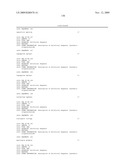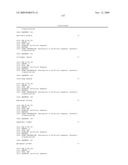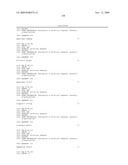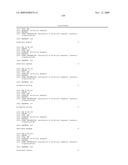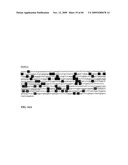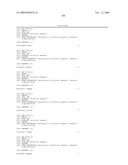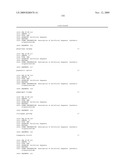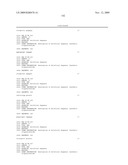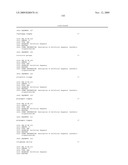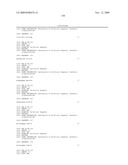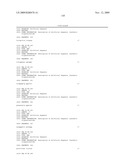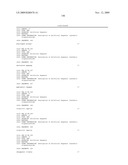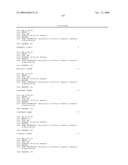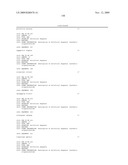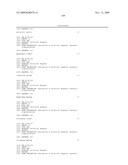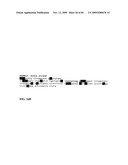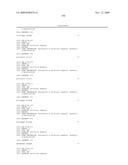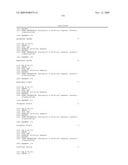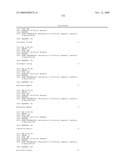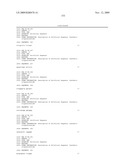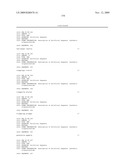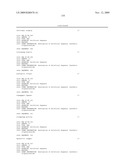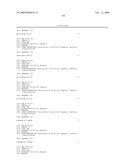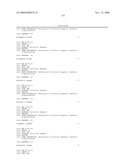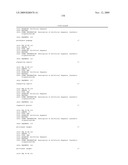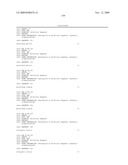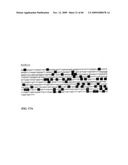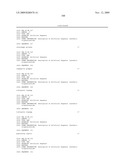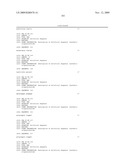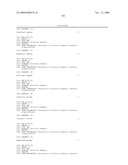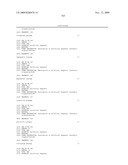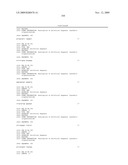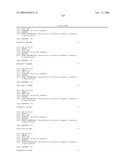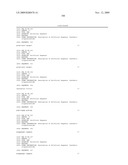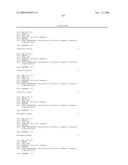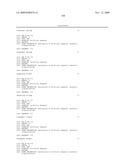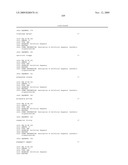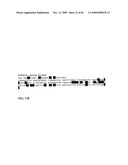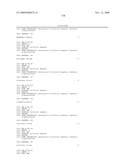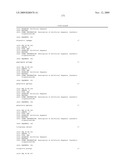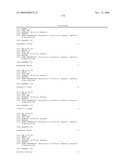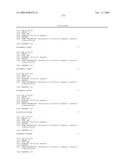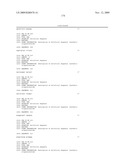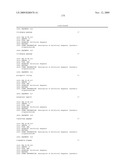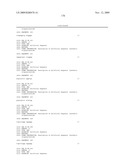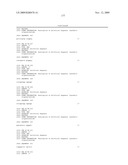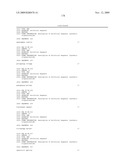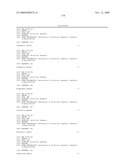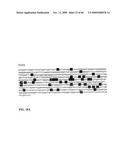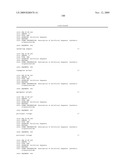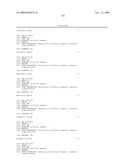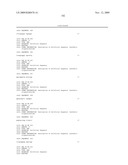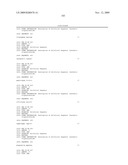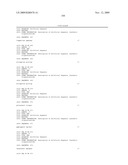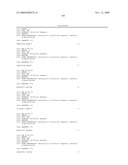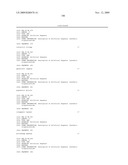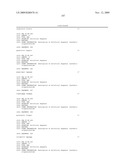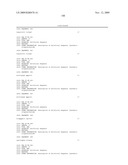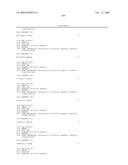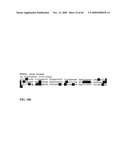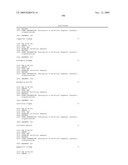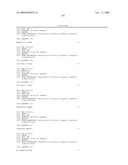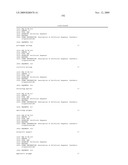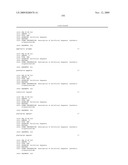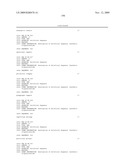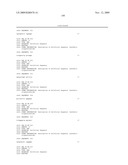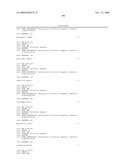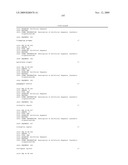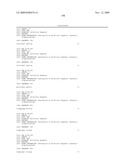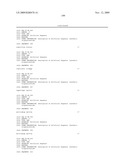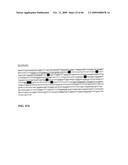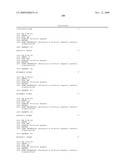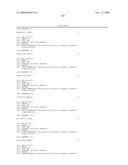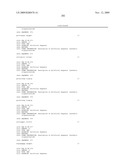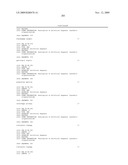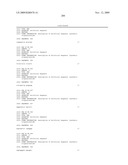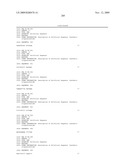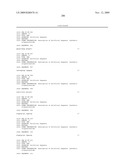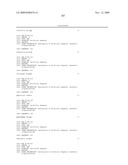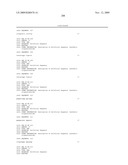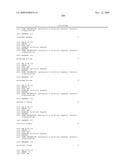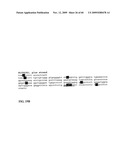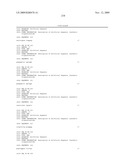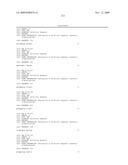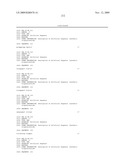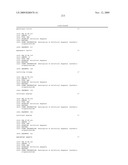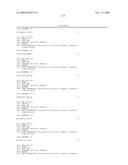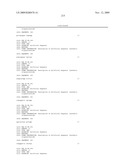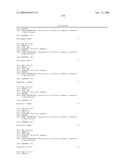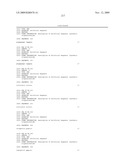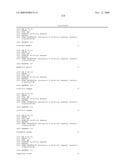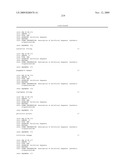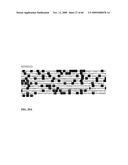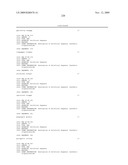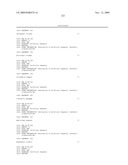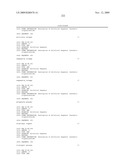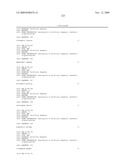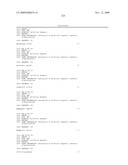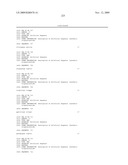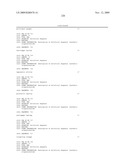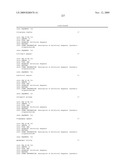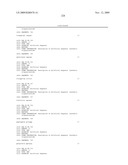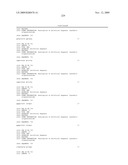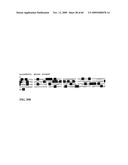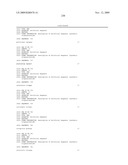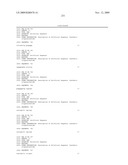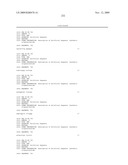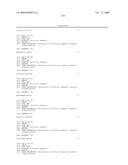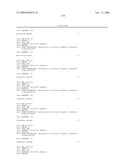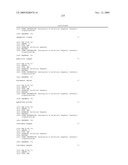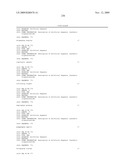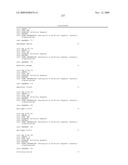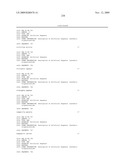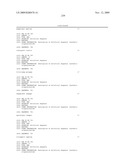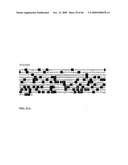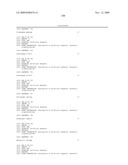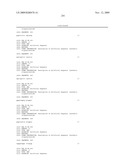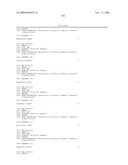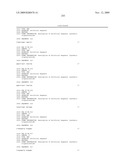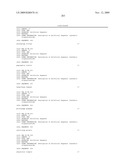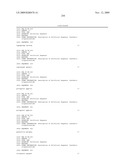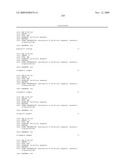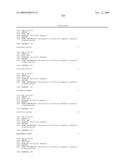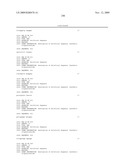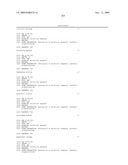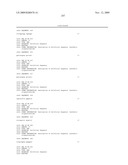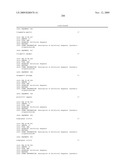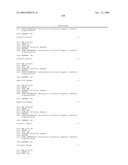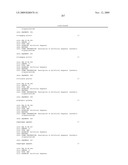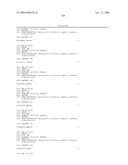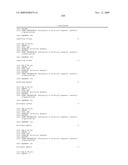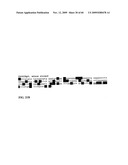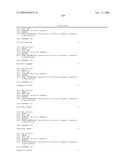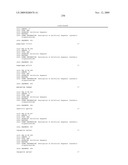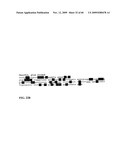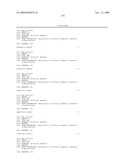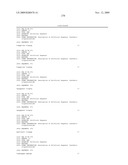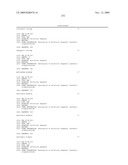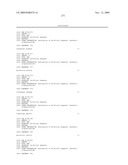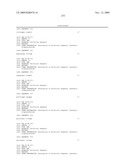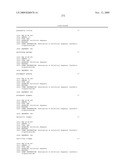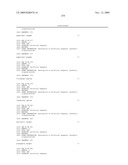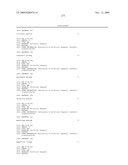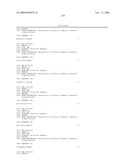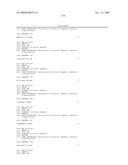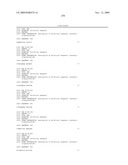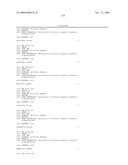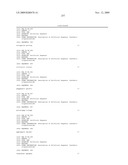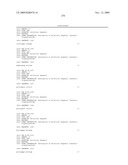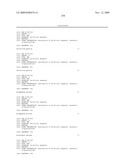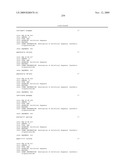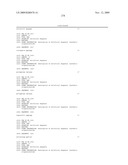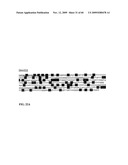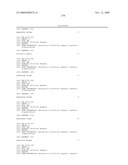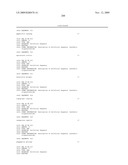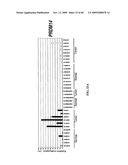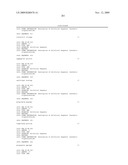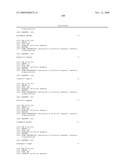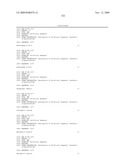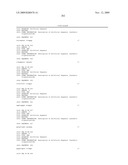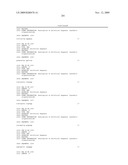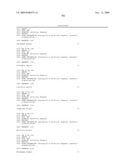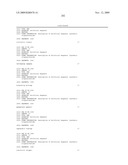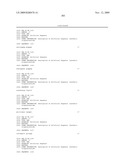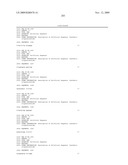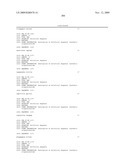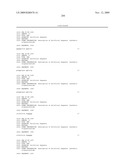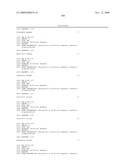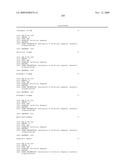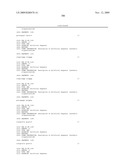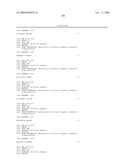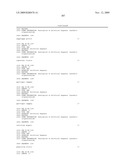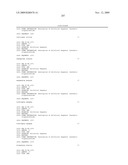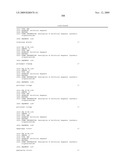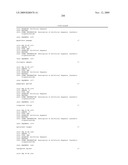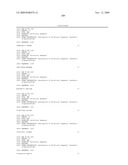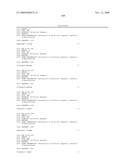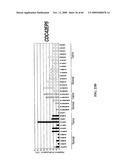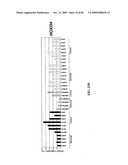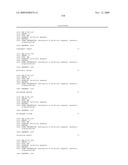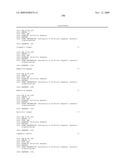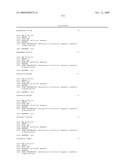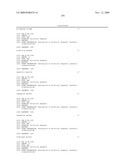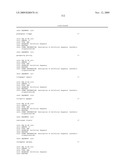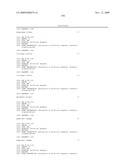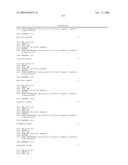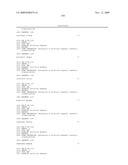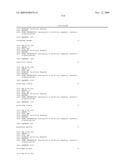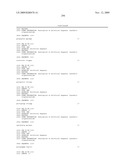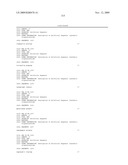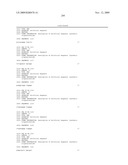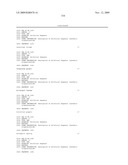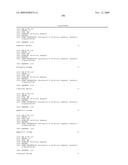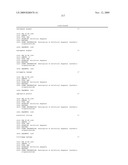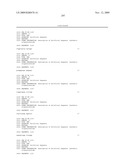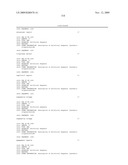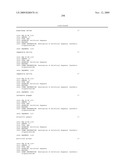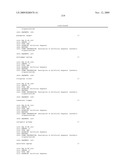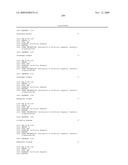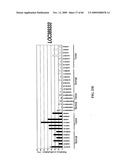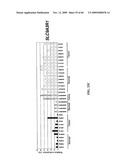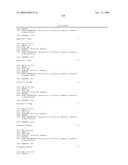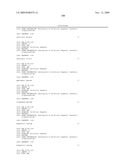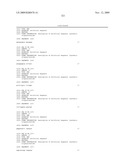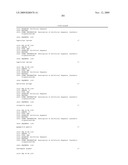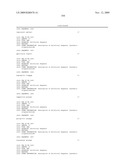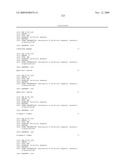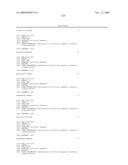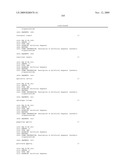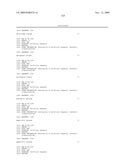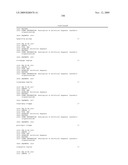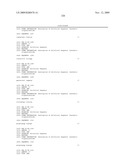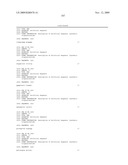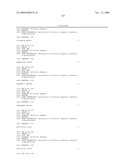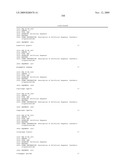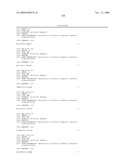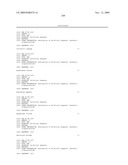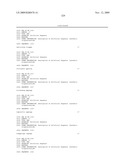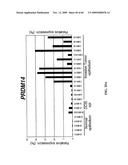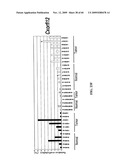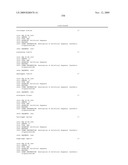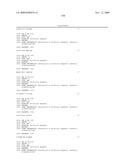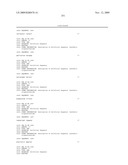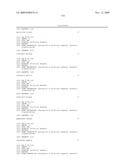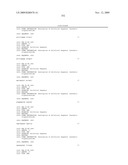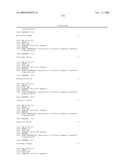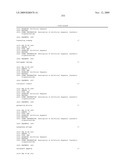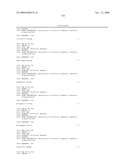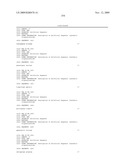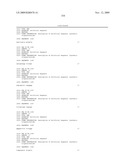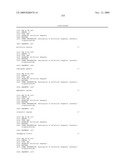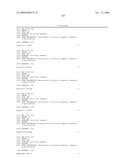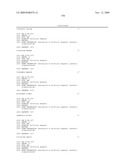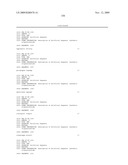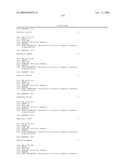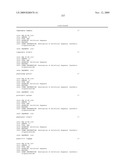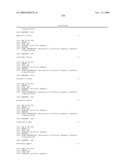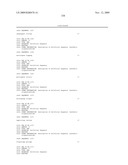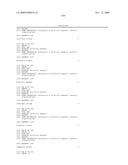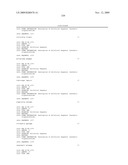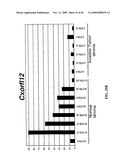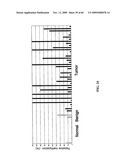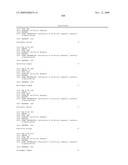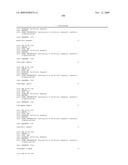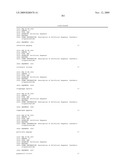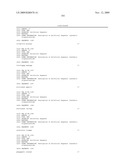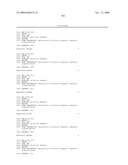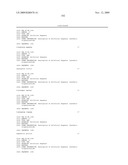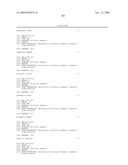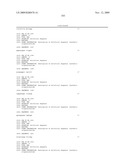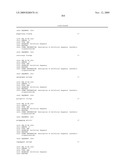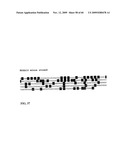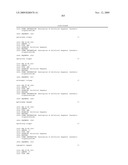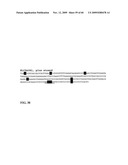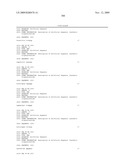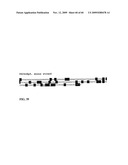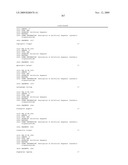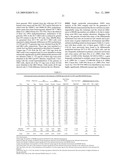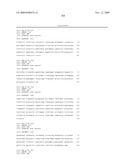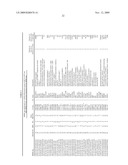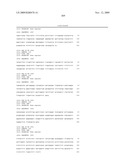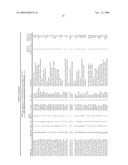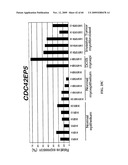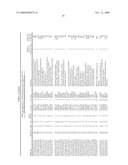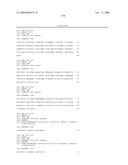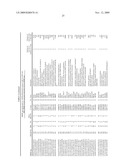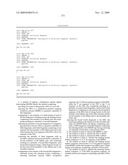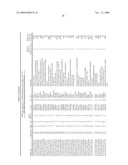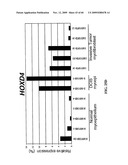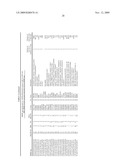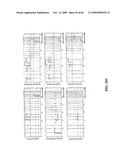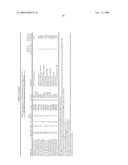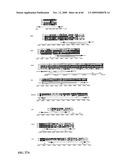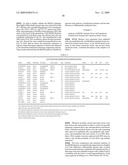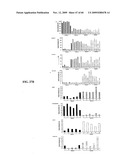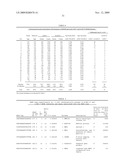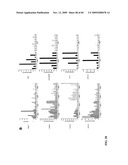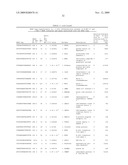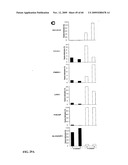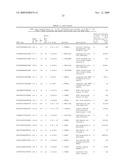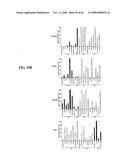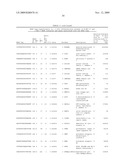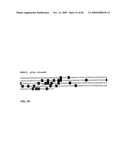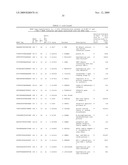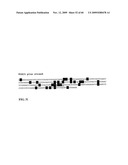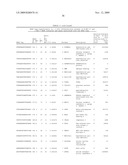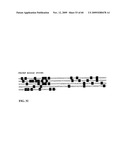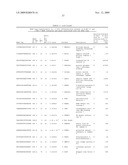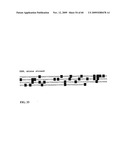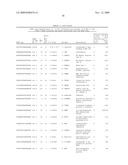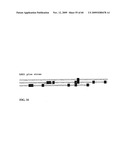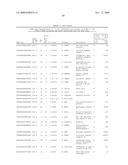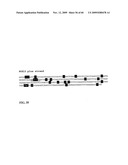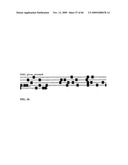Patent application title: GENE METHYLATION AND EXPRESSION
Inventors:
Kornelia Polyak (Brookline, MA, US)
Min Hu (Brighton, MA, US)
Noga Qimron (Brighton, MA, US)
Jun Yao (Chestnut Hill, MA, US)
Assignees:
DANA-FARBER CANCER INSTITUTE, INC.
IPC8 Class: AC12Q168FI
USPC Class:
435 6
Class name: Chemistry: molecular biology and microbiology measuring or testing process involving enzymes or micro-organisms; composition or test strip therefore; processes of forming such composition or test strip involving nucleic acid
Publication date: 2009-11-12
Patent application number: 20090280478
Claims:
1. A method of making a methylation specific digital karyotyping (MSDK)
library, the method comprising:providing all or part of the genomic DNA
of a test cell;exposing the DNA to a methylation-sensitive mapping
restriction enzyme (MMRE) to generate a plurality of first
fragments;conjugating to one terminus or to both termini of each of the
first fragments a binding moiety, the binding moiety comprising a first
member of an affinity pair, the conjugating resulting in a plurality of
second fragments;exposing the plurality of second fragments to a
fragmenting restriction enzyme (FRE) to generate a plurality of third
fragments, each third fragment comprising at one terminus the first
member of the affinity pair and at the other terminus the 5' cut sequence
of the FRE or the 3' cut sequence of the FRE;contacting the plurality of
third fragments with an insoluble substrate having bound thereto a
plurality of second members of the affinity pair, said contacting
resulting in a plurality of bound third fragments, each bound third
fragment being a third fragment bound via the first and second members of
the affinity pair to the insoluble substrate;conjugating to free termini
of the bound third fragments a releasing moiety, the releasing moiety
comprising a releasing restriction enzyme (RRE) recognition sequence and,
3' of the recognition sequence of the RRE, either the 5' cut sequence of
the FRE or the 3' cut sequence of the FRE, the conjugating resulting in a
plurality of bound fourth fragments, each bound fourth fragment (i)
comprising at one terminus the recognition sequence of the RRE and (ii)
being bound via the first member of the affinity pair at the other
terminus and the second member of the affinity pair to the insoluble
substrate; andexposing the bound fourth fragments to the RRE, the
exposing resulting in the release from the insoluble substrate of a MSDK
library, the library comprising a plurality of fifth fragments, each
fifth fragment comprising the releasing moiety and a MSDK tag, the tag
consisting of a plurality of base pairs of the genomic DNA.
2. The method of claim 1, wherein the MMRE is AscI.
3. The method of claim 1, wherein the FRE is NlaIII.
4. The method of claim 1, wherein the RRE is MmeI.
5. The method of claim 1, wherein the binding moiety further comprises a 5' or 3' cut sequence of the MMRE.
6. The method of claim 1, wherein the binding moiety further comprises, between the 5' or 3' recognition sequence of the MMRE and the first member of an affinity pair, a linker nucleic acid sequence comprising a plurality of base pairs.
7. The method of claim 1, wherein the releasing moiety further comprises, 5' of the RRE recognition sequence, an extender nucleic acid sequence comprising a plurality of base pairs.
8. A method of analyzing a MSDK library, the method comprising;providing a MSDK library made by the method of claim 1;identifying the nucleotide sequences of one tag, a plurality of tags, or all of the tags.
9. The method of claim 8, wherein identifying the nucleotide sequences of a plurality of tags comprises:making a plurality of ditags, each ditag comprising two fifth fragments ligated together;forming a concatamer comprising a plurality of ditags or ditag fragments, wherein each ditag fragment comprises two MSDK tags;determining the nucleotide sequence of the concatamer; anddeducing, from the nucleotide sequence of the concatamer, the nucleotide sequences of one or more of the MSDK tags that the concatamer comprises.
10. The method of claim 9, wherein the ditag fragments are made by exposing ditags to the FRE.
11. The method of claim 9, further comprising, after making a plurality of ditags and prior to forming the concatamers, increasing the number of ditags by PCR.
12. The method of claim 8, further comprising determining the relative frequency of some or all of the tags.
13. A method of analyzing a MSDK library, the method comprising:providing a MSDK library made by the method of claim 1; andidentifying a chromosomal site corresponding to the sequence of a tag selected from the library.
14. The method of claim 9, further comprising determining a chromosomal location, in the genome of the test cell, of an unmethylated full recognition sequence of the MMRE closest to the identified chromosomal site.
15. The method of claim 13, wherein the identification of the chromosomal site and the determination of the chromosomal location is performed by a process comprising comparing the nucleotide sequence of the selected tag to a virtual tag library generated using the nucleotide sequence of the genome or the part of a genome, the nucleotide sequence of the full recognition sequence of the MMRE, the nucleotide sequence of the full recognition sequence of the FRE, and the number of nucleotides separating the full recognition sequence of the RRE from the RRE cutting site.
16. A method of determining the chromosomal location of a plurality of unmethylated recognition sequences of the MMRE, the method comprising repeating the method of claim 14 with a plurality of tags obtained from the library.
17. The method of claim 1, wherein the test cell is a vertebrate cell.
18. The method of claim 1, wherein the test cell is a mammalian test cell.
19. The method of claim 18, wherein the mammalian test cell is a human test cell.
20. The method of claim 18, wherein the test cell is a normal cell.
21. The method of claim 18, wherein the test cell is a cancer cell.
22. The method of claim 21, wherein the cancer cell is a breast cancer cell.
23. The method of claim 1, wherein the first member of the affinity pair is biotin or iminobiotin.
24. The method of claim 1, wherein the first member of the affinity pair is an antigen, a haptenic determinant, a single-stranded nucleotide sequence, a hormone, a ligand for adhesion receptor, a receptor for an adhesion ligand, a ligand for a lectin, a lectin, a molecule containing all or part of an immunoglobulin Fc region, bacterial protein A, or bacterial protein G.
25. The method of claim 1, wherein the insoluble substrate comprises magnetic beads.
26. A method of classifying a biological cell, the method comprising:(a) performing the method of claim 12, thereby obtaining a test MSDK profile for the test cell;(b) comparing the test MSDK profile to separate control MSDK expression profiles for one or more control cell types;(c) selecting a control MSDK profile that most closely resembles the test MSKD profile; and(d) assigning to the test cell a cell type that matches the cell type of the control MSDK profile selected in step (c).
27. The method of claim 26, wherein the test and control cells are vertebrate cells.
28. The method of claim 27, wherein the test and control cells are mammalian cells.
29. The method of claim 28, wherein the test and control cells are human cells.
30. The method of claim 28, wherein the control cell types comprise a control normal cell and a control cancer cell of the same tissue as the normal cell.
31. The method of claim 30, wherein the control normal cell and the control cancer cell are breast cells.
32. The method of claim 30, wherein the control normal cell and the control cancer cell are of a tissue selected from the group consisting of colon, lung, prostate, and pancreas.
33. The method of claim 30, wherein the test cell is a breast cell.
34. The method of claim 30, wherein the test cell is of a tissue selected from the group consisting of colon, lung, prostate, and pancreas.
35. The method of claim 26, wherein the control cell types comprise cells of different categories of a cancer of a single tissue.
36. The method of claim 35, wherein the different categories of a cancer of a single tissue comprise a breast ductal carcinoma in situ (DCIS) cell and an invasive breast cancer cell.
37. The method of claim 35, wherein the different categories of a cancer of a single tissue comprise two or more of: a high grade DCIS cell, an intermediate grade DCIS cell; and an low grade DCIS cell.
38. The method of claim 28, wherein the control cell types comprise two or more of: a lung cancer cell; a breast cancer cell; a colon cancer cell; a prostate cancer cell; and a pancreatic cancer cell.
39. The method of claim 26, wherein the control cell types comprise an epithelial cell obtained from non-cancerous tissue and a myoepithelial cell obtained from non-cancerous tissue.
40. A method of diagnosis, the method comprising:(a) providing a test breast epithelial cell;(b) determining the degree of methylation of one or more C residues in a gene in the test cell, wherein the gene is selected from those identified by the MSDK tags listed in Table 5, wherein the one or more C residues are C residues in CpG sequences; and(c) comparing the degree of methylation of the one or more residues to the degree of methylation of corresponding one or more C residues in a corresponding gene in a control epithelial cell obtained from non-cancerous breast tissue, wherein an altered degree of methylation of the one or more C residues in the test epithelial cell compared to the control epithelial cell is an indication that the test epithelial cell is a cancer cell.
41-44. (canceled)
45. The method of claim 40, wherein the gene is selected from the group consisting of PRDM14 and ZCCHC14.
46. A method of diagnosis, the method comprising:(a) providing a test colon epithelial cell;(b) determining the degree of methylation of one or more C residues in a gene in the test cell, wherein the gene is selected from those identified by the MSDK tags listed in Table 2, wherein the one or more C residues are C residues in CpG sequences; and(c) comparing the degree of methylation of the one or more residues to the degree of methylation of corresponding one or more C residues in a corresponding gene in a control epithelial cell obtained from non-cancerous colon tissue, wherein an altered degree of methylation of the one or more C residues in the test epithelial cell compared to the control epithelial cell is an indication that the test epithelial cell is a cancer cell.
47-50. (canceled)
51. The method of claim 46, wherein the gene is selected from the group consisting of LHX3, TCF7L1, and LMX-1A.
52. A method of diagnosis, the method comprising:(a) providing a test myoepithelial cell obtained from a test breast tissue;(b) determining the degree of methylation of one or more C residues in a gene in the test cell, wherein the gene is selected from those identified by the MSDK tags listed in Table 10, wherein the one or more C residues are C residues in CpG sequences; and(c) comparing the degree of methylation of the one or more residues to the degree of methylation of corresponding one or more C residues in a corresponding gene in a control myoepithelial cell obtained from non-cancerous breast tissue, wherein an altered degree of methylation of the one or more C residues in the test myoepithelial cell compared to the control myoepithelial cell is an indication that the test breast tissue is cancerous tissue.
53-56. (canceled)
57. The method of claim 52, wherein the gene is selected from the group consisting of HOXD4, SLC9A3R1, and CDC42EP5.
58. A method of diagnosis, the method comprising:(a) providing a test fibroblast obtained from a test breast tissue;(b) determining the degree of methylation of one or more C residues in a gene in the test cell, wherein the gene is selected from those identified by the MSDK tags listed in Tables 7 and 8, wherein the one or more C residues are C residues in CpG sequences; and(c) comparing the degree of methylation of the one or more residues to the degree of methylation of corresponding one or more C residues in a corresponding gene in a control fibroblast obtained from non-cancerous breast tissue, wherein an altered degree of methylation of the one or more C residues in the test fibroblast compared to the control fibroblast is an indication that the test breast tissue is cancerous tissue.
59-62. (canceled)
63. The method of claim 58 wherein the gene is Cxorf12.
64. A method of determining the likelihood of a cell being an epithelial cell or a myoepithelial cell, the method comprising:(a) providing a test cell;(b) determining the degree of methylation of one or more C residues in a gene in the test cell, wherein the gene is selected from those identified by the MSDK tags listed in Table 12, wherein the one or more C residues are C residues in CpG sequences; and(c) comparing the degree of methylation of the one or more residues to the degree of methylation of corresponding one or more C residues in a corresponding gene in a control myoepithelial cell and to the degree of methylation of corresponding one or more C residues in a corresponding gene in a control epithelial cell, wherein the test cell is: (i) more likely to be a myoepithelial cell if the degree of methylation in the test sample more closely resembles the degree of methylation in the control myoepithelial cell; or (ii) more likely to be an epithelial cell if the degree of methylation in the test sample more closely resembles the degree of methylation in the control epithelial cell.
65-66. (canceled)
67. The method of claim 64, wherein the gene is selected from the group consisting of LOC389333 and CDC42EP5.
68. A method of diagnosis, the method comprising:(a) providing a test cell from a test tissue;(b) determining the degree of methylation of one or more C residues in a PRDM14 gene in the test cell, wherein the one or more C residues are C residues in CpG sequences; and(c) comparing the degree of methylation of the one or more residues to the degree of methylation of corresponding one or more C residues in the PRDM14 gene in a control cell obtained from non-cancerous tissue of the same tissue as the test cell, wherein an altered degree of methylation of the one or more C residues in the test cell compared to the control cell is an indication that the test cell is a cancer cell.
69-74. (canceled)
75. A method of diagnosis comprising:(a) providing a test sample of breast tissue comprising a test epithelial cell;(b) determining the level of expression in the test epithelial cell of a gene selected from those listed in Table 5, wherein the gene is one that is expressed in a breast cancer epithelial cell at a substantially altered level compared to a compared to a normal breast epithelial cell; and(c) classifying the test cell as: (i) a normal breast epithelial cell if the level of expression of the gene in the test cell is not substantially altered compared to a control level of expression for a normal breast epithelial cell; or (ii) a breast cancer epithelial cell if the level of expression of the gene in the test cell is substantially altered compared to a control level of expression for a normal breast epithelial cell.
76. The method of claim 75, wherein the gene is selected from the group consisting of PRDM14 and ZCCHC14.
77-78. (canceled)
79. A method of diagnosis comprising:(a) providing a test sample of colon tissue comprising a test epithelial cell;(b) determining the level of expression in the test epithelial cell of a gene selected from those listed in Table 2, wherein the gene is one that is expressed in a colon cancer epithelial cell at a substantially altered level compared to a compared to a normal colon epithelial cell; and(c) classifying the test cell as: (i) a normal colon epithelial cell if the level of expression of the gene in the test cell is not substantially altered compared to a control level of expression for a normal colon epithelial cell; or (ii) a colon cancer epithelial cell if the level of expression of the gene in the test cell is substantially altered compared to a control level of expression for a normal colon epithelial cell.
80. The method of claim 79, wherein the gene is selected from the group consisting of LHX3, TCF7L1, and LMX-1A.
81-82. (canceled)
83. A method of diagnosis comprising:(a) providing a test sample of breast tissue comprising a test stromal cell;(b) determining the level of expression in the stromal cell of a gene selected from those listed in Tables 7, 8, and 10, wherein the gene is one that is expressed in a cell of the same type as the test stromal cell at a substantially altered level when present in breast cancer tissue than when present in normal breast tissue; and(c) classifying the test sample as: (i) normal breast tissue if the level of expression of the gene in the test stromal cell is not substantially altered compared to a control level of expression for a control cell of the same type as the test stromal cell in normal breast tissue; or (ii) breast cancer tissue if the level of expression of the gene in the test stromal cell is substantially altered compared to a control level of expression for a control cell of the same type as the test stromal cell in normal breast tissue.
84. (canceled)
85. The method of claim 83, wherein the gene is selected from the group consisting of HOXD4, SLC9A3R1, and CDC32EP5.
86. (canceled)
87. The method of claim 83, wherein the gene is Cxorf12.
88-89. (canceled)
90. A method of determining the likelihood of a cell being an epithelial cell or a myoepithelial cell, the method comprising:(a) providing a test cell;(b) determining the level of expression in the test sample of a gene selected from the group consisting of those identified by the MSDK tags listed in Table 12;(c) determining whether the level of expression of the selected gene in the test sample more closely resembles the level of expression of the selected gene in (i) a control myoepithelial cell or (ii) a control epithelial cell; and(d) classifying the test cell as: (i) likely to be a myoepithelial cell if the level of expression of the gene in the test cell more closely resembles the level of expression of the gene in a control myoepithelial cell; or (ii) likely to be an epithelial cell if the level of expression of the gene in the test cell more closely resembles the level of expression of the gene in a control epithelial cell.
91. The method of claim 90, wherein the gene is selected from the group consisting of LOC389333 and CDC42EP5.
92. A method of diagnosis comprising:(a) providing a test cell;(b) determining the level of expression in the test cell of a PRDM14 gene; and(c) classifying the test cell as: (i) a normal cell if the level of expression of the gene in the test cell is not substantially altered compared to a control level of expression for a control normal cell of the same tissue as the test cell; or (ii) a cancer cell if the level of expression of the gene in the test cell is substantially altered compared to a control level of expression for a control normal cell of the same tissue as the test cell.
93-96. (canceled)
97. A single stranded nucleic acid probe comprising:(a) the nucleotide sequence of a tag selected from those listed in Tables 2, 5, 7, 8, 10, 12, 15, and 16; or(b) the complement of the nucleotide sequence.
98. An array comprising a substrate having at least 10 addresses, wherein each address has disposed thereon a capture probe comprising:(a) a nucleic acid sequence consisting of a tag nucleotide sequence selected from those listed in Tables 2, 5, 7, 8, 10, 12, 15 and 16; or(b) the complement of the nucleic acid sequence.
99. A kit comprising at least 10 probes, each probe comprising:(a) a nucleic acid sequence comprising a tag nucleotide sequence selected from those listed in Tables 2, 5, 7, 8, 10, 12, 15 and 16; or(b) the complement of the nucleic acid sequence.
100. A kit comprising at least 10 antibodies each of which is specific for a different protein encoded by a gene identified by a tag selected from the group consisting of the tags listed in Tables 2, 5, 7, 8, 10, 12, 15, and 16.
101. A method of determining the likelihood of a cell being a stem cell, an differentiated luminal epithelial cell or a myoepithelial cell, the method comprising:(a) providing a test cell;(b) determining the degree of methylation of one or more C residues in a gene in the test cell, wherein the gene is selected from those identified by the MSDK tags listed in Table 15 or 16, wherein the one or more C residues are C residues in CpG sequences; and(c) comparing the degree of methylation of the one or more residues to the degree of methylation of corresponding one or more C residues in a corresponding gene in a control stem cell, to the degree of methylation of corresponding one or more C residues in a corresponding gene in a control stem cell, and to the degree of methylation of corresponding one or more C residues in a corresponding gene in a control differentiated luminal epithelial cell, and to the degree of methylation of corresponding one or more C residues in a corresponding gene in a control myoepithelial cell, wherein the test cell is: (i) more likely to be a stem cell if the degree of methylation in the test cell more closely resembles the degree of methylation in the control stem cell; (ii) more likely to be a differentiated luminal epithelial cell if the degree of methylation in the test cell more closely resembles the degree of methylation in the control differentiated luminal epithelial cell; or (iii) more likely to be an myoepithelial cell if the degree of methylation in the test cell more closely resembles the degree of methylation in the control myoepithelial cell
102-103. (canceled)
104. The method of claim 101, wherein the gene is selected from the group consisting of SOX13, SLC9A3R1, FNDC1, FOXC1, PACAP, DDN, CDC42EP5, LHX1, and HOXA10.
105. A method of determining the likelihood of a cell being a stem cell, a differentiated luminal epithelial cell, or a myoepithelial cell, the method comprising:(a) providing a test cell;(b) determining the level of expression in the test sample of a gene selected from the group consisting of those identified by the MSDK tags listed in Table 15 or 16;(c) determining whether the level of expression of the selected gene in the test sample more closely resembles the level of expression of the selected gene in (i) a control stem cell, (ii) a control differentiated luminal epithelial cell, or (ii) a control myoepithelial cell; and(d) classifying the test cell as: (i) likely to be a stem cell if the level of expression of the gene in the test cell more closely resembles the level of expression of the gene in a control stem cell; (ii) likely to be a differentiated luminal epithelial cell if the level of expression of the gene in the test cell more closely resembles the level of expression of the gene in a control epithelial cell; or (iii) likely to be an myoepithelial cell if the level of expression of the gene in the test cell more closely resembles the level of expression of the gene in a control myoepithelial cell.
106-107. (canceled)
108. The method of claim 105, wherein the gene is selected from the group consisting of SOX13, SLC9A3R1, FNDC1, FOXC1, PACAP, DDN, CDC42EP5, LHX1, and HOXA10.
Description:
CROSS REFERENCE TO RELATED APPLICATIONS
[0001]This application claims priority to U.S. Provisional Application No. 60/685,104, filed May 27, 2005. The entire content of the prior application is incorporated herein by reference in its entirety.
TECHNICAL FIELD
[0003]This invention relates to epigenetic gene regulation, and more particularly to DNA methylation and its effect on gene expression, and its use as a marker of a particular cell type and/or disease state.
BACKGROUND
[0004]Epigenetic changes (e.g., changes in the levels of DNA methylation), as well as genetic changes, can be detected in cancer cells and stromal cells within tumors. In order to develop more discriminatory diagnostic methods and more effective therapeutic methods it is important that these epigenetic effects be defined and characterized.
SUMMARY
[0005]The inventors have developed a method of assessing the level of methylation in an entire, or part of a, genome. They call this method Methylation Specific Digital Karyotyping (MSDK). The MSDK method can be adapted to establish a test genomic methylation profile for a test cell of interest. By comparing the test profile to control profiles obtained with defined cells types, the test cell can be identified. The MSDK method can also be used to identify genes in a test cell (e.g., a cancer cell) the methylation of which is altered (increased or decreased) relative to a corresponding control cell (e.g., a normal cell of the same tissue as the cancer cell). This information provides the basis for methods for discriminating whether a test cell of interest (a) is the same as a control cell (e.g., a normal cell) or (b) is different from a control cell but is, for example, a pathologic cell such as a cancer cell. Such methods include, for example, assessing the level of DNA methylation or the level of expression of genes of interest, or the level of DNA methylation in a particular chromosomal area in test cells and comparing the results to those obtained with control cells.
[0006]More specifically, the invention features a method of making a methylation specific digital karyotyping (MSDK) library. The method includes:
[0007]providing all or part of the genomic DNA of a test cell; exposing the DNA to a methylation-sensitive mapping restriction enzyme (MMRE) to generate a plurality of first fragments;
[0008]conjugating to one terminus or to both termini of each of the first fragments a binding moiety, the binding moiety comprising a first member of an affinity pair, the conjugating resulting in a plurality of second fragments;
[0009]exposing the plurality of second fragments to a fragmenting restriction enzyme (FRE) to generate a plurality of third fragments, each third fragment containing at one terminus the first member of the affinity pair and at the other terminus the 5' cut sequence of the FRE or the 3' cut sequence of the FRE;
[0010]contacting the plurality of third fragments with an insoluble substrate having bound thereto a plurality of second members of the affinity pair to the contacting resulting in a plurality of bound third fragments, each bound third fragment being a third fragment bound via the first and second members of the affinity pair to the insoluble substrate;
[0011]conjugating to free termini of the bound third fragments a releasing moiety, the releasing moiety comprising a releasing restriction enzyme (RRE) recognition sequence and, 3' of the recognition sequence of the RRE, either the 5' cut sequence of the FRE or the 3' cut sequence of the FRE, the conjugating resulting in a plurality of bound fourth fragments, each bound fourth fragment (i) containing at one terminus the recognition sequence of the RRE and (ii) being bound via the first member of the affinity pair at the other terminus and the second member of the affinity pair to the insoluble substrate; and
[0012]exposing the bound fourth fragments to the RRE, the exposing resulting in the release from the insoluble substrate of a MSDK library, the library comprising a plurality of fifth fragments, each fifth fragment comprising the releasing moiety and a MSDK tag, the tag consisting of a plurality of base pairs of the genomic DNA. Thus, the method results in the production of a plurality of MSDK tags.
[0013]In the method, the MMRE can be, e.g., AscI, the FRE can be, e.g., NlaIII, and the RRE can be, e.g., MmeI. The binding moiety can further include a 5' or 3' cut sequence of the MMRE. The binding moiety can also further include, between the 5' or 3' recognition sequence of the MMRE and the first member of an affinity pair, a linker nucleic acid sequence comprising a plurality of base pairs. The releasing moiety can further include, 5' of the RRE recognition sequence, an extender nucleic acid sequence comprising a plurality of base pairs. The test cell can be a vertebrate cell and the vertebrate test cell can be a mammalian test cell, e.g., a human test cell. Moreover the test cell can be a normal cell or, for example, a cancer cell, e.g., a breast cancer cell. The first member of the affinity pair can be biotin, iminobiotin, avidin or a functional fragment of avidin, an antigen, a haptenic determinant, a single-stranded nucleotide sequence, a hormone, a ligand for adhesion receptor, a receptor for an adhesion ligand, a ligand for a lectin, a lectin, a molecule containing all or part of an immunoglobulin Fc region, bacterial protein A, or bacterial protein G. The insoluble substrate can include, or be, magnetic beads.
[0014]Also provided by the invention is a method of analyzing a MSDK library. The method includes: providing a MSDK library made by the above-described method; and identifying the nucleotide sequences of one tag, a plurality of tags, or all of the tags. Identifying the nucleotide sequences of a plurality of tags can involve: making a plurality of ditags, each ditag containing two fifth fragments ligated together; forming a concatamer containing a plurality of ditags or ditag fragments, wherein each ditag fragment contains two MSDK tags; determining the nucleotide sequence of the concatamer; and deducing, from the nucleotide sequence of the concatamer, the nucleotide sequences of one or more of the MSDK tags that the concatamer contains. The ditag fragments can be made by exposing the ditags to the FRE. The method can further include, after making a plurality of ditags and prior to forming the concatamers, the number (abundance) of individual ditags is increased by PCR. The method can further include determining the relative frequency of some or all of the tags.
[0015]Another aspect of the invention is an additional method of analyzing a MSDK library. The method includes: providing a MSDK library made by the above-described method; identifying a chromosomal site corresponding to the sequence of a tag selected from the library. The method can further involve determining a chromosomal location, in the genome of the test cell, of an unmethylated full recognition sequence of the MMRE closest to the identified chromosomal site. These two steps can be repeated with a plurality of tags obtained from the library in order to determine the chromosomal location of a plurality of unmethylated recognition sequences of the MMRE. The identification of the chromosomal site and the determination of the chromosomal location can be performed by a process that includes comparing the nucleotide sequence of the selected tag to a virtual tag library generated using the nucleotide sequence of the genome or the part of a genome, the nucleotide sequence of the full recognition sequence of the MMRE, the nucleotide sequence of the full recognition sequence of the FRE, and the number of nucleotides separating the full recognition sequence of the RRE from the RRE cutting site.
[0016]In another aspect, the invention provides a method of classifying a biological cell. The method includes: (a) identifying the nucleotide sequences of one tag, a plurality of tags, or all of the tags in an MSDK library made as described above and determining the relative frequency of some or all of the tags, thereby obtaining a test MSDK profile for the test cell; (b) comparing the test MSDK profile to separate control MSDK expression profiles for one or more control cell types; (c) selecting a control MSDK profile that most closely resembles the test MSKD profile; and (d) assigning to the test cell a cell type that matches the cell type of the control MSDK profile selected in step (c). The test and control cells can be vertebrate cells, e.g., mammalian cells such as human cells. The control cell types can include a control normal cell and a control cancer cell of the same tissue as the normal cell. The control normal cell and the control cancer cell can be breast cells or of a tissue selected from colon, lung, prostate, and pancreas. The test cell can be a breast cell or of a tissue selected from of colon, lung, prostate, and pancreas. The control cell types can include cells of different categories of a cancer of a single tissue and the different categories of a cancer of a single tissue can include, for example, a breast ductal carcinoma in situ (DCIS) cell and an invasive breast cancer cell. The different categories of a cancer of a single tissue can alternatively include, for example, two or more of: a high grade DCIS cell, an intermediate grade DCIS cell; and a low grade DCIS cell. The control cell types can include two or more of: a lung cancer cell; a breast cancer cell; a colon cancer cell; a prostate cancer cell; and a pancreatic cancer. In addition, the control cell types can include an epithelial cell obtained from non-cancerous tissue and a myoepithelial cell obtained from non-cancerous tissue. Furthermore, the control cells can also include stem cells and differentiated cells derived therefrom (e.g., epithelial cells or myoepithelial cells) of the same tissue type. The control stem and differentiated cells therefrom can be of breast tissue, or of a tissue selected from colon, lung, prostate, and pancreas. The control stem and differentiated cells derived therefrom can be normal or cancer cells (e.g., breast cancer cells) or obtained from a cancerous tissue (e.g., breast cancer).
[0017]Another embodiment of the invention is a method of diagnosis. The method includes: (a) providing a test breast epithelial cell; (b) determining the degree of methylation of one or more C residues in a DNA sequence (e.g., in a gene) in the test cell, wherein the DNA (e.g., the gene) is selected from the AscI sites identified by the MSDK tags listed in Table 5, wherein the one or more C residues are C residues in CpG sequences; and (c) comparing the degree of methylation of the one or more residues to the degree of methylation of corresponding one or more C residues in a corresponding gene in a control epithelial cell obtained from non-cancerous breast tissue, wherein an altered degree of methylation of the one or more C residues in the test epithelial cell compared to the control epithelial cell is an indication that the test epithelial cell is a cancer cell. The altered degree of methylation can be a lower degree of methylation or a higher degree of methylation. The altered degree of methylation can be in the promoter region of the gene, an exon of the gene, an intron of the gene, or a region outside of the gene (e.g., in an intergenic region). The gene can be, for example, PRDM14 or ZCCHC14.
[0018]The invention provides another method of diagnosis. The method includes:
(a) providing a test colon epithelial cell; (b) determining the degree of methylation of one or more C residues in a DNA sequence (e.g., in a gene) in the test cell, wherein the DNA sequence (e.g., the gene) is selected from those identified by the MSDK tags listed in Table 2, wherein the one or more C residues are C residues in CpG sequences; and (c) comparing the degree of methylation of the one or more residues to the degree of methylation of corresponding one or more C residues in a corresponding gene in a control epithelial cell obtained from non-cancerous colon tissue, wherein an altered degree of methylation of the one or more C residues in the test epithelial cell compared to the control epithelial cell is an indication that the test epithelial cell is a cancer cell. The altered degree of methylation can be a lower degree of methylation or a higher degree of methylation. In addition, the altered degree of methylation can be in the promoter region of the gene, an exon of the gene, an intron of the gene, or a region outside of the gene (e.g., an intergenic region). The gene can be, for example, LHX3, TCF7L1, or LMX-1A.
[0019]Another method of diagnosis featured by the invention involves: (a) providing a test myoepithelial cell obtained from a test breast tissue; (b) determining the degree of methylation of one or more C residues in a DNA sequence (e.g., in a gene) in the test cell, wherein the DNA sequence (e.g., the gene) is selected from those identified by the MSDK tags listed in Table 10, wherein the one or more C residues are C residues in CpG sequences; and (c) comparing the degree of methylation of the one or more residues to the degree of methylation of corresponding one or more C residues in a corresponding gene in a control myoepithelial cell obtained from non-cancerous breast tissue, wherein an altered degree of methylation of the one or more C residues in the test myoepithelial cell compared to the control myoepithelial cell is an indication that the test breast tissue is cancerous tissue. The altered degree of methylation can be a lower degree of methylation or a higher degree of methylation. In addition, the altered degree of methylation can be in the promoter region of the gene, an exon of the gene, an intron of the gene, or a region outside of the gene (e.g., an intergenic region). The gene is can be, for example, HOXD4, SLC9A3R1, or CDC42EP5.
[0020]Yet another method of diagnosis embodied by the invention involves:
(a) providing a test fibroblast obtained from a test breast tissue; (b) determining the degree of methylation of one or more C residues in a DNA sequence (e.g., in a gene) in the test cell, wherein the DNA sequence (e.g., the gene) is selected from those identified by the MSDK tags listed in Tables 7 and 8, wherein the one or more C residues are C residues in CpG sequences; and (c) comparing the degree of methylation of the one or more residues to the degree of methylation of corresponding one or more C residues in a corresponding gene in a control fibroblast obtained from non-cancerous breast tissue, wherein an altered degree of methylation of the one or more C residues in the test fibroblast compared to the control fibroblast is an indication that the test breast tissue is cancerous tissue. The altered degree of methylation can be a lower degree of methylation or a higher degree of methylation. In addition, the altered degree of methylation can be in the promoter region of the gene, an exon of the gene, an intron of the gene, or a region outside of the gene (e.g., an intergenic region). The gene can be, for example, Cxorf12.
[0021]In another aspect, the invention includes a method of determining the likelihood of a cell being an epithelial cell or a myoepithelial cell. The method involves:
(a) providing a test cell; (b) determining the degree of methylation of one or more C residues in a DNA sequence (e.g., in a gene) in the test cell, wherein the DNA sequence (e.g., the gene) is selected from those identified by the MSDK tags listed in Table 12, wherein the one or more C residues are C residues in CpG sequences; and (c) comparing the degree of methylation of the one or more residues to the degree of methylation of corresponding one or more C residues in a corresponding gene in a control myoepithelial cell and to the degree of methylation of corresponding one or more C residues in a corresponding gene in a control epithelial cell, wherein the test cell is: (i) more likely to be a myoepithelial cell if the degree of methylation in the test sample more closely resembles the degree of methylation in the control myoepithelial cell; or (ii) more likely to be an epithelial cell if the degree of methylation in the test sample more closely resembles the degree of methylation in the control epithelial cell. The C residues can be in the promoter region of the gene, an exon of the gene, an intron of the gene, or in a region outside of the gene (e.g., an intergenic region). The gene can be, for example, LOC389333 or CDC42EP5.
[0022]In another aspect, the invention includes a method of determining the likelihood of a cell being a stem cell, an differentiated luminal epithelial cell or a myoepithelial cell. The method involves: (a) providing a test cell; (b) determining the degree of methylation of one or more C residues in a DNA sequence (e.g., in a gene) in the test cell, wherein the DNA sequence (e.g., the gene) is selected from those identified by the MSDK tags listed in Table 15 or 16, wherein the one or more C residues are C residues in CpG sequences; and (c) comparing the degree of methylation of the one or more residues to the degree of methylation of corresponding one or more C residues in a corresponding gene in a control stem cell, to the degree of methylation of corresponding one or more C residues in a corresponding gene in a control differentiated luminal epithelial cell, and to the degree of methylation of corresponding one or more C residues in a corresponding gene in a control myoepithelial cell, wherein the test cell is: (i) more likely to be a stem cell if the degree of methylation in the test sample more closely resembles the degree of methylation in the control stem cell; (ii) more likely to be a differentiated luminal epithelial cell if the degree of methylation in the test sample more closely resembles the degree of methylation in the control epithelial cell; or (iii) more likely to be a myoepithelial cell if the degree of methylation in the test sample more closely resembles the degree of methylation in the control myoepithelial cell. The C residues can be in the promoter region of the gene, an exon of the gene, an intron of the gene, or in a region outside of the gene (e.g., an intergenic region). The gene can be, for example, SOX13, SLC9A3R1, FNDC1, FOXC1, PACAP, DDN, CDC42EP5, LHX1, and HOXA10.
[0023]The invention also features a method of diagnosis that involves: (a) providing a test cell from a test tissue; (b) determining the degree of methylation of one or more C residues in a PRDM14 gene in the test cell, wherein the one or more C residues are C residues in CpG sequences; and (c) comparing the degree of methylation of the one or more residues to the degree of methylation of corresponding one or more C residues in the PRDM14 gene in a control cell obtained from non-cancerous tissue of the same tissue as the test cell, wherein an altered degree of methylation of the one or more C residues in the test cell compared to the control cell is an indication that the test cell is a cancer cell. The altered degree of methylation can be a lower degree of methylation or a higher degree of methylation. In addition, the altered degree of methylation can be in the promoter region of the gene, an exon of the gene, an intron of the gene, or a region outside of the gene (e.g., an intergenic region). The test and control cells can be breast cells or of a tissue selected from colon, lung, prostate, and pancreas.
[0024]Another embodiment of the invention is a method of diagnosis that includes: (a) providing a test sample of breast tissue comprising a test epithelial cell; (b) determining the level of expression in the test epithelial cell of a gene selected from those listed in Table 5, wherein the gene is one that is expressed in a breast cancer epithelial cell at a substantially altered level compared to a compared to a normal breast epithelial cell; and (c) classifying the test cell as: (i) a normal breast epithelial cell if the level of expression of the gene in the test cell is not substantially altered compared to a control level of expression for a normal breast epithelial cell; or (ii) a breast cancer epithelial cell if the level of expression of the gene in the test cell is substantially altered compared to a control level of expression for a normal breast epithelial cell. The gene is can be, for example, PRDM14 or ZCCHC14. The alteration in the level of expression can be an increase in the level of expression or a decrease in the level of expression.
[0025]Another aspect of the invention is a method of diagnosis that includes:
(a) providing a test sample of colon tissue comprising a test epithelial cell;(b) determining the level of expression in the test epithelial cell of a gene selected from those listed in Table 2, wherein the gene is one that is expressed in a colon cancer epithelial cell at a substantially altered level compared to a compared to a normal colon epithelial cell; and (c) classifying the test cell as: (i) a normal colon epithelial cell if the level of expression of the gene in the test cell is not substantially altered compared to a control level of expression for a normal colon epithelial cell; or (ii) a colon cancer epithelial cell if the level of expression of the gene in the test cell is substantially altered compared to a control level of expression for a normal colon epithelial cell. The gene can be, for example, LHX3, TCF7L1, or LMX-1A. The alteration in the level of expression can be an increase in the level of expression or a decrease in the level of expression.
[0026]Another method of diagnosis included in the invention involves: (a) providing a test sample of breast tissue comprising a test stromal cell; (b) determining the level of expression in the stromal cell of a gene selected from those listed in Tables 7, 8, and 10, wherein the gene is one that is expressed in a cell of the same type as the test stromal cell at a substantially altered level when present in breast cancer tissue than when present in normal breast tissue; and (c) classifying the test sample as: (i) normal breast tissue if the level of expression of the gene in the test stromal cell is not substantially altered compared to a control level of expression for a control cell of the same type as the test stromal cell in normal breast tissue; or (ii) breast cancer tissue if the level of expression of the gene in the test stromal cell is substantially altered compared to a control level of expression for a control cell of the same type as the test stromal cell in normal breast tissue. The test and control stromal cells can be myoepithelial cells and the genes can be those listed in Table 10, e.g., HOXD4, SLC9A3R1, or CDC32EP5. Alternatively, the test and control stromal cells can be fibroblasts and the genes can be those listed in Tables 7 and 8, e.g., Cxorf1. The alteration in the level of expression can be an increase in the level of expression or a decrease in the level of expression.
[0027]In another aspect, the invention includes a method of determining the likelihood of a cell being an epithelial cell or a myoepithelial cell. The method includes: (a) providing a test cell; (b) determining the level of expression in the test sample of a gene selected from the group consisting of those identified by the MSDK tags listed in Table 12; (c) determining whether the level of expression of the selected gene in the test sample more closely resembles the level of expression of the selected gene in (i) a control myoepithelial cell or (ii) a control epithelial cell; and (d) classifying the test cell as: (i) likely to be a myoepithelial cell if the level of expression of the gene in the test cell more closely resembles the level of expression of the gene in a control myoepithelial cell; or (ii) likely to be an epithelial cell if the level of expression of the gene in the test cell more closely resembles the level of expression of the gene in a control epithelial cell. The gene can be, for example, LOC389333 or CDC42EP5.
[0028]In another aspect, the invention includes a method of determining the likelihood of a cell being a stem cell, a differentiated luminal epithelial cell, or a myoepithelial cell. The method includes: (a) providing a test cell; (b) determining the level of expression in the test sample of a gene selected from the group consisting of those identified by the MSDK tags listed in Table 15 or 16; (c) determining whether the level of expression of the selected gene in the test sample more closely resembles the level of expression of the selected gene in (i) a control stem cell, (ii) a control differentiated luminal epithelial cell, or (iii) a control myoepithelial cell; and (d) classifying the test cell as: (i) likely to be a stem cell if the level of expression of the gene in the test cell more closely resembles the level of expression of the gene in a control stem cell; (ii) likely to be an differentiated luminal epithelial cell if the level of expression of the gene in the test cell more closely resembles the level of expression of the gene in a control differentiated luminal epithelial cell, or (iii) likely to be a myoepithelial cell if the level of expression of the gene in the test cell more closely resembles the level of expression of the gene in a control myoepithelial cell. The gene can be, for example, SOX13, SLC9A3R1, FNDC1, FOXC1, PACAP, DDN, CDC42EP5, LHX1, and HOXA10.
[0029]Also embodied by the invention is a method of diagnosis that includes:
(a) providing a test cell; (b) determining the level of expression in the test cell of a PRDM14 gene; and (c) classifying the test cell as: (i) a normal cell if the level of expression of the gene in the test cell is not substantially altered compared to a control level of expression for a control normal cell of the same tissue as the test cell; or (ii) a cancer cell if the level of expression of the gene in the test cell is substantially altered compared to a control level of expression for a control normal cell of the same tissue as the test cell. The alteration in the level of expression can be an increase in the level of expression or a decrease in the level of expression. The test and control cells can be breast cells or of a tissue selected from colon, lung, prostate, and pancreas.
[0030]The invention also provides a single stranded nucleic acid probe that includes: (a) the nucleotide sequence of a tag selected from those listed in Tables 2, 5, 7, 8, 10, 12, 15 and 16; (b) the complement of the nucleotide sequence; or (c) the AscI sites defined by the MSDK tags listed in Tables 2, 5, 7, 8, 10, 12, 15, and 16.
[0031]In another aspect, there is provided an array containing a substrate having at least 10, 25, 50, 100, 200, 500, or 1,000 addresses, wherein each address has disposed thereon a capture probe that includes: (a) a nucleic acid sequence consisting of a tag nucleotide sequence selected from those listed in Tables 2, 5, 7, 8, 10, 12, 15 and 16; (b) the complement of the nucleic acid sequence; or (c) the AscI sites defined by the MSDK tags listed in Tables 2, 5, 7, 8, 10, 12, 15, and 16.
[0032]The invention also features a kit comprising at least 10, 25, 50, 100, 200, 500, or 1,000 probes, each probe containing: (a) a nucleic acid sequence comprising a tag nucleotide sequence selected from those listed in Tables 2, 5, 7, 8, 10, 12, 15 and 16; (b) the complement of the nucleic acid sequence; (c) the AscI sites defined by the MSDK tags listed in Tables 2, 5, 7, 8, 10, 12, 15, and 16.
[0033]Another aspect of the invention is kit containing at least 10, 25, 50, 100, 200, 500, or 1,000 antibodies each of which is specific for a different protein encoded by a gene identified by a tag selected from the group consisting of the tags listed in Tables 2, 5, 7, 8, 10, 12, 15 and 16.
[0034]As used herein, an "affinity pair" is any pair of molecules that have an intrinsic ability to bind to each other. Thus, affinity pairs include, without limitation, any receptor/ligand pair, e.g., vitamins (e.g., biotin)/vitamin-binding proteins (e.g., avidin or streptavidin); cytokines (e.g., interleukin-2)/cytokine receptors (e.g., interleukin-2); hormones (e.g., steroid hormones)/hormone receptors (e.g., steroid hormone receptors); signal transduction ligands/signal transduction receptors; adhesion ligands/adhesion receptors; death domain molecule-binding ligands/death domain molecules; lectins (e.g., pokeweed mitogen, pea lectin, concanavalin A, lentil lectin, phytohemagglutinin (PHA) from Phaseolus vulgaris, peanut agglutinin, soybean agglutinin, Ulex europaeus agglutinin-I, Dolichos biflorus agglutinin, Vicia villosa agglutinin and Sophora japonica agglutinin/lectin receptors (e.g., carbohydrate lectin receptors); antigens or haptens (e.g., trinitrophenol or biotin)/antibodies (e.g., antibody specific for trinitrophenol or biotin); immunoglobulin Fc fragments/immunoglobulin Fc fragment binding proteins (e.g., bacterial protein A or protein G). Ligands can serve as first or second members of an affinity pair, as can receptors. Where a ligand is used as the first member of the affinity pair the corresponding receptor is used as the second member of the affinity pair and where a receptor is used as the first member of the affinity pair, the corresponding receptor is used as the second member of the affinity pair. Functional fragments of polypeptide first and second members of affinity pairs are fragments of the full-length, mature first or second members that are shorter than the full-length, mature first or second members but have at least 25% (e.g., at least: 30%; 40%; 50%; 60%; 70%; 80%; 90%; 95%; 98%; 99%; 99.5%; 100%; or even more) of the ability of the full-length, mature first or second members to bind to corresponding second or first members, respectively.
[0035]The nucleotide sequences of all the identified genes in Tables 2, 5, 7, 8, 10, 12, 15 and 16 are available on public genetic databases (e.g., GeneBank). These sequences are incorporated herein by reference.
[0036]As used herein, a "substantially altered" level of expression of a gene in a first cell (or first tissue) compared to a second cell (or second tissue) is an at least 2-fold (e.g., at least: 2-; 3-; 4-; 5-; 6-; 7-; 8-; 9-; 10-; 15-; 20-; 30-; 40-; 50-; 75-; 100-; 200-; 500-; 1,000-; 2000-; 5,000-; or 10,000-fold) altered level of expression of the gene. It is understood that the alteration can be an increase or a decrease.
[0037]As used herein, breast "stromal cells" are breast cells other than epithelial cells.
[0038]Unless otherwise defined, all technical and scientific terms used herein have the same meaning as commonly understood by one of ordinary skill in the art to which this invention pertains. In case of conflict, the present document, including definitions, will control. Preferred methods and materials are described below, although methods and materials similar or equivalent to those described herein can be used in the practice or testing of the present invention. All publications, patent applications, patents and other references mentioned herein are incorporated by reference in their entirety. The materials, methods, and examples disclosed herein are illustrative only and not intended to be limiting.
[0039]Other features and advantages of the invention, e.g., assessing the methylation of an entire genome, will be apparent from the following description, from the drawings and from the claims.
DESCRIPTION OF DRAWINGS
[0040]FIG. 1 is a diagrammatic representation of the generation of a restriction enzyme 5' cut sequence and 3' cut sequence by the restriction enzyme cutting DNA at the restriction enzyme's recognition sequence. In the diagram are shown the two strands of a segment of double stranded DNA containing a restriction enzyme recognition sequence in which each of the nucleotides constituting the recognition sequence are shown as an N. The exemplary restriction enzyme recognition sequence in the diagram is a six base pair recognition sequence and cutting by the particular restriction enzyme results in a 3' two nucleotide overhang. The N-containing sequences constituting the restriction enzyme recognition sequence and the restriction enzyme's 3' and 5' cut sequences are boxed and appropriately labeled. Those skilled in the art will appreciate that 5' and 3' termini generated by the multiple restriction enzymes available differ greatly (in nucleotide content, whether cohesive termini are generated, and, if they are, in the nature and number of nucleotides in the overhang). Nevertheless, in the sense that all termini (5' and 3' cut sequences) produced by the action of restriction enzymes that cut at their recognition sequences consist of nucleotides derived from the relevant restriction enzyme recognition sequence, 5' and 3' restriction enzyme cut sequences share qualitative features and differ only in how these nucleotides are distributed between the 5' and 3' cut sequences.
[0041]FIG. 2 is a schematic depiction of the MSDK procedure described in Examples 1 and 2.
[0042]FIGS. 3-5 are diagrammatic representations of the results of a methylation-detecting sequence analysis of segments of the LHX3 gene region (FIG. 3; SEQ ID NO:3), the LMX-1A gene region (FIG. 4; SEQ ID NO:5), and the TCF7L1 gene region (FIG. 5; SEQ ID NO:4) shown in FIGS. 6-8, respectively. The circles represent potential methylation sites (CpG) in the analyzed segment of SEQ ID NOs:3, 5, and 4. The order of circles (starting from the left of the rows of circles) is that of the CpG dinucleotides in the analyzed segments of SEQ ID NOs:3, 5 and 4 (starting from the 5' end of the analyzed segment nucleotide sequences). The analyses were performed on DNA from wild-type HCT116 human colon cancer cells ("WT") and HCT116 cells having both alleles of their DNTM1 and DNMT3b methyltransferase genes "knocked out" ("DKO"). Each circle is pie chart with the amount of shading indicating the frequency (0%-100%) at which the relevant potential methylation site was found to be methylated. The top lines under the circles are linear depictions of the relevant gene transcripts and include the exons (shaded boxes) and introns (lines between the shaded boxes) and the bottom line under the circles are linear depictions of the chromosome on which the genes are located. On the chromosome depictions are shown the locations of the MSDK tag sequences that indicated the locations of the relevant AscI recognition sequences, which locations are also shown. The numbering on the bottom lines indicates the base pair (bp) numbers on the chromosomes and the numbering on the top lines indicate the bp numbers, in the chromosomes, of the transcription start sites and termination sites. The transcription initiation sites and the directions of transcription are also shown.
[0043]FIG. 6A is a depiction of the nucleotide sequence (SEQ ID NO:3) of a region of the LHX3 gene containing the MSDK tag sequence (bold and underlined) that identified the relevant AscI recognition sequence (in capital letters and underlined) and multiple CpG dinucleotides (shaded). The segment of SEQ ID NO:3 subjected to methylation-detecting sequence analysis starts at the nucleotide after the 3' end of the forward PCR primer target sequence (shown in italics and underlined) used for the sequencing analysis and ends at the nucleotide before the 3' end of the reverse PCR primer target sequence (shown in italics and underlined). The sequenced segment spans bp -196 to bp +172 (relative to the LHX3 gene transcription initiation site) and thus the last 23 CpG in the sequenced segment are within the promoter region and the first 26 CpG are in exon 1.
[0044]FIG. 6B is a depiction of the nucleotide sequence (SEQ ID NO:1545) of a region of the LHX3 gene within SEQ ID NO:3 containing the relevant AscI site (bold and underlined) and multiple CpG dinucleotides (shaded).
[0045]FIG. 7A is a depiction of the nucleotide sequence (SEQ ID NO:5) of a region of the LMX-1A gene containing the MSDK tag sequence (bold and underlined) that identified the relevant AscI recognition sequence (in capital letters and underlined) and multiple CpG dinucleotides (shaded). The segment of SEQ ID NO:5 subjected to methylation-detecting sequence analysis starts at the nucleotide after the 3' end of the forward PCR primer target sequence (shown in italics and underlined) used for the sequencing analysis and ends at the nucleotide before the 3' end of the reverse PCR primer target sequence (shown in italics and underlined). The sequenced segment spans bp -842 to bp -609 (relative to the LMX-LA gene transcription initiation site) and thus the whole of the sequenced segment is within the promoter region.
[0046]FIG. 7B is a depiction of the nucleotide sequence (SEQ ID NO:1546) of a region of the LMX-1A gene within SEQ ID NO:5 containing the relevant AscI recognition sequence (in bold and underlined) and multiple CpG dinucleotides (shaded).
[0047]FIG. 8A is a depiction of the nucleotide sequence (SEQ ID NO:4) of a region of the TCF7L1 gene containing the MSDK tag sequence (bold and underlined) that identified the relevant AscI recognition sequence (in capital letters and underlined) and multiple CpG dinucleotides (shaded). The segment of SEQ ID NO:4 subjected to methylation-detecting sequence analysis starts at the nucleotide after the 3' end of the forward PCR primer target sequence (shown in italics and underlined) used for the sequencing analysis and ends at the nucleotide before the 3' end of the reverse PCR primer target sequence (shown in italics and underlined). The sequenced segment spans bp +782 to bp +1003 (relative to the TCF7L1 gene transcription initiation site) and thus the first six CpG in the sequenced segment are within exon 1 and the last 19 CpG are in intron 3-4.
[0048]FIG. 8B is a depiction of the nucleotide sequence (SEQ ID NO:1547) of a region of the TCF7L1 gene within SEQ ID NO:4 containing the relevant AscI recognition sequence (in bold and underlined) and multiple CpG dinucleotides (shaded).
[0049]FIGS. 9-15 are diagrammatic representations of the results of a methylation-detecting sequence analysis of the segments of, respectively, the PRDM14 gene region (FIG. 9; SEQ ID NO:1), the ZCCHC14 gene region (FIG. 10; SEQ ID NO:2), the HOXD4 gene region (FIG. 11; SEQ ID NO:6), the SLC9A3R1 gene region (FIG. 12; SEQ ID NO:7), the LOC38933 gene region (FIG. 13; SEQ ID NO:10), the CDC42EP5 gene region (FIG. 14; SEQ ID NO:8), and the Cxorf12 gene region (FIG. 15; SEQ ID NO:9) shown in FIGS. 16A-22A, respectively. The circles represent potential methylation sites (CpG) in the analyzed segments. The order of circles (starting from the left of the rows of circles) is that of the CpG dinucleotides in the analyzed segments (starting from the 5' end of the analyzed segment nucleotide sequences). The analyses were performed on DNA from the indicated cell obtained from the indicated samples (see Table 3). Samples used for the generation of MSDK libraries are marked with an asterisk. Each circle is a pie chart with the amount of shading indicating the frequency (0%-100%) at which the relevant potential methylation site was found to be methylated. The top (bold) lines under the circles are linear depictions of the relevant gene transcripts and include the exons (shaded boxes) and introns (lines between the shaded boxes) and the bottom lines under the circles are linear depictions of the chromosomes on which the genes are located. On the chromosome depictions are shown the locations of the MSDK tag sequences that indicated the location of the relevant AscI recognition sequences, which locations are also shown. The numbering on the bottom lines indicates the bp numbers for the chromosomes and the numbering on the top lines indicate the bp numbers, in the chromosomes, of the transcription start sites and termination sites. The transcription initiation sites and the directions of transcription are also shown.
[0050]FIG. 15 provides the above-listed information for the HCFC1 gene as well as the Cxorf12 gene. As can be seen for the figure, the two genes are located relatively close together on the X chromosome.
[0051]FIG. 16A is a depiction of the nucleotide sequence (SEQ ID NO:1) of a region of the PRDM14 gene containing the relevant AscI recognition sequence (in capital letters and underlined) and multiple CpG dinucleotides (shaded). The segment of SEQ ID NO:1 subjected to methylation-detecting sequence analysis starts at the nucleotide after the 3' end of the forward PCR primer target sequence (shown in italics and underlined) used for the sequencing analysis and ends at the nucleotide before the 3' end of the reverse PCR primer target sequence (shown in italics and underlined). The sequenced segment spans bp +666 to bp +839 (relative to the PRDM14 gene transcription initiation site) and thus the whole sequenced segment is within intron 1-2.
[0052]FIG. 16B is a depiction of the nucleotide sequence (SEQ ID NO:1548) of a region of the PRDM14 gene within SEQ ID NO:1 containing the relevant AscI recognition sequence (in bold and underlined) and multiple CpG dinucleotides (shaded).
[0053]FIG. 17A is a depiction of the nucleotide sequence (SEQ ID NO:2) of a region of the ZCCHC14 gene containing the relevant AscI recognition sequence (in capital letters and underlined) and multiple CpG dinucleotides (shaded). The segment of SEQ ID NO:2 subjected to methylation-detecting sequence analysis starts at the nucleotide after the 3' end of the forward PCR primer target sequence (shown in italics and underlined) used for the sequencing analysis and ends at the nucleotide before the 3' end of the reverse PCR primer target sequence (shown in italics and underlined). The sequenced segment spans bp +79 to bp +292 (relative to the ZCCHC14 gene transcription initiation site) and thus the last 14 CpG in the sequenced segment are within exon 1 and the first 7 CpG are in intron 1-2.
[0054]FIG. 17B is a depiction of the nucleotide sequence (SEQ ID NO:1549) of a region of the ZCCHC14 gene within SEQ ID NO:2 containing the relevant AscI recognition sequence (in bold and underlined) and multiple CpG dinucleotides (shaded).
[0055]FIG. 18A is a depiction of the nucleotide sequence (SEQ ID NO:6) of a region of the HOXD4 gene containing the relevant AscI recognition sequence (in capital letters and underlined) and multiple CpG dinucleotides (shaded). The segment of SEQ ID NO:6 subjected to methylation-detecting sequence analysis starts at the nucleotide after the 3' end of the forward PCR primer target sequence (shown in italics and underlined) used for the sequencing analysis and ends at the nucleotide before the 3' end of the reverse PCR primer target sequence (shown in italics and underlined). The sequenced segment spans bp +986 to bp +1,189 (relative to the HOXD4 gene transcription initiation site) and thus the whole sequenced segment is within intron 1-2.
[0056]FIG. 18B is a depiction of the nucleotide sequence (SEQ ID NO:1550) of a region of the HOXD4 gene within SEQ ID NO:6 containing the relevant AscI recognition sequence (in bold and underlined) and multiple CpG dinucleotides (shaded).
[0057]FIG. 19A is a depiction of the nucleotide sequence (SEQ ID NO:7) of a region of the SLC9A3R1 gene containing the relevant AscI recognition sequence (in capital letters and underlined) and multiple CpG dinucleotides (shaded). The segment of SEQ ID NO:7 subjected to methylation-detecting sequence analysis starts at the nucleotide after the 3' end of the forward PCR primer target sequence (shown in italics and underlined) used for the sequencing analysis and ends at the nucleotide before the 3' end of the reverse PCR primer target sequence (shown in italics and underlined). The sequenced segment spans bp +11,713 to bp +11,978 (relative to the SLC9A3R1 gene transcription initiation site) and thus the whole sequenced segment is within intron 1-2.
[0058]FIG. 19B is a depiction of the nucleotide sequence (SEQ ID NO:1551) of a region of the SLC9A3R1 gene within SEQ ID NO:7 containing the relevant AscI recognition sequence (in bold and underlined) and multiple CpG dinucleotides (shaded).
[0059]FIG. 20A is a depiction of the nucleotide sequence (SEQ ID NO:10) of a region of the LOC389333 gene containing the relevant AscI recognition sequence (in capital letters and underlined) and multiple CpG dinucleotides (shaded). The segment of SEQ ID NO:10 subjected to methylation-detecting sequence analysis starts at the nucleotide after the 3' end of the forward PCR primer target sequence (shown in italics and underlined) used for the sequencing analysis and ends at the nucleotide before the 3' end of the reverse PCR primer target sequence (shown in italics and underlined). The sequenced segment spans bp +518 to bp +762 (relative to the LOC389333 gene transcription initiation site) and thus the last 10 CpG in the sequenced segment are within exon 1 and the first 21 CpG are within intron 1-2.
[0060]FIG. 20B is a depiction of the nucleotide sequence (SEQ ID NO:1552) of a region of the LOC389333 gene within SEQ ID NO:10 containing the relevant AscI recognition sequence (in bold and underlined) and multiple CpG dinucleotides (shaded).
[0061]FIG. 21A is a depiction of the nucleotide sequence (SEQ ID NO:8) of a region of the CDC42EP5 gene containing the relevant AscI recognition sequence (in capital letters and underlined) and multiple CpG dinucleotides (shaded). The segment of SEQ ID NO:8 subjected to methylation-detecting sequence analysis starts at the nucleotide after the 3' end of the forward PCR primer target sequence (shown in italics and underlined) used for the sequencing analysis and ends at the nucleotide before the 3' end of the reverse PCR primer target sequence (shown in italics and underlined). The sequenced segment spans bp +7,991 to bp +8,193 (relative to the CDC42EP5 gene transcription initiation site) and thus the whole the sequenced segment is within exon 3.
[0062]FIG. 21B is a depiction of the nucleotide sequence (SEQ ID NO:1553) of a region of the CDC42EP5 gene within SEQ ID NO:8 containing the relevant AscI recognition sequence (in bold and underlined) and multiple CpG dinucleotides (shaded).
[0063]FIG. 22A is a depiction of the nucleotide sequence (SEQ ID NO:9) of a region of the Cxorf12 gene containing the MSDK tag sequence (bold and underlined) that identified the relevant AscI recognition sequence (in capital letters and underlined) and multiple CpG dinucleotides (shaded). The segment of SEQ ID NO:9 subjected to methylation-detecting sequence analysis starts at the nucleotide after the 3' end of the forward PCR primer target sequence (shown in italics and underlined) used for the sequencing analysis and ends at the nucleotide before the 3' end of the reverse PCR primer target sequence (shown in italics and underlined). The sequenced segment spans bp -838 to bp -639 (relative to the Cxorf12 gene transcription initiation site) and thus the whole sequenced segment is within the promoter region.
[0064]FIG. 22B is a depiction of the nucleotide sequence (SEQ ID NO:1555) of a region of the Cxorf12 gene within SEQ ID NO:9 containing the MSDK tag sequence (bold and underlined) that identified the relevant AscI recognition sequence (in capital letters and underlined) and multiple CpG dinucleotides (shaded).
[0065]FIGS. 23A-F are a series of bar graphs showing the results of quantitative methylation specific PCR (qMSP) analyses of the PRDM14 (FIG. 23A), HOXD4 (FIG. 23B), SLC9A3R1 (FIG. 23C), CDC42EP5 (FIG. 23D), LOC389333 (FIG. 23E), and Cxorf12 (FIG. 23F) genes in epithelial cells (left set of normal and tumor cell bars), myoepithelial cells (middle set of normal and tumor cell bars), and fibroblast-enriched stromal cells (right set of normal and tumor cells) isolated from the indicated normal breast tissue and breast carcinoma samples. The average Ct value for each gene was normalized against the ACTB value (see Example 1). The data ("Relative methylation (%)") are percentages relative to the ACTB value. Samples used for generation of MSDK libraries are indicated by asterisks. The PRDM14 gene is almost exclusively methylated in tumor epithelial cells and the LOC389333 gene is preferentially methylated in epithelial cells (both tumor and normal) compared to other cell types. The HOXD4, SLC9A3R1, and CDC42EP5 genes, besides being differentially methylated between normal and DCIS and myoepithelial cells, are also methylated in other cell types. The HOXD4 gene is differentially methylated between normal and tumor epithelial cells and frequently methylated in stromal fibroblasts, while the SLC9A3R1 and CDC43EP5 genes are frequently methylated in stromal fibroblasts and occasionally in epithelial cells. The Cxorf12 gene is hypermethylated in tumor fibroblast enriched stromal cells compared to normal cells of the same type and is also methylated in a fraction of epithelial cells.
[0066]FIG. 24 is a bar graph showing the results of qMSP analyses of the PRDM14 gene in a panel of normal breast tissues, benign breast tumors (fibroadenomas, papillomas, and fibrocystic disease), and breast carcinomas. The data were computed as described for FIG. 23. 500% was set as the upper limit of relative methylation although a few samples showed a difference above this threshold.
[0067]FIGS. 25A-D are a series of bar graphs showing the results of expression analyses of the PRDM14 (FIG. 25A), Cxorf12 (FIG. 25B), CDC42EP5 (FIG. 25c), and HOXD4 (FIG. 25D) genes in normal breast and breast carcinoma (tumor) epithelial cells, fibroblast-enriched stromal cells (stroma), and myoepithelial cells and in invasive breast carcinoma cell myofibroblasts. The average Ct value for each gene was normalized against the RPL39 value (see Example 1). The data ("Relative expression (%)") are percentages relative to the RPL39 value. Using RPL19 and RPS13 values for normalization gave essentially the same results. The PRDM14 gene was relatively overexpressed in invasive breast carcinoma epithelial cells. The Corf12 gene was expressed at a relatively higher level in normal than in tumor fibroblast-enriched stromal cells. The CDC42EP5 and HOXD4 genes showed higher expression in DCIS myoepithelial cells and invasive breast carcinoma myofibroblasts compared to normal myoepithelial cells and also, in the case of the CDC42EP5 gene, to normal epithelial cells.
[0068]FIG. 26A is a schematic representation of the procedure used for tissue fractionation and purification of the various cell types from normal breast tissue. Cells were captured by antibody-coupled magnetic beads as indicated by the figure.
[0069]FIG. 26B is a series of photographs of ethidium bromide-stained electrophoretic gels of semi-quantitative RT-PCR analyses of selected genes from the purified cell fractions isolated from normal breast tissue. PPIA was used as a loading control. The triangles indicate an increasing number of PCR cycles (25, 30, and 35).
[0070]FIG. 26c is a series of graphs showing the ratio and location of statistically significant (p<0.05) tags, generated by MSDK, that are differentially methylated in different cell types isolated from normal mammary tissue. Dots corresponding to genes selected for further validation are circled. The X-axis represents the ratio of normalized tags from the indicated libraries in the various comparisons. CD44/All indicates the comparison of mammary stem cells (CD44+) against all differentiated cells (CD 10+, CD24+, and MUC1+).
[0071]FIG. 27A is a series of diagrammatic representations of the results of a methylation-detecting sequence analysis of segments of the SLC9A3R1 gene region, the FNDC1 gene region, the FOXC1 gene region, the PACAP gene region, the DDN gene region, the CDC42EP5 gene region, the LHX1 gene region, the SOX13 gene region, and the DTX gene region. The circles represent potential methylation sites (CpG) in the analyzed segment of SEQ ID NOs:7, 8, and 11-18. The order of the circles (starting from the left of the rows of circles) is that of the CpG dinucleotides in the analyzed segments of SEQ ID NOs:7, 8, and 11-18 (starting from the 5' end of the analyzed segment nucleotide sequences). The analyses were performed on DNA isolated from CD44+, CD24+, MUC1+, and CD10+ cell populations. Each circle is a pie chart with the amount of shading indicating the frequency (0-100%) at which the relevant potential methylation site was found to be methylated. The top lines under the circles are linear depictions of the relevant gene transcripts and include the exons (shaded boxes) and introns (lines between the shaded boxes) and the bottom line under the circles are linear depictions of the chromosome on which the genes are located. On the chromosome depictions are shown the locations of the MSDK tag sequences that indicated the locations of the relevant AscI recognition sequences, which locations are also shown. The numbering on the bottom lines indicates the base pair (bp) numbers on the chromosomes and the numbering on the top lines indicate the bp numbers, in the chromosomes, of the transcription start sites and termination sites. The transcription initiation sites and the directions of transcription are also shown.
[0072]FIG. 27B is a series of bar graphs showing the results of quantitative methylation specific PCR (qMSP) analyses of the SLC9A3R1, FNDC1, FOXC1, PACAP, DDN, CDC42EP5, LHX1, and HOXA10 genes in CD44+, CD10+, MUC1+, and CD24+ cells populations from women of different ages (18-58 years old) and reproductive history. The average Ct value for each gene was normalized against the ACTB value. The data ("Relative expression (%)") are percentages relative to the RPL39 value.
[0073]FIG. 28 is a series of bar graphs showing the results of expression analyses of the SLC9A3R1, FNDC1, FOXC1, PACAP, DDN, CDC42EP5, LHX1, and HOXA10 genes in CD44+, CD10+, MUC1+, and CD24+ cells isolated from normal breast tissue. The average Ct value for each gene was normalized against the RPL39 value. The data ("Relative expression (%)") are percentages relative to the RPL39 value.
[0074]FIGS. 29A-29B are a series of bar graphs depicting the results of quantitative methylation specific PCR (qMSP) analyses of DNA from (A) the SLC9A3R1, FNDC1, FOXC1, PACAP, LHX1, and HOXA10 genes in putative breast cancer stem cells (T-EPCR+) and cells with more differentiated phenotype from the same tumor (T-CD24+), and (B) the HOXA10, FOXC1, PACAP, and LHX1 genes from matched primary tumors (indicated by a star) and distant metastases (DM) collected from different organs. The average Ct value for each gene was normalized against the RPL39 value (see Example 1). The data ("Relative expression (%)") are percentages relative to the RPL39 value.
[0075]FIG. 30 is a depiction of the nucleotide sequence (SEQ ID NO:11) of a region of the FNDC1 gene containing the relevant AscI recognition sequence (in bold and underlined) and multiple CpG dinucleotides (shaded). The sequenced segment spans bp -285 to bp -614 (relative to the FNDC1 gene transcription initiation site) and thus the whole sequenced segment is within the promoter region.
[0076]FIG. 31 is a depiction of the nucleotide sequence (SEQ ID NO:12) of a region of the FOXC1 gene containing the relevant AscI recognition sequence (in bold and underlined) and multiple CpG dinucleotides (shaded). The sequenced segment spans bp 5250 to bp 4976 (relative to the FOXC1 gene transcription initiation site) and thus the whole sequenced segment is within the promoter region.
[0077]FIG. 32 is a depiction of the nucleotide sequence (SEQ ID NO:13) of a region of the PACAP gene containing the relevant AscI recognition sequence (in bold and underlined) and multiple CpG dinucleotides (shaded). The sequenced segment spans bp 4404 to bp 4736 (relative to the PACAP gene transcription initiation site) and thus the whole sequenced segment is within the promoter region.
[0078]FIG. 33 is a depiction of the nucleotide sequence (SEQ ID NO:14) of a region of the DDN gene containing the relevant AscI recognition sequence (in bold and underlined) and multiple CpG dinucleotides (shaded). The sequenced segment spans bp 2108 to bp 2290 (relative to the PACAP gene transcription initiation site) and thus the whole sequenced segment is within exon 2.
[0079]FIG. 34 is a depiction of the nucleotide sequence (SEQ ID NO:15) of a region of the LHX1 gene containing the relevant AscI recognition sequence (in bold and underlined) and multiple CpG dinucleotides (shaded). The sequenced segment spans bp 3600 to bp 3810 (relative to the LHX1 gene transcription initiation site) and thus the whole sequenced segment is within introns 3-4.
[0080]FIG. 35 is a depiction of the nucleotide sequence (SEQ ID NO:16) of a region of the SOX13 gene containing the relevant AscI recognition sequence (in bold and underlined) and multiple CpG dinucleotides (shaded). The sequenced segment spans bp 669 to bp 374 (relative to the SOX13 gene transcription initiation site) and thus the whole sequenced segment is within the promoter area.
[0081]FIG. 36 is a depiction of the nucleotide sequence (SEQ ID NO:17) of a region of the DTX gene containing the relevant AscI recognition sequence (in bold and underlined) and multiple CpG dinucleotides (shaded). The sequenced segment spans bp 228 to bp 551 (relative to the DTX gene transcription initiation site) and thus the whole sequenced segment is within the promoter area.
[0082]FIG. 37 is a depiction of the nucleotide sequence (SEQ ID NO:18) of a region of the HOXA10 gene containing the relevant AscI recognition sequence (in bold and underlined) and multiple CpG dinucleotides (shaded). The sequenced segment spans bp 4270 to bp 4634 (relative to the HOXA10 gene transcription initiation site) and thus the whole sequenced segment is within the promoter area.
[0083]FIG. 38 is a depiction of the nucleotide sequence (SEQ ID NO:1543) of a region of the SLC9A3R1 gene containing the relevant AscI recognition sequence (in bold and underlined) and multiple CpG dinucleotides (shaded). The sequenced segment spans bp 11713 to bp 11978 (relative to the SLC9A3R1 gene transcription initiation site) and thus the whole sequenced segment is within introns 1-2.
[0084]FIG. 39 is a depiction of the nucleotide sequence (SEQ ID NO:11544) of a region of the CDC42Ep5 gene containing the relevant AscI recognition sequence (in bold and underlined) and multiple CpG dinucleotides (shaded). The sequenced segment spans bp 7855 to bp 8058 (relative to the CDC42Ep5 gene transcription initiation site) and thus the whole sequenced segment is within exon 3.
DETAILED DESCRIPTION
[0085]Various aspects of the invention are described below.
Methylation Specific Digital Karyotyping (MSDK)
[0086]MSDK is a method of assessing the relative level of methylation of an entire genome, or part of a genome, of a cell of interest. The cell can be any DNA-containing biological cell in which the DNA is subject to methylation, e.g., prokaryotic cells (e.g., bacteria) or eukaryotic cells (e.g., yeast cells, protozoan cells, invertebrate cells, or vertebrate (e.g., mammalian) cells).
[0087]Vertebrate cells can be from any vertebrate species, e.g., reptiles (e.g., snakes, alligators, and lizards), amphibians (e.g., frogs and toads), fish (e.g., salmon, sharks, or trout), birds (e.g., chickens, turkeys, eagles, or ostriches), or mammals. Mammals include, for example, humans, non-human primates (e.g., monkeys, baboons, or chimpanzees), horses, bovine animals (e.g., cows, oxen, or bulls), whales, dolphins, porpoises, pigs, sheep, goats, cats, dogs, rabbits, gerbils, guinea pigs, hamsters, rats, or mice. Vertebrate and mammalian cells can be any nucleated cell of interest, e.g., epithelial cells (e.g., keratinocytes), myoepithelial cells, endothelial cells, fibroblasts, melanococytes, hematological cells (e.g., macrophages, monocytes, granulocytes, T lymphocytes (e.g., CD4+ and CD8+ lymphocytes), B-lymphocytes, natural killer (NK) cells, interdigitating dendritic cells), nerve cells (e.g., neurons, Schwann cells, glial cells, astrocytes, or oligodendrocytes), muscle cells (smooth and striated muscle cells), chondrocytes, osteocytes. Also of interest are stem cells, progenitor cells, and precursor cells of any of the above-listed cells. Moreover the method can be applied to malignant forms of any of cells listed herein.
[0088]The cells can be of any tissue or organ, e.g., skin, eye, peripheral nervous system (PNS; e.g., vagal nerve), central nervous system (CNS; e.g., brain or spinal cord), skeletal muscle, heart, arteries, veins, lymphatic vessels, breast, lung, spleen, liver, pancreas, lymph node, bone, cartilage, joints, tendons, ligaments, gastrointestinal tissue (e.g., mouth, esophagus, stomach, small intestine, large intestine (e.g., colon or rectum)), genitourinary system (e.g., kidney, bladder, uterus, vagina, ovary, ureter, urethra, prostate, penis, testis, or scrotum). Cancer cells can be of any of these organs and tissues and include, without limitation, breast cancers (any of the types and grades recited herein), colon cancer, prostate cancer, lung cancer, pancreatic cancer, melanoma.
[0089]MSDK can be performed on an entire genome of a cell, e.g., whole DNA extracted from an entire cell or the nucleus of a cell. Alternatively, it can be carried out on part of a cell, e.g., by extracting DNA from mutant cells lacking part of a genome, chromosome microdissection, or subtractive/differential hybridization. The method is performed on double-stranded DNA and, unless otherwise stated, in describing MSDK, the term "DNA" refers to double-stranded DNA.
Method of Making a MSDK Library
[0090]In the first step of the MSDK, genomic DNA is exposed to a methylation-sensitive mapping restriction enzyme (MMRE) that cuts the DNA at sites having the recognition sequence for the relevant MMRE. The MMRE can be any MMRE. In eukaryotic cells, methylation generally occurs at C nucleotides in CpG dinucleotide sequences in DNA. The term "CpG" refers to dinucleotide sequences that occur in DNA and consist of a C nucleotide and G nucleotide immediately 3' of the C nucleotide. The "p" in "CpG" denotes the phosphate group that occurs between the C and G nucleoside residues in the CpG dinucleotide sequence.
[0091]The MMRE recognition sequence can contain one, two, three, or four C residues that are susceptible to methylation. If one (or more) of the C residues in a MMRE recognition sequence is methylated, the MMRE does not cut the DNA at the relevant MMRE recognition sequence Examples of useful MMRE include, without limitation, AscI, AatII, AciI, AfeI, AgeI, AsisI AvaI, BceAI, BssHI, ClaI, EagI, Hpy99I, MluI, NarI, NotI, SacII, or ZraAI The AscI recognition sequence is GGCGCGCC and thus contains two methylation sites (CpG sequences). If either one or both is methylated, the recognition site is not cut by AscI. There are approximately 5,000 AscI recognition sites per human genome.
[0092]Exposure of the genomic DNA to the MMRE results in a plurality of first fragments, the absolute number of which will depend on the relative number of MMRE recognition sites that are methylated. The more that are methylated, the fewer first fragments will result. Most of the first fragments will have at one terminus the MMRE 5' cut sequence (see definition below) and at the other terminus the MMRE 3' cut sequence (see definition below). For each chromosome, two fragments with MMRE cut sequences at only one terminus will be generated; these first fragments are referred to herein as terminal first fragments. One such terminal first fragment contains the 5' terminus of the chromosome at one end and a MMRE 3' cut sequence at the other end and the other terminal fragment contains the 3' terminus of the chromosome at one end and a MMRE 5' cut sequence at the other end.
[0093]As used herein, a "5' cut sequence" of a restriction enzyme that cuts DNA within the restriction enzyme's recognition sequence is the portion of the restriction enzyme's recognition sequence at the 5' end of a fragment containing the 3' end of the restriction enzyme recognition sequence that is generated by cutting of DNA by the restriction enzyme. As used herein, a "3' cut sequence" of a restriction enzyme that cuts DNA within the restriction enzyme's recognition sequence is the portion of the restriction enzyme's recognition sequence at the 3' end of a fragment containing the 5' end of the restriction enzyme recognition sequence that is generated by cutting of DNA by the restriction enzyme. 5' and 3' cut restriction enzyme cut sequences are illustrated in FIG. 1.
[0094]To the termini of the first fragments are conjugated a first member of an affinity pair (see definition in Summary section), e.g., biotin or iminobiotin. This can be achieved by, for example, ligating to the MMRE 5' and 3' cut sequence-containing termini a binding moiety. The binding moiety contains the first member of the affinity pair conjugated (e.g., by a covalent bond or any other stable chemical linkage, e.g., a coordination bond, that can withstand the relatively mild chemical conditions of the MSDK methodology) to either a MMRE 5' cut sequence or a MMRE 3' cut sequence. The majority of the fragments (referred to herein as second fragments) resulting from attachment by this method of the first members of the affinity pair will have first members of an affinity pair bound to both their termini. Second fragments resulting from terminal first fragments will of course have first members of the affinity pair only at one terminus, i.e., the terminus containing the MMRE cut sequence.
[0095]The binding moiety can, optionally, also contain a linker (or spacer) nucleotide sequence of any convenient length, e.g., one to 100 base pairs (bp), three to 80 bp, five to 70 bp, seven to 60 bp, nine to 50, or 10 to 40 bp. The linker (or spacer) can be, for example, 30, 31, 32, 33, 34, 35, 26, 37, 38, or 40 bp long. As will be apparent, the linker must not include a fragmenting restriction enzyme (see below) recognition sequence.
[0096]Instead of using the above-described binding moiety to attach the first members of an affinity pair to the termini of first fragments, the attachment can be done by any of a variety of chemical means known in the art. In this case, the first member of an affinity pair can optionally contain a functional chemical group that facilitates binding of the first member of the affinity pair to the termini of the first fragments. It will be appreciated that by using this "chemical method", it is possible to attach first members of an affinity pair to both ends of terminal first fragments. Naturally, using the chemical method it is also possible to include the above-described linker (or spacer) nucleotide sequences. Where a functional chemical group is attached to the first member of the affinity pair, the linker (or spacer) nucleotide sequence is located between the first member of the affinity pair and the chemical functional group.
[0097]The second fragments are then exposed to fragmenting restriction enzyme (FRE). The FRE can be any restriction enzyme whose recognition sequence occurs relatively frequently in the genomic DNA of interest. Thus, restriction enzymes having four nucleotide recognition sequence are particularly desirable as FRE. In addition, the FRE should not be sensitive to methylation, i.e., its recognition sequence, at least in eukaryotic DNA should not contain a CpG dinucleotide sequence. Preferably, the FRE recognition sequence should occur at least 10 (e.g., at least: 20; 50; 100; 500; 1,000; 2,000; 5,000; 10,000; 25,000; 50,000; 100,000; 200,000; 500,000; 106; or 107) times more frequently in the genome than does the MMRE recognition sequence. Examples of useful FRE whose recognition sequences consist of four nucleotides include, without limitation, AluI, BfaI, CviAII, FatI, HpyCH4V, MseI, NlaIII, or Tsp509I. The recognition sequence for NlaIII is CATG. Exposure of the second fragments to the FRE results in a large number of fragments, the majority of which will have FRE cut sequences at both of their termini and a relatively few with a FRE cut sequence (5' or 3') at one end and the first member of the affinity pair (corresponding to a MMRE cut sequence) at the other end. The latter fragments are referred to herein as third fragments.
[0098]The third fragments are then exposed to a solid substrate having bound to it the second member of the affinity pair (e.g., avidin, streptavidin, or a functional fragment of either; see Summary section for examples of other useful second members) corresponding to the first member of the affinity pair in the third fragments. The third fragments bind, via the physical interaction between the first and second members of the affinity pair, to the solid substrate. The solid substrate can be any insoluble substance such as plastic (e.g., plastic microtiter well or petri plate bottoms), metal (e.g., magnetic metallic beads), agarose (e.g., agarose beads), or glass (e.g., glass beads or the bottom of a glass vessel such as a glass beaker, test tube, or flask) to which the third fragments can bind and thus be separated from fragments not containing the first member of the affinity pair.
[0099]Fragments not bound to the solid substrate are removed from the mixture and the solid substrate is optionally rinsed or washed free of any non-specifically bound material. The third fragments bound to the solid substrate are referred to as bound third fragments.
[0100]The terminus of the bound third fragment not bound to the solid substrate (referred to herein as the free terminus) is then conjugated to a releasing restriction enzyme (RRE) (also referred to herein sometimes as a tagging enzyme) recognition sequence. This can be achieved by, for example, ligating to the free termini (containing a FRE 5' or 3' cut sequence) releasing moieties containing the FRE 5' or 3 cut sequence and, 5' of the cut sequence, the RRE recognition sequence. Restriction enzymes useful as RRE are those that cut DNA at specific distances (depending on the particular type IIs restriction enzyme) from the recognition sequence, e.g., without limitation, the type IIs and type II. An example of a useful RRE is MmeI that has the following non-palindromic recognition sequence: 5'-TCCPuAC, 3'-AGGPyTG (Pu, purine; Py, pyrimidine) and cuts DNA after the twentieth nucleotide downstream of the TCCPuAc sequence [Boyd et al. (1986) Nucleic Acids Res. 14(13): 5255-5274]. Other useful type IIs restriction enzymes include, without limitation, BsnfI, FokI, and AlwI, and useful type IIB restriction enzymes include, without limitation, BsaXI, CspCI, AloI, PpiI, and others listed in Tengs et al. [(2004) Nucleic Acids Research 32(15):e21(pages 1-9)], the disclosure of which is incorporated herein by reference in its entirety.
[0101]Releasing moieties can optionally contain, immediately 5' of the RRE recognition sequence, additional nucleotides as an extending sequence. The extending sequence can be of any convenient length, e.g., one to 100 bp, three to 80 bp, five to 70 bp, seven to 60 bp, nine to 50, or 10 to 40 bp. The extending sequence can be, for example, 20, 21, 22, 23, 24, 25, 26, 27, 28, 29, 30, 31, 32, 33, 34, 35, 26, 37, 38, or 40 bp long.
[0102]Conjugating the RRE recognition sequence to the free termini of the bound third fragments results in bound fourth fragments that (a) have RRE recognition sequences at their free termini, and (b) are bound by the first and second members of the affinity pair to the solid substrate. The bound fourth fragments are then exposed to the RRE which cuts the bound fourth fragments at a position that is characteristic of the relevant RRE. In the case of the MmeI RRE, the bound fourth fragment is cut on the downstream side of the twentieth nucleotide after the terminal C residue of the TCCPuAC recognition sequence. The exposure results in the release from the solid substrates of a library of fifth fragments. Each of the fifth fragments contains the RRE recognition sequence (and extending sequence if used) and a plurality of bp of the test genomic DNA, including the FRE recognition sequence closest to an unmethylated MMRE recognition sequence. The absolute number of these bp of the test genomic DNA in the fifth fragments will vary from one RRE to another and is, in the case of MmeI, 20 nucleotides. The sequence of genomic DNA in the fifth fragment (but without the FRE recognition sequence) is referred to herein as a MSDK tag. Since the MmeI and NlaIII recognition sequences overlap by one nucleotide, the tags generated using MmeI as the RRE and NlaIII as the FRE are 17 nucleotides long.
[0103]The greater the number of bp between the RRE recognition sequence and the cutting site of the RRE, the longer the MSDK tags will be. The longer the MSDK tags are, the lower the chances of redundancy due to a plurality of occurrences of the tag sequence in the genome of interest will be. In addition, it will be appreciated that the number of bp between FRE recognition sequences and corresponding MMRE recognition sequences in the genomic DNA of interest will optimally be greater than the number of bp between the RRE recognition sequence and the RRE cut site. However problems arising due to this criterion not being met can be obviated by using the binding moiety method of attaching a first member of an affinity pair to first fragment termini and including in the binding moiety a linker (or spacer) nucleotide sequence of appropriate length (see above); the shorter the distance between the any given FRE recognition sequence and a corresponding MMRE recognition sequence in a genome being analyzed, the longer the linker (or spacer) nucleotide sequence would need to be.
Methods of Using a MSDK Tag Library
[0104]MSDK libraries generated as described above can be used for a variety of purposes.
[0105]The first step in most of such methods would be to at least identify the nucleotide sequences of as many MSDK tags obtained in making a library as possible. There are many ways in which this could be done which will be apparent to those skilled in the art. For example, array technology or the MPSS (massively parallel signature sequencing) method could be exploited for this purpose. Alternatively, the MSDK tag-containing fifth fragments (see above) can be cloned into sequencing vectors (e.g., plasmids) and sequenced using standard sequencing techniques, preferably automated sequencing techniques.
[0106]The inventors have used a technique for identifying MSDK tag sequences (see Example 1 below) adapted from the Sequential Analysis of Gene Expression (SAGE) technique [Porter et al. (2001) Cancer Res. 61:5697-5702; Krop et al. (2001) Proc. Natl. Acad. Sci. U.S.A 98:9796-9801; Lal et al. (1999) Cancer Res. 59:5403-5407; and Boon et al. (2002) Proc. Natl. Acad. Sci. U.S.A. 99:11287-11292]. This adapted technique involves:
[0107](a) adding a DNA ligase enzyme to a library of fifth fragments and thereby ligating pairs of fifth fragments having cohesive RRE-derived ends together to form fifth fragment dimers (also referred to herein as "ditags");
[0108](b) increasing the numbers of individual ditags by PCR using primers whose sequences correspond to nucleotide sequences in extender sequences derived from a releasing moiety (see above);
[0109](c) digesting the PCR-amplified ditags with the FRE used to generate the MSDK library and thereby generating digested ditags lacking the RRE site and extender sequences (if used);
[0110](d) concatamerizing (polymerizing) the ditags using a ligase enzyme (e.g., T4 ligase) to create ditag multimers;
[0111](e) cloning the ditag multimers into sequencing vectors and sequencing the inserts (e.g., by automatic sequencing methods); and
[0112](f) deducing from the ditag multimer sequences the sequences of individual MSDK tags.
[0113]One of skill in the art will naturally know of ways to modify and adapt the above tag identification procedure to his or her particular requirements. For example, one or more of the steps (e.g., step (b), the ditag amplification step or step (c), the step that removes the RRE recognition site and any extender sequence used) could be omitted.
[0114]Having obtained the sequences of some or all of the MSDK tags, there are a number of analyses that could be pursued.
[0115]Enumeration of MSDK Tags
[0116]The numbers of each tag, or a subgroup of tags, in a MSDK library can be computed. Then, for example, optionally having normalized the number of each to the total number of cloned tag sequences obtained, the resulting MSDK profile (consisting of a list of MSDK tags and the abundance (number) of each MSDK tag) can be compared to corresponding MSDK profiles obtained with other cells of interest. In computing the total numbers of individual MSDK tags, where ditags have been amplified by PCR (step (b) above), ditag replicates are deleted from the analysis. Since the chance of any one ditag combination occurring more than once as a result of step (a) above would be extremely low, replicate ditags would likely be due to the PCR amplification procedure. Ways to estimate the numbers of individual tag sequences include the same methods described above for identifying the tag sequences.
[0117]The relative abundance (number) of a given MSDK tag obtained gives an indication of the relative frequency at which the nearest MMRE recognition sequence to the FRE recognition sequence associated with the given tag is unmethylated. The higher the number of the MSDK tag obtained, the more frequently that MMRE recognition sequence is unmethylated. Because, by the nature of the method, any given MMRE recognition sequence is correlated with a MSDK tag associated with the nearest FRE recognition sequence upstream of it and with the nearest FRE recognition sequence downstream of it, if any two MMRE recognition sites occur without an appropriate FRE recognition site between them, it will always be possible to discriminate the methylation status (methylated or not methylated) of both the MMRE recognition sites. On the other hand if three MMRE recognition sites occur without an FRE recognition sequence between the first and third, it might not be possible to discriminate the methylation status of the middle MMRE recognition sequence. However, the chances of this occurring can be reduced to essentially zero by choosing a FRE that has a recognition sequence occurring in the genomic DNA of interest much more frequently than the selected MMRE. Indeed prior to the analysis, since generally the sequence of the genome of interest is known, this potential resolution-impairing eventuality can be tested for in advance and overcome by examining the genomic nucleotide sequences and, if necessary, an alternative MMRE-FRE combination can be selected or a plurality of analyses can be performed using a number of different MMRE-FRE combinations.
[0118]MSDK tag profiles composed of all the tag sequences obtained in an MSDK analysis, and preferably (but not necessarily) the relative numbers of all the MSDK tags, can be compared to corresponding profiles obtained with other cell types. Corresponding profiles will of course be those generated using the same MMRE, FRE, and RRE and in at least an overlapping part, if not an identical portion, of the relevant genome. Such comparisons can be used, for example, to identify a test cell of interest. For example, a test cell could be a cell of type x, type y, or type z. The MSDK profile obtained with the test cell can be compared to control corresponding MSDK profiles obtained from control cells of type x, type y, and type z. The test cell will likely be of the same type, or at least most closely related, to the control cell (type x, y, or z) whose MSDK profile the test cell's profile most closely resembles. Alternatively, the MSDK profile of a test cell can be compared to that of a single control cell and, if the test cell's profile is significantly different from that of the control cell's profile, it is likely to be of a different type than the control cell type. Statistical methods for doing the above-described analyses are known to those skilled in the art.
[0119]The number of MSDK tag species in any given MSDK tag profile varies greatly depending on how many are available and their relative discriminatory power. Indeed, where a particular MSDK tag can discriminate specifically between two cell types of interest, the MSDK tag profile can contain it alone. Thus MSDK tag profiles can contain as few as one MSDK tag. However, they will generally contain a plurality of different MSDK tags, e.g., at least: 2; 3; 4; 5; 6; 7; 8; 9, 10; 12; 15; 20; 25; 30; 35; 40; 50; 60; 75; 85; 100; 120; 140; 160; 180; 200; 250; 300; 350; 400; 450; 500; 600; 700; 800; 900; a 1,000; 2,000; 5,000; 10,000; or even more tag species.
[0120]The range of "cell types" that can be compared in the above analyses is of course enormous. Thus, for example, the MSDK profile of a test bacterium can be compared to control MSDK profiles of bacteria of: various species of the same genus as the test bacterium (if its genus is known but its species is to be defined); various strains of the same species as the test bacterium (if its species is known but its strain is to be defined) or even various isolates of the same strain as the test bacterium but from, for example, various ecological niches (if the strain of the test bacterium, but not its ecological origin, is known). The same principle can be applied to any biological cell and to any level of speciation of a biological cell. Similarly the MSDK profiles of eukaryotic (e.g., mammalian) test cells can be compared to corresponding MSDK profiles of control test cells of various tissues, of various stages of development, and of various lineages. In addition, the MSDK profile of a test vertebrate cell can be compared to one or more control MSDK profiles of cells (of, for example, the same tissue as the test cell) that are normal or malignant in order to determine (diagnose) whether the test cell is a malignant cell. Moreover, the MSDK profile of a cancer test cell can be compared to one or more control MSDK profiles of cancers of a variety of tissues in order to define the tissue origin of the test cell. In addition, the MSDK profile of a test cell can be compared to that or those of (a) control test cell(s) that can be identical to, or similar to or even different from, the test cell but has/have been exposed or subjected to any of large number of experimental or natural influences, e.g., drugs, cytokines, growth factors, hormones, or any other pharmaceutical or biological agents, physical influences (e.g., elevated and/or depressed temperature or pressure), or environmental conditions (e.g., drought or monsoon conditions). It will thus be appreciated that the term "cell type" covers a large variety of cells and that (or those) used or defined in any particular analysis will depend on the nature of analysis being performed. Those skilled in the art will be able to select appropriate control cell types for the analyses of interest.
[0121]Examples of MSDK profiles useful as control test profiles are provided herein. Thus, for example, the MSDK profile of a test breast cell (e.g., an epithelial cell, a myoepithelial cell, or a fibroblast) from a human subject could be compared to the MSDK profiles of breast epithelial cells, myoepithelial cells, and fibroblast-enriched stromal cells from both control normal and control breast cancer (e.g., DCIS or invasive breast cancer) subjects in order to establish whether the test breast tissue from which the test breast cell was obtained is cancerous breast tissue. Moreover, the MSDK profile of a test cancer cell can be compared to those of control breast, prostate, colon, lung, and pancreatic cancer cells as part of an analysis to establish the tissue of the test cancer cell. In addition, the MSDK profile of a cell suspected of being either an epithelial or myoepithelial cell can be compared to those of control normal (and/or cancerous, depending on whether the test cell is normal, cancerous, or not yet established to be normal or cancerous) epithelial and myoepithelial cells in order to establish whether the test cell is an epithelial or myoepithelial cell.
[0122]Mapping of MMRE Recognition Sequences
[0123]Alternatively, or in addition to enumerating MSDK tags, once the tags obtained in by the MSDK analysis have been identified, the locations in the genome of interest corresponding to the tags (referred to herein as "genomic tag sequences) can be established by comparison of the tag sequences to the nucleotide sequence of the genome (or part of the genome) of interest. This can be done manually but is preferably done by computer. The relevant genomic sequence information can be loaded into the computer from a medium (e.g., a computer diskette, a CD ROM, or a DVD) or it can be downloaded from a publicly available internet database.
[0124]One method by which the genomic tag sequences can be identified is by first creating a "virtual" tag library using the following information: (a) the nucleotide sequence of the genome (or part of the genome) of interest; (b) the nucleotide sequence of the MMRE recognition sequence; (c) the nucleotide sequence of the FRE recognition sequence; and (d) the number of nucleotides separating the RRE recognition sequence from the RRE cutting site. Optimally, virtual tag sequences that are not unique (i.e. that could arise in a MSDK library from more than one genetic locus) are deleted from the virtual MSDK library. By comparing the sequences of the tags obtained in the test MSDK analysis to the virtual tag library, it is possible to determine the genomic location of MSDK tags of interest, e.g., all the tags obtained by the analysis or one or more of such tags.
[0125]Once the genomic location of the genomic tag sequences has been obtained, it is a simple matter to identify genes in which, or close to which, the genomic tag sequences are located. This step can be done manually, but can also be done by a computer. Such genes can be the subject of additional analyses, e.g., those described below.
Methods of Determining Levels of DNA Methylation
[0126]The invention features methods of assessing the level of methylation of genomic regions (e.g., genes or subregions of genes) of interest. The methods can be applied to genomic regions identified by the MSDK analyses described above or selected on any other basis, e.g., the observation of differential expression of a gene in two cell types (e.g., a normal cell and a cancer cell of the same tissue as the normal cell) of interest.
[0127]The methods are of particular interest in the diagnosis of cancer. In broad terms, it has been claimed that the genomes of cancer cells are hypomethylated relative to corresponding normal cells [Feinberg et al. (1983) Nature 301:89-92]. Moreover, gene hypermethylation is frequently associated with decreased expression of the relevant gene. However, at the individual gene level these generalizations do not apply. Thus, for example, some genes can be hypermethylated in cancer cells in comparison to corresponding normal cells, hypermethylation of some genes is associated with increased expression, and hypomethylation of some genes is associated with decreased expression of the relevant genes. Interestingly, in the examples below, it was observed that hypermethylation of the promoter region of one gene (Cxorf12) was associated with decreased expression of the gene, while hypermethylation of the exons and/or introns of three other genes (PRDM14, HOXD4, and CDC42EP5) was associated with increased expression of the genes.
[0128]As used herein, the term "gene" refers to a genomic region starting 10 kb (kilobases) 5' of a transcription initiation site and terminating 2 kb 3' of the polyA signal associated with the coding sequence within the genomic region. Where the polyA signal of another gene is located less than 10 kb 5' of the transcription initiation site of a gene of interest, for the purposes of the instant invention, the gene of interest is considered to start at the first nucleotide immediately after the polyA signal of the other gene. Moreover, where a transcription initiation site of another gene is less than 2 kb 3' prime of the polyA signal of the gene of interest, for the purposes of the instant invention, the gene of interest terminates at the nucleotide immediately before the transcription initiation site of the other gene. From these definitions it will be appreciated that, as used herein, promoter regions and regions 3' of polyA signals of adjacent genes can overlap.
[0129]As used herein, the "promoter region" of a gene refers to a genomic region starting 10 kb 5' of a transcription initiation site and terminating at the nucleotide immediately 5' of the transcription initiation site. Where a polyA signal of another gene is located less than 10 kb 5' of the transcription initiation site of a gene of interest, for the purposes of the instant invention, the promoter region of the gene of interest starts at the first nucleotide immediately following the polyA signal of the other gene.
[0130]As used herein, the terms "exons" and "introns" refer to amino acid coding and non-coding, respectively, nucleotide sequences occurring between the transcription initiation site and start of the polyA sequence of a gene.
[0131]As used herein, a "CpG island" is a sequence of genomic DNA in which the number of CpG dinucleotide sequences is significantly higher than their average frequency in the relevant genome. Generally, CpG islands are not greater than 2,000 (e.g., not greater than: 1,900; 1,800; 1,700; 1,600; 1,500; 1,400; 1,300; 1,200; 1,100; 1,000; 900; 800; 700; 600; 500; 400; 300; 200; 100; 75; 50; 25; or 15) bp long. They will generally contain not less than one CpG sequence to every 100 (e.g., every: 90; 80; 70; 60; 50; 40; 35; 30; 25; 20; 15; 10; or 5) bp in sequence of DNA. CpG islands can be separated by at least 20 (i.e., at least: 20; 35; 50; 60; 80; 100; 150; 200; 250; 300; 350; or 500) bp of genomic DNA.
[0132]In the methods of the invention, the degree of methylation of one or more C residues (in CpG sequences) in a gene of a test cell is determined. This degree of methylation can then be compared to that in one or more (e.g., two, three, four, five, six, seven, eight, nine, ten, 11, 12, 15, 18, 20, 25, 30, 35, 40, 50, 75, 100, 200, or more) control cells.
[0133]If the level of methylation in the test cell is altered compared to, for example, that of a control cell, the test cell is likely to be different from the control cell. For example, the test cell can be a cell from any of the vertebrate tissues recited herein, the control cell can be a normal of that tissue, and the gene can be any one that is differentially methylated in cells from cancerous versus normal tissue (e.g., any of the genes listed in Tables 2, 5, 7, 8, 10, 12 and 15). If the degree of methylation of the gene in the test cell is different from that in the normal cell, the test cell is likely to be a cancer cell.
[0134]Alternatively, the level of methylation in the test cell can be compared to that in two more (see above) control cells. The cell will be the same as, or most closely related to, the control cell in which the degree of methylation is the same as, or most closely resembles, that of the test cell.
[0135]The whole of a gene or parts of a gene (e.g., the promoter region, the transcribed regions, the translated region, exons, introns, and/or CpG islands) can be analyzed.
[0136]Test and control cells can be the same as those listed above in the section on MSDK. Genes that can analyzed can be any gene differently methylated in two or more cell types of interest. In the methods of the invention any number of genes can be analyzed in order to characterize a test cell of interest. Thus, one, two, three, four, five, six, seven, eight, nine, ten, 11, 12, 13, 14, 15, 16, 17, 18, 19, 20, 22, 25, 28, 30, 35, 40, 45, 50, 60, 70, 80, 80, 100, 200, 500, or even more genes can be analyzed. The genes can be, for example, any of the DNA sequences (e.g., the genes) listed in Tables 2, 5, 7, 8, 10, 12, 15, and 16. The entire genes or one more subregions of the genes (e.g., all or parts of promoter regions, all or parts of transcribed regions, exons, introns, and regions 3' of polyA signals) can be analyzed
[0137]Specific genes of interest include, for example, the LMX-14, COL5A, LHX3, TCF7L1, PRDM14, ZCCHC14, HOXD4, SLC9A3R1, CDC42EP5, Cxorf12, LOC389333, SOX13, SLC9A3R1, FNDC1, FOXC1, PACAP, DDN, CDC42EP5, LHX1, and HOXA10 genes.
[0138]Methylation levels of one or more of these DNA sequences (e.g., genes) can be used to determine, for example, whether a test epithelial cell from breast tissue is a normal or cancerous epithelial cell (e.g., a DCIS (high, intermediate, or low grade) or invasive breast cancer cell). Particularly useful for such determinations are the PRDM14 and ZCCHC14 genes. For example, with respect to the PRDM14 gene, a gene segment that is or contains all or part of SEQ ID NO:1 (FIG. 6A) can be analyzed in order to discriminate these cell types. Of particular interest for this purpose are nucleotide sequences that include nucleotides: 8-17; 341-392; 371-426; or 391-405 of SEQ ID NO:1. Methylation of the PRDM14 can similarly be used to determine whether a test cell from, for example, pancreas, lung, or prostate is a cancer cell or normal cell. In addition, with respect to the ZCCHC14 gene, a gene segment that is or contains all or part of SEQ ID NO:2 (FIG. 17) can be analyzed in order to discriminate these cell types. Of particular interest for this purpose are nucleotide sequences that include nucleotides: 154-236; 154-279; 154-293; or 154-299 of SEQ ID NO:2. Hypermethylation of these genes, and particularly hypermethylation of their coding regions, would indicate that the relevant test cells are cancer cells.
[0139]In addition, methylation levels of one or more of the above-listed genes can be used to determine, for example, whether a test epithelial cell from colon tissue is a normal or cancerous epithelial cell. Particularly useful for such determinations are the LHX3, TCF7L1, and LMX-1A genes. For example, with respect to the LHX3 gene, a gene segment that is or contains all or part of SEQ ID NO:3 (FIG. 6A) can be analyzed in order to discriminate these cell types. Of particular interest for this purpose are nucleotide sequences that include nucleotides: 667-778; 739-788; 918-931; or 885-903 of SEQ ID NO:3. In addition, for example, with respect to the TCF7L1 gene, a gene segment that is or contains all or part of SEQ ID NO:4 (FIG. 8A) can be analyzed in order to discriminate these cell types. Of particular interest for this purpose are nucleotide sequences that include nucleotides: 708-737; 761-780; 807-864; or 914-929 of SEQ ID NO:4. Moreover, for example, with respect to the LMX-1A gene, a gene segment that is or contains all or part of SEQ ID NO:5 (FIG. 7A) can be analyzed in order to discriminate these cell types. Of particular interest for this purpose are nucleotide sequences that include nucleotides: 849-878; 898-940; 948-999; or 1,020-1039 of SEQ ID NO:5. Hypermethylation of these genes would indicate that the test cell is a cancerous colon epithelial cell.
[0140]Furthermore, methylation levels of the above-listed genes can be analyzed to determine, for example, whether breast tissue from which a test myoepithelial is obtained is normal or cancerous breast tissue. Particularly useful for such determinations are the HOXD4, SLC9A3R1, and CDC42EP5 genes. For example, with respect to the HOXD4 gene, a gene segment that is or contains all or part of SEQ ID NO:6 (FIG. 18A) can be analyzed in order to discriminate these cell types. Of particular interest for this purpose are nucleotide sequences that include nucleotides: 185-255; 288-313; 312-362; or 328-362 of SEQ ID NO:6. In addition, for example, with respect to the SLC9A3R1 gene, a gene segment that is or contains all or part of SEQ ID NO:7 (FIG. 19A) can be analyzed in order to discriminate these cell types. Of particular interest for this purpose are nucleotide sequences that include nucleotides: 104-126; 104-247; 104-283; or 246-283 of SEQ ID NO:7. Moreover, for example, with respect to the CDC42EP5 gene, a gene segment that is or contains all or part of SEQ ID NO:8 (FIG. 21A) can be analyzed in order to discriminate these cell types. Of particular interest for this purpose are nucleotide sequences that include nucleotides: 181-247; 282-328; 336-359; or 336-390 of SEQ ID NO:8. Hypermethylation of these genes, and particularly their coding regions, would indicate that the test myoepithelial cell is from cancerous breast tissue.
[0141]Methylation levels of the above-listed genes can also be analyzed to determine, for example, whether breast tissue from which a test fibroblast is obtained is normal or cancerous breast tissue. Particularly useful for such determinations is the Cxorf12 gene. For example, with respect to the either of these genes, a gene segment that is or contains all or part of SEQ ID NO:9 (FIG. 22A) can be analyzed in order to discriminate these cell types. Of particular interest for this purpose nucleotide sequences that include nucleotides: 120-134; 159-201; 206-247; or 293-313 of SEQ ID NO:9. Hypermethylation of these genes, and particularly their promoter regions, would indicate that the test fibroblast is from cancerous breast tissue.
[0142]In addition, methylation levels of the above-listed genes can also be analyzed to determine, for example, whether a test cell is an epithelial cell or a myoepithelial cell. Such assays can be applied to both normal and cancerous cells. Particularly useful for such determinations are the LOC389333 and CDC42EP5 genes. For example, with respect to the LOC389333 gene, a gene segment that is or contains all or part of SEQ ID NO:10 (FIG. 20A) can be analyzed in order to discriminate these cell types. Of particular interest for this purpose are nucleotide sequences that include nucleotides: 306-330; 334-361; 373-407; or 415-484 of SEQ ID NO:10. With respect to the CDC42EP5 gene, examples of gene segments that can be analyzed include those described above for discriminating whether tissue from which a test myoepithelial was obtained was normal or cancerous. Significantly high levels of methylation of these genes would indicate that the test cell was an epithelial rather than a myoepithelial cell.
[0143]In addition, methylation levels of the above-listed genes can also be analyzed to determine, for example, whether a test cell is a stem cell, or a differentiated cell derived therefrom, such as an epithelial cell or a myoepithelial cell. Such assays can be applied to both normal and cancerous cells. Particularly useful for such determinations are the SOX13, SLC9A3R1, FNDC1, FOXC1, PACAP, DDN, CDC42EP5, LHX1, and HOXA10 genes. For example, with respect to the FOXC1 gene, a gene segment that is or contains all or part of SEQ ID NO:12 (FIG. 27A) can be analyzed in order to discriminate these cell types. In some cases, significantly high levels of methylation of some of these genes would indicate that the test cell was a stem cell rather than a differentiated cell derived therefrom, (e.g., an epithelial or a myoepithelial cell).
[0144]Levels of methylation of C residues of interest can be assessed and expressed in quantitative, semi-quantitative, or qualitative fashions. Thus they can, for example, be measured and expressed as discrete values. Alternatively, they can be assessed and expressed using any of a variety of semi-quantitative/qualitative systems known in the art. Thus, they can be expressed as, for example, (a) one or more of "very high", "high", "average", "moderate", "low", and/or "very low"; (b) one or more of "++++", "+++", "++", "+", "+/-", and/or "-"; (c) methylated or not methylated (i.e., in a digital fashion); (d) ranges such as "0%-10%", "11%-20%", 21%-30%", "31%-40%, etc. (or any convenient range intervals); (e) graphically, e.g., in pie charts.
[0145]Methods of measuring the degree of methylation of C residues in the CpG sequences are known in the art. Such methodologies include sequencing of sodium bisulfite-treated DNA and methylation-specific PCR and are described in the Examples below.
[0146]Standardizing methylation assays to discriminate between cell types of interest involves experimentation entirely familiar and routine to those in the art. For example, the methylation status of gene Q in a sample cancer cells of interest obtained from a one or more patients and in corresponding normal cells from normal individuals or from the same patients can be assessed. From such experimentation it will be possible to establish a range of "cancer levels" of methylation and a range of "normal levels" of methylation of gene Q. Alternatively, the methylation status of gene Q in cancer cells of each patient can be compared to the methylation status of gene Q in normal cells (corresponding to the cancer cells) obtained from the same patient. In such assays, it is possible that methylation of as few as one cytosine residue could discriminate between cancer and non-cancer cells.
[0147]Other methods for quantitating methylation of DNA are known in the art. Such methods are based on: (a) the inability of methylation-sensitive restriction enzymes to cleave sequences that contain one or more methylated CpG sites [Issa et al. (1994) Nat. Genet. 7:536-540; Singer-Sam et al. (1990) Mol. Cell. Biol. 10:4987-4989; Razin et al. (1991) Microbiol. Rev. 55:451-458; Stoger et al. (1993) Cell 73:61-71]; and (b) the ability of bisulfite to convert cytosine to uracil and the lack of this ability of bisulfite on methylated cytosine [Frommer et al. (1992) Proc. Natl. Acad. Sci. USA 89:1827-1831; Myohanen et al. (1994) DNA Sequence 5:1-8; Herman et al. (1996) Proc. Natl. Acad. Sci. USA 93:9821-9826; Gonzalgo et al. (1997) Nucleic Acids Res. 25:2529-2531; Sadri et al. (1996) Nucleic Acids Res. 24:5058-5059; Xiong et al. (1997) Nucleic Acids Res. 25:2532-2534].
Gene Expression Assays
[0148]Experiments described in the Examples herein show that in a first cell in which methylation of a gene is altered (increased or decreased) relative to a second cell, expression of the gene in the first cell is also altered relative to the second cell. In addition, previous findings and the data in the Examples indicate that alterations in methylation status, and hence also consequent alterations in expression, of certain genes correlate with phenotypic changes in cells. These findings provide the basis for assays (e.g., diagnostic assays) to discriminate between two or more cell types.
[0149]In the methods of the invention, the level of expression of a gene of a test cell determined. This level of expression can then be compared to that in one or more (e.g., two, three, four, five, six, seven, eight, nine, ten, 11, 12, 15, 18, 20, 25, 30, 35, 40, 50, 75, 100, 200, or more) control cells.
[0150]If the level of expression in the test cell is altered compared to, for example, that of a control cell, the test cell is likely to be different from the control cell. For example, the test cell can be a cell from any of the vertebrate tissues recited herein, the control cell can be a normal cell of that tissue, and the gene can be one shown to be differentially methylated in cells from cancerous and normal tissue (e.g., any of the genes listed in Tables 2, 5, 7, 8, 10, 12, 15 and 16). If the level of expression of the gene in the test cell is different from that in the normal cell, the test cell is likely to be a cancer cell.
[0151]Alternatively, the level of expression in the test cell can be compared to that in two more (see above) control cells. The cell will be the same as, or most closely related to, the control cell in which the level of expression is the same as, or most closely resembles that of the test cell.
[0152]Test and control cells can be any of those listed above in the section on MSDK. Genes whose level of expression can be determined can be any gene differently methylated in two more cell types of interest. They can be, for example, any of the genes listed in Tables 2, 5, 7, 8, 10, 12, 15, and 16.
[0153]Specific genes of interest include the LMX-14, COL5A, LHX3, TCF7L1, PRDM14, ZCCHC14, HOXD4, SOX13, SLC9A3R1, CDC42EP5, Cxorf12, and LOC389333 genes.
[0154]Expression levels of one or more of these genes can be analyzed to determine, for example, whether a test epithelial cell from breast tissue is a normal or cancerous epithelial cell (e.g., a DCIS (high, intermediate, or low grade) or invasive breast cancer cell). Particularly useful for such determinations are the PRDM14 and ZCCHC14 genes. Moreover, expression of the PRDM14 can be used to test whether a test cell from prostate, pancreas, or lung tissue is a cancer cell. Thus, for example, enhanced expression of the PRDM14 gene, or altered expression of the ZCCHC14 gene, in the test breast epithelial cell compared to a control normal breast epithelial cell would be an indication that the test epithelial cell is a cancer cell.
[0155]In addition, expression levels of one or more of the above-listed genes can be analyzed to determine, for example, whether a test epithelial cell from colon tissue is a normal or cancerous epithelial cell. Particularly useful for such determinations are the LHX3, TCF7L1, and LMX-1A genes. Altered expression of these genes in the test colon epithelial cell compared to a control normal control epithelial cell would be an indication that the test colon epithelial cell is a cancer cell.
[0156]Expression levels of one or more of the above-listed genes in a test myoepithelial cell can be analyzed to determine, for example, whether breast tissue from which the test myoepithelial was obtained is normal or cancerous breast tissue. Particularly useful for such determinations are the HOXD4, SLC9A3R1, and CDC42EP5 genes. Enhanced expression of, for example, the HOXD4 and CSD42EP5 genes, or altered expression of the SLC9A3R1 gene, in the test myoepithelial cell compared to a control myoepithelial from control normal breast tissue, would indicate that the test breast tissue is cancerous breast tissue.
[0157]Expression levels of one or more of the above-listed genes in a test fibroblast can also be analyzed to determine, for example, whether breast tissue from which the test fibroblast was obtained is normal or cancerous breast tissue. Particularly useful for such determinations is the Cxorf12 gene. Expression, for example, of this gene at the same or a greater level than in a control fibroblast from control normal breast tissue would indicate that the breast tissue is not cancerous breast tissue.
[0158]In addition, expression levels of one or more of the above-listed genes can also be analyzed determine, for example, whether a test cell is an epithelial cell or a myoepithelial cell. Such assays can be applied to both normal and cancerous cells. Particularly useful for such determinations are the LOC3.89333 and CDC42EP5 genes. Expression of these genes in the test cell at level that is the same as or similar to that of a control myoepithelial cell would be an indication that the test cell is a myoepithelial cell. On the other hand, expression of the genes in the test cell at level that is the same as or similar to that of a control epithelial cell would be an indication that the test cell is an epithelial cell.
[0159]Levels of expression of genes of interest can be assessed and expressed in quantitative, semi-quantitative, or qualitative fashions. Thus they can, for example, be measured and expressed as discrete values. Alternatively, they can be assessed and expressed using any of a variety of semi-quantitative/qualitative systems known in the art. Thus, they can be expressed as, for example, (a) one or more of "very high", "high", "average", "moderate", "low", and/or "very low"; (b) one or more of "++++", "+++", "++", "+", "+/-", and/or "-"; (c) expressed or not expressed (i.e., in a digital fashion): (d) ranges such as "0%-10%", "11%-20%", 21%-30%", "31%-40%, etc. (or any convenient range intervals); or (e) graphically, e.g., in pie charts.
[0160]In the description below, a "gene X" represents any of the genes listed in Tables 2, 5, 7, 8, 10, and 12; mRNA transcribed from gene X is referred to as "mRNA X"; protein encoded by gene X is referred to as "protein X"; and cDNA produced from mRNA X is referred to as "cDNA X". It is understood that, unless otherwise stated, descriptions containing these terms are applicable to any of the genes listed in Tables 2, 5, 7, 8, 10, 12, 15 and 16, mRNAs transcribed from such genes, proteins encoded by such genes, or cDNAs produced from the mRNAs.
[0161]In the assays of the invention either: (1) the presence of protein X or mRNA X in cells is tested for or their levels in cells are assessed; or (2) the level of protein X is assessed in a liquid sample such as a body fluid (e.g., urine, saliva, semen, blood, or serum or plasma derived from blood); a lavage such as a breast duct lavage, lung lavage, a gastric lavage, a rectal or colonic lavage, or a vaginal lavage; an aspirate such as a nipple aspirate; or a fluid such as a supernatant from a cell culture. In order to test for the presence, or measure the level, of mRNA X in cells, the cells can be lysed and total RNA can be purified or semi-purified from lysates by any of a variety of methods known in the art. Methods of detecting or measuring levels of particular mRNA transcripts are also familiar to those in the art. Such assays include, without limitation, hybridization assays using detectably labeled mRNA X-specific DNA or RNA probes and quantitative or semi-quantitative RT-PCR methodologies employing appropriate mRNA X and cDNA X-specific oligonucleotide primers. Additional methods for quantitating mRNA in cell lysates include RNA protection assays and serial analysis of gene expression (SAGE). Alternatively, qualitative, quantitative, or semi-quantitative in situ hybridization assays can be carried out using, for example, tissue sections or unlysed cell suspensions, and detectably (e.g., fluorescently or enzyme) labeled DNA or RNA probes.
[0162]Methods of detecting or measuring the levels of a protein of interest in cells are known in the art. Many such methods employ antibodies (e.g., polyclonal antibodies or monoclonal antibodies (mAbs)) that bind specifically to the protein. In such assays, the antibody itself or a secondary antibody that binds to it can be detectably labeled. Alternatively, the antibody can be conjugated with biotin, and detectably labeled avidin (a protein that binds to biotin) can be used to detect the presence of the biotinylated antibody. Combinations of these approaches (including "multi-layer" assays) familiar to those in the art can be used to enhance the sensitivity of assays. Some of these assays (e.g., immunohistological methods or fluorescence flow cytometry) can be applied to histological sections or unlysed cell suspensions. The methods described below for detecting protein X in a liquid sample can also be used to detect protein X in cell lysates.
[0163]Methods of detecting protein X in a liquid sample (see above) basically involve contacting a sample of interest with an antibody that binds to protein X and testing for binding of the antibody to a component of the sample. In such assays the antibody need not be detectably labeled and can be used without a second antibody that binds to protein X. For example, by exploiting the phenomenon of surface plasmon resonance, an antibody specific for protein X bound to an appropriate solid substrate is exposed to the sample. Binding of protein X to the antibody on the solid substrate results in a change in the intensity of surface plasmon resonance that can be detected qualitatively or quantitatively by an appropriate instrument, e.g., a Biacore apparatus (Biacore International AB, Rapsgatan, Sweden).
[0164]Moreover, assays for detection of protein X in a liquid sample can involve the use, for example, of: (a) a single protein X-specific antibody that is detectably labeled; (b) an unlabeled protein X-specific antibody and a detectably labeled secondary antibody; or (c) a biotinylated protein X-specific antibody and detectably labeled avidin. In addition, as described above for detection of proteins in cells, combinations of these approaches (including "multi-layer" assays) familiar to those in the art can be used to enhance the sensitivity of assays. In these assays, the sample or an (aliquot of the sample) suspected of containing protein X can be immobilized on a solid substrate such as a nylon or nitrocellulose membrane by, for example, "spotting" an aliquot of the liquid sample or by blotting of an electrophoretic gel on which the sample or an aliquot of the sample has been subjected to electrophoretic separation. The presence or amount of protein X on the solid substrate is then assayed using any of the above-described forms of the protein X-specific antibody and, where required, appropriate detectably labeled secondary antibodies or avidin.
[0165]The invention also features "sandwich" assays. In these sandwich assays, instead of immobilizing samples on solid substrates by the methods described above, any protein X that may be present in a sample can be immobilized on the solid substrate by, prior to exposing the solid substrate to the sample, conjugating a second ("capture") protein X-specific antibody (polyclonal or mAb) to the solid substrate by any of a variety of methods known in the art. In exposing the sample to the solid substrate with the second protein X-specific antibody bound to it, any protein X in the sample (or sample aliquot) will bind to the second protein X-specific antibody on the solid substrate. The presence or amount of protein X bound to the conjugated second protein X-specific antibody is then assayed using a "detection" protein X-specific antibody by methods essentially the same as those described above using a single protein X-specific antibody. It is understood that in these sandwich assays, the capture antibody should not bind to the same epitope (or range of epitopes in the case of a polyclonal antibody) as the detection antibody. Thus, if a mAb is used as a capture antibody, the detection antibody can be either: (a) another mAb that binds to an epitope that is either completely physically separated from or only partially overlaps with the epitope to which the capture mAb binds; or (b) a polyclonal antibody that binds to epitopes other than or in addition to that to which the capture mAb binds. On the other hand, if a polyclonal antibody is used as a capture antibody, the detection antibody can be either (a) a mAb that binds to an epitope to that is either completely physically separated from or partially overlaps with any of the epitopes to which the capture polyclonal antibody binds; or (b) a polyclonal antibody that binds to epitopes other than or in addition to that to which the capture polyclonal antibody binds. Assays which involve the use of a capture and detection antibody include sandwich ELISA assays, sandwich Western blotting assays, and sandwich immunomagnetic detection assays.
[0166]Suitable solid substrates to which the capture antibody can be bound include, without limitation, the plastic bottoms and sides of wells of microtiter plates, membranes such as nylon or nitrocellulose membranes, polymeric (e.g., without limitation, agarose, cellulose, or polyacrylamide) beads or particles. It is noted that protein X-specific antibodies bound to such beads or particles can also be used for immunoaffinity purification of protein X.
[0167]Methods of detecting or for quantifying a detectable label depend on the nature of the label and are known in the art. Appropriate labels include, without limitation, radionuclides (e.g., 125I, 131I, 35S, 3H, 32P, 33P, or 14C), fluorescent moieties (e.g., fluorescein, rhodamine, or phycoerythrin), luminescent moieties (e.g., Qdot® nanoparticles supplied by the Quantum Dot Corporation, Palo Alto, Calif.), compounds that absorb light of a defined wavelength, or enzymes (e.g., alkaline phosphatase or horseradish peroxidase). The products of reactions catalyzed by appropriate enzymes can be, without limitation, fluorescent, luminescent, or radioactive or they may absorb visible or ultraviolet light. Examples of detectors include, without limitation, x-ray film, radioactivity counters, scintillation counters, spectrophotometers, calorimeters, fluorometers, luminometers, and densitometers.
[0168]In assays, for example, to diagnose breast cancer, the level of protein X in, for example, serum (or a breast cell) from a patient suspected of having, or at risk of having, breast cancer is compared to the level of protein X in sera (or breast cells) from a control subject (e.g., a subject not having breast cancer) or the mean level of protein X in sera (or breast cells) from a control group of subjects (e.g., subjects not having breast cancer). A significantly higher level, or lower level (depending on whether the gene of interest is expressed at higher or lower level in breast cancer or associated stromal cells), of protein X in the serum (or breast cells) of the patient relative to the mean level in sera (or breast cells) of the control group would indicate that the patient has breast cancer.
[0169]Alternatively, if a sample of the subject's serum (or breast cells) that was obtained at a prior date at which the patient clearly did not have breast cancer is available, the level of protein in the test serum (or breast cell) sample can be compared to the level in the prior obtained sample. A higher level, or lower level (depending on whether the gene of interest is expressed at higher or lower level in breast cancer or associated stromal cells) in the test serum (or breast cell) sample would be an indication that the patient has breast cancer.
[0170]Moreover, a test expression profile of a gene in a test cell (or tissue) can be compared to control expression profiles of control cells (or tissues) previously established to be of defined category (e.g., DCIS grade, breast cancer stage, or state of differentiation). The category of the test cell (or tissue) will be that of the control cell (or tissue) whose expression profile the test cell's (or tissue's) expression profile most closely resembles. These expression profile comparison assays can be used to compare any of the normal breast tissue with any stage and/or grade of breast cancer recited herein and/or to compare between breast cancer grades and stages. The genes analyzed can be any of those listed in Tables 2, 5, 7, 8, 10, 12, 15, and 16 and the number of genes analyzed can be any number, i.e., one or more. Generally, at least two (e.g., at least: two; three; four; five; six; seven; eight; nine; ten; 11; 12; 13; 14; 15; 17; 18; 20; 23; 25; 30; 35; 40; 45; 50; 60; 70; 80; 90; 100; 120; 150; 200; 250; 300; 350; 400; 450; 500; or more) genes will be analyzed. It is understood that the genes analyzed will include at least one of those listed herein but can also include others not listed herein.
[0171]One of skill in the art will appreciate from this description how similar "test level" versus "control level" comparisons can be made between other test and control samples described herein.
[0172]It is noted that the patients and control subjects referred to above need not be human patients. They can be for example, non-human primates (e.g., monkeys), horses, sheep, cattle, goats, pigs, dogs, guinea pigs, hamsters, rats, rabbits or mice.
Arrays and Kits and Uses Thereof
[0173]The invention features an array that includes a substrate having a plurality of addresses. At least one address of the plurality includes a capture probe that binds specifically to any of the MSDK tags listed in Tables 2, 5, 7, 8, 10, 12, 15, and 16, a nucleic acid X (e.g., a DNA sequence (AscI site) defined by the location of the MSDK tags listed in Tables 2, 5, 7, 8, 10, 12, 15, and 16), or a protein X. The array can have a density of at least, or less than, 10, 20 50, 100, 200, 500, 700, 1,000, 2,000, 5,000 or 10,000 or more addresses/cm2, and ranges between. In a preferred embodiment, the plurality of addresses includes at least 10, 100, 500, 1,000, 5,000, 10,000, 50,000 addresses. In a preferred embodiment, the plurality of addresses includes equal to or less than 10, 100, 500, 1,000, 5,000, 10,000, or 50,000 addresses. The substrate can be a two-dimensional substrate such as a glass slide, a wafer (e.g., silica or plastic), a mass spectroscopy plate, or a three-dimensional substrate such as a gel pad. Addresses in addition to address of the plurality can be disposed on the array.
[0174]An array can be generated by any of a variety of methods. Appropriate methods include, e.g., photolithographic methods (see, e.g., U.S. Pat. Nos. 5,143,854; 5,510,270; and 5,527,681), mechanical methods (e.g., directed-flow methods as described in U.S. Pat. No. 5,384,261), pin-based methods (e.g., as described in U.S. Pat. No. 5,288,514), and bead-based techniques (e.g., as described in PCT US/93/04145).
[0175]In one embodiment, at least one address of the plurality includes a nucleic acid capture probe that hybridizes specifically to any of the MSDK tags listed in Tables 2, 5, 7, 8, 10, 12, 15, and 16, e.g., the sense or anti-sense (complement) strand of the tag sequences. Each address of the subset can include a capture probe that hybridizes to a different region of the MSDK tag. Such an array can be useful, for example, for detecting the presence and, optionally, assessing the relative numbers of one or more of the MSDK tags (or the complements thereof) listed in Tables 2, 5, 7, 8, 10, 12, 15, and 16 in a sample, e.g., a MSDK tag library.
[0176]In another embodiment, at least one address of the plurality includes a nucleic acid capture probe that hybridizes specifically to a nucleic acid X, e.g., the sense or anti-sense strand. Nucleic acids of interest include, without limitation, all or part of any of the genes identified by the tags listed in Tables 2, 5, 7, 8, 10, 12, 15, and 16, all or part of mRNAs transcribed from such genes, or all or part of cDNA produced from such mRNA. Each address of the subset can include a capture probe that hybridizes to a different region of a nucleic acid. Each address of the subset is unique, overlapping, and complementary to a different variant of gene X (e.g., an allelic variant, or all possible hypothetical variants). The array can be used, for example, to sequence gene X, mRNA X, or cDNA X by hybridization (see, e.g., U.S. Pat. No. 5,695,940) or assess levels of expression of gene X.
[0177]In another embodiment, at least one address of the plurality includes a polypeptide capture probe that binds specifically to protein X or fragment thereof. The polypeptide can be a naturally-occurring interaction partner of protein X, e.g., a ligand for protein X where protein X if a receptor or a receptor for protein X where protein X is ligand. Preferably, the polypeptide is an antibody, e.g., an antibody specific for protein X, such as a polyclonal antibody, a monoclonal antibody, or a single-chain antibody.
[0178]Antibodies can be polyclonal or monoclonal antibodies; methods for producing both types of antibody are known in the art. The antibodies can be of any class (e.g., IgM, IgG, IgA, IgD, or IgE) and be generated in any of the species recited herein. They are preferably IgG antibodies. Recombinant antibodies, such as chimeric and humanized monoclonal antibodies comprising both human and non-human portions, can also be used in the methods of the invention. Such chimeric and humanized monoclonal antibodies can be produced by recombinant DNA techniques known in the art, for example, using methods described in Robinson et al., International Patent Publication PCT/US86/02269; Akira et al., European Patent Application 184,187; Taniguchi, European Patent Application 171,496; Morrison et al., European Patent Application 173,494; Neuberger et al., PCT Application WO 86/01533; Cabilly et al., U.S. Pat. No. 4,816,567; Cabilly et al., European Patent Application 125,023; Better et al. (1988) Science 240, 1041-43; Liu et al. (1987) J. Immunol. 139, 3521-26; Sun et al. (1987) PNAS 84, 214-18; Nishimura et al. (1987) Canc. Res. 47, 999-1005; Wood et al. (1985) Nature 314, 446-49; Shaw et al. (1988) J. Natl. Cancer Inst. 80, 1553-59; Morrison, (1985) Science 229, 1202-07; Oi et al. (1986) BioTechniques 4, 214; Winter, U.S. Pat. No. 5,225,539; Jones et al. (1986) Nature 321, 552-25; Veroeyan et al. (1988) Science 239, 1534; and Beidler et al. (1988) J. Immunol. 141, 4053-60.
[0179]Also useful for the arrays of the invention are antibody fragments and derivatives that contain at least the functional portion of the antigen-binding domain of an antibody. Antibody fragments that contain the binding domain of the molecule can be generated by known techniques. Such fragments include, but are not limited to: F(ab')2 fragments that can be produced by pepsin digestion of antibody molecules; Fab fragments that can be generated by reducing the disulfide bridges of F(ab')2 fragments; and Fab fragments that can be generated by treating antibody molecules with papain and a reducing agent. See, e.g., National Institutes of Health, 1 Current Protocols In Immunology, Coligan et al., ed. 2.8, 2.10 (Wiley Interscience, 1991). Antibody fragments also include Fv fragments, i.e., antibody products in which there are few or no constant region amino acid residues. A single chain Fv fragment (scFv) is a single polypeptide chain that includes both the heavy and light chain variable regions of the antibody from which the scFv is derived. Such fragments can be produced, for example, as described in U.S. Pat. No. 4,642,334, which is incorporated herein by reference in its entirety. For a human subject, the antibody can be a "humanized" version of a monoclonal antibody originally generated in a different species.
[0180]In another aspect, the invention features a method of analyzing the expression of gene X. The method includes providing an array as described above; contacting the array with a sample and detecting binding of a nucleic acid X or protein X to the array. In one embodiment, the array is a nucleic acid array. Optionally the method further includes amplifying nucleic acid from the sample prior or during contact with the array.
[0181]In another embodiment, the array can be used to assay gene expression in a tissue to ascertain tissue specificity of genes in the array, particularly the expression of gene X. If a sufficient number of diverse samples is analyzed, clustering (e.g., hierarchical clustering, k-means clustering, Bayesian clustering and the like) can be used to identify other genes which are co-regulated with gene X. For example, the array can be used for the quantitation of the expression of multiple genes. Thus, not only tissue specificity, but also the level of expression of a battery of genes in the tissue is ascertained. Quantitative data can be used to group (e.g., cluster) genes on the basis of their tissue expression per se and level of expression in that tissue.
[0182]For example, array analysis of gene expression can be used to assess gene X expression in one or more cell types (see above).
[0183]In another embodiment, the array can be used to monitor expression of one or more genes in the array with respect to time. For example, samples obtained from different time points can be probed with the array. Such analysis can identify and/or characterize the development of a gene X-associated disease or disorder (e.g., breast cancer such as invasive breast cancer); and processes, such as a cellular transformation associated with a gene X-associated disease or disorder. The method can also evaluate the treatment and/or progression of a gene X-associated disease or disorder
[0184]The array is also useful for ascertaining differential expression patterns of one or more genes in normal and abnormal (e.g., malignant) cells. This provides a battery of genes (e.g., including gene X) that could serve as a molecular target for diagnosis or therapeutic intervention.
[0185]In another aspect, the invention features a method of analyzing a plurality of probes. The method is useful, e.g., for analyzing gene expression. The method includes: providing a first two dimensional array having a plurality of addresses, each address (of the plurality) being positionally distinguishable from each other address (of the plurality) having a unique capture probe, e.g., wherein the capture probes are from a cell or subject which express gene X or from a cell or subject in which a gene X-mediated response has been elicited, e.g., by contact of the cell with nucleic acid X or protein X, or administration to the cell or subject of a nucleic acid X or protein X; providing a second two dimensional array having a plurality of addresses, each address of the plurality being positionally distinguishable from each other address of the plurality, and each address of the plurality having a unique capture probe, e.g., wherein the capture probes are from a cell or subject which does not express gene X (or does not express as highly as in the case of the cell or subject described above for the first array) or from a cell or subject which in which a gene X-mediated response has not been elicited (or has been elicited to a lesser extent than in the first sample); contacting the first and second arrays with one or more inquiry probes (which are preferably other than a nucleic acid X, protein X, or antibody specific for protein X), and thereby evaluating the plurality of capture probes. Binding, e.g., in the case of a nucleic acid, hybridization with a capture probe at an address of the plurality, is detected, e.g., by signal generated from a label attached to the nucleic acid, polypeptide, or antibody.
[0186]The invention also features a method of analyzing a plurality of probes or a sample. The method is useful, e.g., for analyzing gene expression. The method includes: providing a first two dimensional array having a plurality of addresses, each address of the plurality being positionally distinguishable from each other address of the plurality having a unique capture probe, contacting the array with a first sample from a cell or subject which express or mis-express gene X or from a cell or subject in which a gene X-mediated response has been elicited, e.g., by contact of the cell with nucleic acid X or protein X, or administration to the cell or subject of nucleic acid X or protein X; providing a second two dimensional array having a plurality of addresses, each address of the plurality being positionally distinguishable from each other address of the plurality, and each address of the plurality having a unique capture probe, and contacting the array with a second sample from a cell or subject which does not express gene X (or does not express as highly as in the case of the as in the case of the cell or subject described for the first array) or from a cell or subject which in which a gene X-mediated response has not been elicited (or has been elicited to a lesser extent than in the first sample); and comparing the binding of the first sample with the binding of the second sample. Binding, e.g., in the case of a nucleic acid, hybridization with a capture probe at an address of the plurality, is detected, e.g., by a signal generated from a label attached to the nucleic acid, polypeptide, or antibody. The same array can be used for both samples or different arrays can be used. If different arrays are used the same plurality of addresses with capture probes should be present on both arrays.
[0187]All the above listed capture probes useful for arrays can also be provided in the form of a kit or article of manufacture, optionally also containing packaging materials. In such kits or articles of manufacture, the capture probes can be provided as preformed arrays, i.e., attached to appropriate substrates as described above. Alternatively they can be provided in unattached form.
[0188]The capture probes can be supplied in unattached form in any number. Moreover, each capture probe in a kit or article of manufacture can be provided in a separate vessel (e.g., bottle, vial, or package), all the capture probes can be combined in the same vessel, or a plurality of pools of capture probes can be provided, with each pool being provided in a separate vessel. In the kit or article of manufacture there can optionally be instructions (e.g., on the packing materials or in a package insert) on how to use the arrays or unattached capture probes, e.g., on how to perform any of the methods described herein.
[0189]The following examples are intended to illustrate, not limit, the invention.
EXAMPLES
Example 1
Materials and Methods
Tissue Specimens and Primary Cell Cultures
[0190]Human breast tumor and fresh, frozen, or formalin fixed, paraffin embedded tumor specimens were obtained from the Brigham and Women's Hospital (Boston, Mass.), Columbia University (New York, N.Y.), University of Cambridge (Cambridge, UK), Duke University (Durham, N.C.), University Hospital Zagreb (Zagreb, Croatia), the National Disease Research Interchange (Philadelphia, Pa.), and the Breast Tumor Bank of the University of Liege (Liege, Belgium). All human tissue was collected without patient identifiers using protocols approved by the Institutional Review Boards of the institutions. In the case of matched tissue samples (i.e., normal and tumor tissue samples obtained from the same individuals), the normal tissue corresponding to the tumor was obtained from the ipsilateral breast several centimeters away from the tumor. Fresh tissue samples were immediately processed for immunomagnetic purification and cell subsets were purified as previously described [Allinen et al. (2004) Cancer Cell 6:17-32 and co-pending U.S. Patent Application Serial No. PCT/US2004/08866, the disclosures of which are incorporated herein by reference in its entirety]. Following the purification procedure, in some cases the purity of each cell population was confirmed by RT-PCR and primary cultures of the different cell types were initiated. Primary stromal fibroblasts were cultured in DMEM medium supplemented with 10% iron fortified bovine calf serum (Hyclone, Logan, Utah) prior to lysis and DNA and RNA isolation. Human embryonic stem cells were cultured on feeder layers using established protocols (for example, see, REF). DNA and RNA were isolated from the other cell-types without prior culturing.
RNA and Genomic DNA Isolation, and cDNA Synthesis
[0191]RNA (total and polyA) isolation was performed using a μMACS® kit (Miltenyi Biotec, Auburn, Calif.) from small numbers of cells, while from large tissue samples, primary cultures and cell lines total RNA was isolated using a guanidium/cesium method [Allinen et al. (2004), supra]. Column flow-through fractions (in the μMACS® method) and unprecipitated soluble material (guanidium/cesium method) were used for the purification of genomic DNA using SDS/proteinase K digestion followed by phenol-chloroform extraction and isopropanol precipitation. cDNA synthesis was performed using the OMNI-SCRIPT® kit form Qiagen (Valencia, Calif.) following the manufacturer's instructions.
Generation and Analysis of MSDK (Methylation Specific Digital Karyotyping) Libraries
[0192]MSDK libraries were generated by a modification of the digital karyotping protocol [Wang et al. (2002) Proc. Natl. Acad. Sci USA 16156-16161]. For each sample, 1-5 μg genomic DNA was sequentially digested with the methylation-sensitive enzyme AscI and the resulting fragments were ligated at their 5' and 3' ends to biotinylated linkers (5'-biotin-TTTGCAGAGGTTCGTAATCGAGTTGGGTGG-3', 5'-phos-CGCGCCACCCAACTCGATTACGAACCTCTGC-3'). The biotinylated fragments were then digested with NlaIII as a fragmenting restriction enzyme. Resulting DNA fragments having biotinylated linkers at their termini were immobilized onto streptavidin-conjugated magnetic beads (Dynal, Oslo, Norway).
[0193]The remaining steps were essentially the same as those described for LongSAGE with minor modifications [Allinen et al. (2004) supra; Saha et al. (2002) Nat. Biotechnol. 20:508-512]. Briefly, linkers containing the type IIs restriction enzyme MmeI recognition site were ligated to isolated DNA fragments and the bead bound fragments were cut by the MmeI enzyme 21 base pairs away from the restriction enzyme site, resulting in release from the beads into the surrounding solution of tags containing the MmeI recognition site, a linker and 21 base pairs of test genomic DNA. The tags were ligated to form ditags which are formed between single tags containing 5' and 3' MmeI digestion (cut) sites (depending on whether the relevant fragment bound to a bead was derived by from an NlaIII site 5' or 3' of an unmethylated AscI site). The ditags were expanded by PCR, isolated, and ligated to form concatamers, which were cloned into the pZero 1.0 vector (Invitrogen, Carlsbad, Calif.) and sequenced. 21-bp tags were extracted and duplicate ditags (arising due to the PCR expansion step) were removed using SAGE 2002 software. P values were calculated based on pair-wise comparisons between libraries using a Poisson-based algorithm [Cai et al. (2004) Genome Biol. 5:R51; Allinen et al. (2004) supra]. Raw tag counts were used for comparing the libraries and calculating p values, but subsequently tag numbers were normalized in order to control for uneven total tag numbers/library (average total tag number 28,456/library).
[0194]In order to determine their chromosomal location, tags that appeared only once in each library were filtered out and matched to a virtual AscI library derived from a human genome sequence. Human genome sequence and mapping information (July 2003, hg16) were downloaded from UCSC Genome Bioinformatics Site. A virtual AscI tag library was constructed based on the genome sequence as follows: predicted AscI sites were located in the genomic sequence, the nearest NlaIII sites in both directions to the AscI sites were identified, and the corresponding virtual MSDK sequence tags were derived. All virtual tags that were not unique in the genome were removed in order to ensure unambiguous mapping of the data. Genes neighboring the AscI sites were also identified in order to determine the effect of methylation on their expression.
Alignment of MSDK, SAGE, and CpG Islands Across the Genome
[0195]The frequency of AscI digestion was calculated as percentage of samples (N-EPI-17, I-EPI-7, N-MYOEP-4, D-MYOEP-6, N-STR-17, I-STR-7, N-STR-117, I-STR-17) having raw tag counts of 2 or more at each predicted AscI site. SAGE counts from corresponding samples (N-EPI-1 plus N-EPI-2, I-EPI-7, N-MYOEP-1, D-MYOEP-6, D-MYOEP-7, N-STR-1, N-STRI-17, I-STR-7) were normalized to tags per 200,000. Gene and CpG island position information were downloaded from UCSC Genome Bioinformatics Site (Human genome sequence and mapping information, July 2003, hg 16). AscI sites were predicted (as mentioned above) from the genome sequence, and AscI site frequency, SAGE counts, and CpG island positions were drawn together along all chromosomes.
Bisulfite Sequencing, Quantitative Methylation Specific PCR (qMSP), and Quantitative RT-PCR (qRT-PCR)
[0196]To determine the location of methylated cytosines, genomic DNA was bisulfite treated, purified, and PCR reactions were performed as previously described [Herman et al. (1996) Proc. Natl. Acad. Sci. USA 93:9821-0826]. PCR products were "blunt-ended", subcloned into pZERO1.0 (Invitrogen), and 4-13 independent colonies were sequenced for each PCR product.
[0197]Based on the above sequence analysis qMSP PCR primers were designed for the amplification of methylated or unmethylated DNA. Quantitative MSP and RT-PCR amplifications were performed as follows. Template (2-5 ng bisulfite treated genomic DNA or 1 μl cDNA) and primers were mixed with 2×SYBR Green master mix (ABI, CA) in a 25 μl volume and the reactions were performed in ABI 7500 real time PCR system (50° C., 20 sec; 95° C., 10 min; 95° C., 15 sec, 60° C., 1 min (40 cycles); 95° C., 15 sec; 60° C., 20 sec; 95° C., 15 sec). Triplicates were performed and average Ct values calculated. The Ct (cycle threshold) value is the PCR cycle number at which the reaction reaches a fluorescent intensity above the threshold which is set in the exponential phase of the amplification (based on amplification profile) to allow accurate quantification. In the case of qMSP, methylation of the samples was normalized to methylation independent amplification of the β-actin (ACTB) gene: % ACTB=100×2.sup.(CtACTB-Ctgene). For qRT-PCR expression of the samples was normalized to that of the RPL39 (ribosomal protein L39) gene: % RPL39=10×2.sup.(CtRPL39-Ctgene). Normalizations to the expression of the ribosomal protein L19 (RPL19) and ribosomal protein S13 (RPS13) genes were also performed and gave essentially the same results. Due to the very high abundance of ribosomal protein mRNAs, cDNA was diluted ten-fold for these PCR reactions relative to that of specific genes. The frequency of methylation of the PRDM14 gene in normal and tumor samples was calculated by setting a threshold of methylation as the median+2×standard deviation value of the relative methylation of the normal samples (excluding the one outlier case; see below). Samples above this value (10.66) were defined as methylated.
Example 2
Methylation Specific Digital Karyotyping (MSDK)
[0198]The MSDK protocol used in the experiments described below is schematically depicted in FIG. 2.
[0199]MSDK is a modification of the digital karyotyping (DK) technique recently developed for the analysis of DNA copy number in a quantitative manner on a genome-wide scale [Wang et al. (2002) supra]. DK is based on two concepts: (i) short (e.g., 21 base pair) sequence tags can be derived from specific locations in the human genome; and (ii) these sequence tags can be directly matched to the human genome sequence. The original DK protocol used SacI as a mapping enzyme and NlaIII as a fragmenting enzyme. Using this enzyme combination the tags were obtained from the two (both 5' and 3') NlaIII sites closest to the SacI sites.
[0200]In the MSDK method, instead of SacI, a mapping enzyme that is sensitive to DNA methylation was used. AscI was chosen because its recognition sequence (GGCGCGCC) has two CpG (potential methylation) sites, is preferentially found in CpG islands associated with transcribed genes rather than repetitive elements [Dai et al. (2002) Genome Res. 12:1591-1598], and it is a rare cutter enzyme (˜5,000 predicted sites/human genome) allowing identification of tags that are highly statistically significantly differentially present in the different libraries at reasonable sequencing depths (20,000-50,000 tags/library). Methylation of either or both methylation sites in an AscI recognition sequence prevents cutting by AscI. The use of AscI and NlaIII as mapping and fragmenting enzymes, respectively, with human genomic DNA, respectively, is expected to result in a total of 7,205 virtual tags (defined as possible tags that can be obtained and uniquely matched to the human genome based on the predicted location of AscI and NlaIII sites). Since AscI will cut only unmethylated DNA, the presence of a tag in the MSDK library indicates that the corresponding AscI site is not methylated, while lack of a virtual tag indicates methylation.
[0201]To demonstrate the feasibility of the MSDK method for epigenome profiling, MSDK libraries were generated from genomic DNA isolated from the wild-type HCT116 human colon cancer cell line (HCT WT) and its derivative in which both the DNMT1 and DNMT3b DNA methyltransferase genes have been homozygously deleted (HCT DKO) [Rhee et al. (2002) Nature 416, 552-556]. Due to the deletion of these two DNA methyltransferases, methylation of the genomic DNA in the HCT DKO cells is reduced by greater than 95% relative to the HCT WT cells. Thus, MSDK libraries generated from HCT WT and HCT DKO cells were expected to depict dramatic differences in DNA methylation. 21,278 and 24,775 genomic tags were obtained from the WT and DKO cells, respectively. These tags were matched to a virtual AscI tag library generated as described in Example 1. Unique tags (7,126 from the WT and 7,964 tags from the DKO cells) were compared and 219 were identified as being statistically significantly (p<0.05) differentially present in the two libraries (Table 1). 137 and 82 of these tags were more abundant in the DKO and WT libraries, respectively. Correlating with the overall hypomethylation of the genome of DKO cells, almost all of the 137 tags were at least 10 fold more abundant in the DKO library, while nearly all 82 tags showed only 2-5 fold difference between the two libraries.
TABLE-US-00001 TABLE 1 Chromosomal location and analysis of the frequency of MSDK tags in the HCT116 WT and DKO MSDK libraries. Tag Variety Virtual Observed WT DKO Ratio Tag Copy Ratio Differential Tag (P < 0.05) Chr Tag Tag Variety Copies Variety Copies DKO/WT DKO/WT DKO > WT WT > DKO 1 551 119 73 431 89 538 1.219 1.248 10 6 2 473 94 51 383 72 499 1.412 1.303 10 5 3 349 83 48 478 59 473 1.229 0.990 8 5 4 281 62 33 266 49 265 1.485 0.996 3 5 5 334 74 41 437 56 536 1.366 1.227 10 3 6 338 65 36 229 51 315 1.417 1.376 8 4 7 403 90 60 359 66 344 1.100 0.958 4 4 8 334 89 54 460 73 433 1.352 0.941 3 5 9 349 86 50 397 67 468 1.340 1.179 9 5 10 387 84 43 386 71 468 1.651 1.212 10 4 11 379 96 55 408 75 392 1.364 0.961 6 4 12 299 72 42 330 52 329 1.238 0.997 7 4 13 138 25 12 109 19 105 1.583 0.963 1 1 14 228 51 28 234 36 225 1.286 0.962 4 3 15 260 52 38 243 37 163 0.974 0.671 2 4 16 340 82 43 297 65 347 1.512 1.168 4 2 17 400 116 54 401 100 781 1.852 1.948 16 3 18 181 39 19 115 29 199 1.526 1.730 7 0 19 463 99 59 429 70 391 1.186 0.911 9 7 20 236 58 32 213 41 287 1.281 1.347 4 2 21 71 11 7 27 6 43 0.857 1.593 1 0 22 217 51 31 328 38 260 1.226 0.793 1 4 X 185 22 16 166 18 103 1.125 0.620 0 2 Y 9 0 0 0 0 0 Matches 7205 1620 925 7126 1239 7964 1.339 1.118 137 82 No Matches 1353 799 5183 816 5805 1.021 1.120 29 13 Total 7205 2973 1724 12309 2055 13769 1.192 1.119 166 95 Chr, Chromosome. Virtual tags, the number of MSDK tag species predicted for the indicated chromosome. Observed Tags, the number of different unique tag species observed in both MSDK libraries for the indicated chromosome. Variety, the number of different unique tag species for the indicated chromosome and MSDK library. Copies, the abundance (total number) of all the observed unique tags for the indicated chromosome and MSDK library. Tag Variety Ratio, the ratio of the numbers of unique tag species for the indicated chromosome detected in the indicated two libraries. Tag Copy Ratio, the ratio of the abundances (total numbers) of all the unique tags for the indicated chromosomes detected in the indicated two libraries. Differential Tag (P < 0.05), the number of unique tag species observed for the indicated chromosome that were present in higher abundance in the one indicated MSDK library than in the other indicated MSDK library (P < 0.050).
[0202]Single nucleotide polymorphism (SNP) array analysis of the DNA samples used for the generation of MSDK libraries demonstrated that the two cell lines are indistinguishable using this technique and the observed differences in MSDK tag numbers are unlikely to be due to underlying overt DNA copy number alterations. Mapping of the tags to the genome revealed that many of the differentially methylated AscI sites are located in CpG islands and in promoter areas of genes implicated in development and differentiation including numerous homeogenes (Table 2). Consistent with these results, two of these genes, LMX-1A and COL5A, have previously been found to be differentially methylated between HCT116 WT and DKO cells, and are also frequently methylated in primary colorectal carcinomas and colon cancer cell lines [Paz et al. (2003) Hum. Mol. Genet. 12:2209-2210]. Similarly SCGB3A1/HIN-1, a gene frequently methylated in multiple cancer types [Shigematsu et al. (2005) Int. J. Cancer 113:600-604; Krop et al. (2004) Mol. Cancer Res. 2:489-494; Krop et al. (2001) Proc. Natl. Acad. Sci. USA 98:9796-9801] was identified as one of most highly significantly differently present tags (Table 2).
TABLE-US-00002 TABLE 2 MSDK tags significantly (p < 0.050) differentially present in HCT116 WT and DKO MSDK libraries and genes associates with the MSDK tags. Position of Distance of Ratio AscI site in AscI site from MSDK Tag SEQ ID NO. DKO WT DKO/WT P value Chr Gene Description relation to tr. Start tr. Start (bp) GTGCCGCCGCGGGCGCC 19 14 0 14 0.0023908 1 KIAA0478 KIAA0478 gene product 5' 308006 GTGCCGCCGCGGGCGCC 20 14 0 14 0.0023908 1 WNT4 wingless-type MMTV integration site family 5' 733 GCACAATGAAAGCATTT 21 0 8 -9 0.0375409 1 TCEB3 elongin A 3' 78 GCTGGACACAATGGGTC 22 0 15 -17 0.0007148 1 MACF1 microfilament and actin filament cross-linker 3' 35 TGTGAGGGCGAGTGTGA 23 9 0 9 0.020643 1 HIVEP3 human immunodeficiency virus type I enhancer 3' 392630 AGCACCCGCCTGGAACC 24 2 15 -8 0.0024514 1 PTPRF protein tyrosine phosphatase, receptor type, F 3' 727 GCTCACCTACCCAGGTG 25 12 0 12 0.0056628 1 Not Found GCCTCTCTGCGCCTGCC 26 15 0 15 0.0015534 1 GFI1 growth factor independent 1 3' 4842 CCCGGACTTGGCCAGGC 27 47 2 21 2.35 × 10-8 1 NHLH2 nescient helix loop helix 2 3' 2971 TTCGGGCCGGGCCGGGA 28 18 0 18 0.0004261 1 LMX1A LIM homeobox transcription factor 1, alpha 5' 752 AGCCCTCGGGTGATGAG 29 14 0 14 0.0023908 1 LMX1A LIM homeobox transcription factor 1, alpha 5' 752 CTTATGTTTACAGCATC 30 4 16 -4 0.0103904 1 PAPPA2 pappalysin 2 isoform 2 5' 255915 CTTATGTTTACAGCATC 31 4 16 -4 0.0103904 1 RFWD2 ring finger and WD repeat domain 2 isoform a 5' 21 GTTCTCAAACAGCTTTC 32 2 10 -6 0.0365508 1 IPO9 importin 9 3' 343 TCCAGGCAGGGCCTCTG 33 16 42 -3 0.000352 1 BTG2 B-cell translocation gene 2 3' 431 CCCCCGCGACGCGGCGG 34 28 0 28 5.72 × 10-6 1 SOX13 SRY-box 13 5' 571 CCCCCGCGACGCGGCGG 34 28 0 28 5.72 × 10-6 1 FLJ40343 hypothetical protein FLJ40343 5' 31281 GTGAACTTCCAAGATGC 36 14 0 14 0.0023908 1 CNIH3 cornichon homolog 3 3' 50 ATGCGCCCCGCAGCCCC 37 8 0 8 0.0317702 1 MGC13186 hypothetical protein MGC13186 5' 321138 ATGCGCCCCGCAGCCCC 38 8 0 8 0.0317702 1 SIPA1L2 signal-induced proliferation-associated 1 like 5' 114742 GTCCCCGCGCCGCGGCC 39 23 0 23 4.94 × 10-5 2 UBXD4 UBX domain containing 4 5' 553390 GTCCCCGCGCCGCGGCC 40 23 0 23 4.94 × 10-5 2 APOB apolipoprotein B precursor 5' 2343039 ATGCGAGGGGCGCGGTA 41 21 43 -2 0.0036483 2 FLJ32954 hypothetical protein FLJ32954 5' 277913 ATGCGAGGGGCGCGGTA 42 21 43 -2 0.0036483 2 CDC42EP3 Cdc42 effector protein 3 5' 366 GCAGCATTGCGGCTCCG 43 36 0 36 1.82 × 10-7 2 SIX2 sine oculis homeobox homolog 2 5' 160394 TCATTGCATACTGAAGG 44 7 19 -3 0.0235641 2 SLC1A4 solute carrier family 1, member 4 5' 335302 TCATTGCATACTGAAGG 45 7 19 -3 0.0235641 2 SERTAD2 SERTA domain containing 2 5' 245 GCGCTACACGCCGCTCC 46 0 9 -10 0.0214975 2 SLC1A4 solute carrier family 1, member 4 5' 111 GCGCTACACGCCGCTCC 47 0 9 -10 0.0214975 2 SERTAD2 SERTA domain containing 2 5' 335436 CCCCAGCTCGGCGGCGG 48 53 0 53 .sup. 1.19 × 10-10 2 TCF7L1 HMG-box transcription factor TCF-3 3' 859 CCTGGCCCTGTTGTGTC 49 8 0 8 0.0317702 2 DUSP2 dual specificity phosphatase 2 5' 26138 AAGCAGTCTTCGAGGGG 50 23 47 -2 0.0022127 2 CNNM3 cyclin M3 isoform 1 5' 396 GGAGGGCTGGAGTGAGG 51 12 0 12 0.020295 2 FLJ38377 hypothetical protein FLJ38377 3' 593 AGACCATCCTTGGACCC 52 15 0 15 0.0057312 2 B3GALT1 UDP-Gal:betaGlcNAc beta 5' 524869 GGCGCCAGAGGAAGATC 53 7 0 7 0.0488953 2 SSB autoantigen La 5' 29950 CCCACCCGAGGGGAAGA 54 11 0 11 0.0087152 2 SP5 Sp5 transcription factor 5' 1824 TTAATCTGCTTATGAAA 55 0 7 -8 0.0172683 2 SP3 Sp3 transcription factor 3' 1637 AAATTCCATAGACAACC 56 11 0 11 0.0087152 2 HOXD4 homeo box D4 3' 1141 GGTGACAGAGTGCGACT 57 8 0 8 0.0317702 2 Not Found CAGCCGACTCTCTGGCT 58 7 0 7 0.0488953 3 DTYMK deoxythymidylate kinase (thymidylate kinase) 5' 2784474 GGAGGCAAACGGGAACC 59 13 0 13 0.0036794 3 IQSEC1 IQ motif and Sec7 domain 1 5' 315433 GCTCGCCGAGGAGGGGC 60 16 0 16 0.0010093 3 RBMS3 RNA binding motif, single stranded interacting 5' 706157 GCTCGCCGAGGAGGGGC 61 16 0 16 0.0010093 3 AZI2 5-azacytidine induced 2 isoform a 5' 226210 GATCGCTGGGGTTTTGG 62 22 0 22 7.60 × 10-5 3 DLEC1 deleted in lung and esophageal cancer 1 isoform 5' 9380 GATCGCTGGGGTTTTGG 63 22 0 22 7.60 × 10-5 3 PLCD1 phospholipase C, delta 1 5' 200 CTAATCTCTCCATCTGA 64 0 8 -9 0.0375409 3 SS18L2 synovial sarcoma translocation gene on 5' 8746 CTAATCTCTCCATCTGA 65 0 8 -9 0.0375409 3 SEC22L3 vesicle trafficking protein isoform b 5' 129 CGGCGCGTCCCTGCCGG 66 51 0 51 .sup. 2.82 × 10-10 3 DKFZp313N0621 hypothetical protein DKFZp313N0621 5' 339665 AACCCCGAAACTGGAAG 67 7 0 7 0.0488953 3 FAM19A4 family with sequence similarity 19 (chemokine 5' 143 GAAGAGTCCCAGCCGGT 68 15 40 -3 0.0004426 3 MDS010 x 010 protein 5' 5211 GAAGAGTCCCAGCCGGT 69 15 40 -3 0.0004426 3 TMEM39A transmembrane protein 39A 5' 116 GAGGAGAGAGATGGTCC 70 8 0 8 0.0317702 3 GPR156 G protein-coupled receptor 156 5' 41213 CCTGCCTCTGGCAGGGG 71 18 32 -2 0.042895 3 PLXNA1 plexin A1 5' 5386 GCCTAGAAGAAGCCGAA 72 25 46 -2 0.0076042 3 RAB43 RAB41 protein 5' 577 GGGCCGAGTCCGGCAGC 73 17 0 17 0.0006558 3 CHST2 carbohydrate (N-acetylglucosamine-6-O) 3' 61 CGTGTGAGCTCTCCTGC 74 28 47 -2 0.0176231 3 EPHB3 ephrin receptor EphB3 precursor 3' 576 CACTTCCCAGCTCTGAG 75 6 17 -3 0.0294258 4 FGFR3 fibroblast growth factor receptor 3 isoform 1 5' 26779 CACATCCCAGCCCGGGG 76 16 0 16 0.0037515 4 FLJ33718 hypothetical protein FLJ33718 3' 30337 CCTGCGCCGGGGGAGGC 77 40 57 -2 0.0483974 4 ADRA2C alpha-2C-adrenergic receptor 3' 432 TACAATGAAGGGGTCAG 78 13 0 13 0.0036794 4 STK32B serine/threonine kinase 32B 5' 28 TACAATGAAGGGGTCAG 79 13 0 13 0.0036794 4 CYTL1 cytokine-like 1 5' 32301 TTGGTAAGCATTATCTC 80 0 7 -8 0.0172683 4 WFS1 wolframin 3' 400 GTCCGTGGAATAGAAGG 81 13 0 13 0.0036794 4 Not Found TTTACATTTAATCTATG 82 0 6 -7 0.030837 4 HNRPDL heterogeneous nuclear ribonucleoprotein D-like 3' 741 TGCGGAGAAGACCCGGG 83 3 13 -5 0.0196518 4 ELOVL6 ELOVL family member 6, elongation of long 3' 1583 chain GGAGGTCTCAGGATCCC 84 10 23 -3 0.0264674 5 FLJ20152 hypothetical protein FLJ20152 5' 108193 AAAGCGATCCAAACACA 85 7 0 7 0.0488953 5 BASP1 brain abundant, membrane attached signal 3' 182 protein ACCCGGGCCGCAGCGGC 86 38 2 17 1.10 × 10-6 5 EFNA5 ephrin-A5 3' 1019 CTGGGTTGCGATTAGCT 87 15 0 15 0.0015534 5 PPIC peptidylprolyl isomerase C 5' 62181 ACACATTTATTTTTCAG 88 24 50 -2 0.0011958 5 KIAA1961 KIAA1961 protein isoform 1 3' 146 GTGGGAGTCAAAGAGCT 89 26 49 -2 0.0042447 5 APXL2 apical protein 2 5' 4006 TCGCCGGGCGCTTGCCC 90 48 0 48 1.03 × 10-9 5 PITX1 paired-like homeodomain transcription factor 1 3' 6163 CTGACCGCGCTCGCCCC 91 10 0 10 0.013413 5 PACAP proapoptotic caspase adaptor protein 5' 4496 CGTCTCCCATCCCGGGC 92 7 0 7 0.0488953 5 CPLX2 complexin 2 3' 1498 TGCCACCCGGAGTCGCA 93 9 0 9 0.020643 5 Not Found CTGCCCTTATCCTCGGA 94 15 0 15 0.0015534 5 FLT4 fms-related tyrosine kinase 4 isoform 1 3' 28178 CGCTGACCACCAGGAGG 95 8 0 8 0.0317702 5 FLT4 fms-related tyrosine kinase 4 isoform 1 5' 24508 GCAGAAAAAGCACAAAG 96 11 0 11 0.0087152 5 FLT4 fms-related tyrosine kinase 4 isoform 1 5' 24508 GTCCTTGTTCCCATAGG 97 19 0 19 0.0002769 6 FOXC1 forkhead box C1 5' 5056 TCAATGCTCCGGCGGGG 98 12 0 12 0.0056628 6 TFAP2A transcription factor Ap-2 alpha 5' 4264 GCAGCCGCTTCGGCGCC 99 2 14 -8 0.00425 6 EGFL9 EGF-like-domain, multiple 9 3' 134 AGCTCTGAAGCCAGAAG 100 10 0 10 0.013413 6 VEGF vascular endothelial growth factor 5' 52081 AGCTCTGAAGCCAGAAG 101 10 0 10 0.013413 6 MRPS18A mitochondrial ribosomal protein S18A 5' 30336 CCCTCCGATTCTACTAT 102 0 6 -7 0.030837 6 COL12A1 alpha 1 type XII collagen short isoform 3' 394 AAGGAGACCGCACAGGG 103 13 0 13 0.0036794 6 HTR1E 5-hydroxytryptamine (serotonin) receptor 1E 5' 97 AAGGAGACCGCACAGGG 104 13 0 13 0.0036794 6 SYNCRIP synaptotagmin binding, cytoplasmic RNA 5' 1294285 ATTGTCAGATCTGGAAT 105 9 0 9 0.020643 6 MAP3K7 mitogen-activated protein kinase kinase kinase 7 5' 24225 TGGTGATAACTGAACCC 106 15 29 -2 0.0333315 6 C6orf66 hormone-regulated proliferation-associated 20 3' 806 TCCATAGATTGACAAAG 107 27 0 27 8.80 × 10-6 6 MARCKS myristoylated alanine-rich protein kinase C 3' 3067 TACAAGGCACTATGCTG 108 6 16 -3 0.0455421 6 MCMDC1 minichromosome maintenance protein domain 3' 518 GTTATGGCCAGAACTTG 109 19 2 8 0.0033039 6 MOXD1 monooxygenase, DBH-like 1 5' 26536 CAACCCACGGGCAGGTG 110 25 0 25 8.07 × 10-5 6 TAGAP T-cell activation Rho GTPase-activating protein 5' 123822 ATGAGTCCATTTCCTCG 111 8 0 8 0.0317702 7 MGC10911 hypothetical protein MGC10911 5' 96664 ACCTGGAATAAACCCTG 112 0 7 -8 0.0172683 7 RAM2 transcription factor RAM2 3' 259 TATTTGCCAAGTTGTAC 113 6 17 -3 0.0294258 7 HOXA11 homeobox protein A11 3' 622 ACAAAAATGATCGTTCT 114 10 24 -3 0.0177309 7 PLEKHA8 pleckstrin homology domain containing, family A 3' 159 GGCTCTCCGTCTCTGCC 115 10 0 10 0.013413 7 CRHR2 corticotropin releasing hormone receptor 2 3' 521 GTCCCCAGCACGCGGTC 116 13 0 13 0.0036794 7 TBX20 T-box transcription factor TBX20 5' 607 CCTTGACTGCCTCCATC 117 11 0 11 0.0087152 7 WBSCR17 Williams Beuren syndrome chromosome region 5' 512 17 TCTGAGTCGCCAGCGTC 118 4 18 -5 0.0037714 7 AASS aminoadipate-semialdehyde synthase 5' 171064 GGGGCCTATTCACAGCC 119 23 49 -2 0.0010583 8 TNKS tankyrase, TRF1-interacting ankyrin-related 5' 404285 GGGGCCTATTCACAGCC 120 23 49 -2 0.0010583 8 PPP1R3B protein phosphatase 1, regulatory (inhibitor) 5' 953 CCAGACGCCGGCTCGGC 121 5 15 -3 0.036438 8 ZDHHC2 rec 3' 683 GTGACGATGGAGGAGCT 122 28 54 -2 0.001831 8 DUSP4 dual specificity phosphatase 4 isoform 1 3' 629 CTCCTCCTTCTTTTGCG 123 3 12 -4 0.0325442 8 ADAM9 a disintegrin and metalloproteinase domain 9 3' 542 GCGGGGGCAGCAGACGC 124 20 0 20 0.0001799 8 PRDM14 PR domain containing 14 3' 768 TAACTGTCCTTTCCGTA 125 21 0 21 0.0001169 8 Not Found AAGAGGCAGAACGTGCG 126 37 0 37 1.18 × 10-7 8 KCNK9 potassium channel, subfamily K, member 9 3' 360 CTTGCCTCTCATCCTTC 127 24 53 -2 0.0003864 8 Sharpin shank-interacting protein-like 1 3' 328 AAATGAAACTAGTCTTG 128 2 11 -6 0.0215511 9 ANKRD15 ankyrin repeat domain protein 15 5' 171831 TCTGTGTGCTGTGTGCG 129 3 14 -5 0.011762 9 SMARCA2 SWI/SNF-related matrix-associated 3' 1580 TAAATAGGCGAGAGGAG 130 13 57 -5 2.87 × 10-8 9 FLJ46321 FLJ46321 protein 5' 299849 TAAATAGGCGAGAGGAG 131 13 57 -5 2.87 × 10-8 9 TLE1 transducin-like enhancer protein 1 5' 241 GCGGGCGGCGCGGTCCC 132 35 0 35 2.79 × 10-7 9 LHX6 LIM homeobox protein 6 isoform 1 3' 408 AGGCAGGAGATGGTCTG 133 13 0 13 0.0133334 9 PRDM12 PR domain containing 12 5' 5017 GGCGTTAATAGAGAGGC 134 7 0 7 0.0488953 9 PRDM12 PR domain containing 12 5' 5017 AGGTTGTTGTTCTTGCA 135 19 0 19 0.0002769 9 PRDM12 PR domain containing 12 3' 1427 AAGGAGCCTACGTTAAT 136 3 12 -4 0.0325442 9 UBADC1 ubiquitin associated domain containing 1 3' 10 GATAAGAAGGATGAGGA 137 18 0 18 0.0004261 9 BTBD14A BTB (POZ) domain containing 14A 5' 98790 GCCTTCGACCCCCAGGC 138 9 0 9 0.020643 9 BTBD14A BTB (POZ) domain containing 14A 5' 98790 CAGCCAGCTTTCTGCCC 139 38 0 38 7.67 × 10-8 9 LHX3 LIM homeobox protein 3 isoform b 5' 146 TCCGCCTGTGACTCAAG 140 11 0 11 0.0087152 9 CLIC3 chloride intracellular channel 3 3' 1683 GTCCTGCTCCTCAAGGG 141 28 0 28 5.72 × 10-6 9 CLIC3 chloride intracellular channel 3 3' 1683 GGGGAAGCTTCGAGCGC 142 5 16 -4 0.0229995 9 Not Found AAAATAGAGGTTCCTCC 143 10 25 -3 0.0117571 10 PRPF18 PRP18 pre-mRNA processing factor 18 5' 58621 homolog AAAATAGAGGTTCCTCC 144 10 25 -3 0.0117571 10 C10orf30 chromosome 10 open reading frame 30 5' 25417 AATGAACGACCAGACCC 145 20 37 -2 0.0188826 10 DDX21 DEAD (Asp-Glu-Ala-Asp) box polypeptide 21 3' 506 AGTTAGTTCCCAACTCA 146 2 10 -6 0.0365508 10 MLR2 ligand-dependent corepressor 5' 84
AGTTAGTTCCCAACTCA 147 2 10 -6 0.0365508 10 PIK3AP1 phosphoinositide-3-kinase adaptor protein 1 5' 112373 TGGATTTGGGTTTTCAG 148 10 0 10 0.013413 10 HPSE2 heparanase 2 3' 2954 GGGACAGGTGGCAGGCC 149 33 0 33 6.62 × 10-6 10 PAX2 paired box protein 2 isoform b 5' 6126 GAGCTAATCAATAGGCA 150 7 0 7 0.0488953 10 PAX2 paired box protein 2 isoform b 5' 6126 GTTTCCTTATTAATAGA 151 4 24 -7 0.0001591 10 TRIM8 tripartite motif-containing 8 5' 375 CCCCGTGGCGGGAGCGG 152 26 0 26 5.26 × 10-5 10 NEURL neuralized-like 5' 630 CCCCGTGGCGGGAGCGG 153 26 0 26 5.26 × 10-5 10 FAM26A family with sequence similarity 26, member A 5' 14420 GAGGTAGTGCCCTGTCC 154 13 0 13 0.0036794 10 SH3MD1 SH3 multiple domains 1 3' 24 TTGTGTGTACATAGGCC 155 8 0 8 0.0317702 10 SORCS1 SORCS receptor 1 isoform a 5' 1301646 GCAGGACGGCGGGGCCA 156 8 0 8 0.0317702 10 LHPP phospholysine phosphohistidine inorganic 5' 14183 GCAGGACGGCGGGGCCA 157 8 0 8 0.0317702 10 OAT ornithine aminotransferase precursor 5' 28768 GGGCCCCGCCCAGCCAG 158 11 0 11 0.0087152 10 C10orf137 erythroid differentiation-related factor 1 5' 556810 GGGCCCCGCCCAGCCAG 159 11 0 11 0.0087152 10 CTBP2 C-terminal binding protein 2 isoform 1 5' 2249 CCTGGAAGGAATTTAGG 160 8 0 8 0.0317702 10 PTPRE protein tyrosine phosphatase, receptor type, E 3' 408 GGAGTTCCATCTCCGAG 161 13 0 13 0.0036794 10 MGMT O-6-methylguanine-DNA methyltransferase 5' 1317729 GGAGTTCCATCTCCGAG 162 13 0 13 0.0036794 10 MKI67 antigen identified by monoclonal antibody Ki- 5' 23268 67 GAAAACTCCAGATAGTG 163 17 0 17 0.0006558 11 ASCL2 achaete-scute complex homolog-like 2 3' 582 CTTTGAAATAAGCGAAT 164 3 13 -5 0.0196518 11 PDE3B phosphodiesterase 3B, cGMP-inhibited 3' 526 GGCAGGAGGATGCGGGG 165 5 15 -3 0.036438 11 FJX1 four jointed box 1 3' 725 TCTAGGACCTCCAGGCC 166 14 32 -3 0.0066996 11 SLC39A13 solute carrier family 39 (zinc transporter) 5' 415 TCTAGGACCTCCAGGCC 167 14 32 -3 0.0066996 11 SPI1 spleen focus forming virus (SFFV) proviral 5' 29668 CCCTGCCCTTAGTGCTT 168 7 0 7 0.0488953 11 Not Found GCCAACCTGAAGACCCC 169 7 0 7 0.0488953 11 SSSCA1 Sjogren's syndrome/scleroderma autoantigen 1 5' 12479 GCCAACCTGAAGACCCC 170 7 0 7 0.0488953 11 LTBP3 latent transforming growth factor beta binding 5' 33 GCCCCCTAGGCCCTTTG 171 10 0 10 0.013413 11 FGF19 fibroblast growth factor 19 precursor 5' 44445 CTGCAAAATCTGCTCCT 172 5 16 -4 0.0229995 11 Not Found GCTCGACCCAGCTGGGA 173 7 0 7 0.0488953 11 ROBO3 roundabout, axon guidance receptor, homolog 3 5' 534 GCTCGACCCAGCTGGGA 174 7 0 7 0.0488953 11 FLJ23342 hypothetical protein FLJ23342 5' 64448 GATTATGAAAGCCCATC 175 14 0 14 0.0023908 11 BARX2 BarH-like homeobox 2 5' 2434 GATTATGAAAGCCCATC 176 14 0 14 0.0023908 11 RICS Rho GTPase-activating protein 5' 349388 GAACAAACCCAGGGATC 177 9 0 9 0.020643 12 KCNA1 potassium voltage-gated channel, shaker-related 5' 1403 TGTGTTCAGAGGGCGGA 178 7 0 7 0.0488953 12 GPR92 putative G protein-coupled receptor 92 3' 15529 CCTGCCGGTGGAGGGCA 179 13 0 13 0.0036794 12 ST8SIA1 ST8 alpha-N-acetyl-neuraminide 5' 176 GCTGCCCCAAGTGGTCT 180 11 0 11 0.0087152 12 Not Found AGAACGGGAACCGTCCA 181 19 0 19 0.0002769 12 CENTG1 centaurin, gamma 1 3' 3647 TCTCCGTGTATGTGCGC 182 6 20 -4 0.0074301 12 HMGA2 high mobility group AT-hook 2 3' 1476 TTTCAGCGGGAGCCGCC 183 10 0 10 0.013413 12 KIAA1853 KIAA1853 protein 5' 64 GAGGCCAGATTTTCTCC 184 40 64 -2 0.007793 12 HIP1R huntingtin interacting protein-1-related 5' 170 AAGGCTGGGAGTTTTCT 185 23 38 -2 0.0434041 12 ABCB9 ATP-binding cassette, sub-family B 3' 517 (MDR/TAP), CGAACTTCCCGGTTCCG 186 18 0 18 0.0004261 12 Not Found CAGCGGCCAAAGCTGCC 187 16 31 -2 0.0259626 12 RAN ras-related nuclear protein 5' 257 CAGCGGCCAAAGCTGCC 188 16 31 -2 0.0259626 12 EPIM epimorphin isoform 2 5' 32499 CACTGCCTGATGGTGTG 189 23 0 23 0.0001899 13 IL17D interleukin 17D precursor 3' 277 CCACCAGCCTCCCTCGG 190 19 36 -2 0.0173058 13 DOCK9 dedicator of cytokinesis 9 5' 1277 AGCTCTGCCAGTAGTTG 191 10 26 -3 0.0077231 14 MTHFD1 methylenetetrahydrofolate dehydrogenase 1 5' 49925 AGCTCTGCCAGTAGTTG 192 10 26 -3 0.0077231 14 ESR2 estrogen receptor 2 5' 44089 CCTCTAGGACCAAGCCT 193 12 0 12 0.0056628 14 SLC8A3 solute carrier family 8 member 3 isoform B 3' 270 CTACCTAAGGAGAGCAG 194 2 13 -7 0.0073393 14 MED6 mediator of RNA polymerase II transcription, 5' 41006 GAGTCGCAGTATTTTGG 195 12 25 -2 0.0345796 14 GTF2A1 TFIIA alpha, p55 isoform 1 3' 181 CGGCGCAGCTCCAGGTC 196 13 0 13 0.0036794 14 KCNK10 potassium channel, subfamily K, member 10 3' 3468 GGCCGGTGCCGCCAGTC 197 10 0 10 0.013413 14 EML1 echinoderm microtubule associated protein like 1 5' 62907 GGGACCCGGAAAGGTGG 198 13 0 13 0.0036794 14 KIAA1446 brain-enriched guanylate kinase-associated 3' 1674 GCTCTGCCCCCGTGGCC 199 9 23 -3 0.0148748 15 BAHD1 bromo adjacent homology domain containing 1 5' 138 AGAGCTGAGTCTCACCC 200 8 20 -3 0.0285917 15 CDAN1 codanin 1 3' 359 TCAGGCTTCCCCTTCGG 201 4 13 -4 0.0445448 15 PIAS1 protein inhibitor of activated STAT, 1 5' 190450 CCTGTGGACAGGATACC 202 8 0 8 0.0317702 15 LRRN6A leucine-rich repeat neuronal 6A 5' 140491 TGGGGACTGATGCACCC 203 0 12 -13 0.0009509 15 CIB2 DNA-dependent protein kinase catalytic 3' 598 GCAGTAAACCGTGACTT 204 7 0 7 0.0488953 15 ADAMTSL3 ADAMTS-like 3 5' 114 CGCACTCACACGGACGA 205 7 0 7 0.0488953 16 ZNF206 zinc finger protein 206 3' 3376 ATCCGGCCAAGCCCTAG 206 10 0 10 0.013413 16 ATF7IP2 activating transcription factor 7 interacting 5' 244550 ATCCGGCCAAGCCCTAG 207 10 0 10 0.013413 16 GRIN2A N-methyl-D-aspartate receptor subunit 2A 5' 809 CGATTCGAAGGGAGGGG 208 27 0 27 3.43 × 10-5 16 IRX6 iroquois homeobox protein 6 5' 386305 CCTAACAAGATTGCATA 209 14 32 -3 0.0066996 16 DDX19 DEAD (Asp-Glu-Ala-As) box polypeptide 19 5' 23 CCTAACAAGATTGCATA 210 14 32 -3 0.0066996 16 AARS alanyl-tRNA synthetase 5' 9662 TCCCGCGCCCAGGCCCC 211 11 0 11 0.0087152 16 ZCCHC14 zinc finger, CCHC domain containing 14 3' 143 GCAACAGCCTCCGGAGG 212 0 8 -9 0.0375409 16 TUBB3 tubulin, beta, 4 3' 843 CACAGCCAGCCTCCCAG 213 36 0 36 1.82 × 10-7 17 LHX1 LIM homeobox protein 1 3' 3701 CCTACCTATCCCTGGAC 214 14 0 14 0.0023908 17 STAT5A signal transducer and activator of transcription 3' 1085 GCTATGGGTCGGGGGAG 215 42 0 42 1.37 × 10-8 17 SOST sclerostin precursor 3' 3140 GATGCTCGAACGCAGAG 216 7 0 7 0.0488953 17 SOST sclerostin precursor 3' 3140 GTGAAATTCCCGTCTCT 217 23 0 23 4.94 × 10-5 17 Not Found GAGGCTGGCACCCAGGC 218 13 0 13 0.0036794 17 C1QL1 complement component 1, q subcomponent-like 1 3' 8471 CCCCCAGAGTGACTAAG 219 10 0 10 0.013413 17 ProSAPiP2 ProSAPiP2 protein 3' 13991 TTGAGAACTGCCCCCCT 220 3 12 -4 0.0325442 17 HOXB9 homeo box B9 3' 455 CCCCGTTTTTGTGAGTG 221 11 23 -2 0.0443851 17 HOXB9 homeo box B9 5' 20620 GGGCGGTGGCAAGGGGC 222 9 0 9 0.020643 17 NXPH3 neurexophilin 3 3' 20 CTTAGCCCACAGAGAAC 223 18 0 18 0.0004261 17 FLJ20920 hypothetical protein FLJ320920 3' 43255 CATTTCCTGGGCTATTT 224 10 0 10 0.013413 17 MRC2 mannose receptor, C type 2 3' 527 GTGACCAGCCTGGAGAG 225 15 0 15 0.0015534 17 SDK2 sidekick 2 5' 206723 CCCCTGCCCTGTCACCC 226 30 0 30 2.41 × 10-6 17 SLC9A3R1 solute carrier family 9 (sodium/hydrogen) 3' 11941 CTGAATGGGGCAAGGAG 227 48 0 48 1.03 × 10-9 17 ENPP7 ectonucleotide 5' 628261 pyrophosphatase/phosphodiesterase CCTCTTCCCAGACCGAA 228 13 0 13 0.0036794 17 CBX4 chromobox homolog 4 5' 1307 ACCCGCACCATCCCGGG 229 91 0 91 .sup. 3.74 × 10-17 17 CBX4 chromobox homolog 4 5' 4600 GCTGCGGGCACCGGGCG 230 25 0 25 2.08 × 10-5 17 raptor raptor 5' 66979 GCTGCGGGCACCGGGCG 231 25 0 25 2.08 × 10-5 17 NPTX1 neuronal pentraxin I precursor 5' 1684 CCTCGGTGAGTGTCTCG 232 4 22 -6 0.0004645 17 P4HB prolyl 4-hydroxylase, beta subunit 5' 67 TCCCTCATTCGCCCCGG 233 43 18 2 0.0314243 18 EMILIN2 elastin microfibril interfacer 2 3' 143 GAAAAGTTGAACTCCTG 234 12 0 12 0.0056628 18 C18orf1 chromosome 18 open reading frame 1 isoform 3' 20803 alpha GTGGAGGGGAGGTACTG 235 8 0 8 0.0317702 18 IER3IP1 immediate early response 3 interacting protein 5' 70905 TGAAGAAAAGGCCTTTG 236 9 0 9 0.020643 18 ACAA2 acetyl-coenzyme A acyltransferase 2 5' 380776 GCCCGCGGGGCTGTCCC 237 9 0 9 0.020643 18 GALR1 galanin receptor 1 5' 146 GCCCGCGGGGCTGTCCC 238 9 0 9 0.020643 18 MBP myelin basic protein 5' 232612 TCCTGTCTCATCTGCGA 239 9 0 9 0.020643 18 SALL3 sal-like 3 5' 463 TCTCGGCGCAAGCAGGC 240 12 0 12 0.0056628 18 SALL3 sal-like 3 3' 1008 TCCGGAGTTGGGACCTC 241 14 0 14 0.0087469 19 Not Found GCAAACATCAGGACCAC 242 9 0 9 0.020643 19 KIAA0963 KIAA0963 3' 51678 AACGGGATCCGCACGGG 243 8 0 8 0.0317702 19 APC2 adenomatosis polyposis coli 2 3' 18214 GCCTTCCTGTCCCCCAA 244 0 8 -9 0.0096701 19 KLF16 BTE-binding protein 4 3' 2472 GTGCCAGGAAGCAAGTC 245 10 22 -2 0.0390686 19 AP3D1 adaptor-related protein complex 3, delta 1 3' 328 AGCCTGCAAAGGGGAGG 246 17 34 -2 0.0142228 19 AKAP8L A kinase (PRKA) anchor protein 8-like 5' 13794 GGGTAGAACCTGGGGGA 247 28 0 28 2.23 × 10-5 19 GTPBP3 GTP binding protein 3 (mitochondrial) isoform 3' 2019 CCCGCTCCTTCGGTTCG 248 5 16 -4 0.0229995 19 ITPKC inositol 1,4,5-trisphosphate 3-kinase C 5' 273 CCCGCTCCTTCGGTTCG 249 5 16 -4 0.0229995 19 ADCK4 aarF domain containing kinase 4 5' 134 CGTGGGAAACCTCGATG 250 15 31 -2 0.0163452 19 ASE-1 CD3-epsilon-associated protein; antisense to 5' 1320 CGTGGGAAACCTCGATG 251 15 31 -2 0.0163452 19 PPP1R13L protein phosphatase 1, regulatory (inhibitor) 5' 11721 AGACTAAACCCCCGAGG 252 18 44 -3 0.0005081 19 ASE-1 CD3-epsilon-associated protein; antisense to 3' 824 CTAGAAGGGGTCGGGGA 253 16 0 16 0.0010093 19 CALM3 calmodulin 3 5' 129594 CTAGAAGGGGTCGGGGA 254 16 0 16 0.0010093 19 FLJ10781 hypothetical protein FLJ10781 5' 140 TACAGCTGCTGCAGCGC 255 7 0 7 0.0488953 19 GRIN2D N-methyl-D-aspartate receptor subunit 2D 3' 48538 GTTTATTCCAAACACTG 256 7 0 7 0.0488953 19 GRIN2D N-methyl-D-aspartate receptor subunit 2D 3' 48538 CGGGGTTTCTATGGTAA 257 7 19 -3 0.0235641 19 MYADM myeloid-associated differentiation marker 3' 986 CCCAACCAATCTCTACC 258 13 0 13 0.0036794 19 ZNF274 zinc finger rotein 274 isoform b 3' 323 CGTAGGGCCGTTCACCC 259 7 0 7 0.0488953 19 ZNF42 zinc finger protein 42 isoform 1 3' 10788 CTCACGACGCCGTGAAG 260 40 67 -2 0.0032581 20 SOX12 SRY (sex determining region Y)-box 12 3' 123 TCAGCCCAGCGGTATCC 261 0 9 -10 0.0214975 20 RRBP1 ribosome binding protein 1 3' 270 GTTTACCCTCTGTCTCC 262 19 0 19 0.0002769 20 RIN2 RAB5 interacting protein 2 5' 130452 GGGTGCGGAACCCGGCC 263 16 0 16 0.0010093 20 Not Found CCAGCTTTAGAGTCAGA 264 40 0 40 1.29 × 10-7 20 Not Found GGGAATAGGGGGGCGGG 265 14 0 14 0.0087469 20 CDH22 cadherin 22 precursor 5' 56203 ACCCTGAAAGCCTAGCC 266 24 0 24 3.21 × 10-5 21 ITGB2 integrin beta chain, beta 2 precursor 5' 10805 TTCCAAAAAGGGGCAGG 267 3 16 -6 0.0041258 22 XBP1 X-box binding protein 1 5' 82906 CCCACCAGGCACGTGGC 268 21 40 -2 0.0105097 22 NPTXR neuronal pentraxin receptor isoform 1 5' 376 GCCTCAGCATCCTCCTC 269 18 0 18 0.0004261 22 FLJ27365 FLJ27365 protein 5' 24574 GCCTCAGCATCCTCCTC 270 18 0 18 0.0004261 22 FLJ10945 hypothetical protein FLJ10945 5' 7284 GCCCTGGGGTGTTATGG 271 8 22 -3 0.012181 22 FLJ27365 FLJ27365 protein 5' 13829 GCCCTGGGGTGTTATGG 272 8 22 -3 0.012181 22 FLJ10945 hypothetical protein FLJ10945 5' 18029 GGCAGGAAGACGGTGGA 273 10 22 -2 0.0390686 22 ACR acrosin precursor 5 63440 GGCAGGAAGACGGTGGA 274 10 22 -2 0.0390686 22 ARSA arylsulfatase A precursor 5' 46630 GGGGCGAAGAAAGCAGA 275 8 28 -4 0.0007679 23 STAG2 stromal antigen 2 5' 1402 GAAGCAAGAGTTTGGCC 276 19 34 -2 0.0335364 23 FLNA filamin 1 (actin-binding protein-280) 3' 3103 DKO and WT, raw abundance (total numbers) of indicated MSDK observed in DKO and WT libraries. Ratio DKO/WT, ratio of normalized abundances (total numbers) of the indicated tag in the DKO and WT libraries (a minus sign indicates that the indicated number is the reciprocal of the DKO/WT ratio). P value, the significance of the difference in the raw abundances of the relevant MSDK tag between the two libraries. Chr, chromosome in which MSDK tag sequence is located. Gene, gene with which the indicated MSDK tag was associated. Description, description of the product of the associated gene.
The positions of the AscI site (recognition sequence) identified by the indicated tag relative to the transcription initiation site (tr. Start) of the gene and the distance of the ArcI site (recognition sequence) from the transcription initiation site are indicated.
[0203]In order to further validate the MSDK technique, three highly differentially present tags were selected from the HCT libraries, the corresponding genomic loci (corresponding to the LHX3, LMX-1A, and TCF7L1 genes) were identified, and sequencing of bisulfite treated genomic DNA (the same as that used for the generation of the MSDK libraries) was performed. In all three cases, the relevant AscI site was completely methylated in the WT and unmethylated in the DKO cells (FIGS. 3-5). In addition, almost all other surrounding CpG showed the same methylation/unmethylation pattern. In FIGS. 6-8 are shown the nucleotide sequences of regions of these three gene segments of which were subjected to the described methylation-detecting sequencing analysis. These results indicated that the MSDK method is suitable for genome-wide analysis of methylation patterns and the identification of differentially methylated sites.
Example 3
Analysis of MSDK Libraries from Cell Populations Isolated from Normal and Cancerous Breast Tissue
[0204]MSDK libraries were generated from epithelial cells, myoepithelial cells, and fibroblast-enriched stroma isolated from normal breast tissue, in situ (DCIS-ductal carcinoma in situ) breast carcinoma tissue, and invasive breast carcinoma tissue. A detailed description of the samples is in Table 3.
TABLE-US-00003 TABLE 3 List of breast tissue samples used for methylation analyses. Name Organ Histology Cell type Tumor name Age Histology Grade LN ER PR Her2 D-MYOEP-6 breast tumor myoepithelial DCIS-6 29 pure extensive DCIS high D-EPI-6 breast tumor epithelial DCIS-6 29 pure extensive DCIS high D-MYOEP-7 breast tumor myoepithelial DCIS-7 29 ext. DCIS adjacent to IDC intermediate pos low pos neg N-EPI-I7 breast normal epithelial 47 normal matched to tumor I-EPI-7 breast tumor epithelial IDC-7 47 invasive ductal carcinoma low pos pos pos neg N-STR-I7 breast normal stroma 47 normal matched to tumor I-STR-7 breast normal stroma IDC-7 47 invasive ductal carcinoma low pos pos pos neg N-STR-I17 breast normal stroma 44 normal matched to tumor I-STR-17 breast tumor stroma IDC-17 44 invasive ductal carcinoma intermediate N-MYOEP-4 breast normal myoepithelial 25 normal reduction N-EPI-4 breast normal epithelial 25 normal reduction N-MYOEP-6 breast normal myoepithelial 19 normal reduction N-MYOEP-3 breast normal myoepithelial 24 normal reduction N-STR-7 breast normal stroma 26 normal reduction I-STR-11 breast tumor stroma IDC-11 43 invasive ductal carcinoma low pos pos pos neg N-PBS-1 breast normal culture 38 normal reduction N-EPI-5 breast normal epithelial 58 normal matched to tumor high neg neg neg neg I-EPI-9 breast tumor epithelial IDC-9 45 invasive ductal carcinoma intermediate pos pos neg HCT-WT colon tumor cell line HCT-DKO colon tumor cell line The numbers at the ends of the tissue sample names indicate patients from which the tissue samples were obtained. Age is the age of the particular patient. LN indicates whether the carcinoma in the relevant patient had spread to one or more lymph nodes. ER indicates whether the relevant carcinoma cells expressed the estrogen receptor. PR indicates whether the relevant carcinoma cells expressed the progesterone receptor. Her2 indicates whether the relevant carcinoma cells expressed Her2/Neu. Grade is the histologic grade.
[0205]Whenever possible, normal and tumor tissue were derived from the same patient in order to control for possible epigenetic variations due to age, and reproductive and disease status. Fibroblast-enriched stroma were the cells remaining after removal of epithelial cells, myoepithelial cells, leukocytes, and endothelial cells and consist of over 80% fibroblasts. DNA samples were also analyzed with SNP arrays in order to rule out the possibility of overt DNA copy number alterations.
[0206]Pair-wise comparisons and statistical analyses of the MSDK libraries revealed that the largest fraction of highly (>10 fold difference) differentially present tags occurred between normal and tumor epithelial cells and the majority of these tags were more abundant in tumor cells (Tables 4 and 5) correlating with the known overall hypomethylation of the cancer genome [Feinberg et al. (1983) Nature 301: 89-92).
TABLE-US-00004 TABLE 4 Chromosomal location and analysis of the frequency of MSDK tags in the I-EPI-7 and N-EIP-I7 MSDK libraries. Differential Tag (P < 0.05) Virtual Observed I-EPI-7 N-EPI-I7 Tag Variety Ratio Tag Copy Ratio N-EPI-I7/ Chr Tags Tags Variety Copies Variety Copies I-EPI-7/N-EPI-I7 I-EPI-7/N-EPI-I7 I-EPI-7 > N-EPI-I7 I-EPI-7 1 551 273 265 3330 98 496 2.704 6.714 28 5 2 473 192 183 1979 62 517 2.952 3.828 11 4 3 349 153 142 1792 58 535 2.448 3.350 8 2 4 281 122 118 1595 42 244 2.810 6.537 15 0 5 334 136 126 1296 55 399 2.291 3.248 7 3 6 338 130 120 994 50 245 2.400 4.057 1 0 7 403 193 186 1757 61 340 3.049 5.168 7 3 8 334 141 137 1327 51 300 2.686 4.423 6 3 9 349 153 145 1370 60 405 2.417 3.383 3 3 10 387 158 149 1599 59 378 2.525 4.230 7 1 11 379 169 161 1434 69 327 2.333 4.385 6 1 12 299 127 121 1060 49 331 2.469 3.202 5 4 13 138 53 51 474 20 108 2.550 4.389 1 1 14 228 96 91 838 28 165 3.250 5.079 5 0 15 260 116 108 936 40 158 2.700 5.924 8 0 16 340 145 137 1355 55 279 2.491 4.857 15 3 17 400 196 191 1952 70 496 2.729 3.935 7 4 18 181 72 69 527 19 125 3.632 4.216 1 0 19 463 173 165 1711 83 388 1.988 4.410 8 1 20 236 95 90 1009 38 244 2.368 4.135 4 0 21 71 24 24 255 8 69 3.000 3.696 2 0 22 217 88 85 781 31 205 2.742 3.810 3 0 X 185 55 53 462 19 116 2.789 3.983 1 0 Y 9 Matches 7205 3060 2917 29833 1125 6870 2.593 4.343 159 38 No Matches 1510 820 6835 930 4463 0.882 1.531 13 32 Total 7205 4570 3737 36668 2055 11333 1.818 3.236 172 70 The column headings are as indicated for Table 1.
TABLE-US-00005 TABLE 5 MSDK tags significantly (p < 0.050) differentially present in N-EPI-I7 and I-EPI-7 MSDK libraries and genes associated with the MSDK tags. Position Distance Ratio of AscI of AscI I- site in site SEQ N- I- EPI- relation from tr. ID EPI- EPI- 7/N- to tr. Start MSDK Tag NO. I7 7 EPI-I7 P value Chr Gene Description Start (bp) CAACGGAAACAAAAACA 277 4 0 -13 0.029464 1 MMP23A matrix metallopro- 5' 6922 teinase 23A CAACGGAAACAAAAACA 278 4 0 -13 0.029464 1 HSPC182 HSPC182 protein 5' 111089 CCCGCCACGCCGCCCCG 279 0 13 13 0.0158 1 ENO1 enolase 1 3' 230 CTCCAAAAATCCCTTGA 280 5 0 -16 0.046199 1 NBL1 neuroblastoma, sup- 5' 158583 pression of tumori- genicity 1 CTCCAAAAATCCCTTGA 281 5 0 -16 0.046199 1 CAPZB F-actin capping 5' 64897 protein beta subunit GTGCCGCCGCGGGCGCC 282 11 61 2 0.032251 1 KIAA0478 KIAA0478 gene 5' 308006 product GTGCCGCCGCGGGCGCC 283 11 61 2 0.032251 1 WNT4 wingless-type MMTV 5' 733 integration site family CTGCAACTTGGTGCCCC 284 2 22 3 0.027586 1 PRDX1 peroxiredoxin 1 3' 150 GCCTCTCTGCGCCTGCC 285 18 10 -6 0.023961 1 GFI1 growth factor in- 3' 4842 dependent 1 CTCCGTTTTCTTTTGTT 286 4 0 -13 0.029464 1 ALX3 aristaless-like 3' 1631 homeobox 3 AGCGCTTGGCGCTCCCA 287 5 54 3 0.002039 1 NPR1 natriuretic peptide 3' 677 receptor A/ guanylate cyclase TCTGGGGCCGGGTAGCC 288 9 216 7 7.35 × 10-16 1 P66beta transcription re- 5' 117605 pressor p66 beta component of CACCCGCGGGGGTGGGG 289 0 17 17 0.028576 1 IL6R interleukin 6 re- 3' 898 ceptor isoform 2 precursor CGTGTGTATCTGGGGGT 290 6 51 3 0.007702 1 MUC1 mucin 1, 3' 188528 transmembrane GCAGCGGCGCTCCGGGC 291 9 120 4 1.75 × 10-7 1 MUC1 mucin 1, 3' 139119 transmembrane TGTTCAGAGCCAGCTTG 292 2 25 4 0.01729 1 LMNA lamin A/C isoform 2 3' 236 CCAGGCTGGCTCACCCT 293 0 27 27 0.003867 1 HAPLN2 brain link protein- 3' 4728 1 CCAGGGCCTGGCACTGC 294 15 89 2 0.003766 1 IGSF9 immunoglobulin 5' 393 superfamily, member 9 TTCGGGCCGGGCCGGGA 295 17 90 2 0.009369 1 LMX1A LIM homeobox trans- 5' 752 cription factor 1, alpha AGCCCTCGGGTGATGAG 29 7 83 4 4.14 × 10-5 1 LMX1A LIM homeobox trans- 5' 752 cription factor 1, alpha CATTCCAGTTACAGTTG 297 5 40 2 0.027143 1 GPR161 G protein-coupled 3' 198 receptor 161 TCCACAGCGGACGTTCC 298 0 32 32 0.004049 1 TOR3A torsin family 3, 3' 100 member A ACATTGTCCTTTTTGCC 299 2 25 4 0.01729 1 C1orf24 niban protein 3' 292 CCGAGGGGCCTGGCGCC 300 0 12 12 0.026152 1 BTG2 B-cell transloca- 3' 431 tion gene 2 TCCAGGCAGGGCCTCTG 301 8 91 4 2.06 × 10-5 1 BTG2 B-cell transloca- 3' 431 tion gene 2 CCCCCGCGACGCGGCGG 34 10 4 -8 0.039911 1 SOX13 SRY-box 13 5' 571 CCCCCGCGACGCGGCGG 34 10 4 -8 0.039911 1 FLJ40343 hypothetical pro- 5' 31281 tein FLJ40343 TGGATTTGGTCGTCTCC 304 0 25 25 0.005775 1 PLXNA2 plexin A2 3' 428 GCCCCCGTGGCGCCCCG 305 8 97 4 6.47 × 10-6 1 CENPF centromere protein 5' 51300 F (350/400 kD) GCCCCCGTGGCGCCCCG 306 8 97 4 6.47 × 10-6 1 PTPN14 protein tyrosine 5' 589 phosphatase, non- receptor type TCGGTGGTCGCTCGTGG 307 0 19 19 0.019333 1 MGC42493 hypothetical pro- 5' 244931 tein MGC42493 TCGGTGGTCGCTCGTGG 308 0 19 19 0.019333 1 CDC42BPA CDC42-binding pro- 5' 486 tein kinase alpha isoform A GCTAGGGAAAAACAGGC 309 11 59 2 0.043511 1 MGC42493 hypothetical pro- 5' 244931 tein MGC42493 GCTAGGGAAAAACAGGC 310 11 59 2 0.043511 1 CDC42BPA CDC42-binding pro- 5' 486 tein kinase alpha isoform A GACGCGCTCCCGCGGGC 311 5 42 3 0.01897 1 WNT3A wingless-type MMTV 5' 59111 integration site family GACGCGCTCCCGCGGGC 312 5 42 3 0.01897 1 WNT9A wingless-type MMTV 5' 41 integration site family CAAAGGAGCTGTGGAGC 313 2 23 4 0.026376 1 TAF5L PCAF associated 3' 192 factor 65 beta GAGCGGCCGCCCAGAGC 314 6 61 3 0.001212 1 TAF5L PCAF associated 3' 192 factor 65 beta GCCAATGACAGCGGCGG 315 0 17 17 0.009019 1 EGLN1 egl nine homolog 1 3' 3449 ATGCGCCCCGCAGCCCC 316 10 138 4 1.24 × 10-8 1 MGC13186 hypothetical pro- 5' 321138 tein MGC13186 ATGCGCCCCGCAGCCCC 317 10 138 4 1.24 × 10-8 1 SIPA1L2 signal-induced 5' 114742 proliferation- associated 1 like CTGGAACCCCGCACACC 318 0 16 16 0.010329 1 FLJ12606 hypothetical pro- 5' 82 tein FLJ12606 GTCCCCGCGCCGCGGCC 319 28 13 -7 3.05 × 10-7 2 UBXD4 UBX domain con- 5' 553390 taining 4 GTCCCCGCGCCGCGGCC 320 28 13 -7 3.05 × 10-7 2 APOB apolipoprotein B 5' 2343039 precursor AACTTTTAAAGTTTCCC 321 0 14 14 0.017811 2 UBXD4 UBX domain con- 5' 97 taining 4 AACTTTTAAAGTTTCCC 322 0 14 14 0.017811 2 APOB apolipoprotein B 5' 2896332 precursor GCCACCCAAGCCCGTCG 323 0 18 18 0.006642 2 RAB10 ras-related GTP- 5' 106 binding protein RAB10 GCCACCCAAGCCCGTCG 324 0 18 18 0.006642 2 KIF3C kinesin family 5' 51464 member 3C CCTTTGCTTCCCTTTCC 325 0 15 15 0.013161 2 CRIM1 cysteine-rich 5' 100 motor neuron 1 CCTTTGCTTCCCTTTCC 326 0 15 15 0.013161 2 MYADML myeloid-associated 5' 2630025 differentiation marker-like CACACAAGGCGCCCGCG 327 4 37 3 0.022534 2 SIX2 sine oculis homeo- 5' 160394 box homolog 2 TAAGAGTCCAGCAGGCA 328 4 0 -13 0.029464 2 RTN4 reticulon 4 isoform 5' 295 C TCATTGCATACTGAAGG 329 2 23 4 0.026376 2 SLC1A4 solute carrier 5' 335302 family 1, member 4 TCATTGCATACTGAAGG 330 2 23 4 0.026376 2 SERTAD2 SERTA domain con- 5' 245 taining 2 GCGCTACACGCCGCTCC 331 3 35 4 0.01477 2 SLC1A4 solute carrier 5' 111 family 1, member 4 GCGCTACACGCCGCTCC 332 3 35 4 0.01477 2 SERTAD2 SERTA domain con- 5' 335436 taining 2 GACGACAGCGCCGCCGC 333 0 18 18 0.006642 2 UXS1 UDP-glucuronate 5' 66 decarboxylase 1 AAATTCCATAGACAACC 334 13 7 -6 0.047343 2 HOXD4 homeo box D4 3' 1141 GGCGTGGGGAGAGGGGG 335 4 35 3 0.032525 2 ZNF533 zinc finger pro- 5' 114958 tein 533 GCTGCAGGCACTGGGTT 336 4 0 -13 0.029464 2 ATIC 5-aminoimidazole-4- 5' 203 carboxamide ribonucleotide GCTGCAGGCACTGGGTT 337 4 0 -13 0.029464 2 ABCA12 ATP-binding cas- 5' 173481 sette, sub-family A, member 12
ATGGTGTCGCTGGACAG 338 3 37 4 0.010034 2 ARPC2 actin related pro- 5' 94 tein 2/3 complex subunit 2 ATGGTGTCGCTGGACAG 339 3 37 4 0.010034 2 IL8RA interleukin 8 re- 5' 50063 ceptor alpha GACTTCTGGCAAGGGAG 340 0 17 17 0.028576 2 DOCK10 dedicator of cyto- 5' 208215 kinesis 10 ACTGCATCCGGCCTCGG 341 16 89 2 0.006496 2 PTMA prothymosin, alpha 5' 93674 (gene sequence 28) CCTAGCATCTCCTCTTG 342 6 0 -19 0.016381 3 GRM7 glutamate receptor, 5' 70 metabotropic 7 isoform b GAGGACTGGGGGCTGGG 343 0 14 14 0.017811 3 HRH1 histamine receptor 5' 98409 H1 CTTTGGCCGAGGCCGAG 344 5 0 -16 0.010561 3 FGD5 FYVE, RhoGEF and PH 5' 8578 domain containing 5 CGGCGCGTCCCTGCCGG 345 33 146 1 0.005894 3 DKFZp313N0621 hypothetical pro- 5' 339665 tein DKFZp313N0621 GAGAAGCCGCCAGCCGG 346 7 49 2 0.0217 3 PXK PX domain contain- 3' 346 ing serine/ threonine kinase CCTGCCTCTGGCAGGGG 347 17 82 1 0.029136 3 PLXNA1 plexin A1 5' 5386 GTTTCTTCTCAATAGCC 348 0 22 22 0.011411 3 FLJ12057 hypothetical pro- 5' 28432 tein FLJ12057 TCCTTGATGAAATGCGC 349 0 14 14 0.017811 3 SSB4 SPRY domain- 5' 434 containing SOCS box protein SSB-4 GCTGGCGATCTGGGGCT 350 0 12 12 0.026152 3 MGC40579 hypothetical pro- 3' 405 tein MGC40579 ACCCTTGGAGGAAGGGG 351 0 12 12 0.026152 3 C3orf21 chromosome 3 open 3' 134 reading frame 21 GGGCGGTGGCGGGGACG 352 0 14 14 0.017811 4 RGS12 regulator of G- 5' 21007 protein signalling 12 isoform 2 CCTGCGCCGGGGGAGGC 353 66 240 1 0.011585 4 ADRA2C alpha-2C-adrenergic 3' 432 receptor ATTTAGGGGTCTGTACC 354 0 15 15 0.013161 4 KIAA0232 KIAA0232 gene 5' 58 product GTCCGTGGAATAGAAGG 355 8 69 3 0.001269 4 Not Found GTGGCGCGCTGGCGGGG 356 0 13 13 0.0158 4 RASL1B RAS-like family 5' 202915 11 member B GTGGCGCGCTGGCGGGG 357 0 13 13 0.0158 4 USP46 ubiquitin specific 5' 139 protease 46 CTGCCCAGTACCTGAGG 358 0 18 18 0.006642 4 SLC4A4 solute carrier 5' 151833 family 4, sodium bicarbonate CCGCGGATCTCGCCGGT 359 2 25 4 0.01729 4 ASAHL N-acylsphingosine 3' 67 amidohydrolase-like protein AGCCACCTGCGCCTGGC 360 14 81 2 0.007548 4 PAQR3 progestin and 5' 101 adipoQ receptor family member III TGCGGAGAAGACCCGGG 361 2 24 4 0.019587 4 ELOVL6 ELOVL family member 3' 1583 6, elongation of long chain GCTGTCCGCACGCGGCC 362 0 15 15 0.013161 4 SMAD1 Sma- and Mad-re- 5' 301087 lated protein 1 GCTGTCCGCACGCGGCC 363 0 15 15 0.013161 4 HSHIN1 HIV-1 induced pro- 5' 5967 tein HIN-1 isoform 1 TGCACGCACACTCTTCC 364 2 29 4 0.019901 4 LOC152485 hypothetical pro- 3' 851 tein LOC152485 GCGTTTGGGGGTGTCGG 365 0 21 21 0.003436 4 LOC152485 hypothetical pro- 3' 851 tein LOC152485 GTGGGGAGGCTGGGGCG 366 0 43 43 0.00042 4 DCAMKL2 doublecortin and 5' 1633428 CaM kinase-like 2 GTGGGGAGGCTGGGGCG 367 0 43 43 0.00042 4 NR3C2 nuclear receptor 5' 3189 subfamily 3, group C, member 2 CTGCACTAAAATATTCG 368 3 29 3 0.046121 4 MGC45800 hypothetical pro- 5' 304606 tein LOC90768 CTTAGATCTAGCGTTCC 369 6 58 3 0.002127 4 DKFZP564J102 DKFZP564J102 5' 4 protein CCATATTTGCCCAAGCC 370 0 12 12 0.026152 5 EMB embigin homolog 3' 410 TGACAGGCGTGCGAGCC 371 2 43 7 0.001198 5 MGC33648 hypothetical pro- 5' 92617 tein MGC33648 TGACAGGCGTGCGAGCC 372 2 43 7 0.001198 5 FLJ11795 hypothetical pro- 5' 699674 tein FLJ1795 CTAGAAAGACAGATTGG 373 0 12 12 0.026152 5 TIGA1 TIGA1 5' 402673 CTAGAAAGACAGATTGG 374 0 12 12 0.026152 5 C5orf13 neuronal protein 5' 594 3.1 CTGGGTTGCGATTAGCT 375 23 25 -3 0.018417 5 PPIC peptidylprolyl 5' 62181 isomerase C CGTGGCTCGGATTCGGG 376 0 13 13 0.0158 5 ARHGAP26 GTPase regulator 3' 8 associated with the focal CCAGAGGGTCTTAAGTG 377 11 71 2 0.00663 5 NR3C1 nuclear receptor 3' 553 subfamily 3, group C, member 1 CTGCGGGAGCTGCGGCC 378 0 17 17 0.028576 5 SGCD delta-sarcoglycan 5' 597771 isoform 1 TCCGACAAGAAGCCGCC 379 0 26 26 0.004502 5 MSX2 msh homeo box 3' 605 homolog 2 CGTCTCCCATCCCGGGC 380 18 17 -3 0.016276 5 CPLX2 complexin 2 3' 1498 GCAGAAAAAGCACAAAG 381 11 4 -9 0.026609 5 FLT4 fms-related tyro- 5' 24508 sine kinase 4 isoform 1 GTCAGCGCCGGCCCCAG 382 5 44 3 0.013197 6 EGFL9 EGF-like-domain, 3' 134 multiple 9 ATGAGTCCATTTCCTCG 383 31 40 -3 0.029841 7 MGC10911 hypothetical pro- 5' 96664 tein MGC10911 GCGAGGGCCCAGGGGTC 384 12 75 2 0.006269 7 SLC29A4 solute carrier 3' 67 family 29 (nucleoside GGGGGGGAACCGGACCG 385 0 18 18 0.006642 7 ACTB beta actin 3' 865 AACTTGGGGCTGACCGG 386 0 30 30 0.006104 7 AUTS2 autism suscepti- 3' 1095850 bility candidate 2 CCTTGACTGCCTCCATC 387 5 0 -16 0.046199 7 WBSCR17 Williams Beuren 5' 512 syndrome chromosome region 17 CCCAGGCTTGGAATCCC 388 2 23 4 0.026376 7 AP1S1 adaptor-related 5' 107 protein complex 1, sigma 1 TACTTTTAACTGCCTGC 389 0 23 23 0.00317 7 FOXP2 forkhead box P2 5' 328728 isoform II TACTTTTAACTCCCTGC 390 0 23 23 0.00317 7 PPP1R3A protein phospha- 5' 167483 tase 1 glycogen- binding ATTGCATTCTTGAGGGC 391 0 12 12 0.026152 7 SLC4A2 solute carrier 3' 10 family 4, anion exchanger, member GAGCTGGCAAGCCTGGG 392 0 14 14 0.017811 7 ASB10 ankyrin repeat and 3' 11480 SOCS box-containing protein GATGCCACCAGGTTGTG 393 13 7 -6 0.047343 7 HTR5A 5-hydroxytryptamine 5' 579 (serotonin) recep- tor 5A GATGCCACCAGGTTGTG 394 13 7 -6 0.047343 7 PAXIP1L PAX transcription 5' 67372 activation domain interacting TCCCGCCGCGCGTTGCC 395 0 16 16 0.010329 8 PCM1 pericentriolar 3' 243 material 1 CCCTGTCCTAGTAACGC 396 2 36 6 0.004927 8 DDHD2 DDHD domain con- 3' 541 taining 2 CGAGGAAGTGACCCTCG 397 0 14 14 0.017811 8 CHD7 chromodomain heli- 5' 156 case DNA binding protein 7 GCGGGGGCAGCAGACGC 398 9 0 -29 0.002372 8 PRDM14 PR domain contain- 3' 768 ing 14 TAACTGTCCTTTCCGTA 399 23 5 -15 6.66 × 10-9 8 Not Found TCTGTATTTTCCCGGGG 400 0 22 22 0.011411 8 FAM49B family with se- 5' 528 quence similarity 49, member B AAGAGGCAGAACGTGCG 401 34 12 -9 2.68 × 10-10 8 KCNK9
potassium channel, 3' 360 subfamily K, member 9 GCCTCAGCCCGCACCCG 402 0 21 21 0.015063 8 DGAT1 diacylglycerol O- 5' 84 acyltransferase 1 GACCGGGGCGCAGGGCC 403 0 21 21 0.015063 8 ZNF517 zinc finger protein 5' 130 517 GACCGGGGCGCAGGGCC 404 0 21 21 0.015063 8 RPL8 ribosomal protein 5' 6362 L8 GTGCGGGCGACGGCAGC 405 12 72 2 0.010135 9 KLF9 Kruppel-like factor 3' 995 9 GCCCGCCTGAGCAAGGG 406 44 23 -6 5.46 × 10-10 9 C9orf125 chromosome 9 open 3' 738 reading frame 125 GGTGGAGGCAGGCGGGG 407 0 15 15 0.013161 9 TXN thioredoxin 3' 266 GGCGTTAATAGAGAGGC 408 4 0 -13 0.029464 9 PRDM12 PR domain contain- 5' 5017 ing 12 AGGTTGTTGTTCTTGCA 409 20 14 -5 0.000803 9 PRDM12 PR domain contain- 3' 1427 ing 12 AGCCGCGGGCAGCCGCC 410 0 21 21 0.015063 9 BARHL1 BarH-like 1 5' 87 AGCCACCGTACAAGGCC 411 8 49 2 0.039937 10 PFKP phosphofructo- 3' 1056 kinase, platelet GCGGGCAGCTCGAGGCG 412 0 19 19 0.019333 10 BAMBI BMP and activin 3' 203 membrane-bound inhibitor GCGGCCGCGGGCAGGGG 413 0 20 20 0.01441 10 TRIM8 tripartite motif- 5' 375 containing 8 CCCCGTGGCGGGAGCGG 414 22 119 2 0.001632 10 NEURL neuralized-like 5' 630 CCCCGTGGCGGGAGCGG 415 22 119 2 0.001632 10 FAM26A family with se- 5' 14420 quence similarity 26, member A GCCTGGCTCTCCTTCGC 416 0 15 15 0.013161 10 KIAA1598 KIAA1598 3' 509 AAAAGTAAACAGGTATT 417 4 0 -13 0.029464 10 PLEKHA1 pleckstrin homology 5' 162 domain containing, family A CCGCGCTGAGGGGGGGC 418 0 17 17 0.028576 10 CTBP2 C-terminal binding 3' 1219 protein 2 isoform 1 TCAGAGGCTGATGGGGC 419 6 52 3 0.006425 10 MGMT O-6-methylguanine- 5' 1340765 DNA methyltrans- ferase TCAGAGGCTGATGGGGC 420 6 52 3 0.006425 10 MKI67 antigen identified 5' 232 by monoclonal antibody Ki-67 CGGAGCCGCCCCAGGGG 421 0 28 28 0.009196 11 RNH ribonuclease/ 3' 381 angiogenin inhibitor ATGCCACCCCAGGTTGC 422 0 21 21 0.015063 11 OSBPL5 oxysterol-binding 3' 397 protein-like pro- tein 5 isoform GCGCTGCCCTATATTGG 423 11 75 2 0.00341 11 FLJ11336 hypothetical pro- 3' 375 tein FLJ11336 TCGTCCTGGGTGGAGGG 424 2 22 3 0.027586 11 C11ORF4 chromosome 11 hy- 5' 458 pothetical protein ORF4 TCGTCCTGGGTGGAGGG 425 2 22 3 0.027586 11 BAD BCL2-antagonist 5' 708 of cell death protein GCCTCTGCAGCCAGGTG 426 6 0 -19 0.005543 11 DRAP1 DR1-associated 3' 368 protein 1 CCACAGACCAGTGGGTG 427 6 42 2 0.037507 11 TPCN2 two pore segment 3' 305 channel 2 CCCCGGCAGGCGGCGGC 428 17 89 2 0.010843 11 ROBO3 roundabout, axon 5' 64774 guidance receptor, homolog 3 CCCCGGCAGGCGGCGGC 429 17 89 2 0.010843 11 FLJ23342 hypothetical pro- 5' 208 tein FLJ23342 GAACAAACCCAGGGATC 430 18 11 -5 0.000558 12 KCNA1 potassium voltage- 5' 1403 gated channel, shaker-related TCGGAGTCCCCGTCTCC 431 5 56 3 0.001392 12 ANKRD33 ankyrin repeat 5' 73619 domain 33 AGAACGGGAACCGTCCA 432 29 15 -6 6.88 × 10-7 12 CENTG1 centaurin, gamma 1 3' 3647 GCCTGGACGGCCTCGGG 433 2 23 4 0.026376 12 CSRP2 cysteine and 3' 185 glycine-rich pro- tein 2 GTGCGGCGCGGCTCAGC 434 0 18 18 0.022346 12 DIP13B DIP13 beta 3' 6 TTGCAAAGAACGGAGCC 435 0 12 12 0.026152 12 CUTL2 cut-like 2 3' 265 TTTCAGCGGGAGCCGCC 436 24 19 -4 0.000698 12 KIAA1853 KIAA1853 protein 5' 64 CGAACTTCCCGGTTCCG 437 43 19 -7 4.00 × 10-11 12 Not Found CAGCGGCCAAAGCTGCC 438 32 129 1 0.03085 12 RAN ras-related nuclear 5' 257 protein CAGCGGCCAAAGCTGCC 439 32 129 1 0.03085 12 EPIM epimorphin isoform 5' 32499 2 GTAGGTGGCGGCGAGCG 440 0 22 22 0.011411 13 USP12 ubiquitin-specific 3' 653 protease 12-like 1 CTGTACATCGGGGCGGC 441 6 0 -19 0.016381 13 SOX1 SRY (sex determin- 5' 425 ing region Y)-box 1 GCTGCTGCCCCCAGCCC 442 0 19 19 0.005254 14 KIAA0323 KIAA0323 3' 158 CGCAGTTCGGAAGGACC 443 0 12 12 0.026152 14 MTHFD1 methylenetetra- hydrofolate 5' 559 dehydrogenase 1 CGCAGTTCGGAAGGACC 444 0 12 12 0.026152 14 ESR2 estrogen receptor 2 5' 93455 CTGAGGCTGCGCCCGCC 445 0 12 12 0.026152 14 GPR68 G protein-coupled 5' 164030 receptor 68 GGGCGGTGCCGCCAGTC 446 3 49 5 0.000941 14 EML1 echinoderm micro- 5' 62907 tubule associated protein like 1 GCCCCACGCCCCCTGGC 447 9 65 2 0.00516 14 C14orf153 chromosome 14 open 5' 681 reading frame 153 GCCCCACGCCCCCTGGC 448 9 65 2 0.00516 14 BAG5 BCL2-associated 5' 19 athanogene 5 CTCGTGCGAGTCGCGCG 449 0 17 17 0.028576 15 NDNL2 necdin-like 2 5' 405209 GCCCCGGCCGCCGCGCC 450 4 38 3 0.018724 15 Not Found AGAGCTGAGTCTCACCC 451 5 45 3 0.01099 15 CDAN1 codanin 1 3' 359 GAGCCTCTTATGGCTCG 452 0 12 12 0.026152 15 RORA RAR-related orphan 3' 205 receptor A isoform c TCAGGCTTCCCCTTCGG 453 15 81 2 0.012835 15 PIAS1 protein inhibitor 5' 190450 of activated STAT, 1 GCCGGGCCCCGCCCTGC 454 0 21 21 0.015063 15 C15orf17 chromosome 15 open 5' 295 reading frame 17 CCTTGAGAGCAGAGAGC 455 6 41 2 0.044419 15 LRRN6A leucine-rich repeat 3' 43 neuronal 6A CTAAGTGGGCAGCACTG 456 0 19 19 0.005254 15 ARNT2 aryl-hydrocarbon 3' 128 receptor nuclear translocator GGCCGGGCTGGCACCGG 457 0 19 19 0.005254 16 TMEM8 transmembrane pro- 3' 496 tein 8 (five membrane-spanning GGTGCAGCTCTGAGGCG 458 0 44 44 0.000342 16 RHOT2 ras homolog gene 5' 119 family, member T2 GAGTGCCCGGCTCGCCC 459 0 18 18 0.022346 16 C1QTNF8 C1q and tumor ne- 3' 5691 crosis factor related protein 8 CCCGCGGGAGAGACCGG 460 5 48 3 0.006311 16 E4F1 p120E4F 5' 8954 CCCGCGGGAGAGACCGG 461 5 48 3 0.006311 16 MGC21830 hypothetical pro- 5' 3623 tein MGC21830 CGCAGTGTCCTAGTGCC 462 0 24 24 0.002455 16 CGI-14 CGI-14 protein 5' 89 GAGCTCAGAGCTCCTCC 463 0 20 20 0.00615 16 CGI-14 CGI-14 protein 5' 89 CCTTCCTGCGAACCCCT 464 0 13 13 0.0158 16 MMP25 matrix metallo- 3' 11905 proteinase 25 CGGGCCGGGTCGGCCTC 465 0 41 41 0.000635 16 NUDT16L1 nudix-type motif 5' 110 16-like 1 GTGGCGCTCGGGGTGCG 466 0 13 13 0.0158 16 PPL periplakin 5' 283 CCGGGTCCGCGGGCGAG 467 14 123 3 5.66 × 10-6 16 USP7 ubiquitin specific 3' 725 protease 7 (herpes ATCCGGCCAAGCCCTAG 468 8 62 2 0.004442 16 ATF7IP2 activating trans- 5' 244550 cription factor 7 interacting
ATCCGGCCAAGCCCTAG 469 8 62 2 0.004442 16 GRIN2A N-methyl-D- 5' 809 aspartate receptor subunit 2A GTTAAAAACTTCCAGCC 470 0 12 12 0.026152 16 DNAH3 dynein, axonemal, 3' 895 heavy polypeptide 3 GGGTAGGCACAGCCGTC 471 4 61 5 0.000219 16 TBX6 T-box 6 isoform 1 5' 85 TGCGCGCGTCGGTGGCG 472 4 45 3 0.004991 16 LOC51333 mesenchymal stem 3' 9832 cell protein DSC43 CGGTGCCCGGGAGGCCC 473 4 0 -13 0.029464 16 CHD9 chromodomain heli- 5' 2004600 case DNA binding protein 9 CGGTGCCCGGGAGGCCC 474 4 0 -13 0.029464 16 SALL1 sal-like 1 5' 654 GTGCAGTCTCGGCCCGG 475 2 43 7 0.001198 16 FBXL8 F-box and leucine- 3' 3905 rich repeat protein 8 TCCCGCGCCCAGGCCCC 476 9 0 -29 0.002372 16 ZCCHC14 zinc finger, CCHC 3' 143 domain containing 14 GCAGCCCCTTGGTGGAG 477 21 8 -8 2.32 × 10-6 16 TUBB3 tubulin, beta, 4 3' 843 CCGTGTTGTCCTGGCCG 478 3 40 4 0.00559 17 MNT MAX binding protein 3' 228 CCACACCTCTCTCCAGG 479 0 18 18 0.006642 17 SENP3 SUMO1/sentrin/SMT3 5' 326 specific protease 3 GGCAACCACTCAGGACG 480 2 51 8 0.000235 17 HCMOGT-1 sperm antigen 3' 69709 HCMOGT-1 CACAGCCAGCCTCCCAG 213 23 9 -8 8.64 × 10-7 17 LHX1 LIM homeobox pro- 3' 3701 tein 1 CCAAGGAACCTGAAAAC 482 0 14 14 0.017811 17 ACLY ATP citrate lyase 3' 446 isoform 1 GCCCAAAAGGAGAATGA 483 6 0 -19 0.016381 17 PHOSPHO1 phosphatase, orphan 3' 5786 1 CACGCCACCACCCACCC 484 0 16 16 0.010329 17 NXPH3 neurexophilin 3 5' 318 GAAACCCCTCTGAGCCC 485 0 17 17 0.028576 17 ABC1 amplified in breast 3' 235 cancer 1 GTGACCAGCCTGGAGAG 486 15 14 -3 0.030075 17 SDK2 sidekick 2 5' 206723 CTGAATGGGGCAAGGAG 487 48 40 -4 1.40 × 10-6 17 ENPP7 ectonucleotide 5' 628261 pyrophosphatase/ phosphodiesterase CCCCAGGCCGGGTGTCC 303 9 58 2 0.016753 17 CBX8 chromobox homolog 8 5' 16730 CCCCGACCCCAGGCGGG 489 0 19 19 0.005254 18 RNF152 ring finger protein 5' 1155 152 TAAACTCTTTTCCTGTT 490 0 12 12 0.026152 19 PIAS4 protein inhibitor 5' 17748 of activated STAT, 4 TAAACTCTTTTCCTGTT 491 0 12 12 0.026152 19 EEF2 eukaryotic trans- 5' 4554 lation elongation factor 2 ACCCTCGCGTGGGCCCC 492 16 98 2 0.001595 19 ZNF136 zinc finger protein 5' 89 136 (clone pHZ-20) ACCCTCGCGTGGGCCCC 493 16 98 2 0.001595 19 ZNF625 zinc finger protein 5' 6300 625 TCCGGGGCCCCGCCCCC 494 0 13 13 0.0158 19 KLF1 Kruppel-like factor 3' 1241 1 (erythroid) CGCCCCGGTGCCCAACG 495 16 75 1 0.048103 19 PKN1 protein kinase N1 5' 13821 isoform 2 CGCCCCGGTGCCCAACG 496 16 75 1 0.048103 19 DDX39 DEAD (Asp-Glu-Ala- 5' 173 Asp) box polypep- tide 39 AGCCTGCAAAGGGGAGG 497 18 83 1 0.039473 19 AKAP8L A kinase (PRKA) 5' 13794 anchor protein 8- like TCCCTGTCCCTGCAATC 498 5 0 -16 0.046199 19 SPTBN4 spectrin, beta, 3' 52746 non-erythrocytic 4 CCCGCTCCTTCGGTTCG 499 14 73 2 0.025146 19 ITPKC inositol 1,4,5- 5' 273 trisphosphate 3- kinase C CCCGCTCCTTCGGTTCG 500 14 73 2 0.025146 19 ADCK4 aarF domain con- 5' 134 taining kinase 4 TTGGGTTCGCTCAGCGG 501 6 52 3 0.006425 19 ASE-1 CD3-epsilon- 5' 1320 associated protein; antisense to TTGGGTTCGCTCAGCGG 502 6 52 3 0.006425 19 PPP1R13L protein phospha- 5' 11721 tase 1, regulatory (inhibitor) GCTGCGGCCGGCCGGGG 503 0 20 20 0.01441 19 UBE2S ubiquitin carrier 5' 478 protein GACAGACCCGGTCCCTG 504 0 12 12 0.026152 20 RRBP1 ribosome binding 3' 270 protein 1 CGCTCCCACGTCCGGGA 505 3 35 4 0.01477 20 SNTA1 acidic alpha 1 3' 288 syntrophin CTTTCAAACTGGACCCG 506 3 30 3 0.038252 20 Not Found GGGGATTCTACCCTGGG 507 20 100 2 0.009572 20 ARFGEF2 ADP-ribosylation 5' 93944 factor guanine GGGGATTCTACCCTGGG 508 20 100 2 0.009572 20 PREX1 PREX1 protein 5' 62 TGTCACAGACTCCCAGC 509 5 39 2 0.032404 21 USP25 ubiquitin specific 5' 664846 protease 25 TGTCACAGACTCCCAGC 510 5 39 2 0.032404 21 NRIP1 receptor interact- 5' 96802 ing protein 140 TGGGCTGCTGTCGGGGG 511 0 14 14 0.017811 21 CLIC6 chloride intracel- 3' 868 lular channel 6 CGCGCGCAGCGGGCGCC 512 0 13 13 0.0158 22 EIF3S7 eukaryotic transla- 5' 51 tion initiation factor 3 GCCCTGGGGTGTTATGG 513 0 22 22 0.011411 22 FLJ27365 FLJ27365 protein 5' 13829 GCCCTGGGGTGTTATGG 514 0 22 22 0.011411 22 FLJ10945 hypothetical pro- 5' 18029 tein FLJ10945 CCCCTTCTCAGCTCCGG 515 0 12 12 0.026152 22 TUBGCP6 tubulin, gamma 5' 73 complex associated protein 6 ATTTACACGGGGCTCAC 516 0 13 13 0.0158 23 STAG2 stromal antigen 2 5' 1402 The column headings are as in Table 2 except that the MSDK libraries compared are the N-EPI-I7 and I-EPI-7 libraries (see Table 3 for details of the tissues from which these libraries were made).
[0207]Although statistically significant differences were observed, a more similar pattern was observed in the comparison of normal and tumor fibroblast-enriched stroma (Tables 6-8).
TABLE-US-00006 TABLE 6 Chromosomal location and analysis of the frequency of MSDK tags in the I-STR-I7 and I-STR-7 MSDK libraries. Differential Tag Tag Variety Ratio Tag Copy Ratio (P < 0.05) Virtual Observed N-STR-I7 I-STR-7 I-STR-7/ I-STR-7/ I-STR-7 > N-STR-I7 > Chr Tags Tags Variety Copies Variety Copies N-STR-I7 N-STR-I7 N-STR-I7 I-STR-7 1 551 197 55 315 190 1877 3.455 5.959 43 0 2 473 140 47 325 134 1576 2.851 4.849 31 0 3 349 124 38 309 120 1437 3.158 4.650 24 0 4 281 89 28 126 85 788 3.036 6.254 21 0 5 334 104 45 274 98 1170 2.178 4.270 19 0 6 338 99 31 138 95 825 3.065 5.978 16 0 7 403 134 43 162 131 1094 3.047 6.753 28 1 8 334 111 30 131 107 928 3.567 7.084 24 0 9 349 127 36 277 124 1125 3.444 4.061 27 0 10 387 126 39 202 121 1009 3.103 4.995 23 0 11 379 121 40 204 116 870 2.900 4.265 15 0 12 299 106 33 179 102 856 3.091 4.782 17 1 13 138 43 18 87 39 414 2.167 4.759 5 0 14 228 67 24 129 65 585 2.708 4.535 10 0 15 260 80 22 102 77 552 3.500 5.412 11 0 16 340 113 40 189 104 802 2.600 4.243 15 1 17 400 160 50 385 152 1550 3.040 4.026 27 0 18 181 54 18 101 49 417 2.722 4.129 6 0 19 463 148 44 193 141 1053 3.205 5.456 24 1 20 236 71 18 132 69 771 3.833 5.841 19 0 21 71 21 9 35 20 187 2.222 5.343 4 0 22 217 68 20 165 67 630 3.350 3.818 7 0 X 185 51 19 75 47 408 2.474 5.440 12 1 Y 9 Matches 7205 2354 747 4235 2253 20924 3.016 4.941 428 5 No Matches 3343 2771 14479 796 7166 0.287 0.495 62 397 Total 7205 5697 3518 18714 3049 28090 0.867 1.501 490 402 The column headings are as indicated for Table 1.
TABLE-US-00007 TABLE 7 MSDK tags significantly (p <0.050) differentially present in N-STR-I7 and I-STR-7 MSDK libraries and genes associated with the MSDK tags. Ra- tio Position Distance I- of AscI of AscI STR- site in site SEQ N- I- 7/N- relation from tr. ID STR- STR- STR- to tr. Start MSDK Tag NO. I7 7 I7 P value Chr Gene Description Start (bp) AGTCCCCAGGGCTGGCA 517 9 30 2 0.03582 1 HES5 hairy and enhancer of 5' 16528 split 5 ATTAACCTTTGAAGCCC 518 0 17 17 0.00238 1 SHREW1 transmembrane protein 3' 687 SHREW1 GGGCTGCCTCGCCGGGC 519 11 34 2 0.03524 1 ESPN espin 5' 5344 GGGCTGCCTCGCCGGGC 520 11 34 2 0.03524 1 RP1-120G22.10 brain acyl-CoA hydrolase 5' 25682 isoform hBACHa/X GAAATGCTAAGGGGTTG 521 4 37 6 7.3 × 1 PIK3CD phosphoinositide-3-ki- 5' 39 10-5 nase, catalytic, delta TAAATTCCACTGAAAAT 522 0 7 7 0.01683 1 PAX7 paired box gene 7 3' 9827 isoform 1 GTGCCGCCGCGGGCGCC 523 4 31 5 0.00032 1 KIAA0478 KIAA0478 gene product 5' 308006 GTGCCGCCGCGGGCGCC 524 4 31 5 0.00032 1 WNT4 wingless-type MMTV in- 5' 733 tegration site family, AAAATGTTCTCAAACCC 525 0 11 11 0.00359 1 ARID1A AT rich interactive do- 5' 75135 main 1A (SWI- like) AGCACCCGCCTGGAACC 526 6 21 2 0.03859 1 PTPRF protein tyrosine phos- 3' 727 phatase, receptor type, F GCTCACCTACCCAGGTG 527 3 44 10 2 × 1 Not Found 10-6 GCAGGTAGACCAGGCCT 528 2 15 5 0.01234 1 GLIS1 GLIS family zinc finger 5' 4943 1 CAGCTTTTGAAATCAGG 529 8 34 3 0.00589 1 KIAA1579 hypothetical protein 5' 196 FLJ10770 GCCTCTCTGCGCCTGCC 530 8 28 2 0.03562 1 GFI1 growth factor 3' 4842 independent 1 CGCAGAATCCCGGAGGC 531 0 8 8 0.01239 1 EVI5 ecotropic viral integra- 3' 7704 tion site 5 CCCGGACTTGGCCAGGC 532 34 120 2 1 × 1 NHLH2 nescient helix loop 3' 2971 10-6 helix 2 AGCGCTTGGCGCTCCCA 533 3 18 4 0.00867 1 NPR1 natriuretic peptide re- 3' 677 ceptor A/guanylate cyclase GCCCAACCCCGGGGAGT 534 3 21 5 0.0037 1 P66beta transcription repressor 5' 117605 p66 beta component of TCTGGGGCCGGGTAGCC 535 15 54 2 0.00125 1 P66beta transcription repressor 5' 117605 p66 beta component of CGTGTGTATCTGGGGGT 536 3 17 4 0.01446 1 MUC1 mucin 1, transmembrane 3' 188528 GCAGCGGCGCTCCGGGC 537 4 54 9 0 1 MUCI mucin 1, transmembrane 3' 139119 GATCCTCGCCCGCGCCT 538 0 20 20 0.00085 1 EFNA4 ephrin A4 isoform a 3' 365 CCGGTTTCCCAGCGCCC 539 0 9 9 0.00623 1 MUC1 mucin 1, transmembrane 3' 111426 CTGCTCGGGGGACCCCC 540 0 9 9 0.00623 1 MTX1 metaxin 1 isoform 1 3' 304 GGCGCCGCCATCTTGCC 541 0 9 9 0.00623 1 MTX1 metaxin 1 isoform 1 3' 304 CCAGGGCCTGGCACTGC 542 13 101 5 0 1 IGSF9 immunoglobulin super- 5' 393 family, member 9 TTCGGGCCGGGCCGGGA 543 21 68 2 0.00073 1 LMX1A LIM homeobox transcrip- 5' 752 tion factor 1, alpha AGCCCTCGGGTGATGAG 29 13 56 3 0.00019 1 LMX1A LIM homeobox transcrip- 5' 752 tion factor 1, alpha GAGGGGGGCAAAACTAC 545 0 12 12 0.00296 1 SCYL3 SCY1-like 3 isoform 1 3' 561 CTTATGTTTACAGCATC 546 2 15 5 0.01234 1 PAPPA2 pappalysin 2 isoform 2 5' 255915 CTTATGTTTACAGCATC 547 2 15 5 0.01234 1 RFWD2 ring finger and WD re- 5' 21 peat domain 2 isoform a TATTTGGTGCTGCCACA 548 0 7 7 0.01683 1 LHX4 LIM homeobox protein 4 3' 5084 TCTCCTTGCTCGCTCCG 549 0 13 13 0.00244 1 XPR1 xenotropic and polytro- 5' 128896 pic retrovirus receptor TCTCCTTGCTCGCTCCG 550 0 13 13 0.00244 1 ACBD6 acyl-Coenzyme A binding 5' 797 domain containing 6 GTTCTCAAACAGCTTTC 551 0 16 16 0.0031 1 IPO9 importin 9 3' 343 TCCAGGCAGGGCCTCTG 552 11 54 3 8.4 × 1 BTG2 B-cell translocation 3' 431 10-5 gene 2 TCAGATAGTTCTCCAGC 553 0 8 8 0.01239 1 NFASC neurofascin isoform 4 5' 19 TCAGATAGTTCTCCAGC 554 0 8 8 0.01239 1 LRRN5 leucine rich repeat 5' 143165 neuronal 5 precursor ACGTTTTTAACTACACA 555 0 20 20 0.00024 1 ELK4 ELK4 protein isoform a 3' 621 CTGTCCAACTCCCAGGG 556 0 16 16 0.00081 1 MAPKAPK2 mitogen-activated pro- 3' 1117 tein kinase-activated TGGATTTGGTCGTCTCC 557 0 8 8 0.01239 1 PLXNA2 plexin A2 3' 428 GCCCCCGTGGCGCCCCG 558 16 57 2 0.00095 1 CENPF centromere protein F 5' 51300 (350/400 kD) GCCCCCGTGGCGCCCCG 559 16 57 2 0.00095 1 PTPN14 protein tyrosine phos- 5' 589 phatase, non-receptor type CCACACCAGGATTCGAG 560 0 7 7 0.01683 1 HSPC163 HSPC163 protein 3' 375 GTGAACTTCCAAGATGC 561 7 26 2 0.01495 1 CNIH3 comichon homolog 3 3' 50 GCTAGGGAAAAACAGGC 562 2 32 11 5.5 × 1 MGC42493 hypothetical protein 5' 244931 10-5 MGC42493 GCTAGGGAAAAACAGGC 563 2 32 11 5.5 × 1 CDC42BPA CDC42-binding protein 5' 486 10-5 kinase alpha isoform A GACGCGCTCCCGCGGGC 564 0 16 16 0.00081 1 WNT3A wingless-type MMTV inte- 5' 59111 gration site family GACGCGCTCCCGCGGGC 565 0 16 16 0.00081 1 WNT9A wingless-type MMTV inte- 5' 41 gration site family GAGCGGCCGCCCAGAGC 566 7 39 4 0.00054 1 TAF5L PCAF associated factor 3' 192 65 beta ATGCGCCCCGCAGCCCC 567 16 76 3 3 × 1 MGC13186 hypothetical protein 5' 321138 10-6 MGC13186 ATGCGCCCCGCAGCCCC 568 16 76 3 3 × 1 SIPA1L2 signal-induced prolif- 5' 114742 10-6 eration-associated 1 like CTCTCACCCGAGGAGCG 569 0 10 10 0.00467 2 OACT2 O-acyltransferase (mem- 3' 47 brane bound) domain GTTCCTGCTCTCCACGA 570 3 19 4 0.00645 2 KLF11 Kruppel-like factor 11 3' 387 GTCCCCGCGCCGCGGCC 571 29 67 2 0.03072 2 UBXD4 UBX domain containing 4 5' 553390 GTCCCCGCGCCGCGGCC 572 29 67 2 0.03072 2 APOB apolipoprotein B 5' 2343039 precursor CTTTTGTCCCTTTTGTC 573 0 23 23 0.00028 2 ADCY3 adenylate cyclase 3 5' 619 GCCACCCAAGCCCGTCG 574 0 9 9 0.00623 2 RAB10 ras-related GTP-binding 5' 106 protein RAB10 GCCACCCAAGCCCGTCG 575 0 9 9 0.00623 2 KIF3C kinesin family member 3C 5' 51464 ACCTTAGGCCCTTCTCT 576 0 11 11 0.00359 2 FOSL2 FOS-like antigen 2 5' 2425 ATGCGAGGGGCGCGGTA 577 18 80 3 3 × 2 FLJ32954 hypothetical protein 5' 277913 10-6 FLJ32954 ATGCGAGGGGCGCGGTA 578 18 80 3 3 × 2 CDC42EP3 Cdc42 effector protein 3 5' 366 10-6 GATTCTGTCTATGCTTC 579 2 21 7 0.00133 2 THUMPD2 THUMP domain containing 5' 16 2 GCAGCATTGCGGCTCCG 580 19 157 6 0 2 SIX2 sine oculis homeobox 5' 160394 homolog 2 CACACAAGGCGCCCGCG 581 6 29 3 0.00299 2 SIX2 sine oculis homeobox 5' 160394 homolog 2 TCATTGCATACTGAAGG 582 2 18 6 0.00391 2 SLC1A4 solute canier family
1, 5' 335302 member 4 TCATTGCATACTGAAGG 583 2 18 6 0.00391 2 SERTAD2 SERTA domain containing 5' 245 2 CTGGAGCTCAGCACTGA 584 0 12 12 0.00296 2 Not Found TTCACCCCCACCCACTC 585 0 15 15 0.00413 2 Not Found CCCCAGCTCGGCGGCGG 586 63 195 2 0 2 TCF7L1 HMG-box transcription 3' 859 factor TCF-3 AGGGCAATCCAGCCCTC 587 0 13 13 0.00923 2 LOC51315 hypothetical protein 3' 197 LOC51315 AAGCAGTCTTCGAGGGG 588 7 61 6 0 2 CNNM3 cyclin M3 isoform 1 5' 396 CGGTGGGGTAGGCGGTC 589 0 13 13 0.00923 2 SEMA4C semaphorin 4C 3' 336 AGAGTGACGTGCTGTGG 590 0 12 12 0.00296 2 MERTK c-mer proto-oncogene 3' 281 tyrosine kinase CACCAAACCTAGAAGGC 591 4 24 4 0.00251 2 GLI2 GLI-Kruppel family mem- 5' 56228 ber GLI2 isoform alpha CACCAAACCTAGAAGGC 591 4 24 4 0.00251 2 FLJ14816 hypothetical protein 5' 269933 FLJ14816 TCCCCATTTCACCAAGG 593 0 7 7 0.01683 2 PTPN18 protein tyrosine phos- 3' 187 phatase, non-receptor type GGCGAGGGGGCCTCTGG 594 2 13 4 0.02369 2 FLJ38377 hypothetical protein 3' 593 FLJ38377 AGACCATCCTTGGACCC 595 3 41 9 6 × 2 B3GALT1 UDP-Gal: betaGlcNAc beta 5' 524869 10-6 GGCGCCAGAGGAAGATC 596 8 30 2 0.01991 2 SSB autoantigen La 5' 29950 TGTAAGGCGGCGGGGAG 597 18 55 2 0.00496 2 SP3 Sp3 transcription factor 3' 1637 AAATTCCATAGACAACC 598 0 14 14 0.00122 2 HOXD4 homeo box D4 3' 1141 ATGGTGTCGCTGGACAG 599 0 14 14 0.00122 2 ARPC2 actin related protein 5' 94 2/3 complex subunit 2 ATGGTGTCGCTGGACAG 600 0 14 14 0.00122 2 IL8RA interleukin 8 receptor 5' 50063 alpha TCACATTTCAGTTTGGG 601 4 24 4 0.00251 2 COL4A4 alpha 4 type IV collagen 3' 339 precursor ACTGCATCCGGCCTCGG 602 10 48 3 0.00028 2 PTMA prothymosin, alpha 5' 93674 (gene sequence 28) CACCCGCGGTGCCGGGC 603 13 40 2 0.02012 2 PTMA prothymosin, alpha 3' 2352 (gene sequence 28) GGGTCTTCATCTGATCC 604 6 25 3 0.01087 2 FLJ43879 FLJ43879 protein 5' 109293 GGGTGGGGGGTGCAGGC 605 0 17 17 0.00068 2 FLJ22671 hypothetical protein 5' 144084 FLJ22671 CAGCCGACTCTCTGGCT 606 0 35 35 1 × 3 DTYMK deoxythymidylate kinase 5' 2784474 10-6 (thymidylate kinase) CCTAGCATCTCCTCTTG 607 0 7 7 0.01683 3 GRM7 glutamate receptor, 5' 70 metabotropic 7 isoform b CTATACTGGCTCGTCCT 608 0 13 13 0.00244 3 SLC6A11 solute carrier family 6 5' 108592 (neurotransmitter CTATACTGGCTCGTCCT 609 0 13 13 0.00244 3 ATP2B2 plasma membrane calcium 5' 257778 ATPase 2 isoform b GAGGACTGGGGGCTGGG 610 0 10 10 0.03148 3 HRH1 histamine receptor H1 5' 98409 GGAGGCAAACGGGAACC 611 5 19 3 0.03849 3 IQSEC1 IQ motif and Sec7 domain 5' 315433 1 CCCGACGGGCGGCGCGG 612 0 7 7 0.01683 3 DLEC1 deleted in lung and eso- 5' 9380 phageal cancer 1 isoform CCCGACGGGCGGCGCGG 613 0 7 7 0.01683 3 PLCD1 phospholipase C, delta 1 5' 200 GATCGCTGGGGTTTTGG 614 5 38 5 0.00013 3 DLEC1 deleted in lung and eso- 5' 9380 phageal cancer 1 isoform GATCGCTGGGGTTTTGG 615 5 38 5 0.00013 3 PLCD1 phospholipase C, delta 1 5' 200 CGGCGCGTCCCTGCCGG 616 61 140 2 0.00079 3 DKFZp313N0621 hypothetical protein 5' 339665 DKFZp313N0621 CCACTTCCCCATTGGTC 617 37 132 2 0 3 ARMET arginine-rich, mutated 5' 633 in early stage tumors CACACCCCGCCCCCAGC 618 24 74 2 0.00071 3 ACTR8 actin-related protein 8 3' 338 AACCCCGAAACTGGAAG 619 2 19 6 0.00296 3 FAM19A4 family with sequence 5' 143 similarity 19 (chemokine) GAAGAGTCCCAGCCGGT 620 0 52 52 0 3 MDS010 x 010 protein 5' 5211 GAAGAGTCCCAGCCGGT 621 0 52 52 0 3 TMEM39A tranamembrane protein 5' 116 39A CAACCCCAACCGCGTTC 622 7 56 5 1 × 3 MUC13 mucin 13, epithelial 5' 120784 10-6 transmembrane CCTGCCTCTGGCAGGGG 623 16 100 4 0 3 PLXNA1 plexin A1 5' 5386 GCGTTGGGCACCCCTGC 624 0 7 7 0.01683 3 Not Found GCCTAGAAGAAGCCGAA 625 8 50 4 2.9 × 3 RAB43 RAB41 protein 5' 577 10-5 GGGCCGAGTCCGGCAGC 626 6 32 4 0.00258 3 CHST2 carbohydrate (N- 3' 61 acetylglucosamine-6-O) GAAAGGGCAGTCCCGCC 627 0 18 18 0.00185 3 ZIC1 zinc finger protein of 5' 155 the cerebellum 1 GAAAGGGCAGTCCCGCC 628 0 18 18 0.00185 3 ZIC4 zinc finger protein of 5' 2618 the cerebellum 4 CTCGGTGGCGGGACCGG 629 8 26 2 0.02912 3 SCHIP1 schwannomin interacting 3' 490368 protein 1 GCCGGGCCGGTGACTCC 630 2 41 14 2 × 3 FLJ22595 hypothetical protein 5' 111198 10-6 FLJ22595 GCCGGGCCGGTGACTCC 631 2 41 14 2 × 3 KPNA4 karyopherin alpha 4 5' 372 10-6 CCCAGAGACTTTATCCT 632 0 9 9 0.00623 3 FNDC3B fibronectin type III 5' 856 domain containing 3B CCCAGAGACTTTATCCT 633 0 9 9 0.00623 3 PLD1 phospholipase D1, 5' 301657 phophatidylcholine- specific CGTGTGAGCTCTCCTGC 634 15 105 5 0 3 EPHB3 ephrin receptor EphB3 3' 576 precursor TCTCAACACGCTAGGCA 635 3 22 5 0.00215 3 Not Found GGTACCTGCATCCTCTC 636 0 10 10 0.03148 3 HES1 hairy and enhancer of 5' 1004 split 1 GGAAGCGCCCTGCCCTC 637 0 18 18 0.00035 4 Not Found CACTTCCCAGCTCTGAG 638 2 17 6 0.0052 4 FGFR3 fibroblast growth factor 5' 26779 receptor 3 isoform 1 CACCTCTGCCGTGCTGC 639 0 45 45 0 4 RNF4 ring finger protein 4 5' 176 CACCTCTGCCGTGCTGC 640 0 45 45 0 4 ZFYVE28 zinc finger, FYVE domain 5' 50261 containing 28 GGGCGGTGGCGGGGACG 641 0 12 12 0.00296 4 RGS12 regulator of G-protein 5' 21007 signalling 12 isoform 2 GCTCTGGGCGCCCTTTC 642 7 52 5 6 × 4 RGS12 regulator of G-protein 5' 21007 10-6 signalling 12 isoform 2 CCTGCGCCGGGGGAGGC 643 39 119 2 1.1 × 4 ADRA2C alpha-2C-adrenergic 3' 432 10-5 receptor TACAATGAAGGGGTCAG 644 4 22 4 0.00554 4 STK32B serine/threonine kinase 5' 28 32B TACAATGAAGGGGTCAG 645 4 22 4 0.00554 4 CYTL1 cytokine-like 1 5' 32301 GCATTGATTGCTGTCCC 646 0 9 9 0.00623 4 MAIN2B2 mannosidase, alpha, 5' 11294 class 2B, member 2 GCATTGATTGCTGTCCC 647 0 9 9 0.00623 4 PPP2R2C gamma isoform of regul- 5' 91597 atory subunit B55, protein GTCCGTGGAATAGAAGG 648 0 18 18 0.00185 4 Not Found ACGCCGGCGCCGCTCGC 649 0 7 7 0.01683 4 FLJ13197 hypothetical protein 3' 1219 FLJ13197 AAAGCACAGGCTCTCCC 650 2 14 5 0.0165 4 SLC4A4 solute carrier family 4, 5' 151833 sodium bicarbonate CCGCGGATCTCGCCGGT 651 5 24 3 0.00765 4 ASAHL N-acylsphingosine amido- 3' 67 hydrolase-like protein AGCCACCTGCGCCTGGC 652 12 52 3 0.00033 4 PAQR3 progestin and adipoQ 5' 101 receptor family member
III CAAGGGTTCACATATGC 653 0 8 8 0.01239 4 WDFY3 WD repeat and FYVE do- 3' 249 main containing 3 isoform CGCTTCGGGGTGCATCT 654 0 12 12 0.00296 4 PDHA2 pyruvate dehydrogenase 5' 290397 (lipoamide) alpha 2 CGCTTCGGGGTGCATCT 655 0 12 12 0.00296 4 UNC5C unc5C 5' 683 CCGGGCAGCCTCAGAGG 656 2 15 5 0.01234 4 FABP2 intestinal fatty acid 5' 132509 binding protein 2 GCTGTCCGCACGCGGCC 657 0 10 10 0.03148 4 SMAD1 Sma- and Mad-related 5' 301087 protein 1 GCTGTCCGCACGCGGCC 658 0 10 10 0.03148 4 HSHIN1 HIV-1 induced protein 5' 5967 HIN-1 isoform 1 TGCACGCACACTCTTCC 659 3 15 3 0.0273 4 LOC152485 hypothetical protein 3' 851 LOC152485 GTGGGGAGGCTGGGGCG 660 3 20 4 0.00474 4 DCAMKL2 doublecortin and CaM 5' 1633428 kinase-like 2 GTGGGGAGGCTGGGGCG 661 3 20 4 0.00474 4 NR3C2 nuclear receptor sub- 5' 3189 family 3, group C, member 2 TTTTTCATCTTCCCCCC 662 2 20 7 0.0023 4 GLRB glycine receptor, beta 5' 64 TTTTTCATCTTCCCCCC 663 2 20 7 0.0023 4 PDGFC platelet-derived growth 5' 104727 factor C precursor CTTAGATCTAGCGTTCC 664 3 28 6 0.00034 4 DKFZP564J102 DKFZP564J102 protein 5' 4 TAACGCTCCCGGGCCTC 665 4 27 4 0.00113 5 Not Found TCTGCACGCCGGGGTCT 666 7 24 2 0.02576 5 POLS polymerase (DNA 5' 23056 directed) sigma GGAGGTCTCAGGATCCC 667 7 24 2 0.02576 5 FLJ20152 hypothetical protein 5' 108193 FLJ20152 CCCACTTTCAAAGGGGG 668 40 97 2 0.00318 5 FST follistatin isoform 5' 517 FST344 precursor CCCACTTTCAAAGGGGG 669 40 97 2 0.00318 5 MOCS2 molybdopterin sypthase 5' 370479 large subunit MOCS2B ACCCGGGCCGCAGCGGC 670 20 95 3 0 5 EFNA5 ephrin-A5 3' 1019 CTGGGTTGCGATTAGCT 671 0 19 19 0.00146 5 PPIC peptidylprolyl isomerase 5' 62181 C ACACATTTATTTTTCAG 672 0 14 14 0.00122 5 KIAA1961 KIAA1961 protein isoform 3' 146 1 GTGGGAGTCAAAGAGCT 673 10 55 4 2.8 × 5 APXL2 apical protein 2 5' 4006 10-5 CCGCTGGTGCACTCCGG 674 13 37 2 0.04341 5 TCF7 transcription factor 7 3' 252 (T-cell specific GTTTCTTCCCGCCCATC 675 0 25 25 0.00012 5 PHF15 PHD finger protein 15 3' 1577 TCGCCGGGCGCTTGCCC 90 16 76 3 3 × 5 PITX1 paired-like homeodomain 3' 6163 10-6 transcription factor 1 CTGACCGCGCTCGCCCC 91 8 28 2 0.03562 5 PACAP proapoptotic caspase 5' 4496 adaptor protein CCAGAGGGTCTTAAGTG 678 6 33 4 0.00184 5 NR3C1 nuclear receptor sub- 3' 553 family 3, group C, member 1 ACCCACCAACACACGCC 679 4 21 3 0.00732 5 RANBP17 RAN binding protein 17 3' 402 CGTCTCCCATCCCGGGC 680 0 24 24 0.00007 5 CPLX2 complexin 2 3' 1498 GCAGCAGCCTGTAATCC 681 0 11 11 0.00359 5 ZNF346 zinc finger rotein 346 3' 167 GCCTGGCTTCCCCCCAG 682 21 135 4 0 5 PRR7 proline rich 7 3' 7903 (synaptic) CGCCAGAGCTCTTTGTG 683 10 38 3 0.00645 5 HNRPH1 heterogeneous nuclear 3' 442 ribonucleoprotein H1 GTTTCACGTCTCTGAGT 684 0 8 8 0.01239 5 BTNL9 butyrophilin-like 9 3' 12750 CTTTAGGTCGCAGGACA 685 0 14 14 0.00122 6 FOXF2 forkhead box F2 5' 6373 TCAATGCTCCGGCGGGG 686 4 65 11 0 6 TFAP2A transcription factor 5' 4264 AP-2 alpha GGTCTCCGAAGCGAGCG 687 9 47 3 0.00018 6 MDGA1 MAM domain containing 3' 934 GTGAAAGCATACCGTCA 688 0 8 8 0.01239 6 TFEB transcription factor EB 3' 726 GCTCTCACACAATAGGA 689 0 8 8 0.01239 6 DSCR1L1 Down syndrome critical 5' 165679 region gene 1-like 1 AAGGAGACCGCACAGGG 690 7 45 4 6.9 × 6 HTR1E 5-hydroxytryptamine 5' 97 10-5 (serotonin) receptor 1E AAGGAGACCGCACAGGG 691 7 45 4 6.9 × 6 SYNCRIP synaptotagmin binding, 5' 1294285 10-5 cytoplasmic RNA GTTGGAAATGGTGCGAA 692 0 10 10 0.00467 6 MAP3K7 mitogen-activated pro- 5' 24225 tein kinase kinase kinase 7 ATTGTCAGATCTGGAAT 693 2 12 4 0.03293 6 MAP3K7 mitogen-activated pro- 5' 24225 tein kinase kinase kinase 7 TCCATAGATTGACAAAG 694 2 20 7 0.0023 6 MARCKS myristoylated alanine- 3' 3067 rich protein kinase C TACAAGGCACTATGCTG 695 0 20 20 0.00085 6 MCMDC1 minichromosome mainte- 3' 518 nance protein domain GAGAACGGCTCGGGCGC 696 4 42 7 1.1 × 6 IBRDC1 IBR domain containing 1 5' 21103 10-5 GTTATGGCCAGAACTTG 697 3 47 10 1 × 6 MOXD1 monooxygenase, DBH-like 5' 26536 10-6 1 AACTTGAGAGCGATTTC 698 0 13 13 0.00244 6 RAB32 RAB32, member RAS 3' 160 oncogene family GCAGTGTTCTGCTTGGC 699 2 23 8 0.00081 6 SYNJ2 synaptojanin 2 5' 124 CAACCCACGGGCAGGTG 110 13 60 3 5.3 × 6 TAGAP T-cell activation Rho 5' 123822 10-5 GTPase-activating protein GGCAGACAGGCCCTATC 701 0 7 7 0.01683 6 FGFR1OP FGFR1 oncogene partner 3' 316 isoform a GCAAACGTCTAGTTATC 702 0 20 20 0.00024 7 LOC90637 hypothetical protein 5' 49 LOC90637 ATGAGTCCATTTCCTCG 703 8 67 6 0 7 MGC10911 hypothetical protein 5' 96664 MGC10911 GGGGGGGAACCGGACCG 704 0 18 18 0.00185 7 ACTB beta actin 3' 865 GGGGGTCTTTCCCCCTC 705 0 13 13 0.00244 7 FSCN1 fascin 1 3' 1392 CATTTCCTCGGGTGTGA 706 2 16 5 0.00705 7 MPP6 membrane protein, 3' 216 palmitoylated 6 TATTTGCCAAGTTGTAC 113 0 8 8 0.01239 7 HOXA11 homeobox protein A11 3' 622 ACAAAAATGATCGTTCT 708 3 20 4 0.00474 7 PLEKHA8 pleckstrin homology do- 3' 159 main containing, family A TCCGCCCTGCCCCGGGC 709 0 17 17 0.00068 7 ZNRF2 zinc finger/RING finger 3' 94 2 GGCTCTCCGTCTCTGCC 710 3 18 4 0.00867 7 CRHR2 corticotropin releasing 3' 521 hormone receptor 2 GAACGTGCGTTTGCTTT 711 0 9 9 0.00623 7 Not Found GTCCCCAGCACGCGGTC 712 5 33 4 0.00079 7 TBX20 T-box transcription 5' 607 factor TBX20 TGCCCTGGGCTGCCCGC 713 4 17 3 0.03271 7 TBX20 T-box transcription 5' 4120 factor TBX20 TGGCAAACCCATTCTTG 714 5 80 11 0 7 MRPS24 mitochondrial ribosomal 3' 159 protein S24 GCCAGACTCCTGACTTG 715 5 50 7 2 × 7 POLD2 polymerase (DNA 3' 11 10-6 directed), delta 2, regulatory AACTTGGGGCTGACCGG 716 2 13 4 0.02369 7 AUTS2 autism susceptibility 3' 1095850 candidate 2 CCCAGTCTAGCCAAGGT 717 0 12 12 0.01257 7 Not Found CCCCGCCGCGCTGATTG 718 0 8 8 0.01239 7 GTF21 general transcription 3' 1037 factor II, i isoform 1 CCTTCCGCCCGAGCGTC 719 0 7 7 0.01683 7 POR P450 (cytochrome) 5' 39477 oxidoreductase TAATCTCCCTAAATACC 720 0 14 14 0.00718 7 Not Found
CACTAGACGTGCCTGAG 721 0 11 11 0.01852 7 DLX5 distal-less homeo box 5 3' 3450 TTTGGAGGAGTGGAGTT 722 4 28 5 0.00064 7 MYLC2PL myosin light chain 2, 5' 185120 precursor GGCGGCGGCCACTTCTG 723 0 12 12 0.01257 7 SRPK2 SFRS protein kinase 2 3' 120 isoform a TCTGAGTCGCCAGCGTC 724 3 31 7 0.00013 7 AASS aminoadipate- 5' 171064 semialdehyde synthase AGTATCAAAACGGCAGC 725 2 17 6 0.0052 7 Not Found CCGCGGCGCGCTCTCCC 726 0 11 11 0.01852 7 CUL1 cullin 1 5' 351 TTATTTTTACAGCAAAC 727 0 10 10 0.00467 7 Not Found GAGCTGGCAAGCCTGGG 728 0 8 8 0.01239 7 ASB10 ankyrin repeat and SOCS 3' 11480 box-containing protein GATGCCACCAGGTTGTG 729 4 28 5 0.00064 7 HTR5A 5-hydroxytryptamine 5' 579 (serotonin) receptor 5A GATGCCACCAGGTTGTG 730 4 28 5 0.00064 7 PAXIP1L PAX transcription acti- 5' 67372 vation domain interact- ing CGGACCACGCGTCCCTG 731 5 0 -8 0.02613 7 C7orf3 chromosome 7 open 5' 154 reading frame 3 CGGACCACGCGTCCCTG 732 5 0 -8 0.02613 7 C7orf2 limb region 1 protein 5' 56421 GGGGCCTATTCACAGCC 733 13 61 3 3.8 × 8 TNKS tankyrase, TRF1-inter- 5' 404285 10-5 acting ankyrin-related GGGGCCTATTCACAGCC 734 13 61 3 3.8 × 8 PPP1R3B protein phosphatase 1, 5' 953 10-5 regulatory (inhibitor) CCAGACGCCGGCTCGGC 735 6 39 4 0.00023 8 ZDHHC2 rec 3' 683 GCTTTTCAACCGTAGCG 736 0 8 8 0.01239 8 KCTD9 potassium channel 3' 587 tetramerisation domain GTGACGATGGAGGAGCT 737 0 33 33 0.00001 8 DUSP4 dual specificity phos- 3' 629 phatase 4 isoform 1 CACACACACACCCGGGC 738 2 14 5 0.0165 8 GPR124 G protein-coupled 3' 114 receptor 124 CCTCCTGTTCCTCTGCC 739 3 36 8 3.7 × 8 RAB11FIP1 Rab coupling protein 3' 230 10-5 isoform 3 CCCTGTCCTAGTAACGC 740 0 12 12 0.01257 8 DDHD2 DDHD domain containing 2 3' 541 CTCCTCCTTCTTTTGCG 741 4 37 6 7.3 × 8 ADAM9 a disintegrin and 3' 542 10-5 metalloproteinase domain 9 CTTCAATTTGGTGAGGG 742 2 12 4 0.03293 8 MYST3 MYST histone acetyl- 3' 462 transferase (monocytic) CGAGGAAGTGACCCTCG 743 0 7 7 0.01683 8 CHD7 chromodomain helicase 5' 156 DNA binding protein 7 GCGGGGGCAGCAGACGC 744 5 21 3 0.01878 8 PRDM14 PR domain containing 14 3' 768 CACCAGTCTTCGCCCGC 745 0 7 7 0.01683 8 RDH10 retinol dehydrogenase 10 5' 204 CACCAGTCTTCGCCCGC 746 0 7 7 0.01683 8 RPL7 ribosomal protein L7 5' 1264 TAACTGTCCTTTCCGTA 747 4 19 3 0.01426 8 Not Found TGCCATTCTGGAGAGCT 748 0 15 15 0.00413 8 LOC157567 hypothetical protein 5' 57 LOC157567 TAATTCGAGCACTTTGA 749 0 13 13 0.00244 8 FLJ20366 hypothetical protein 5' 1280 FLJ203666 AATAGGTAACTCACAAA 750 0 28 28 6.6 × 8 FLJ14129 hypothetical protein 5' 237 10-5 FLJ14129 AAGTTGGCCACCTCGGG 751 0 11 11 0.00359 8 SCRIB scribble isoform b 3' 194 ACTGCCTTGCCCCCTCC 752 0 18 18 0.00185 8 PLEC1 plectin 1 isoform 1 5' 1296 CTTGCCTCTCATCCTTC 753 12 91 5 0 8 Sharpin shank-interacting 3' 328 protein-like 1 GGGGTAACTCTTGAGTC 754 0 7 7 0.01683 8 Sharpin shank-interacting 3' 328 protein-like 1 GCCTCAGCCCGCACCCG 755 0 8 8 0.01239 8 DGAT1 diacylglycerol O- 5' 84 acyltransferase 1 GGCACGGGAGCTGCTCC 756 3 42 9 4 × 8 ADCK5 aarF domain containing 3' 748 10-6 kinase 5 GCGCCAACCCGGGCTGC 757 4 29 5 0.00051 8 CPSF1 cleavage and polyadenyl- 5' 318 ation specific factor 1 GCACCTCAGGCGGCAGT 758 2 12 4 0.03293 8 KIFC2 kinesin family member C2 5' 153 GCACCTCAGGCGGCAGT 759 2 12 4 0.03293 8 CYHR1 cysteine and histidine 5' 735 rich 1 GACCTACTGGATTGCTC 760 0 20 20 0.00085 9 ANKRD15 ankyrin repeat domain 5' 171831 protein 15 AAATGAAACTAGTCTTG 761 0 17 17 0.00238 9 ANKRD15 ankyrin repeat domain 5' 171831 protein 15 TCTGTGTGCTGTGTGCG 762 3 17 4 0.01446 9 SMARCA2 SWI/SNF-related matrix- 3' 1580 associated CACAGCAGCCCGTCAGG 763 0 9 9 0.00623 9 TYRP1 tyrosinase-related 5' 2080245 protein 1 CACAGCAGCCCGTCAGG 764 0 9 9 0.00623 9 PTPRD protein tyrosine phos- 5' 1594466 phatase, receptor type, D AGGGGGCTGCTCCGGAG 765 7 27 3 0.0099 9 MOBKL2B MOB1, Mps One Binder 3' 1418 kinase activator-like 2B GGGATACACACAGGGGA 766 2 12 4 0.03293 9 PAX5 paired box 5 3' 48156 GTGCGGGCGACGGCAGC 767 3 34 8 7.8 × 9 KLF9 Kruppel-like factor 9 3' 995 10-5 GGGTGCCGCGGCCACGA 768 6 24 3 0.01444 9 GNAQ guanine nucleotide 3' 302 binding protein (G protein) TAAATAGGCGAGAGGAG 769 6 34 4 0.00131 9 FLJ46321 FLJ46321 protein 5' 299849 TAAATAGGCGAGAGGAG 770 6 34 4 0.00131 9 TLE1 transducin-like enhancer 5' 241 protein 1 ATCGAGTGCGACGCCTG 771 0 15 15 0.00099 9 PHF2 PHD finger protein 2 3' 686 isoform b CCGCTTGCCCCGAAACC 772 0 10 10 0.03148 9 PTPN3 protein tyrosine phos- 5' 316517 phatase, non-receptor type TCTTCTATTGCCTGATT 773 0 10 10 0.00467 9 SUSD1 sushi domain containing 3' 17 1 AAGTCAGTGCGCAAACG 774 0 8 8 0.01239 9 STOM stomatin isoform a 5' 128954 GCGGGCGGCGCGGTCCC 775 44 121 2 6.9 × 9 LHX6 LIM homeobox protein 6 3' 408 10-5 isoform 1 ATTTGTGCAGCTACCGT 776 0 9 9 0.00623 9 Not Found AGGCAGGAGATGGTCTG 777 4 21 3 0.00732 9 PRDM12 PR domain containing 12 5' 5017 GGCGTTAATAGAGAGGC 778 0 13 13 0.00244 9 PRDM12 PR domain containing 12 5' 5017 AGGTTGTTGTTCTTGCA 779 5 29 4 0.00133 9 PRDM12 PR domain containing 12 3' 1427 AGCCCTGGGCTCTCTCT 780 0 7 7 0.01683 9 C9orf67 chromosome 9 open read- 5' 11874 ing frame 67 AGCCCTGGGCTCTCTCT 781 0 7 7 0.01683 9 C9orf59 chromosome 9 open read- 5' 1343 ing frame 59 CTCCTTTTGAGCCCCTG 782 0 8 8 0.01239 9 C9orf67 chromosome 9 open read- 5' 11874 ing frame 67 CTCCTTTTGAGCCCCTG 783 0 8 8 0.01239 9 C9orf59 chromosome 9 open read- 5' 1343 ing frame 59 CTCCCAGTACAGGAGCC 784 12 45 2 0.00281 9 RAPGEF1 guanine nucleotide- 5' 2333 releasing factor 2 isoform a TACGCGGGTGGGGGAGA 785 8 31 3 0.01478 9 ADAMTS13 a disintegrin-like and 3' 6658 metalloprotease CAGGGCCCTGGGTGCTG 786 0 8 8 0.01239 9 OLFM1 olfactomedin related ER 3' 74 localized protein AAGGAGCCTACGTTAAT 787 0 10 10 0.00467 9 UBADC1 ubiquitin associated 3' 10 domain containing 1 GAGGACAGCCGGCTCGT 788 0 7 7 0.01683 9 LHX3 LIM homeobox protein 3 3' 4193 isoform b CAGCCAGCTTTCTGCCC 139 16 91 4 0 9 LHX3 LIM homeobox protein 3 5' 146 isoform b
TTTTCCCGAGGCCAGAG 790 11 33 2 0.04578 9 EGFL7 EGF-like-domain, 3' 2912 multiple 7 AAGAGCAAATAAGAGGC 791 0 7 7 0.01683 10 KIAA0934 KIAA0934 3' 138 AGCCACCGTACAAGGCC 792 12 40 2 0.01181 10 PFKP phosphofructokinase, 3' 1056 platelet CCCCAGGCCTCGGCCAG 793 0 7 7 0.01683 10 ANKRD16 ankyrin repeat domain 16 5' 375 isoform a CTCAGAGGAGGGGCAGA 794 0 11 11 0.00359 10 ANKRD16 ankyrin repeat domain 16 5' 375 isoform a AAAATAGAGGTTCCTCC 795 0 30 30 2.8 × 10 PRPF18 PRP18 pre-mRNA process- 5' 58621 10-5 ing factor 18 homolog AAAATAGAGGTTCCTCC 796 0 30 30 2.8 × 10 C10orf30 chromosome 10 open 5' 25417 10-5 reading frame 30 ACCTCGAAGCCGCCAAG 797 0 7 7 0.01683 10 ZNF32 zinc finger protein 32 5' 101 AATGAACGACCAGACCC 798 10 56 4 0.00002 10 DDX21 DEAD (Asp-Glu-Ala-Asp) 3' 506 box polypeptide 21 GGTCGCTCCTCGTTGGG 799 0 10 10 0.00467 10 C10orf13 hypothetical protein 3' 771 MGC39320 GAGTTTCTTTAGTAAAG 800 0 10 10 0.00467 10 GPR120 G protein-coupled 3' 255 receptor 120 AGTTAGTTCCCAACTCA 801 0 10 10 0.00467 10 MLR2 ligand-dependent 5' 84 corepressor AGTTAGTTCCCAACTCA 802 0 10 10 0.00467 10 PIK3AP1 phosphoinositide-3- 5' 112373 kinase adaptor protein 1 GGGACAGGTGGCAGGCC 803 19 64 2 0.00074 10 PAX2 paired box protein 2 5' 6126 isoform b GAGCTAATCAATAGGCA 804 0 10 10 0.00467 10 PAX2 paired box protein 2 5' 6126 isoform b TGGGAAAGGTCTTGTGG 805 10 36 2 0.01161 10 LZTS2 leucine zipper, putative 3' 2691 tumor suppressor 2 GCGGCCGCGGGCAGGGG 806 0 7 7 0.01683 10 TRIM8 tripartite motif- 5' 375 containing 8 CTGCCCGCAGGTGGCGC 807 9 42 3 0.00094 10 CNNM2 cyclin M2 isoform 1 3' 212 GAGGTAGTGCCCTGTCC 808 3 16 4 0.01997 10 SH3MD1 SH3 multiple domains 1 3' 24 TTGTGTGTACATAGGGC 809 0 11 11 0.00359 10 SORCS1 SORCS receptor 1 isoform 5' 1301646 a GCTCATTGCGTCCCGCT 810 8 33 3 0.00804 10 KIAA1598 KIAA1598 3' 509 AGCAGCAGCCCCATCCC 811 12 42 2 0.00672 10 EMX2 empty spiracles homolog 5' 166361 2 AGCAGCAGCCCCATCCC 811 12 42 2 0.00672 10 PDZK8 PDZ domain containing 8 5' 657 GGGCCCCGCCCAGCCAG 813 0 18 18 0.00185 10 C10orf137 erythroid differentia- 5' 556810 tion-related factor 1 GGGCCCCGCCCAGCCAG 814 0 18 18 0.00185 10 CTBP2 C-terminal binding 5' 2249 protein 2 isoform 1 TGCGCTTGGCAGCCGGG 815 0 8 8 0.01239 10 ADAM12 a disintegrin and metal- 3' 464 loprotease domain 12 TCAGAGGCTGATGGGGC 816 7 31 3 0.00755 10 MGMT O-6-methylguanine-DNA 5' 1340765 methyltransferase TCAGAGGCTGATGGGGC 817 7 31 3 0.00755 10 MK167 antigen identified by 5' 232 monoclonal antibody Ki-67 TGGAGGCAGGTGCACAG 818 0 12 12 0.01257 10 CYP2E1 cytochrome P450, 3' 826 family 2, subfamily E CAGCCGAAGTGGCGCTC 819 0 13 13 0.00244 11 NALP6 NACHT, leucine rich re- 3' 1950 peat and PYD containing 6 GCCTGGCACTGGGTCCA 820 0 12 12 0.01257 11 C11orf13 HRAS1-related cluster-1 5' 374 GCCTGGCACTGGGTCCA 821 0 12 12 0.01257 11 MGC35138 hypothetical protein 5' 297 MGC35138 GAAAACTCCAGATAGTG 822 6 21 2 0.03859 11 ASCL2 achaete-scute complex 3' 582 homolog-like 2 CTTTGAAATAAGCGAAT 823 0 7 7 0.01683 11 PDE3B phosphodiesterase 3B, 3' 526 cGMP-inhihited GCGCTGCCCTATATTGG 824 3 22 5 0.00215 11 FLJ11336 hypothetical protein 3' 375 FLJ11336 TCTAGGACCTCCAGGCC 825 12 69 4 1 × 11 SLC39A13 solute carrier family 39 5' 415 10-6 (zinc transporter) TCTAGGACCTCCAGGCC 826 12 69 4 1 × 11 SPI1 spleen focus forming 5' 29668 10-6 virus (SFFV) proviral CCCTGCCCTTAGTGCTT 827 0 10 10 0.03148 11 Not Found CTCTGGGCTGTGAGGAC 828 0 12 12 0.00296 11 C11ORF4 chromosome 11 hypothet- 5' 458 ical protein ORF4 CTCTGGGCTGTGAGGAC 829 0 12 12 0.00296 11 BAD BCL2-antagonist of cell 5' 708 death protein CGCCCCTTCCCTGCGCC 830 0 15 15 0.00413 11 FBXL11 F-box and leucine-rich 5' 454 repeat protein 11 CCACAGACCAGTGGGTG 831 0 14 14 0.00718 11 TPCN2 two pore segment channel 3' 305 2 GCCCTGCATACAACCCT 832 6 26 3 0.00682 11 Not Found GCTCAGAGGCGCTGGAA 833 3 21 5 0.0037 11 ZBTB16 zinc finger and BTB do- 3' 913 main containing 16 CCCCGGCAGGCGGCGGC 834 8 35 3 0.0043 11 ROBO3 roundabout, axon 5' 64774 guidance receptor, homolog 3 CCCCGGCAGGCGGCGGC 835 8 35 3 0.0043 11 FLJ23342 hypothetical protein 5' 208 FLJ23342 GATTATGAAAGCCCATC 836 0 17 17 0.00068 11 BARX2 BarH-like homeobox 2 5' 2434 GATTATGAAAGCCCATC 837 0 17 17 0.00068 11 RICS Rho GTPase-activating 5' 349388 protein CGACATATCAGGGATCA 838 0 8 8 0.01239 11 APLP2 amyloid beta (A4) 5' 589 precursor-like protein 2 CTCCAGCCCTGTGTCCT 839 0 13 13 0.00923 12 M160 scavenger receptor 3' 3750 cysteine-rich type 1 protein CCTGCCGGTGGAGGGCA 840 12 44 2 0.00377 12 ST8SIA1 ST8 alpha-N-acetyl- 5' 176 neuraminide CCACGTCTTAGCACTCT 841 2 19 6 0.00296 12 DDX11 DEAD H (Asp-Glu-Ala- 5' 277542 Asp/His) box polypeptide 11 CCACGTCTTAGCACTCT 842 2 19 6 0.00296 12 C1QDC1 C1q domain containing 1 5' 41819 isoform 2 GCTGCCCCAAGTGGTCT 180 4 33 5 0.00031 12 Not Found GCGGCCTCAGGTGAGCG 844 2 13 4 0.02369 12 EIF4B eukaryotic translation 3' 587 initiation factor 4B TCCCCACCCCTGGTACC 845 0 7 7 0.01683 12 LOC56901 NADH ubiquinone oxidore- 5' 1764 ductase MLRQ subunit TCTCCGTGTATGTGCGC 846 3 20 4 0.00474 12 HMGA2 high mobility group AT- 3' 1476 hook 2 TTGACAGGCAGACAAGT 847 0 9 9 0.00623 12 ATP2B1 plasma membrane calcium 5' 52908 ATPase 1 isoform 1b CCTTCCTCCCCACGCAG 848 2 16 5 0.00705 12 NFYB nuclear transcription 5' 197 factor Y, beta TTGCAAAGAACGGAGCC 849 0 9 9 0.00623 12 CUTL2 cut-like 2 3' 265 TCAAGTGTGAGGGGAAG 850 2 22 7 0.00104 12 PBP proslatic binding 5' 32016 protein TCAAGTGTGAGGGGAAG 851 2 22 7 0.00104 12 FLJ20674 hypothetical protein 5' 104 FLJ20674 ACAAAGTACCGTGGTTC 852 0 16 16 0.0031 12 TSP-NY testis-specific protein 3' 81 TSP-NY isoform a GAGGCCAGATTTTCTCC 853 2 46 15 0 12 HIP1R huntingtin interacting 5' 170 protein-1-related AAGGCTGGGAGTTTTCT 854 4 22 4 0.00554 12 ABCB9 ATP-binding cassette, 3' 517 sub-family B (MDR/TAP) GGGCGGCCGGCGGGGGC 855 10 0 -15 0.00558 12 Not Found CGAACTTCCCGGTTCCG 856 21 96 3 0 12 Not Found CAGCGGCCAAAGCTGCC 857 16 69 3 2.5 × 12 RAN ras-related nuclear
5' 257 10-5 protein CAGCGGCCAAAGCTGCC 858 16 69 3 2.5 × 12 EPIM epimorphin isoform 2 5' 32499 10-5 CGCAGGCTACCAGTGCA 859 2 12 4 0.03293 12 PUS1 pseudouridylate 5' 740 synthase 1 CACTGCCTGATGGTGTG 860 18 107 4 0 13 IL17D interleukin 17D 3' 277 precursor AAGGTCTCTACCGCGCC 861 0 13 13 0.00244 13 WDFY2 WD repeat- and FYVE 5' 130880 domain-containing pro- tein 2 AAGGTCTCTACCGCGCC 862 0 13 13 0.00244 13 DDX26 DEAD/H (Asp-Glu-Ala- 5' 629 Asp/His) box polypeptide 26 TTTGCTACGTGTACATC 863 0 14 14 0.00122 13 RANBP5 RAN binding protein 5 3' 23155 CCACCAGCCTCCCTCGG 864 8 79 7 0 13 DOCK9 dedicator of cytokinesis 5' 1277 9 CAGTGGCCTCCATCTGG 865 7 26 2 0.01495 13 KDELC1 KDEL (Lys-Asp-Glu-Leu) 3' 141 containing 1 GGTTCGAAGGGCAGCGG 866 4 46 8 3 × 14 PPM1A protein phosphatase 1A 3' 733 10-6 isoform 1 AGCTCTGCCAGTAGTTG 867 5 32 4 0.00112 14 MTHFD1 methylenetetrahydro- 5' 49925 folate dehydrogenase 1 AGCTCTGCCAGTAGTTG 868 5 32 4 0.00112 14 ESR2 estrogen receptor 2 5' 44089 TGCCCAGCCCTCAGCAC 869 0 11 11 0.00359 14 SFRS5 splicing factor, 5' 40145 arginine/serine-rich 5 CCTCTAGGACCAAGCCT 870 2 24 8 0.00064 14 SLC8A3 solute carrier family 8 3' 270 member 3 isoform B GAGTCGCAGTATTTTGG 871 6 31 3 0.0036 14 GTF2A1 TFIIA alpha, p55 isoform 3' 181 1 CGGCGCAGCTCCAGGTC 872 21 55 2 0.01977 14 KCNK10 potassium channel, sub- 3' 3468 family K, member 10 GCCTTCAGGTTGCGGGT 873 0 16 16 0.00081 14 BCL11B B-cell CLL/lymphoma 11B 3' 25026 isoform2 GCCCCACGCCCCCTGGC 874 8 50 4 2.9 × 14 C14orf153 chromosome 14 open 5' 681 10-5 reading frame 153 GCCCCACGCCCCCTGGC 875 8 50 4 2.9 × 14 BAG5 BCL2-associated 5' 19 10-5 athanogene 5 GAGGCCAGCCTGAGGGC 876 0 7 7 0.01683 14 C14orf151 chromosome 14 open 5' 39104 reading frame 151 GAGGCCAGCCTGAGGGC 877 0 7 7 0.01683 14 FLJ42486 FLJ42486 protein 5' 45756 TTCCAGTGGCAAGTTGA 878 12 43 2 0.00504 14 CDCA4 cell division cycle 3' 550 associated 4 TCGAGCCGCGCGGTCGT 879 0 8 8 0.01239 15 KLF13 Kruppel-like factor 13 3' 1607 GCTCTGCCCCCGTGGCC 880 6 58 6 0 15 BAHD1 bromo adjacent homology 5' 138 domain containing 1 GCAGAGGCTGAGCGGCC 881 0 8 8 0.01239 15 C15orf21 D-PCa-2 protein isoform 3' 11782 c GCCGCCCCCCGACCGAA 882 0 8 8 0.01239 15 ONECUT1 one cut domain, family 3' 4340 member 1 TTTCTCCTGATGGAGTC 883 0 12 12 0.00296 15 DAPK2 death-associated protein 5' 207 kinase 2 TCAGGCTTCCCCTTCGG 884 7 27 3 0.0099 15 PIAS1 protein inhibitor of 5' 190450 activated STAT, 1 GCCCCAACCGGTCCTTC 885 9 29 2 0.04715 15 PKM2 pyruvate kinase 3 3' 300 isoform 1 GACCCCACAAGGGCTTG 886 3 41 9 6 × 15 LOC92912 hypothetical protein 5' 119 10-6 LOC92912 CCTTGAGAGCAGAGAGC 887 4 31 5 0.00032 15 LRRN6A leucine-rich repeat 3' 43 neuronal 6A TGGGGACTGATGCACCC 888 6 30 3 0.00501 15 CIB2 DNA-dependent protein 3' 598 kinase catalytic CACGTGAGGGGGTGGTA 889 4 32 5 0.00045 15 BLP2 BBP-like protein 2 5' 22 isoform a CCCGCGGGAGAGACCGG 890 3 28 6 0.00034 16 E4F1 p120E4F 5' 8954 CCCGCGGGAGAGACCGG 891 3 28 6 0.00034 16 MGC21830 hypothetical protein 5' 3623 MGC21830 CCGGGTCCGCGGGCGAG 892 13 40 2 0.02012 16 USP7 ubiquitin specific 3' 725 protease 7 (herpes ATCCGGCCAAGCCCTAG 893 6 37 4 0.00047 16 ATF7IP2 activating transcription 5' 244550 factor 7 interacting ATCCGGCCAAGCCCTAG 894 6 37 4 0.00047 16 GRIN2A N-methyl-D-aspartate 5' 809 receptor subunit 2A TTCCTACCCCCTACACC 895 2 20 7 0.0023 16 TXNDC11 thioredoxin domain 3' 238 containing 11 GAGGGAGCTTGACATTC 896 5 40 5 6.5 × 16 LOC146174 hypothetical protein 3' 214 10-5 LOC146174 GCCTATAGGGTCCTGGG 897 2 12 4 0.03293 16 HS3ST2 heparan sulfate 3' 227 D-glucosaminyl GGGTAGGCACAGCCGTC 898 3 27 6 0.00044 16 TBX6 T-box 6 isoform 1 5' 85 TGCGCGCGTCGGTGGCG 899 6 22 2 0.02566 16 LOC51333 mesenchymal stem cell 3' 9832 protein DSC43 AACTATCCAGGGACCTG 900 2 14 5 0.0165 16 FLJ38101 hypothetical protein 5' 167223 FLJ38101 AACTATCCAGGGACCTG 901 2 14 5 0.0165 16 ZNF423 zinc finger protein 423 5' 31051 GTTGGGGAAGGCACCGC 902 6 34 4 0.00131 16 FLJ38101 hypothetical protein 5' 167223 FLJ38101 GTTGGGGAAGGCACCGC 903 6 34 4 0.00131 16 ZNF423 zinc finger rotein 423 5' 31051 ACAATAGCGCGATCGAG 904 3 20 4 0.00474 16 IRX5 iroquois homeobox 5' 455 protein 5 ACAATAGCGCGATCGAG 904 3 20 4 0.00474 16 IRX3 iroquois homeobox 5' 644277 protein 3 GGGCGCGCCGCGCCGCG 906 7 0 -11 0.00579 16 IRX5 iroquois homeobox 5' 455 protein 5 GGGCGCGCCGCGCCGCG 907 7 0 -11 0.00579 16 IRX3 iroquois homeobox 5' 644277 protein 3 CGATTCGAAGGGAGGGG 908 0 41 41 1 × 16 IRX6 iroquois homeobox 5' 386305 10-6 protein 6 GTGCAGTCTCGGCCCGG 909 6 35 4 0.00093 16 FBXL8 F-box and leucine-rich 3' 3905 repeat protein 8 GGGATCCTCTTGCAAAG 910 4 21 3 0.00732 16 DNCL2B dynein, cytoplasmic, 5' 939218 light polypeptide 2B GGGATCCTCTTGCAAAG 911 4 21 3 0.00732 16 MAF v-maf musculoaponeurotic 5' 1024 fibrosarcoma oncogene AGCCACCACACCCTTCC 912 8 32 3 0.01092 16 EFCBP2 neuronal calcium-binding 3' 36 protein 2 AACACCCTCAGCCAGCC 913 0 9 9 0.00623 17 MNT MAX binding protein 3' 8124 CCGTGTTGTCCTGCCCG 914 4 28 5 0.00064 17 MNT MAX binding protein 3' 228 CAAAGCCACACAGTTTA 915 0 8 8 0.01239 17 MGC2941 hypothetical protein 3' 1256 MGC2941 GCGGAGCCCAGTCCCGA 916 0 17 17 0.00238 17 MGC2941 hypothetical protein 3' 1256 MGC2941 CCACACCTCTCTCCAGG 917 0 16 16 0.00081 17 SENP3 SUMO1/sentrin/SMT3 5' 326 specific protease 3 TGGGAGTCACGTCCTCA 918 0 13 13 0.00244 17 FLJ20014 hypothetical protein 3' 948 FLJ20014 CGCTTTTGACACATTGG 919 9 42 3 0.00094 17 NDEL1 nudE nuclear distribu- 3' 550 tion gene E homolog like 1 GCTGCCGCCGGCGCAGC 920 3 26 6 0.00077 17 GLP2R glucagon-like peptide 5' 181348 2 receptor precursor CTGGTCTGCGGCCTCCG 921 0 20 20 0.00024 17 LOC116236 hypothetical protein 3' 155 LOC116236 GCCGCGCACAGGCCGGT 922 3 28 6 0.00034 17 NF1 neurofibromin 3' 603 CACCAGAAACCTCGGGG 923 4 23 4 0.00427 17 DUSP14 dual specificity 5'
198 phosphatase 14 CCAAGGAACCTGAAAAC 924 0 9 9 0.00623 17 ACLY ATP citrate lyase 3' 446 isoform 1 CCTACCTATCCCTGGAC 925 7 49 5 1.7 × 17 STAT5A signal transducer and 3' 1085 10-5 activator of transcription GCTATGGGTCGGGGGAG 215 49 140 2 6 × 17 SOST sclerostin precursor 3' 3140 10-6 GATGCTCGAACGCAGAG 927 0 10 10 0.00467 17 SOST sclerostin precursor 3' 3140 GAGGCTGGCACCCAGGC 928 0 22 22 0.00016 17 C1QL1 complement component 1, 3' 8471 q subcomponent-like 1 AACACGCTGGCTCTTGC 929 0 12 12 0.00296 17 CRHR1 corticotropin releasing 3' 1129 hormone receptor 1 GAGCTGATCACCATTCT 930 0 9 9 0.00623 17 KPNB1 karyopherin beta 1 3' 758 TGTGTCTGCGTAGAAAT 931 0 7 7 0.01683 17 HOXB9 homeo box B9 3' 455 GTCCTGCGGGGCGAGAG 932 3 22 5 0.00215 17 NME2 nucleoside-diphosphate 5' 163 kinase 2 CATTTCCTGGGCTATTT 933 0 7 7 0.01683 17 MRC2 mannose receptor, C type 3' 527 2 CCCCTGCCCTGTCACCC 226 0 48 48 0 17 SLC9A3R1 solute carrier family 9 3' 11941 (sodium/hydrogen CTGCCCGGCAGCCAGCC 935 0 7 7 0.01683 17 CBX2 chromobox homolog 2 5' 361 isoform 2 TTGACTCGCCGCTTCCC 936 0 8 8 0.01239 17 CBX8 chromobox homolog 8 5' 620 CCCCAGGCCGGGTGTCC 303 10 65 4 1 × 17 CBX8 chromobox homolog 8 5' 16730 10-6 CCTCTTCCCAGACCGAA 938 0 18 18 0.00185 17 CBX4 chromobox homolog 4 5' 1307 ACCCGCACCATCCCGGG 229 88 201 2 4.1 × 17 CBX4 chromobox homolog 4 5' 4600 10-5 TCCCTCATTCGCCCCGG 940 18 79 3 4 × 18 EMILIN2 elastin microfibtil 3' 143 10-6 interfacer 2 CACACGCACGGGAGCGC 941 0 8 8 0.01239 18 ZFP161 zinc finger protein 161 5' 2780 homolog TGAAGAAAAGGCCTTTG 942 0 7 7 0.01683 18 ACAA2 acetyl-coenzyme A 5' 380776 acyltransferase 2 GAACTATCTTCTACCAA 943 2 21 7 0.00133 18 RNF152 ring finger protein 152 5' 1155 CGCATAAGGGGTGTGGC 944 0 7 7 0.01683 18 FBXO15 F-box protein 15 3' 23 GAGAATAAATTACTGGG 945 0 7 7 0.01683 18 ZNF236 zinc finger protein 236 5' 1649 TCCGGAGTTGGGACCTC 946 2 22 7 0.00104 19 Not Found CTCCGGCTTCAGTGGCC 947 3 20 4 0.00474 19 C19orf24 chromosome 19 open read- 3' 156 ing frame 24 AACGGGATCCGCACGGG 948 3 21 5 0.0037 19 APC2 adenomatosis polyposis 3' 18214 coli 2 GCCATCTCTTCGGGCGC 949 6 0 -9 0.00911 19 KLF16 BTE-binding protein 4 3' 2472 ACAGTAGCGCCCCCTCT 950 0 13 13 0.00244 19 MGC17791 hypothetical protein 5' 57795 MGC17791 ACAGTAGCGCCCCCTCT 951 0 13 13 0.00244 19 SEMA6B semaphorin 6B isoform 1 5' 23231 precursor CTCCGAGGCGGCCACCC 952 0 9 9 0.00623 19 ARHGEF18 Rho-specific guanine nu- 5' 106295 cleotide exchange factor CTCCGAGGCGGCCACCC 953 0 9 9 0.00623 19 INSR insulin receptor 5' 559 CCCTCTGCAAGCACCAC 954 0 9 9 0.00623 19 FLJ23420 hypothetical protein 5' 19155 FLJ23420 ATCGTAGCTCGCTGCAG 955 0 10 10 0.03148 19 FLJ23420 hypothetical protein 5' 75 FLJ23420 AAGGACGGGAGGGAGAA 956 0 8 8 0.01239 19 LASS4 LAG1 longevity assurance 5' 60310 homolog 4 AAGGACGGGAGGGAGAA 957 0 8 8 0.01239 19 FBN3 fibrillin 3 precursor 5' 1561 CAGACTTTAGTTTTGAA 958 0 11 11 0.01852 19 UBL5 ubiquitin-like 5 5' 197 CAGACTTTAGTTTTGAA 959 0 11 11 0.01852 19 FBXL12 F-box and leucine-rich 5' 8685 repeat protein 12 GTCGTTCAGGGGCGTCT 960 0 14 14 0.00122 19 LOC90580 hypothetical protein 3' 349 BC011833 GCTCCAGCGATGATTGT 961 0 11 11 0.01852 19 ELAVL3 ELAV-like protein 3 3' 923 isoform 1 ACCCTCGCGTGGGCCCC 962 13 42 2 0.01177 19 ZNF136 zinc finger protein 136 5' 89 (clone pHZ-20) ACCCTCGCGTGGGCCCC 963 13 42 2 0.01177 19 ZNF625 zinc finger protein 625 5' 6300 CCTCCCGCCCGGCCCGG 964 2 13 4 0.02369 19 SAMD1 sterile alpha motif do- 5' 889 main containing 1 AGCCTGCAAAGGGGAGG 965 0 50 50 0 19 AKAP8L A kinase (PRKA) anchor 5' 13794 protein 8-like CAGAGGGAATAACCAGT 966 0 12 12 0.01257 19 KIAA1533 KIAA1533 3' 119 ACCTCAAGCACGCGGTC 967 0 8 8 0.01239 19 KIAA1533 KIAA1533 3' 576 TGATTGTGTGTGAGGCT 968 0 16 16 0.0031 19 Not Found ACGAGCACACTGAAAAG 969 6 44 5 0.00004 19 AKT2 v-akt murine thymoma 3' 451 viral oncogene homolog 2 TTGGGTTCGCTCAGCGG 970 6 30 3 0.00501 19 ASE-1 CD3-epsilon-associated 5' 1320 protein; antisense to TTGGGTTCGCTCAGCGG 971 6 30 3 0.00501 19 PPP1R13L protein phosphatase 1, 5' 11721 regulatory (inhibitor) CGTGGGAAACCTCGATG 972 0 23 23 8.5 × 19 ASE-1 CD3-epsilon-associated 5' 1320 10-5 protein; antisense to CGTGGGAAACCTCGATG 973 0 23 23 8.5 × 19 PPP1R13L protein phosphatase 1, 5' 11721 10-5 regulatory (inhibitor) AGACTAAACCCCCGAGG 974 7 64 6 0 19 ASE-1 CD3-epsilon-associated 3' 824 protein; antisense to CTGGTGGGGAAGGTGGC 975 2 20 7 0.0023 19 SIX5 sine oculis homeobox 3' 1102 homolog 5 TACAGCTGCTGCAGCGC 976 2 12 4 0.03293 19 GRIN2D N-methyl-D-aspartate 3' 48538 receptor subunit 2D GTTTATTCCAAACACTG 977 0 10 10 0.00467 19 GRIN2D N-methyl-D-aspartate 3' 48538 receptor subunit 2D CTCACGACGCCGTGAAG 978 33 96 2 0.00021 20 SOX12 SRY (sex determining 3' 123 region Y)-box 12 TCAGCCCAGCGGTATCC 979 2 21 7 0.00133 20 RRBP1 ribosome binding protein 3' 270 1 GTTTACCCTCTGTCTCC 980 7 56 5 1 × 20 RIN2 RAB5 interacting protein 5' 130452 10-6 2 GAAAAGACTGCCCTCTG 981 0 7 7 0.01683 20 ZNF336 zinc finger protein 336 5' 2846 GACAACGCGGGGAAGGA 982 0 10 10 0.00467 20 NAPB N-ethylmaleimide- 3' 859 sensitive factor attachment GCAAGGGGCAGAGAAAG 983 0 8 8 0.01239 20 PDRG1 p53 and DNA damage- 3' 23 regulated protein GCTGAGAGCTGCGGGTG 984 0 11 11 0.00359 20 TSPYL3 TSPY-like 3 3' 38 AGCAACTTTCCTGGGTC 985 6 32 4 0.00258 20 PLAGL2 pleinmorphic adenoma 3' 179 gene-like 2 CGCTCCCACGTCCGGGA 986 0 16 16 0.00081 20 SNTA1 acidic alpha 1 3' 288 syntrophin CTTTCAAACTGGACCCG 987 0 28 28 6.6 × 20 Not Found 10-5 CGCGCAGCTCGCTGAGG 988 2 21 7 0.00133 20 Not Found GGATAGGGGTGGCCGGG 989 0 24 24 0.00015 20 MATN4 matrilin 4 isoform 1 3' 11782 precursor CGCAACCCTGGCGACGC 990 0 13 13 0.00244 20 CDH22 cadherin 22 precursor 5' 56203 GGGAATAGGGGGGCGGG 991 15 73 3 3 × 20 CDH22 cadherin 22 precursor 5' 56203 10-6 GGGGATTCTACCCTGGG 992 10 54 4 3.9 × 20 ARFGEF2 ADP-ribosylation factor 5' 93944 10-5 guanine GGGGATTCTACCCTGGG 993 10 54 4 3.9 × 20 PREX1 PREX1 protein 5' 62
10-5 CCTGCGCCGCCGCCCGG 994 8 29 2 0.0267 20 CEBPB CCAAT/enhancer binding 3' 446 protein beta ATCCCCGAGCTGCTGGA 995 7 30 3 0.01035 20 TMEPAI transmembrane prostate 3' 277 androgen-induced protein TCCAGAGGCCCGAGCTC 996 8 26 2 0.02912 20 PPP1R3D protein phosphatase 1, 3' 627 regulatory subunit 3D AAGCGGGGAGGCTGAGG 997 0 19 19 0.00029 20 OSBPL2 oxysterol-binding 3' 254 protein-like protein 2 isoform TGTCACAGACTCCCAGC 998 8 38 3 0.00165 21 USP25 ubiquitin specific 5' 664846 protease 25 TGTCACAGACTCCCAGC 999 8 38 3 0.00165 21 NRIP1 receptor interacting 5' 96802 protein 140 GAAATGTGGCCAGTGCA 1000 0 7 7 0.01683 21 SIM2 single-minded homolog 2 3' 48171 long isoform AGTCCTTGCTGGGGTCC 1001 0 18 18 0.00185 21 PKNOX1 PBX/knotted 1 homeobox 3' 384 1 isoform 1 ACCCTGAAAGCCTAGCC 266 8 59 5 1 × 21 ITGB2 integrin beta chain, 5' 10805 10-6 beta 2 precursor AATGGAACTGACCACTG 1003 9 36 3 0.00621 22 TUBA8 tubulin, alpha 8 5' 44 GGGGGCCTGCAGGGTGG 1004 34 105 2 3.3 × 22 ARVCF armadillo repeat protein 3' 720 10-5 CCCACCAGGCACGTGGC 1005 19 50 2 0.02718 22 NPTXR neuronal pentraxin 5' 376 receptor isoform 1 GTGGCCGTGGACCCTGA 1006 5 23 3 0.00997 22 ATF4 activating transcription 5' 850 factor 4 GCCTCAGCATCCTCCTC 1007 2 30 10 8.6 × 22 FLJ27365 FLJ27365 protein 5' 24574 10-5 GCCTCAGCATCCTCCTC 1008 2 30 10 8.6 × 22 FLJ10945 hypothetical protein 5' 7284 10-5 FLJ10945 GCCCTGGGGTGTTATGG 1009 2 26 9 0.00029 22 FLJ27365 FLJ27365 protein 5' 13829 GCCCTGGGGTGTTATGG 1010 2 26 9 0.00029 22 FLJ10945 hypothetical protein 5' 18029 FLJ10945 AAGAGCCAGGCCACGGG 1011 2 14 5 0.0165 22 FLJ41993 FLJ41993 protein 5' 2751 GTTTCGAAATGAGCTCC 1012 0 12 12 0.00296 23 GPM6B glycoprotein M6B 3' 267 isoform 1 GAGATGCGCCTACGCCC 1013 11 65 4 2 × 23 NHS Nance-Horan syndrome 3' 274 10-6 protein TAGTTCACTATCGCTTC 1014 4 19 3 0.01426 23 SH3KBP1 SH3-domain kinase 3' 346 binding protein 1 GGTCTCCTGAGGACCAG 1015 4 19 3 0.01426 23 Not Found ACTCATCCCTGAAGAGT 1016 0 10 10 0.00467 23 DDX3X DEAD/H (Asp-Glu-Ala- 5' 246 Asp/His) box polypeptide 3 CCTCAGATCAGGATGGG 1017 2 20 7 0.0023 23 NYX nyctalopin 5' 4793 GTCTGGTCGATGTTGCG 1018 4 25 4 0.00186 23 MID2 midline 2 isoform 1 5' 50400 GTCTGGTCGATGTTGCG 1019 4 25 4 0.00186 23 DS1PI delta sleep inducing 5' 42 peptide, immunorcactor TAGTACTTTCAGGTAGG 1020 0 9 9 0.00623 23 UBE2A ubiquitin-conjugating 3' 285 enzyme E2A isoform 2 ATTTACACGGGGCTCAC 1021 0 10 10 0.03148 23 STAG2 stromal antigen 2 5' 1402 GGGGCGAAGAAAGCAGA 1022 3 26 6 0.00077 23 STAG2 stromal antigen 2 5' 1402 ATCCTGTCCCTGGCCTC 1023 0 9 9 0.00623 23 SLC6A8 solute carrier family 3' 89 6 (neurotransmitter GCGGCAGCGGCGCCGGC 1024 11 0 -17 0.00314 23 CXorf12 chromosome X open 5' 745 reading frame 12 GCGGCAGCGGCGCCGGC 1025 11 0 -17 0.00314 23 HCFC1 host cell factor C1 5' 7318 (VP16-accessory protein) GAAGCAAGAGTTTGGCC 1026 2 62 21 0 23 FLNA filamin 1 (actin- 3' 3103 binding protein-280) The column headings are as in Table 2 except that the MSDK libraries compared are the N-STR-I7 and I-STR-7 MSDK libraries (See Table 3 for details of the tissues from which these libraries were made).
TABLE-US-00008 TABLE 8 MSDK tags significantly (p <0.050) differentially present in N-STR-117 and I-STR-17 MSDK libraries and genes associated with the MSDK tags. Posi- Ra- tion tio of I- AscI Distance STR- site of AscI I7/ in re- site SEQ N- I- N- lation from tr. ID STR- STR- STR- to tr. Start MSDK Tag NO. I17 17 I17 P value Chr Gene Description Start (bp) AAGCTGCTGCGGCGGGC 1027 5 0 -7 0.0254984 1 B3GALT6 UDP-Gal: betaGal beta 3' 335 1,3-galactosyltrans- ferase GCGCGGGAAGGGGTGGA 1028 0 8 8 0.0316311 1 SPEN spen homolog, trans- 5' 11971 regulator GTGGTCTTCAGAGGTAG 1029 0 8 8 0.0316311 1 TAL1 T-cell acute lymphocytic 5' 2571 leukemia 1 TCCGAACTTCCGGACCC 1030 2 15 5 0.0037833 1 Not Found GCCCAACCCCGGGGAGT 1031 0 6 6 0.0179052 1 P66beta transcription repressor 5' 117605 p66 beta component of TCTGGGGCCGGGTAGCC 1032 28 53 1 0.0231777 1 P66beta transcription repressor 5' 117605 p66 beta component of GCAGCGGCGCTCCGGGC 1033 20 48 2 0.0034829 1 MUC1 mucin 1, transmembrane 3' 139119 CTCTCACCCGAGGAGCG 1034 0 9 9 0.0203814 2 OACT2 O-acyltransferase (mem- 3' 47 brane bound) domain GCAGCATTGCGGCTCCG 1035 25 58 2 0.0016016 2 SIX2 sine oculis homeobox 5' 160394 homolog 2 TCATTGCATACTGAAGG 1036 0 5 5 0.0308794 2 SLC1A4 solute carrier family 5' 335302 1, member 4 TCATTGCATACTGAAGG 1037 0 5 5 0.0308794 2 SERTAD2 SERTA domain containing 5' 245 2 CCCCAGCTCGGCGGCGG 1038 20 53 2 0.0006521 2 TCF7L1 HMG-box transcription 3' 859 factor TCF-3 AAGCAGTCTTCGAGGGG 1039 0 8 8 0.0072167 2 CNNM3 cyclin M3 isoform 1 5' 396 CCCCCACCCCCCAGCCC 1040 4 17 3 0.0100324 2 TLK1 tousled-like kinase 1 5' 221 TGTAAGGCGGCGGGGAG 1041 3 15 4 0.0093236 2 SP3 Sp3 transcription factor 3' 1637 ACTGCATCCGGCCTCGG 1042 25 9 -4 0.0116348 2 PTMA prothymosin, alpha 5' 93674 (gene sequence 28) GGAGGCAAACGGGAACC 1043 0 8 8 0.0316311 3 IQSEC1 IQ motif and Sec7 5' 315433 domain 1 CGGCGCGTCCCTGCCGG 1044 21 44 2 0.0186262 3 DKFZp313N0621 hypothetical protein 5' 339665 DKFZp313N0621 CCACTTCCCCATTGGTC 1045 35 68 1 0.0057244 3 ARMET arginine-rich, mutated 5' 633 in early stage tumors CCTGCCTCTGGCAGGGG 1046 9 31 3 0.0025605 3 PLXNA1 plexin A1 5' 5386 CTCGGTGGCGGGACCGG 1047 7 20 2 0.0253353 3 SCHIP1 schwannomin interact- 3' 490368 ing protein 1 CGTGTGAGCTCTCCTGC 1048 17 40 2 0.0105223 3 EPHB3 ephrin receptor EphB3 3' 576 precursor CCTGCGCCGGGGGAGGC 1049 37 94 2 0.0000051 4 ADRA2C alpha-2C-adrenergic 3' 432 receptor AAAGCACAGGCTCTCCC 1050 0 5 5 0.0308794 4 SLC4A4 solute carrier family 5' 151833 4, sodium bicarbonate TGCGGAGAAGACCCGGG 1051 0 11 11 0.0056118 4 ELOVL6 ELOVL family member 6, 3' 1583 elongation of long chain GGAGGTCTCAGGATCCC 1052 0 14 14 0.0007408 5 FLJ20152 hypothetical protein 5' 108193 FLJ20152 GCAGGCTGCAGGTTCCG 1053 2 11 4 0.0248947 5 RAI14 retinoic acid induced 5' 411295 14 GCAGGCTGCAGGTTCCG 1054 2 11 4 0.0248947 5 C1QTNF3 C1q and tumor necrosis 5' 201285 factor related protein 3 CCCACTTTCAAAGGGGG 1055 0 13 13 0.0008961 5 FST follistalin isoform 5' 517 FST344 precursor CCCACTTTCAAAGGGGG 1056 0 13 13 0.0008961 5 MOCS2 molybdopterin synthase 5' 370479 large subunit MOCS2B CCGCTGGTGCACTCCGG 1057 2 13 5 0.0080417 5 TCF7 transcription factor 7 3' 252 (T-cell specific CGTCTCCCATCCCGGGC 1058 13 43 2 0.0003622 5 CPLX2 complexin 2 3' 1498 GCTGCGGCCCTCCGGGG 1059 2 10 4 0.0363689 6 ITPR3 inositol 1,4,5-triphos- 5' 179 phate receptor, type 3 GCTGCGGCCCTCCGGGG 1060 2 10 4 0.0363689 6 FLJ43752 FLJ43752 protein 5' 28049 GGTCTCCGAAGCGAGCG 1061 0 6 6 0.0179052 6 MDGA1 MAM domain containing 3' 934 GCAGCCGCTTCGGCGCC 1062 16 36 2 0.023022 6 EGFL9 EGF-like-domain, 3' 134 multiple 9 TCCATAGATTGACAAAG 1063 12 3 -5 0.0358865 6 MARCKS myristoylated alanine- 3' 3067 rich protein kinase C GCGAGGGCCCAGGGGTC 1064 15 48 2 0.0001996 7 SLC29A4 solute carrier family 3' 67 29 (nucleoside GTCCCCAGCACGCGGTC 1065 2 15 5 0.0037833 7 TBX20 T-box transcription 5' 607 factor TBX20 AACTTGGGGCTGACCGG 1066 7 29 3 0.0007208 7 AUTS2 autism susceptibility 3' 1095850 candidate 2 GGACGCGCTGAGTGGTG 1067 0 6 6 0.0179052 7 KIAA1862 KIAA1862 protein 5' 148 GGACGCGCTGAGTGGTG 1068 0 6 6 0.0179052 7 FLJ12700 hypothetical protein 5' 90181 FLJ12700 TAATTCGAGCACTTTGA 1069 0 5 5 0.0308794 8 FLJ20366 hypothetical protein 5' 1280 FLJ20366 AAGAGGCAGAACGTGCG 1070 37 70 1 0.006975 8 KCNK9 potassium channel, 3' 360 subfamily K, member 9 AGAGGAGCAGGAAGCGA 1071 0 6 6 0.0179052 9 PAX5 paired box 5 3' 48156 TAAATAGGCGAGAGGAG 1072 6 18 2 0.0274955 9 FLJ46321 FLJ46321 protein 5' 299849 TAAATAGGCGAGAGGAG 1073 6 18 2 0.0274955 9 TLE1 transducin-like en- 5' 241 hancer protein 1 ATCGAGTGCGACGCCTG 1074 4 14 3 0.0337426 9 PHF2 PHD finger protein 2 3' 686 isoform b GGCGTTAATAGAGAGGC 1075 0 5 5 0.0308794 9 PRDM12 PR domain containing 12 5' 5017 CTCCCAGTACAGGAGCC 1076 0 12 12 0.0036439 9 RAPGEF1 guanine nucleotide- 5' 2333 releasing factor 2 isoform a GAGGACAGCCGGCTCGT 1077 6 0 -8 0.0154516 9 LHX3 LIM homeobox protein 3 3' 4193 isoform b CAGCCAGCTTTCTGCCC 139 7 22 2 0.0114719 9 LHX3 LIM homeobox protein 3 5' 146 isoform b AGCCACCGTACAAGGCC 1079 0 11 11 0.0056118 10 PFKP phosphofructokinase, 3' 1056 platelet TGACGGCAAAAGCCGCC 1080 0 8 8 0.0316311 10 EGR2 early growth response 2 3' 1010 protein TGGGAAAGGTCTTGTGG 1081 0 20 20 0.0000356 10 LZTS2 leucine zipper, putative 3' 2691 tumor suppressor 2 CCCCGTGGCGGGAGCGG 1082 15 38 2 0.0074135 10 NEURL neuralized-like 5' 630 CCCCGTGGCGGGAGCGG 1083 15 38 2 0.0074135 10 FAM26A family with sequence 5' 14420 similarity 26, member A TTGTGTGTACATAGGCC 1084 0 8 8 0.0316311 10 SORCS1 SORCS receptor 1 5' 1301646 isoform a CGGAGCCGCCCCAGGGG 1085 5 0 -7 0.0254984 11 RNH ribonuclease/angiogenin 3' 381 inhibitor TCTAGGACCTCCAGGCC 1086 11 32 2 0.0064141 11 SLC39A13 solute carrier family 39 5' 415 (zinc transporter) TCTAGGACCTCCAGGCC 1087 11 32 2 0.0064141 11 SPI1 spleen focus forming 5' 29668 virus (SFFV) proviral GAGGCCTCTGAGGAGCG 1088 0 9 9 0.0203814 11 OVOL1 OVO-like 1 binding 5' 452 protein GAGGCCTCTGAGGAGCG 1089 0 9 9 0.0203814 11 DKFZp761E198 hypothetical protein 5' 6534 DKFZp761E198
CGCCCCTTCCGTGCGCC 1090 0 7 7 0.0100816 11 FBXL11 F-box and leucine-rich 5' 454 repeat protein 11 TCGGAGTCCCCGTCTCC 1091 0 5 5 0.0308794 12 ANKRD33 ankyrin repeat domain 5' 73619 33 GCCTGGACGGCCTCGGG 1092 5 21 3 0.003569 12 CSRP2 cysteine and glycine- 3' 185 rich protein 2 ACTGTCTCCGCGAAGAG 1093 4 16 3 0.0139338 12 CSRP2 cysteine and glycine- 3' 185 rich protein 2 CGAACTTCCCGGTTCCG 1094 14 46 2 0.0002219 12 Not Found CAGCGGCCAAAGCTGCC 1095 9 29 2 0.0029267 12 RAN ras-related nuclear 5' 257 protein CAGCGGCCAAAGCTGCC 1096 9 29 2 0.0029267 12 EPIM epimorphin isoform 2 5' 32499 TTTGCTACGTGTACATC 1097 0 6 6 0.0179052 13 RANBP5 RAN binding protein 5 3' 23155 GCGGACGAGGCCCCGCG 1098 0 5 5 0.0308794 13 CUL4A cullin 4A isoform 2 3' 322 CCCCCAAGACACATCAA 1099 0 10 10 0.0018237 14 C14orf87 chromosome 14 open 5' 18535 reading frame 87 CCCCCAAGACACATCAA 1100 0 10 10 0.0018237 14 C14orf49 chromosome 14 open 5' 40614 reading frame 49 GGCCGGTGCCGCCAGTC 1101 6 18 2 0.0274955 14 EML1 echinoderm microtubule 5' 62907 associated protein like 1 GAGGCCAGCCTGAGGGC 1102 0 5 5 0.0308794 14 C14orf151 chromosome 14 open 5' 39104 reading frame 151 GAGGCCAGCCTGAGGGC 1103 0 5 5 0.0308794 14 FLJ42486 FLJ42486 protein 5' 45756 ACACCTGTGTCACCTGG 1104 0 10 10 0.013797 15 OCA2 P protein 3' 2135 GCTCTGCCCCCGTGGCC 1105 0 6 6 0.0179052 15 BAHD1 bromo adjacent homology 5' 138 domain containing 1 CCCACCCCCACACCCCC 1106 0 9 9 0.0203814 16 CPNE2 copine II 5' 179 GCAGCCCCTTGGTGGAG 1107 3 12 3 0.0408401 16 TUBB3 tubulin, beta, 4 3' 843 CCGTGTTGTCCTGCCCG 1108 0 11 11 0.0013551 17 MNT MAx binding protein 3' 228 AAGGTGAAGAAGGGCGG 1109 6 18 2 0.0274955 17 UNC119 unc119 (Celegans) 3' 355 homolog isoform a GCCGCGCACAGGCCGGT 1110 12 26 2 0.0499764 17 NF1 neurofibromin 3' 603 CCTACCTATCCCTGGAC 1111 5 21 3 0.003569 17 STAT5A signal transducer and 3' 1085 activator of trans- cription GCCTGACCCTTTTCTGC 1112 0 8 8 0.0316311 17 CBX2 chromobox homolog 2 5' 361 isoform 2 ACCCGCACCATCCCGGG 229 15 41 2 0.0026364 17 CBX4 chromobox homolog 4 5' 4600 CGCTATATTGGACCGCA 1114 0 8 8 0.0316311 18 KCTD1 potassium channel 3' 90452 tetramerisation domain GCCCGCGGGGCTGTCCC 1115 0 6 6 0.0179052 18 GALR1 galanin receptor 1 5' 146 GCCCGCGGGGCTGTCCC 1116 0 6 6 0.0179052 18 MBP myelin basic protein 5' 232612 TCTCGGCGCAAGCAGGC 1117 0 7 7 0.0100816 18 SALL3 sal-like 3 3' 1008 GCGGGTCGGGCCGGGGC 1118 0 6 6 0.0179052 18 NFATC1 nuclear factor of 3' 4015 activated T-cells, cytosolic CTAGAAGGGGTCGGGGA 1119 17 36 2 0.0356297 19 CALM3 calmodulin 3 5' 129594 CTAGAAGGGGTCGGGGA 1120 17 36 2 0.0356297 19 FLJ10781 hypothetical protein 5' 140 FLJ10781 GCGGCCGCTCGGCAGCC 1121 0 9 9 0.0055033 19 GLTSCR1 glioma tumor suppressor 5' 70312 candidate region gene 1 GCGGCCGCTCGGCAGCC 1122 0 9 9 0.0055033 19 ZNF541 zinc finger protein 541 5' 63752 GCTGCGGCCGGCCGGGG 1123 5 16 2 0.0283658 19 UBE2S ubiquitin carrier 5' 478 protein TCAGCCCAGCGGTATCC 1124 2 11 4 0.0248947 20 RRBP1 ribosome binding 3' 270 protein 1 GGGGATTCTACCCTGGG 1125 3 26 6 0.0001076 20 ARFGEF2 ADP-ribosylation factor 5' 93944 guanine GGGGATTGTACCCTGGG 1126 3 26 6 0.0001076 20 PREX1 PREX1 protein 5' 62 CCTGCGCCGCCGCCCGG 1127 7 32 3 0.0002443 20 CEBPB CCAAT/enhancer binding 3' 446 protein beta CTGGCCGCCGTGCTGGC 1128 0 9 9 0.0203814 20 TAF4 TBP-associated factor 4 3' 243 ACCCTGAAAGCCTAGCC 266 4 16 3 0.0139338 21 ITGB2 integrin beta chain, 5' 10805 beta 2 precursor CTGGACAGAGCCCTCGG 1130 0 10 10 0.013797 22 TCF20 transcription factor 5' 128618 20 isoform 2 CTGCCTGCGGAGGCACA 1131 0 5 5 0.0308794 22 CELSR1 cadherin EGF LAG seven- 5' 39397 pass G-type receptor 1 AAGAGCCAGGCCACGGG 1132 4 16 3 0.0139338 22 FLJ41993 FLJ41993 protein 5' 2751 GCGGCCGAGGCGACAGC 1133 0 5 5 0.0308794 22 CHKB choline/ethanolamine 3' 293 kinase isoform b CGGGGTGCCGAGCCCCG 1134 0 6 6 0.0179052 22 ACR acrosin precursor 5' 63440 CGGGGTGCCGAGCCCCG 1135 0 6 6 0.0179052 22 ARSA arylsulfatase A 5' 46630 precursor TGCAAGATACGCGGGGC 1136 0 6 6 0.0 179052 23 AMMECR1 AMMECR1 protein 3' 72 The column headings are as in Table 2 except that the MSDK libraries compared are the N-STR-I17 and I-STR-17 MSDK libraries (See Table 3 for details of the tissues from which the libraries were made).
[0208]The comparison of myoepithelial cells isolated from normal breast tissue to those isolated from in situ carcinoma (DCIS) revealed some dramatic differences and indicated relative hypermethylation of the DCIS myoepithelial cells (Tables 9 and 10).
TABLE-US-00009 TABLE 9 Chromosomal location and analysis of the frequency of MSDK tags in the N-MYOEP-4 and D-MYOEP-6 MSDK libraries. Tag Variety Ratio Tag Copy Ratio Differential Tag (P < 0.05) Virtual Observed N-MYOEP-4 D-MYOEP-6 N-MYOEP-4/ N-MYOEP-4/ N-MYOEP-4 > N-MYOEP-4 < Chr Tag Tag Variety Copies Variety Copies D-MYOEP-6 D-MYOEP-6 D-MYOEP-6 D-MYOEP-6 1 551 164 131 833 96 529 1.365 1.575 4 1 2 473 122 97 874 72 524 1.347 1.668 4 0 3 349 96 81 812 62 529 1.306 1.535 2 0 4 281 88 66 464 50 313 1.320 1.482 3 1 5 334 100 81 644 59 362 1.373 1.779 6 0 6 338 88 72 391 49 252 1.469 1.552 2 1 7 403 122 99 651 80 435 1.238 1.497 2 3 8 334 96 80 513 53 302 1.509 1.699 2 0 9 349 103 90 743 60 507 1.500 1.465 3 1 10 387 116 104 573 58 361 1.793 1.587 2 2 11 379 119 96 514 70 330 1.371 1.558 2 0 12 299 98 75 514 63 393 1.190 1.308 1 1 13 138 44 36 208 23 133 1.565 1.564 4 1 14 228 69 55 300 35 198 1.571 1.515 1 1 15 260 90 71 350 49 227 1.449 1.542 1 1 16 340 104 83 506 55 255 1.509 1.984 4 0 17 400 134 99 764 83 589 1.193 1.297 4 3 18 181 44 37 268 26 173 1.423 1.549 1 1 19 463 128 99 609 79 443 1.253 1.375 3 1 20 236 75 63 392 43 246 1.465 1.593 3 0 21 71 20 13 103 12 69 1.083 1.493 0 1 22 217 54 42 291 34 213 1.235 1.366 1 0 X 185 43 36 201 26 177 1.385 1.136 0 2 Y 9 Matches 7205 2117 1706 11518 1237 7560 1.379 1.524 55 21 No Matches 1571 793 5412 1010 5831 0.785 0.928 19 22 Total 7205 3688 2499 16930 2247 13391 1.112 1.264 74 43 The column headings are as indicated for Table 1.
TABLE-US-00010 TABLE 10 MSDK tags significantly differentially (p < 0.050) present in N-MYOEP-4 and D-MYOEP-6 MSDK libraries and genes associated with the MSDK tags. Position Distance of AscI of AscI site in site SEQ N- D- Ra- relation from tr. ID MYOEP- MYOEP- tio to tr. Start MSDK Tag NO. 4 6 N/D P valne Chr Gene Description Start (bp) ATTAACCTTTGAAGCCC 1137 17 3 4 0.009539 1 SHREW1 transmembrane protein 3' 687 SHREW1 GCCTCTCTGCGCCTGCC 1138 32 12 2 0.04196 1 GFI1 growth factor inde- 3' 4842 pendent 1 CGCAAAAGCGGGCAGCC 1139 9 0 9 0.008683 1 DHX9 DEAH (Asp-Glu-Ala-His) 5' 139 box polypeptide 9 isoform CGCAAGAGGCGCAGGCA 1140 0 5 -6 0.029059 1 WNT3A wingless-type MMTV in- 5' 59111 tegration site family CGCAAGAGGCGCAGGCA 1141 0 5 -6 0.029059 1 WNT9A wingless-type MMTV in- 5' 41 tegration site family GAGCGGCCGCCCAGAGC 1142 21 4 4 0.004625 1 TAF5L PCAF associated factor 3' 192 65 beta CCCCAGCTCGGCGGCGG 1143 144 83 1 0.014399 2 TCF7L1 HMG-box transcription 3' 859 factor TCF-3 AGAGTGACGTGCTGTGG 1144 7 0 7 0.014679 2 MERTK c-mer proto-oncogene 3' 281 tyrosine kinase AAATTCCATAGACAACC 1145 16 0 16 0.000509 2 HOXD4 homeo box D4 3' 1141 TGTATTGCTTCTTCCCT 1146 9 0 9 0.008683 2 ITM2C integral membrane pro- 5' 36609 tein 2C isoform 1 GGGCCGAGTCCGGCAGC 1147 26 5 4 0.001331 3 CHST2 carbohydrate (N- 3' 61 acetylglucosamine-6-O) CTCGGTGGCGGGACCGG 1148 23 4 5 0.002085 3 SCHIP1 schwannomin interact- 3' 490368 ing protein 1 GCGGCGCCCTCTGCTGG 1149 6 0 6 0.022859 4 FLJ37478 hypothetical protein 5' 50272 FLJ37478 GCGGCGCCCTCTGCTGG 1150 6 0 6 0.022859 4 WHSC2 Wolf-Hirschhorn syn- 5' 565 drome candidate 2 protein TGGCCCCCGCTGCCCGC 1151 6 0 6 0.022859 4 FLJ37478 hypothetical protein 5' 74 FLJ37478 TGGCCCCCGCTGCCCGC 1152 6 0 6 0.022859 4 WHSC2 Wolf-Hirschhorn syn- 5' 50763 drome candidate 2 protein AGCCACCTGCGCCTGGC 1153 7 17 -3 0.04018 4 PAQR3 progestin and adipoQ 5' 101 receptor family member III CTTAGATCTAGCGTTCC 1154 21 7 2 0.03636 4 DKFZP564J102 DKFZP564J102 protein 5' 4 GGAGGTCTGAGGATGCC 1155 13 0 13 0.006039 5 FLJ20152 hypothetical protein 5' 108193 FLJ20152 TGACAGGCGTGCGAGCC 1156 28 7 3 0.003434 5 MGC33648 hypothetical protein 5' 92617 MGC33648 TGACAGGCGTGCGAGCC 1157 28 7 3 0.003434 5 FLJ11795 hypothetical protein 5' 699674 FLJ11795 CCTACGGCTACGGCCCC 1158 6 0 6 0.022859 5 FOXD1 forkhead box D1 3' 1974 CCACTACTTAAGTTTAC 1159 6 0 6 0.022859 5 UNQ9217 AASA9217 3' 335 CTGGGTTGCGATTAGCT 1160 23 6 3 0.009778 5 PPIC peptidylprolyl iso- 5' 62181 merase C GTTTCTTCCCGCCCATC 1161 26 6 3 0.003292 5 PHF15 PHD finger protein 15 3' 1577 TGGTTTACCTTGGCATA 252 11 0 11 0.002278 6 FOXF2 forkhead box F2 5' 6373 CAACCCACGGGCAGGTG 110 0 6 -8 0.01482 6 TAGAP T-cell activation Rho 5' 123822 GTPase-activating protein AAACAGGCGTGCGGGAG 1164 7 0 7 0.014679 6 T transcription factor T 3' 1509 ACAAAAATGATCGTTCT 1165 3 12 -5 0.022893 7 PLEKHA8 pleckstrin homology 3' 159 domain containing, family A GTCCCCAGCACGCGGTC 1166 21 5 3 0.009372 7 TBX20 T-box transcription 5' 607 factor TBX20 CACTAGACCTGCCTGAG 1167 18 5 3 0.028555 7 DLX5 distal-less homeo box 3' 3450 5 TCTGGGGGCAAATACGT 1168 0 7 -9 0.030903 7 CAV1 caveolin 1 3' 1501 AGTATCAAAACGGCAGC 1169 0 6 -8 0.01482 7 Not Found CGAGGAAGTGACCCTCG 1170 6 0 6 0.022859 8 CHD7 chromodomain helicase 5' 156 DNA binding protein 7 CGGCTTCCCAGGCCCAC 1171 19 4 4 0.008734 8 FLJ43860 FLJ43860 protein 5' 11074 CAGCGCTACGCGCGGGG 1172 6 0 6 0.022859 9 EPB41L4B erythrocyte membrane 3' 1346 protein hand 4.1 like 4B GTGGGGGGCGACCTGTC 1173 21 4 4 0.004625 9 RGS3 regulator of G-protein 3' 1569 signalling 3 isoform 6 TACGCGGGTGGGGGAGA 1174 3 14 -6 0.007269 9 ADAMTS13 a disintegrin-like and 3' 6658 metalloprotease AGCCCCCCATTGAAAAG 1175 6 0 6 0.022859 9 OLFM1 olfactomedin related 3' 13681 ER localized protein AAGAGCAAATAAGAGGC 1176 0 9 -11 0.013226 10 KI1AA0934 KIAA0934 3' 138 CTTTTTTTTTCTTTTAA 1177 0 7 -9 0.006886 10 MLLT10 myeloid/lymphoid or 5' 6870 mixed-lineage leukemia CTTTTTTTTTCTTTTAA 1178 0 7 -9 0.006886 10 FLJ45187 FLJ45187 protein 5' 1620 GAAGCGCTGACGCTGTG 1179 10 0 10 0.021759 10 GRID1 glutamate receptor, 3' 1043 ionotropic, delta 1 GTTACGCGCCTGCCTCC 1180 7 0 7 0.014679 10 GPR123 G protein-coupled 3' 17484 receptor 123 CCAGCCCGGGCCCGGGG 1181 6 0 6 0.022859 11 FDX1 ferredoxin 1 precursor 5' 133525 CCAGCCCGGGCCCGGGG 1182 6 0 6 0.022859 11 RDX radixin 5' 16634 GCTCAGAGGCGCTGGAA 1183 18 5 3 0.028555 11 ZBTB16 zinc finger and BTB 3' 913 domain containing 16 CCACGTCTTAGCACTCT 1184 9 0 9 0.008683 12 DDXI1 DEAD/H (Asp-Glu-Ala- 5' 277542 Asp/His) box poly- peptide 11 CCACGTCTTAGCACTCT 1185 9 0 9 0.008683 12 C1QDC1 C1q domain containing 5' 41819 1 isoform 2 AAGGCTGGGAGTTTTCT 1186 6 20 -4 0.005935 12 ABCB9 ATP-binding cassette, 3' 517 sub-family B (MDR/TAP) CAGCATTGTTTTCACCA 1187 0 7 -9 0.030903 13 SGCG gamma sarcoglycan 5' 20979 GGCTTCGGCCCAGGGTG 1188 8 0 8 0.011061 13 PABPC3 poly(A) binding pro- 5' 77913 tein, cytoplasmic 3 GGCTTCGGCCCAGGGTG 1189 8 0 8 0.011061 13 CENPJ centromere protein J 5' 95344 CATTCCTTGCGTGGCTC 1190 7 0 7 0.014679 13 CDX2 caudal type homeo box 3' 1338 transcription factor 2 GTGACCCCCGCCCCTCC 1191 6 0 6 0.022859 13 FOXO1A forkhead box O1A 3' 37 TTTGCTACGTGTACATC 1192 7 0 7 0.014679 13 RANBP5 RAN binding protein 5 3' 23155 GCCACGAGCCCTAGCGG 1193 0 6 -8 0.01482 14 FLJ10357 hypothetical protein 5' 22 FLJ10357 GCCCCACGCCCCCTGGC 1194 29 8 3 0.004647 14 C14orf153 chromosome 14 open 5' 681 reading frame 153 GCCCCACGCCCCCTGGC 1195 29 8 3 0.004647 14 BAG5 BCL2-associated 5' 19 athanogene 5 AGAGCTGAGTCTCACCC 1196 5 14 -4 0.042959 15 CDAN1 codanin 1 3' 359 GAGCTGCCTGCTTCCCC 1197 13 3 3 0.037287 15 SIN3A transcription co- 5' 2969 repressor Sin3A CAGGACGACTCAAAGGC 1198 6 0 6 0.022859 16 ATP6V0C ATPase, H' transport- 5' 17685 ing, lysosomal, V0 subunit CGATTCGAACCCAGGGG 1199 42 13 3 0.003577 16 IRX6 iroquois homeobox 5' 386305 protein 6 GTGCAGTCTCGGCCCGG 1200 33 2 13 0.00001 16 FBXL8 F-box and leucine-rich 3' 3905 repeat protein 8
TTTGCTTAGAGCCCAGC 1201 6 0 6 0.022859 16 SLC7A6 solute carrier family 3' 74 7 (cationic amino acid) CCTACCTATCCCTGGAC 1202 21 5 3 0.009372 17 STAT5A signal transducer and 3' 1085 activator of transcription GCTATGGGTCGGGGGAG 215 0 29 -37 0 17 SOST sclerostin recursor 3' 3140 CTGACGGGCACCGAGCC 1204 6 0 6 0.022859 17 TBX21 T-box 21 3' 715 CCCCGTTTTTGTGAGTG 221 10 24 -3 0.0135 17 HOXB9 homeo box B9 5' 20620 GCCCAAAAGGAGAATGA 1206 5 16 -4 0.01586 17 PHOSPHO1 phosphatase, orphan 1 3' 5786 GCCCGGCGGGCCTCCGG 1207 6 0 6 0.022859 17 CD300A leukocyte membrane 5' 12316 antigen CCCCTGCCCTGTCACCC 226 28 0 28 0.000028 17 SLC9AR1 solute carrier family 3' 11941 9 (sodium/hydrogen) GAAAAGTTGAACTCCTG 1209 0 6 -8 0.01482 18 C18orf1 chromosome 18 open 3' 20803 reading frame 1 isoform alpha GTGGAGGGGAGGTACTG 1210 12 0 12 0.008257 18 IER3IP1 immediate early re- 5' 70905 sponse 3 interacting protein CGTGCGCCCGGGCTGGC 1211 7 0 7 0.014679 19 UHRF1 ubiquitin-like, con- 5' 1499 taining PHD and RING finger CGTGCGCCCGGGCTGGC 1212 7 0 7 0.014679 19 M6PRBP1 mannose 6 phosphate 5' 41638 receptor binding protein 1 ATCGTAGCTCGCTGCAG 1213 0 5 -6 0.029059 19 FLJ23420 hypothetical protein 5' 75 FLJ23420 CACGAAGCCGCCGGGCC 1214 6 0 6 0.022859 19 KLF2 Kruppel-like factor 3' 540 TTCGGCCCCATCCCTCG 313 22 0 22 0.000068 19 CDC42EP5 CDC42 effector 3' 8020 protein 5 GACAGACCCGGTCCCTG 1216 6 0 6 0.022859 20 RRBP1 ribosome binding 3' 270 protein 1 TCCAGAGGCCCGAGCTC 1217 24 8 2 0.024137 20 PPP1R3D protein phosphatase 3' 627 1, regulatory subunit 3D CTTCGACTCCGGAGGCC 1218 7 0 7 0.014679 20 CDH4 cadherin 4, type 1 5' 490627 preproprotein CAATCACGAATTTGTTA 1219 0 5 -6 0.029059 21 HMGN1 high-mobility group 3' 131 nucleosome binding domain 1 CACCGGGCGCAGTAGCG 1220 27 9 2 0.016802 22 Not Found GGTCTCCTGAGGACCAG 1221 0 8 -10 0.021437 23 Not Found CTCGCATAAAGGCCACC 1222 0 7 -9 0.006886 23 LAMP2 lysosomal-associated 5' 16644 membrane protein 2 The column headings are as in Table 2 except that the MSDK libraries are the N-MYOBP-4 and D-MYOEP-6 MSDK libraries (see Table 3 for details of the tissues from which the libraries were made).
[0209]Besides identifying epigenetic differences between normal and tumor tissue, cell type-specific differences in methylation patterns were seen by comparing MSDK libraries generated from normal epithelial and normal myoepithelial cells (Tables 11 and 12). Epithelial and myoepithelial cells are thought to originate from a common bi-potential progenitor cell [Bocker et al. (2002) Lab. Invest. 82:737-746]. The methylation differences observed between these two cell types raise the possibility of their different clonal origin or epigenetic reprogramming of the cells during lineage specific differentiation. Indeed, during embryonic development, epigenetic changes are known to occur in a cell lineage specific manner and play a role in differentiation [Kremenskoy et al. (2003) Biochem. Biophys. Res. Commun. 311:884-890].
TABLE-US-00011 TABLE 11 Chromosomal location analysis of the frequency of MSDK tags in the N-MYOEP-4 and N-EPI-I7 MSDK libraries. Tag Variety Ratio Tag Copy Ratio Differential Tag (P < 0.05) Virtual Observed N-MYOEP-4 N-EPI-I7 N-MYOEP-4/ N-MYOEP-4/ N-MYOEP-4 > N-MYOEP-4 < Chr Tags Tags Variety Copies Variety Copies N-EPI-I7 N-EPI I7 N-EPI-I7 N-EPI-I7 1 551 163 131 833 98 496 1.337 1.679 4 2 2 473 112 97 874 62 517 1.565 1.691 6 1 3 349 101 81 812 58 535 1.397 1.518 2 1 4 281 80 66 464 42 244 1.571 1.902 1 2 5 334 99 81 644 55 399 1.473 1.614 4 4 6 338 89 72 391 50 245 1.440 1.596 1 1 7 403 116 99 651 61 340 1.623 1.915 5 2 8 334 97 80 513 51 300 1.569 1.710 1 2 9 349 106 90 743 60 405 1.500 1.835 8 0 10 387 121 104 573 59 378 1.763 1.516 2 4 11 379 113 96 514 69 327 1.391 1.572 1 4 12 299 93 75 514 49 331 1.531 1.553 1 0 13 138 38 36 208 20 108 1.800 1.926 1 1 14 228 63 55 300 28 165 1.964 1.818 1 0 15 260 84 71 350 40 158 1.775 2.215 1 0 16 340 103 83 506 55 279 1.509 1.814 1 1 17 400 124 99 764 70 496 1.414 1.540 4 2 18 181 42 37 268 19 125 1.947 2.144 3 1 19 463 130 99 609 83 388 1.193 1.570 4 2 20 236 75 63 392 38 244 1.658 1.607 2 0 21 71 14 13 103 8 69 1.625 1.493 0 0 22 217 49 42 291 31 205 1.355 1.420 0 1 X 185 39 36 201 19 116 1.895 1.733 0 1 Y 9 Matches 7205 2051 1706 11518 1125 6870 1.516 1.677 53 32 No Matches 1532 793 5412 930 4463 0.853 1.213 34 29 Total 7205 3583 2499 16930 2055 11333 1.216 1.494 87 61 The column headings are as indicated for Table 1.
TABLE-US-00012 TABLE 12 MSDK tags significantly (p < 0.050) differentially present in N-MYOEP4 and N-EPI-I7 MSDK libraries and genes associated with the MSDK tags. Position of AscI Ratio N- site in Distance of SEQ N- N- MYOEP- relation AscI site ID MYOEP- EPI- 4/N-EPI- to tr. from tr. MSDK Tag NO. 4 I7 I7 P value Chr Gene Description Start Start (bp) AGCACCCGCCTGGAACC 223 3 13 -6 0.008872 1 PTPRF protein tyrosine 3' 727 phosphatase, receptor type, F TCCGAACTTCCGGACCC 224 10 0 10 0.004784 1 Not Found TCTGGGGCCGGGTAGCC 225 36 9 3 0.007572 1 P66beta transcription 5' 117605 repressor p66 beta component of GCAGCGGCGCTCCGGGC 226 38 9 3 0.004154 1 MUC1 mucin 1, 3' 139119 transmembrane AGCCCTCGGGTGATGAG 29 27 7 3 0.012636 1 LMX1A LIM homeobox 5' 752 transcription factor 1, alpha ACGTTTTTAACTACACA 228 0 11 -16 0.003192 1 ELK4 ELK4 protein 3' 621 isoform a GCCACCCAAGCCCGTCG 229 11 0 11 0.003665 2 RAB10 ras-related GTP- 5' 106 binding protein RAB10 GCCACCCAAGCCCGTCG 230 11 0 11 0.003665 2 KIF3C kinesin family 5' 51464 member 3C GCAGCATTGCGGCTCCG 231 102 42 2 0.00343 2 SIX2 sine oculis 5' 160394 homeobox homolog 2 CACACAAGGCGCCCGCG 232 17 4 3 0.039281 2 SIX2 sine oculis 5' 160394 homeobox homolog 2 CTGGAGCTCAGCACTGA 233 10 0 10 0.032551 2 Not Found CCCCAGCTCGGCGGCGG 234 144 76 1 0.038423 2 TCF7L1 HMG-box 3' 859 transcription factor TCF-3 CGTGGCCGGTCAGTGCC 235 7 0 7 0.016949 2 ARHGEF4 Rho guanine 3' 123018 nucleotide exchange factor 4 isoform GGCGCCAGAGGAAGATC 236 6 16 -4 0.021688 2 SSB autoantigen La 5' 29950 CGGCGGGGCAGCCGACG 237 19 4 3 0.018727 3 CCR4 chemokine (C-C 5' 133333 motif) receptor 4 CGGCGCGTCCCTGCCGG 238 75 33 2 0.031796 3 DKFZp313 hypothetical 5' 339665 N0621 protein DKFZp313N062 1 CACACCCCGCCCCCAGC 239 0 39 -58 0 3 ACTR8 actin-related 3' 338 protein 8 TGCGGCGCGGGGCGGCC 240 11 0 11 0.018565 4 ZFYVE28 zinc finger, 3' 107 FYVE domain containing 28 GTCCGTGGAATAGAAGG 241 0 8 -12 0.002774 4 Not Found TTTCTTTTATGCAGTTC 242 0 8 -12 0.002774 4 CAMK2D calcium/calmodu- 5' 26 lin-dependent protein kinase II ATTTAGTTCTTGTTTTG 243 0 5 -7 0.026319 5 NPR3 natriuretic 5' 304 peptide receptor C/guanylate cyclase TGACAGGCGTGCGAGCC 244 28 2 9 0.000182 5 MGC33648 hypothetical 5' 92617 protein MGC33648 TGACAGGCGTGCGAGCC 245 28 2 9 0.000182 5 FLJ11795 hypothetical 5' 699674 protein FLJ11795 ACCCGGGCCGCAGCGGC 246 3 13 -6 0.008872 5 EFNA5 ephrin-A5 3' 1019 CGGCCGCTCAGCAACTT 247 0 8 -12 0.015444 5 KCNN2 small 3' 832 conductance calcium- activated potassium ACACATTTATTTTTCAG 248 5 15 -4 0.01736 5 KIAA1961 KIAA1961 3' 146 protein isoform 1 TCTCTTGGGGAGATGGG 249 7 0 7 0.016949 5 PACAP proapoptotic 5' 4496 caspase adaptor protein CTGACCGCGCTCGCCCC 91 26 0 26 0.000147 5 PACAP proapoptotic 5' 4496 caspase adaptor protein TCCGACAAGAAGCCGCC 251 14 0 14 0.007231 5 MSX2 msh homeo box 3' 605 homolog 2 TGGTTTACCTTGGCATA 252 11 0 11 0.003665 6 FOXF2 forkhead box F2 5' 6373 AAGGAGACCGCACAGGG 253 3 10 -5 0.042045 6 HTR1E 5- 5' 97 hydroxytrypta- mine (serotonin) receptor 1E AAGGAGACCGCACAGGG 254 3 10 -5 0.042045 6 SYNCRIP synaptotagmin 5' 1294285 binding, cytoplasmic RNA GGGGGGGAACCGGACCG 255 15 0 15 0.000992 7 ACTB beta actin 3' 865 GTGCGGCCGCCGCGGCC 256 15 3 3 0.029313 7 C7orf26 chromosome 7 5' 362 open reading frame 26 AACTTGGGGCTGACCGG 257 19 0 19 0.001464 7 AUTS2 autism 3' 1095850 susceptibility candidate 2 CCTTGACTGCCTCCATC 258 22 5 3 0.014564 7 WBSCR17 Williams Beuren 5' 512 syndrome chromosome region 17 TAAAATAAACTCAGGAC 259 0 7 -10 0.030545 7 SEMA3C semaphorin 3C 3' 214 CACTAGACCTGCCTGAG 260 18 3 4 0.009065 7 DLX5 distal-less homeo 3' 3450 box 5 AGTATCAAAACGGCAGC 261 0 5 -7 0.026319 7 Not Found GGGGCCTATTCACAGCC 262 0 8 -12 0.015444 8 TNKS tankyrase, TRF1- 5' 404285 interacting ankyrin-related GGGGCCTATTCACAGCC 263 0 8 -12 0.015444 8 PPP1R3B protein 5' 953 phosphatase 1, regulatory (inhibitor CCCATCCCCCACCCGGA 264 0 5 -7 0.026319 8 LOXL2 lysyl oxidase-like 3' 403 2 AAGTTGGCCAGCTCGGG 265 7 0 7 0.016949 8 SCRIB scribble isoform 3' 194 b TCTGTGTGCTGTGTGCG 266 14 2 5 0.017367 9 SMARCA2 SWI/SNF-related 3' 1580 matrix-associated ATCGAGTGCGACGCCTG 267 10 0 10 0.032551 9 PHF2 PHD finger 3' 686 protein 2 isoform b GGTGGAGGCAGGCGGGG 268 7 0 7 0.016949 9 TXN thioredoxin 3' 266 GTGGGGGGCGACCTGTC 269 21 3 5 0.003859 9 RGS3 regulator of G- 3' 1569 protein signalling 3 isoform 6 GCCTTCGACCCCCAGGC 270 16 3 4 0.020923 9 BTBD14A BTB (POZ) 5' 98790 domain containing 14A CAGCCAGCTTTCTGCCC 139 66 28 2 0.034004 9 LHX3 LIM homeobox 5' 146 protein 3 isoform b GGGGAAGCTTCGAGCGC 272 20 4 3 0.013339 9 Not Found AGGCAACAGGCAGGAAG 273 7 0 7 0.016949 9 CACNA1B calcium channel, 3' 86 voltage- dependent, L type AAAATAGAGGTTCCTCC 274 4 34 -13 0 10 PRPF18 PRP18 pre- 5' 58621 mRNA processing factor 18 homolog AAAATAGAGGTTCCTCC 275 4 34 -13 0 10 C10orf30 chromosome 10 5' 25417 open reading frame 30 AATGAACGACCAGACCC 276 15 35 -3 0.000614 10 DDX21 DEAD (Asp- 3' 506 Glu-Ala-Asp) box polypeptide 21 CAACTGGCCCCAACTAG 277 8 0 8 0.012577 10 CDH23 cadherin related 3' 159 23 isoform 2 precursor AGTTAGTTCCCAACTCA 278 0 5 -7 0.026319 10 MLR2 ligand-dependent 5' 84 corepressor AGTTAGTTCCCAACTCA 279 0 5 -7 0.026319 10 PIK3AP1 phosphoinositide- 5' 112373 3-kinase adaptor protein 1 CCGCGCTGAGGGGGGGC 280 11 0 11 0.018565 10 CTBP2 C-terminal 3' 1219 binding protein 2 isoform 1 GGGCCCCGCCCAGCCAG 281 0 14 -21 0.000103 10 C10orf137 erythroid 5' 556810 differentiation- related factor 1 GGGCCCCGCCCAGCCAG 282 0 14 -21 0.000103 10 CTBP2 C-terminal 5' 2249
binding protein 2 isoform 1 TCTAGGACCTCCAGGCC 283 30 53 -3 0.000667 11 SLC39A13 solute carrier 5' 415 family 39 (zinc transporter) TCTAGGACCTCCAGGCC 284 30 53 -3 0.000667 11 SPI1 spleen focus 5' 29668 forming virus (SFFV) proviral TCCAGCCCACCTGACAG 285 0 7 -10 0.030545 11 FLJ22794 FLJ22794 5' 1744 protein GAGCAGCCAGGGCCGGA 286 14 0 14 0.007231 11 FBXL11 F-box and 5' 454 leucine-rich repeat protein 11 AGCCACGCACCCAGACT 287 0 5 -7 0.026319 11 PIG8 translokin 3' 649 AGGGAAGCAGAAAGGCC 288 0 5 -7 0.026319 11 MGC39545 hypothetical 3' 1123 protein LOC403312 GCCGCCACTGCCTCAGG 289 23 5 3 0.010564 12 DTX1 deltex homolog 1 5' 312 GTAGGTGGCGGCGAGCG 290 18 0 18 0.001868 13 USP12 ubiquitin-specific 3' 653 protease 12-like 1 GATATCAAGGTCGCAGA 291 2 8 -6 0.049231 13 GTF3A general 3' 126 transcription factor IIIA GGCCGGTGCCGCCAGTC 292 18 3 4 0.009065 14 EML1 echinoderm 5' 62907 microtubule associated protein like 1 GCCCCGGCCGCCGCGCC 293 20 4 3 0.013339 15 Not Found GTGCAGTCTCGGCCCGG 294 33 2 11 0.000043 16 FBXL8 F-box and 3' 3905 leucine-rich repeat protein 8 GGGATCCTCTTGCAAAG 295 5 14 -4 0.029708 16 DNCL2B dynein, 5' 939218 cytoplasmic, light polypeptide 2B GGGATCCTCTTGCAAAG 296 5 14 -4 0.029708 16 MAF v-maf 5' 1024 musculoaponeur- otic fibrosarcoma oncogene CCGTGTTGTCCTGCCCG 297 21 3 5 0.003859 17 MNT MAX binding 3' 228 protein CCACACCTCTCTCCAGG 298 11 0 11 0.003665 17 SENP3 SUMO1/sentrin/ 5' 326 SMT3 specific protease 3 GGCAACCACTCAGGACG 299 17 2 6 0.0053 17 HCMOGT- sperm antigen 3' 69709 1 HCMOGT-1 GCTATGGGTCGGGGGAG 215 0 45 -67 0 17 SOST sclerostin 3' 3140 precursor GCCGCTGCGGCTGCAGC 301 0 5 -7 0.026319 17 MGC29814 hypothetical 5' 24968 protein MGC29814 GCCGCTGCGGCTGCAGC 302 0 5 -7 0.026319 17 RNF157 ring finger 5' 89 protein 157 CCCCAGGCCGGGTGTCC 303 33 9 2 0.018119 17 CBX8 chromobox 5' 16730 homolog 8 GCGGGCGCGGCTCTGGG 304 11 0 11 0.003665 18 TUBB6 tubulin, beta 6 5' 689 CGAGGGATCTAGGTAGC 305 0 5 -7 0.026319 18 FHOD3 formin homology 5' 30 2 domain containing 3 GTGGAGGGGAGGTACTG 306 12 0 12 0.01257 18 IER3IP1 immediate early 5' 70905 response 3 interacting protein TGCTTTTCTGCCCCACT 307 7 0 7 0.016949 18 KIAA0427 KIAA0427 5' 530689 TGCTTTTCTGCCCCACT 308 7 0 7 0.016949 18 SMAD2 Sma- and Mad- 5' 77514 related protein 2 GATTTGTTGCAGGGTCT 309 14 0 14 0.007231 19 AMH anti-Mullerian 3' 2281 hormone GGCCCCGCCCACAGCCC 310 7 0 7 0.016949 19 2NF560 zinc finger 5' 18 protein 560 TAGGTTCTATGCTCAGT 311 0 5 -7 0.026319 19 AKAP8L A kinase 5' 13794 (PRKA) anchor protein 8-like GTTTATTCCAAACACTG 312 3 10 -5 0.042045 19 GRIN2D N-methyl-D- 3' 48538 aspartate receptor subunit 2D TTCGGCCCCATCCCTCG 313 22 0 22 0.000508 19 CDC42EP5 CDC42 effector 3' 8020 protein 5 GCTGCGGCCGGCCGGGG 314 11 0 11 0.018565 19 UBE2S ubiquitin carrier 5' 478 protein CGCTCCCACGTCCGGGA 315 15 3 3 0.029313 20 SNTA1 acidic alpha 1 3' 288 syntrophin CTTTCAAACTGGACCCG 316 16 3 4 0.020923 20 Not Found TTCCAAAAAGGGGCAGG 317 2 9 -7 0.027716 22 XBP1 X-box binding 5' 82906 protein 1 TAGTACTTTCAGGTAGG 318 2 8 -6 0.049231 23 UBE2A ubiquitin- 3' 285 conjugating enzyme E2A isoform 2 The column headings are as in Table 2 except that the MSDK libraries compared are the N-MYOEP-4 and N-EPI-I7 MSDK libraries (see Table 3 for details of the tissues from which these libraries were made).
[0210]In addition to pair-wise comparison of MSDK libraries, genome-wide analyses of methylation and gene expression patterns were performed by combining MSDK and SAGE (Serial Analysis of Gene Expression) data for each breast cell type. The AscI cutting frequencies were determined and SAGE tag counts were superimposed (details in Example 1). They were then mapped to the human genome together with all predicted CpG islands and AscI sites. Based on the combined as well as cell-type-specific MSDK and SAGE analysis, it was determined that highly expressed genes are preferentially located in gene dense areas [Caron et al. (2001) Science 291:1289-1292] and that these areas correlate with the locations of the most frequently cut (thus unmethylated) AscI sites. Interestingly, while the ratio of the observed and predicted MSDK tags averaged for all cells tested was nearly equal for most chromosomes, chromosomes X and 17 had a lower and a higher observed/expected tag ratio, respectively, in all samples suggesting overall hyper- and hypo-methylation in these specific chromosomes (Tables 1, 2, and 4-12).
Example 4
Confirmation of MSDK Results by Sequencing Studies
[0211]To confirm the MSDK results, several highly differentially methylated genes from each pair-wise comparison were selected and their methylation was analyzed by performing sequence analysis of bisulfite treated genomic DNA from the same sample that was used for MSDK and also from additional samples obtained from independent patients. These genes included PRDM14 and ZCCHC14 (hypermethylated in tumor epithelial cells), HOXD4 and SLC9A3R1 (hypermethylated in DCIS myoepithelial cells) and LOC389333 (more methylated in myoepithelial than in epithelial cells), CDC42EP5 (hypermethylated in DCIS myoepithelial cells and also different between normal epithelial and myoepithelial cells), and Cxorf12 (hypermethylated in tumor stroma compared to normal) (FIGS. 9-15). Interestingly PRDM14 and HOXD4 were also differentially methylated between HCT 116 WT and DKO cells (unmethylated in DKO) suggesting their potential involvement in multiple tumor types or location in a chromosomal area prone to epigenetic modifications. In all these cases bisulfite sequence analysis confirmed the MSDK results although the absolute frequency of methylation was somewhat variable among samples.
[0212]In FIGS. 16A-22B are shown the nucleotide sequences of the gene regions that were subjected to the above methylation-detecting sequencing analysis.
Example 5
Determination of Frequency and Consistency of Methylation Difference by Quantitative Methylation Specific PCR (qMSP)
[0213]To determine how frequently and consistently methylation differences in these selected genes occur, a quantitative methylation specific PCR (qMSP) assay was developed for some of the genes and their methylation status in a larger set of samples and in multiple cell types was analyzed. This assay depends on the relative ability of two sets of PCR primers targeting segments of DNA that include at least one CpG sequence to anneal to bisulfite treated DNA and cause the amplification of the sequence that the primers span. One set of primers is designed to anneal to the target sequences efficiently and cause the relatively rapid amplification if the target sequences in the DNA are not methylated and the other pair of primers is designed to act similarly if the target sequences in the DNA are methylated.
[0214]This analysis not only confirmed the original MSDK data and the bisulfite sequencing results, but also revealed the methylation status of each gene in all three cell types both in normal and tumor tissue (FIGS. 23A-E). The frequency of PRDM14 methylation was further analyzed in a panel of normal breast tissue (purified organoids), benign breast tumors (fibroadenomas, fibrocystic dysplasias, and papillomas), and breast carcinomas (FIG. 24). The majority of breast carcinomas demonstrated high methylation of PRDM14, while only one out of 10 normal breast tissue samples, and a few benign tumors had low level methylation. Based on these data, PRDM14 is a candidate biomarker for breast cancer diagnosis since it is methylated in 90% of invasive tumors and only 10% of normal breast tissue.
[0215]In addition, a MSP analysis of genomic DNA from a variety of pancreatic, prostate, lung, and breast cancer samples indicated that the PRDM14 gene is hypermethylated in a wide range of cancers (Table 13). Bisulfite treated DNA from the various cancer and normal tissues was amplified with: (a) a pair of PCR primers that effectively anneals only to methylated target sequences and causes the production of a detectable PCR product; and (b) and pair of primers that effectively only anneals to unmethylated target sequences and causes the production of a detectable PCR product.
TABLE-US-00013 TABLE 13 Methylation of the PRDM14 gene in pancreatic, prostatic, lung, and breast cancer. M % U WM M Total U % (M + WM) Pancreas N 7 1 1 9 77.8 22.2 N in CA 2 0 0 2 100.0 0.0 CA 1 1 5 7 14.3 85.7 Prostate N 6 0 0 6 100.0 0.0 N in CA 2 0 2 4 50.0 50.0 CA 2 1 2 5 40.0 60.0 Xenograft 0 0 7 7 0.0 100.0 Lung N 4 0 0 4 100.0 0.0 N in CA 6 0 6 12 50.0 50.0 CA 14 3 87 104 13.5 86.5 Cell lines 0 0 4 4 0.0 100.0 Breast N 2 1 0 3 66.7 33.3 N in CA 0 1 0 1 0.0 100.0 CA 40 7 91 138 29.0 71.0 N, normal tissue from a healthy person (not a cancer patient). N in CA, normal tissue adjacent to cancer tissue. CA, cancer tissue. Xenograft, cancer tissue grown in nude mice. U, PCR product was detectable (on electrophoretic gels) only in PCR with unmethylated target-specific PCR primers. WM (weakly methylated), PCR product was detectable (on electrophoetic gels) in PCR with both methylated and unmethylated target-specific PCR primers, but the methylated primer specific PCR was weak compared to the other sample. The numbers in the M, WM, M, and Total columns are the numbers of different samples tested.
Example 6
Analysis of Gene Expression by Quantitative RT-PCR (qRT-PCR)
[0216]To further characterize the effect of methylation changes on gene expression, the expression of selected genes in cells purified from normal breast tissue, and in situ and invasive breast carcinomas was analyzed by RT-PCR (FIGS. 25A-D). Of the four genes analyzed both for methylation and gene expression, only one (Cxorf12) had the differentially methylated sites localized in the predicted promoter area, while in the other three genes (PRDM14, HOXD4, and CDC42EP5) the differentially methylated AscI and surrounding CpG sites were located in an intron or distal exon. Consistent with these findings, the relative expression of Cxorf12 was positively correlated with methylation, while that of the other three genes was inversely correlated methylation. Thus, in all cases there was a strong correlation between differential methylation of the genes and their differential expression, but only methylation in the promoter area was associated with down-regulation of expression; in other regions it correlated with higher mRNA levels. These results are consistent with prior reports indicating that methylation in non-core (i.e., outside of the promoter) regions do not negatively affect transcription [Ushijima (2005) Nat. Rev. Cancer 5:223-231] and in some cases (e.g. H19/IGF2, an imprinted gene) DNA methylation in an intron leads to increased gene expression [Feinberg et al. (2004) Nat. Rev. Cancer 4:143-153; Bell et al. (2000) Nature 405, 482-485]. The imprinting of IGF2 is dependent on CTCF binding to an enhancer-blocking element within the H19 gene, the methylation of which inhibits CTCF binding and leads to loss of imprinting (LOI) [Feiber et al. (2004) supra; Bell et al. (2000) supra]. Interestingly, the differentially methylated regions identified in the PRDM14 and CDC42EP5 genes (see above) appear to have a CTCF binding site [Bell et al. (2000) supra]. Thus, some of the genes identified herein are potentially subject to imprinting and the results presented above indicate possible loss of imprinting in a cell type and tumor stage specific manner.
[0217]In summary, a novel sequence-based method (Methylation Specific Digital Karyotyping; MSDK) for the analysis of the genome-wide methylation profiles is provided. MSDK analysis of three cell types (epithelial and myoepithelial cells and stromal fibroblasts) from normal breast tissue and in situ and invasive breast carcinomas revealed that distinct epigenetic changes occur in all three cell types during breast tumorigenesis. Alterations in stromal and myoepithelial cells thus likely play a role in the establishment of the abnormal tumor microenvironment and contribute to tumor progression.
[0218]A number of embodiments of the invention have been described. Nevertheless, it will be understood that various modifications may be made without departing from the spirit and scope of the invention. Accordingly, other embodiments are within the scope of the following claims.
Example 7
Determination of the Global DNA Methylation of Stem Cells and Their Differentiated Progeny
[0219]To determine the global methylation profile of putative normal mammary epithelial stem cells and their differentiated progeny, cells were purified from normal human breast tissue using known cell type specific cell surface markers (see FIG. 26A). Mammary epithelial stem cells were identified as lineage.sup.-/CD24.sup.-/low/CD44.sup.+ cells, while differentiated luminal epithelial cells were purified using anti-MUC1 and anti-CD24 antibodies, and myoepithelial cells were isolated using anti-CD10 antibodies. Hereafter, the putative normal mammary epithelial stem cells are referred to as CD44+ cells, the luminal epithelial cells as MUC1+ or CD24+ cells, and myoepithelial cells as CD10+ cells. The purity and differentiation status of the cells was confirmed by analyzing the expression of known differentiated (e.g., MUC1, MME) and mammary stem cell (e.g., IGFBP7, LRP1) markers by semi-quantitative RT-PCR (see FIG. 26B). SAGE (Serial Analysis of Gene Expression) libraries were also generated from each cell fraction to analyze their global expression profile. The SAGE data further confirmed the hypothesis that CD44+ cells represent stem cells while MUC1+, CD24+, and CD10+ cells represent a differentiated lineage of committed cells, since known luminal and myoepithelial lineage specific and stem markers were found mutually exclusively in the respective SAGE libraries.
Example 8
Analysis of MSDK Data Obtained from Isolated Stem Cells and Their Differentiated Progeny
[0220]MSDK libraries were generated using genomic DNA isolated from CD44+, CD24+, MUC1+, and CD10+ cells purified as described above (see FIGS. 26A and 26B). By comparing the actual number of MSDK tags obtained in each library to the expected or predicted number of MSDK tags, normal mammary epithelial stem cells (CD44+) were found to be hypomethylated compared to luminal epithelial (CD24+ or MUC1+) and myoepithelial (CD10+) cells (see Table 14). Table 15 lists tags statistically significantly (p<0.05) differentially present in the four MSDK libraries.
TABLE-US-00014 TABLE 14 Chromosomal location and analysis of the frequency of MSDK tags in Stem and Differentiated Cells. CD10 CD24 CD44 MUC1 Chr Virtual Tag Observed Tag Variety Copies Variety Copies Variety Copies Variety Copies 1 588 182 134 811 95 363 145 1004 147 854 2 470 135 98 848 75 393 112 1005 107 826 3 354 119 83 760 61 329 103 1007 91 824 4 298 86 63 469 40 181 68 535 65 449 5 352 108 75 702 64 275 89 910 92 719 6 352 101 70 411 43 120 85 543 79 421 7 418 146 100 608 76 261 126 781 128 672 8 343 107 80 474 66 210 89 598 80 437 9 382 131 95 770 80 365 116 980 102 724 10 403 134 92 573 66 282 107 811 106 666 11 392 130 94 526 68 224 106 677 100 550 12 318 98 73 587 51 272 82 822 79 635 13 149 44 32 228 26 97 35 296 39 264 14 242 64 47 368 35 149 50 472 45 345 15 270 82 55 252 43 117 70 340 66 270 16 350 108 69 485 49 179 86 585 78 520 17 421 138 109 795 69 328 117 1043 103 756 18 186 65 46 248 26 111 52 368 53 256 19 483 140 101 561 69 250 113 660 112 598 20 246 69 55 373 39 167 56 434 54 372 21 78 21 18 80 9 24 16 92 18 55 22 232 69 47 371 32 144 56 494 56 387 X 192 52 40 259 27 93 43 372 36 236 Y 12 0 0 0 0 0 0 0 0 0 Mapped 7531 2329 1676 11559 1209 4934 1922 14829 1836 11836 Not Mapped 339 123 86 608 76 458 95 773 100 726 No Match 0 3934 1218 6224 2174 7428 1181 6909 1202 6043 Total 7870 6386 2980 18391 3459 12820 3198 22511 3138 18605 The column headings are as indicated for Table 1, for the indicated purified cell populations, CD10, CD24, CD44, and MUC1.
TABLE-US-00015 TABLE 15 List of tags statistically significantly (p < 0.05) differentially present in the four Stem and Differentiated Cell MSDK libraries. SEQ ID Asci MSDK-Tag NO: CD10 CD24 CD44 Muc1 pValue Chr Position Up-Gene Dn-Gene TAAGGCTAGACAGAAGA 1319 50 83 39 32 4.22E- 16 GAAACTCCACAAAAAGA 1320 25 61 31 34 4.11E- 11 GCCTTTCATAGAGCAGG 1321 42 88 62 58 4.73E- 11 GGGCCCCGCCCAGCCAG 1322 0 7 0 23 1.06E- 10 126841258 CTBP2 C10orf13 09 7 TTTAGTGCTTCCTTCAG 1323 40 63 34 36 8.56E- 2 192452398 FLJ22833 SDPR 09 TCGCCGGGCGCTTGCCC 90 18 7 66 26 9.55E- 5 134391719 PITX1 PITX1 08 GTCCTTGTTCCCATAGG 97 6 0 35 9 1.21E- 6 1550618 FOXF2 07 AGCCACCACGCCCAGCC 1326 0 8 0 0 1.69E- 07 CCCCTGCCCTGTCACCC 226 30 9 1 25 7.76E- 17 70268314 SLC9A3 07 R1, NAT9 AAAAAAACCCGTTTCCA 1328 17 29 6 19 1.07E- 06 CGCGTCACTAATTAGAT 1329 261 173 384 384 1.58E- 06 GGGGCGAAGAAAGCAGA 1330 45 15 83 29 6.56E- X 122819716 BIRC4 STAG2 06 CCCCCGCGACGCGGCGG 34 28 1 20 7 2.01E- 1 200773326 C1orf157 05 GCCCGCCTGAGCAAGGG 1332 92 33 143 83 5.46E- 9 101328287 C9orf125 C9orf125 05 TTGCTCAGGCTGGTCTC 1333 98 23 93 69 6.04E- 05 GAAAAGTTGAACTCCTG 1334 0 0 14 2 8.81E- 18 13631664 C18orf1 C18orf1 05 CCTGTAATCCCAGCTAC 1335 7 25 15 22 0.00014 11, 1 65171573, 7 93 4, 16, 4149211, 23 17, 1, 220738, 162 20, 4 24677, 8872 811, 364157 8, 6737623 CTGACCGCGCTCGCCCC 91 15 2 30 7 0.00015 5 138757992 DNAJC1 59 8 CCCACCAGGCACGTGGC 1337 79 21 98 55 0.00017 22 37564888 NPTXR CBX6 52 TTCTAACCCAATGCAAG 1338 1 10 0 4 0.00017 69 CAACCCACGGGCAGGTG 110 2 1 21 5 0.00017 6 159560410 TAGAP 98 TGAAGATATACCCGTTT 1340 14 28 13 20 0.00018 07 GCCTGGCTTCCCCCCAG 1341 65 13 46 42 0.00019 5 176814399 PRR7, GR PRR7, D 1 K6 BN1 GCCCGCGGGGCTGTCCC 1342 13 0 25 24 0.00023 18 73090569 MBP GALR1 73 GCTATGGGTCGGGGGAG 215 45 13 79 41 0.00025 17 39188537 SOST SOST, D 64 USP3 AGCTCTGGCAGTAGTTG 1344 41 6 51 23 0.00026 14 63874915 ESR2 MTHFD1 67 CACAGCCAGCCTCCCAG 213 27 0 39 30 0.00028 17 32372307 71 AAGCAGTCTTCGAGGGG 1346 89 27 105 60 0.00042 2 96903463 CNNM4 CNNM3 41 TTCTGCTAGACAGAAGA 1347 23 34 21 20 0.00047 64 GGGGATTCTACCCTGGG 1348 27 12 66 41 0.00054 20 46877884 PREX1 ARFGEF 16 2 TCGGACGTACATCGTTA 1349 316 282 401 285 0.00060 99 GTGGCTCACATCTGTAC 1350 24 4 46 21 0.00065 4 GCTGCCCCAAGTGGTCT 180 1 7 22 9 0.00071 12 47677137 81 GCGCTGCCCTATATTGG 1352 11 2 24 24 0.00103 11 33018089 TCP11L1, TCP11L1 04 LOC91614 TGGAGATTTCAATCGCT 1353 18 34 27 22 0.00122 94 AAGATCTTGAGCTTGGG 1354 92 26 84 78 0.00126 22, 2 18834687, 2 88 2, 22 0063861, 20 228651 CGGGCCGGGTCGGGCTC 1355 7 0 5 14 0.00141 16 4683601 MGRN1 NUDT16 07 L1, KIAA1 977 TGGCAAACCCATTCTTG 1356 79 20 82 66 0.00152 7 43682173 MRPS24 MRPS24, 45 URG4 GTCCGTGGAATAGAAGG 1357 0 4 1 10 0.00156 4 37979694 TBC1D1 FLJ1319 6 7 AGTATCAAAACGGCAGC 1358 8 2 20 22 0.00160 7 122120649 CADPS2 TAS2R1 76 6 CCACTGCACTCCAGCCT 1359 7 25 16 12 0.00176 15, 2, 43372896, 1 97 3, 6, 7, 12885413, 1 X 72123633, 1 58701197, 1 27563622, 1 6561976 CCTGACAGGAACCACCC 1360 12 0 8 2 0.00185 58 TGGGAAGGCGTGGGGTG 1361 67 20 66 36 0.00188 49 TTCGGCCCCATCCCTCG 313 10 0 1 9 0.00198 19 59668209 23 GTGATAAAGGGAATATC 1363 35 34 23 22 0.00203 68 GCCACCGTCCTGCTGAC 1364 2 11 3 1 0.00204 56 GAGATGCGCCTACGCCC 1365 28 3 42 24 0.00209 X 17153468 NHS NHS 14 ACCCGCACCATCCCGGG 229 89 46 140 72 0.00217 17 75432403 CBX4 TBC1D1 61 6 CGTGTGAGCTCTCCTGC 1367 85 37 131 76 0.00222 3 185762859 EPHB3 EPHB3 8 AACCCCGAAACTGGAAG 1368 16 1 25 14 0.00224 3 69064539 FAM19A4 AER61 05 GCCTCAGCATCCTCCTC 1369 19 7 8 2 0.00224 22 44777822 FLJ10945 FLJ2736 2 5 ACCCTGAAAGTCTAGCC 1370 7 2 22 6 0.00245 48 TGGCCTCTGACACCTGC 1371 5 1 0 10 0.00256 15, 1 19241095, 1 66 8, 21 4440489, 13 999446 TTTGCTTAGAGCCCAGC 1372 7 0 9 15 0.00263 16 66856002 SLC7A6, L SLC7A6 57 YPLA3 OS TCTTCTATTGCCTGATT 1373 10 1 5 0 0.00287 9 112017089 SUSD1 SUSD1 99 GCTCGCCGAGGAGGGGC 1374 26 12 56 47 0.00304 3 28591784 AZI2 RBMS3 51 TTGCCCAGGCTGGTCCC 1375 0 6 0 1 0.00325 34 ACGGCCACTGAAACGGA 1376 18 1 14 18 0.00328 11 198846 RIC8A, BE SIRT3, RI 51 T1L, ODF3 C8A CCTCAGATCAGGATGGG 1377 25 5 33 39 0.00336 X 41058142 DDX3X NYX 9 CGCGCAGCTCGCTGAGG 1378 17 2 4 14 0.00347 20 34924764 C20orf117 C20orf11 25 8 GGCGTTAATAGAGAGGC 1379 15 2 25 10 0.00348 9 130564512 ASS PRDM12 49 TTGCCCAGGCTGGTCTC 1380 2 14 5 6 0.00348 9 131187973 FAM78A PPAPDC 82 3 TTGGCTAGGCTGGTCTC 1381 0 6 0 0 0.00350 81 CCGCTGGGAGAGGGTTC 1382 19 9 49 26 0.00355 11 133331480 LOC28317 JAM3 68 4 CCGCTTGCCCCGAAACC 1383 0 7 1 3 0.00356 9 109621801 PALM2 PALM2- 32 AKAP2 ACCCTGAAAGCCTAGCC 266 6 3 24 9 0.00368 21 45176032 ITGB2 C21orf69, 04 C21orf6 7, C21orf 70 CCCTGTCCTAGTAACGC 1385 16 1 6 9 0.00379 8 38208799 DDHD2 DDHD2 27 TCTCTTGGGGAGATGGG 1386 15 1 10 3 0.00402 5 138757992 PACAP, S DNAJC1 99 LC23A1 8 ACCCTCGCGTGGGCCCC 1387 25 3 35 16 0.00435 19 12134824 ZNF625 ZNF136 19 ACACCTGTGTCACCTGG 1388 2 0 10 1 0.00435 15 26015921 OCA2 OCA2
86 CACACACACACCCGGGC 1389 0 3 9 0 0.00442 8 37774040 GPR124 BRF2 52 TATTTGCCAAGTTGTAC 113 4 0 14 6 0.00460 7 26997443 45 TCAAGTGTGAGGGGAAG 1391 28 3 25 13 0.00460 12 117004568 FLJ20674 PBP 8 TGCACGCACACTCTTCC 1392 22 3 16 8 0.00460 4 147216331 LOC15248 LOC152 94 5 485 TCACAAGGACAGATGCC 1393 0 0 3 8 0.00468 16 68353990 WWP2, N WWP2 31 OB1P TCGAAGGCGGCCGGAGG 1394 0 0 1 7 0.00494 2 56323579 EFEMP1 VRK2 94 AAGAAATGCCGTTTCCA 1395 0 6 1 1 0.00539 91 TCACATTTCAGTTTGGG 1396 33 7 46 22 0.00563 2 227854436 COL4A4 COL4A4, 95 COL4A3 GGGTGCGGAACCCGGCC 1397 35 5 31 20 0.00583 20 26137059 C20orf91 FLJ4583 62 2 GCAGAGGGCCTGCCCTT 1398 8 0 1 2 0.00583 12 111958064 OAS2 DTX1 62 TGGGAAAGGTCTTGTGG 1399 40 12 65 47 0.00596 10 102749640 LZTS2, PE LZTS2 9 O1 GGCAGGAAGACGGTGGA 1400 3 0 13 7 0.00602 22 49403345 ARSA ACR 49 ACTGTCAAGGTTTCAGG 1401 11 0 12 4 0.00609 4 185018413 FLJ12716 STOX2 87 CAGCCACACCAGTTGCC 1402 5 1 7 15 0.00612 1, 1 120323448, 2 142699053 GGCTTCACCATTGACTC 1403 20 2 23 18 0.00657 6 AAGCAGTCTCCCAGGGG 1404 7 0 0 2 0.00677 10 101079937 HPSE2 CNNM1 5 TGGGACCCCAGCACGAC 1405 2 0 6 10 0.00684 17 GCCCGTTCTCAATGAGC 1406 2 7 0 7 0.00692 10, 1 120645025, 78 2, 15, 68533541, 4 15, 1, 3372896, 50 1, 1, 1, 365101, 157 22-- 811972, 189 random, 557275, 223 2, 626710, 227 3, 3, 3, 896663, 222 4, 5, 794, 188246 5, 7, 7, 276, 380694 9 28, 1092282 89, 1142489 45, 7080798 0, 37452235, 151074465, 127697694, 138662914, 26653797 TATAAAATGTGTAAAGT 1407 6 4 0 10 0.00700 15, 1 80434892, 8 5 5, 15, 0584867, 80 15, 1 742379, 808 5, 15, 21379, 8097 15-- 9445, 82689 random, 354, 428294, 15-- 490281, 68 random, 5562 15-- random CTACTGCACTCCAGCCT 1408 0 0 0 6 0.00741 64 CAACCCCAACCGCGTTC 1409 13 5 17 27 0.00763 3 126257049 MUC13 SLC12A 09 8 AGCTCATTTACATTTTA 1410 9 0 2 4 0.00768 6 35561523 TEAD3 TEAD3 83 TGTCACAGACTCCCAGC 1411 32 8 22 12 0.00769 21 15359515 NRIP1 USP25 03 GAAGCTTCGGGGTTCCC 1412 8 0 13 13 0.00777 71 GACCCCACAAGGGCTTG 1413 22 6 23 5 0.00811 15 73922730 ODF3L1 UBE2Q2 09 TGTGTCCTCGGCCCAGG 1414 16 2 22 10 0.00857 6 90177921 RRAGD RRAGD 32 TTCCAGTGGCAAGTTGA 1415 71 25 77 43 0.00877 14 104557983 CDCA4 CDCA4 43 CCCAGCAGAGAAGTCTG 1416 4 0 6 11 0.00878 11 129824700 ADAMTS1 ADAMTS 72 5 15 TATGTCAGTGTCTGGGA 1417 0 1 8 1 0.00889 19 35411442 C19orf2 ZNF536 6 GCCTTCGACCCCCAGGC 1418 8 2 4 16 0.00890 9 136311861 BTBD14A LHX3 53 CCCGCGCTCACTGCCAA 1419 9 1 2 12 0.00951 12 121990010 ARL6IP4, ARL6IP4, 13 FLJ13491, PITPNM ABCB9 2 CCAGGCAGGGGTGGGGG 1420 18 6 30 9 0.00954 16, 1 32804836, 3 78 6 3685485 ATGAGTCCATTTCCTCG 1421 23 5 40 20 0.00976 7 1479529 MGC1091 LOC401 31 1 296 GGGGTAACTCTTGAGTC 1422 1 0 3 8 0.00977 8 145230748 SHARPIN, SHARPIN, 89 CYC1 MAF1, KIAA187 5 AGTGAGCCACCACACCC 1423 1 0 1 7 0.00988 10 116518059 ABLIM1 KIAA160 52 0 GCCAAGCCAAATGAAGG 1424 1 0 1 7 0.00988 10 72642515 UNC5B UNC5B 52 GATTATGAAAGCCCATC 1425 26 5 16 13 0.00993 11 128748605 RICS BARX2 99 ATGATTCCTTGCGATTC 1426 0 5 0 1 0.01006 84 GTAGGGGTAAAAGGAGG 1427 0 5 0 1 0.01006 84 TTGCCCAGGCTGGTCTT 1428 0 5 0 1 0.01006 84 TTGGCCAGACTGGTCTG 1429 0 5 0 1 0.01006 84 CCTAACAAGATTGCATA 1430 47 12 62 41 0.01025 16 68890570 AARS DDX19B, 73 DDX19- DDX19L TCTGAGGGTCGACCAGC 1431 0 5 0 0 0.01027 6 TCTTCATCCCCAAGCGG 1432 0 5 0 0 0.01027 6 GACGAGAGCGCCGCCGC 1433 1 0 7 0 0.01050 2 106269374 UXS1 ST6GAL 13 2 GTGCCGCCGCGGGCGCC 1434 5 15 30 18 0.01051 1 22215644 WNT4 ZBTB40 68 GTGGATAAGTTTTTTGA 1435 0 5 1 0 0.01052 72 AGCCACCTGCGCCTGGC 1436 50 16 37 26 0.01187 4 80217832 PAQR3 GK2 29 CCCCCAAGACACATCAA 1437 7 4 24 10 0.01224 14 95052535 C14orf49 GLRX5 68 ACAAAAATGATCGTTCT 1438 46 10 41 31 0.01228 7 29841681 PLEKHA8, PLEKHA 19 FKBP14 8 AGAACGGGAACCGTCCA 1439 39 21 29 52 0.01237 12 56418555 CENTG1 CENTG1, 84 TSPAN3 1, CDK4 ACCATAGCAACCCTGCC 1440 2 0 2 8 0.01241 15 65920063 LBXCOR1 PIAS1 4 TGCCCTGGGCTGCCCGC 1441 7 1 4 13 0.01272 7 35070597 TBX20 FLJ2231 45 3 ATGGCCAGGCTGGTTTC 1442 2 5 0 0 0.01312 18 7106956 LAMA1 LAMA1 92 CGCCAGCGCCCGCGACC 1443 2 5 0 0 0.01312 92 GGTTTGCTGAAGTGGGG 1444 9 3 23 10 0.01317 9 137486498 FLJ20433 FLJ2043 29 3 AGCCGCGGGCAGCCGCC 1445 8 0 2 3 0.01341 9 132487454 FLJ46082 BARHL1, 84 DDX31 GCGGGCGCGGCTCTGCG 1446 9 0 6 2 0.01348 18 12297562 CIDEA TUBB6 88 TGGAGCTGGTCGGGGAG 1447 16 4 27 12 0.01404 81 GCGCCAACCGGGGCTGC 1448 12 1 16 6 0.01419 8 145605854 CPSF1 SLC39A 07 4 GCCCCTGGGGCTTAACC 1449 21 3 14 12 0.01437 11 69602321 TMEM16A TMEM16 2 A ACCCACCAACACACGCC 679 9 2 19 17 0.01443 5 170221996 RANBP17 RANBP1 72 7 GGCCGGTGCCGCCAGTC 1451 19 5 14 27 0.01525 14 99266585 CYP46A1 EML1 51 GCGGGGGCAGCAGACGC 1452 22 4 36 28 0.01536 8 71145343 PRDM14 PRDM14 3 AGGCAGGAGATGGTCTG 1453 22 5 32 12 0.01720 9 130564512 ASS PRDM12 91
AGAGAGAAGTTTCTGAG 1454 1 5 1 0 0.01730 9 TAAAAACTAGACAGAAG 1455 1 5 1 0 0.01730 9 AACTTGGGGCTGACCGG 1456 4 0 2 8 0.01737 7 69604814 AUTS2 AUTS2 46 CCACTGCACTCCAGTCT 1457 0 5 1 1 0.01739 56 GACAGACCCGGTCCCTG 1458 5 0 0 0 0.01757 20 17610446 RRBP1 RRBP1 96 AAAAGATGTGGTTTGGC 1459 24 6 38 17 0.01858 47 TGTTGAGAATGGGGTAG 1460 14 1 13 7 0.01861 7 121538886 LOC38954 CADPS2 81 9 AAGCGGGGAGGCTGAGG 1461 5 1 14 12 0.01884 20 60247223 OSBPL2, F OSBPL2 3 LJ44790 GAAACTGAACAACCTGC 1462 13 19 8 22 0.01921 81 TCAGCCCAGCGGTATCC 1463 15 4 32 24 0.01951 20 17610446 RRBP1 RRBP1 4 GCCCTGTGTGTCAGCCT 1464 3 3 4 15 0.01964 16 22733582 HS3ST2 HS3ST2 67 GGAACGCCCCACCCCGA 1465 12 1 4 8 0.02017 11 551070 C11orf35, RASSF7 4 LRRC56 AACTGGCAGAGCAGCAG 1466 0 1 7 1 0.02022 5 52811829 MOCS2 FST 97 GTTTATTCCAAACACTG 1467 13 1 8 12 0.02035 19 53638755 GRIN2D GRIN2D, 04 GRWD1, KCNJ14 CAGCCGAAGTGGCGCTC 1468 8 1 4 12 0.02078 11 270514 NALP6 NALP6, A 98 THL1 GGGTAGGCACAGCCGTC 1469 4 0 4 9 0.02123 16 30010789 TBX6, PPP YPEL3 63 4C CCTGTAATCCCAGCTGC 1470 1 1 0 6 0.02132 66 CGTAGGGCCGTTCACCC 1471 2 4 6 14 0.02217 19 63765961 ZNF42, UB ZNF42 4 E2M, CHM P2A CCTGCGCCGCCGCCCGG 1472 5 1 8 13 0.02247 20 48241223 CEBPB CEBPB 32 CCTGCGCCGGGGGAGGC 1473 118 48 139 113 0.02273 4 3804825 FLJ35424 ADRA2C 99 TACGCGGGTGGGGGAAG 1474 67 27 62 37 0.02290 19 GCCACGAAGAACCGGCT 1475 1 0 1 6 0.02321 11 69298861 FGF4 FGF4 49 TGAGGTGTCAGTCTGCC 1476 1 8 2 3 0.02323 9 110077301 C9orf152 TXN 4 TCCCCATCGGTGGACCC 1477 0 1 6 0 0.02375 11 33847748 LMO2 LMO2 5 CTGCCCGCCTGCTTTCC 1478 1 0 6 0 0.02419 9 95352998 PTCH LOC375 51 748 TGAAACGCTGAAGGGAG 1479 1 0 6 0 0.02419 51 CGATTCCATTAGATGAT 1480 1 5 0 2 0.02470 46 CTGGGTTGCGATTAGCT 1481 44 15 29 40 0.02542 5 122462500 PPIC FLJ3609 25 0 AGGTTGTTGTTCTTGCC 1482 0 1 0 5 0.02568 76 CAGCTGCCTGGGGGAGG 1483 0 1 0 5 0.02568 2, 2 87000649, 1 76 06562389 GGAATTATCTCTTCCTT 1484 0 2 6 8 0.02576 15 66133874 PIAS1 PIAS1 67 CTATACTGGCTCGTCCT 1485 18 4 9 5 0.02602 3 10724319 ATP2B2 SLC6A1 43 1 TAACTGTCCTTTCCGTA 1486 29 10 49 25 0.02620 8 92066919 EFCBP1 TMEM55 64 A GTCCGCACTACGAATCT 1487 0 0 7 4 0.02626 2 74668534 HTRA2, A AUP1, LO 06 UP1, DQX XL3, HTR 1 A2 ATCTGCCCGCCTCAGCC 1488 1 2 7 0 0.02654 19 60289933 EPS8L1 EPS8L1, 5 PPP1R1 2C AATTTGTTGCAGGGTCT 1489 10 1 5 1 0.02694 31 TACCCTAAAACTTAAAG 1490 6 11 2 8 0.02743 12, 2 120525394, 92 2 21544337 AAACGAATTACACGGTG 1491 1 0 0 5 0.02766 21 GCAGCCCCTTGGTGGAG 1492 46 12 50 46 0.02787 16 88518083 TUBB3, M TUBB3 52 C1R CACAGCAGCCCGTCAGG 1493 1 0 4 7 0.02809 9 10603198 PTPRD TYRP1 68 CCAGTGCACTCCAGCCT 1494 11 1 3 6 0.02842 1 39767910 HEYL HEYL 94 TGAGGTGTCAGTGTGCC 1495 0 0 1 5 0.02898 63 ACGCCGGGGCCGCTCGC 1496 0 4 0 0 0.02899 4 38487591 FLJ13197 KLF3, FL 3 J13197 AGCCACCCCGCCTGGCC 1497 0 4 0 0 0.02899 3 AGCCCTGGGGAAAGGGG 1498 0 4 0 0 0.02899 3 AGTCCTGCACAGAAACT 1499 0 4 0 0 0.02899 3 ATGCTCCTAAGCCAAAA 1500 0 4 0 0 0.02899 3 ATTTGAGGGTTTGGGAC 1501 0 4 0 0 0.02899 3 CATAACCTAAGGTGAAG 1502 0 4 0 0 0.02899 3 CCCTATGCCTACCCAAG 1503 0 4 0 0 0.02899 3 CTCGGAAGGAAGCACCA 1504 0 4 0 0 0.02899 3 CTGGACAGAAGGGACTG 1505 0 4 0 0 0.02899 3 GCCTTTCATAGAGCAGC 1506 0 4 0 0 0.02899 3 GCGAAACCCCTCCCCCC 1507 0 4 0 0 0.02899 3 GCTAAACCCTCAACAAG 1508 0 4 0 0 0.02899 3 GGAAACTGAGGCAGAAG 1509 0 4 0 0 0.02899 3 GGAGCTGGCAGCAGAGG 1510 0 4 0 0 0.02899 3 GTGGCTTGCGCCTGTAC 1511 0 4 0 0 0.02899 3 GTGGTACCACAGATGGG 1512 0 4 0 0 0.02899 3 GTGGTGTGAGCCTGTAA 1513 0 4 0 0 0.02899 3 TAAGGCTAGACAGGAGA 1514 0 4 0 0 0.02899 3 TATCTGTAACTTACTAA 1515 0 4 0 0 0.02899 3 TGAAGATATACCCGTTC 1516 0 4 0 0 0.02899 3 GCCAGGGCCCAGGGGTC 1517 6 2 12 1 0.02914 7, 7 56827509, 6 36 2532332 CGAACTTCCCGGTTCCG 1518 45 13 49 28 0.02923 12 127277890 SPRR2G SLC15A 54 4 GTGGCTTGCGCCTGTAG 1519 15 5 15 24 0.02925 14 103407981 PPP1R13 C14orf2 7 B CACTCCACGTTTATAGA 1520 1 0 7 7 0.02948 4 146760778 SMAD1 SMAD1 68 AGCAGTGGAAGCTTGAG 1521 11 2 4 13 0.03015 3 148597613 ZIC4 ZIC4 48 GCCTGACCCTTTTCTGC 1522 0 2 6 0 0.03035 17 75366221 ENPP7 CBX2 22 GCCGGGGCGGGCTCCTC 1523 6 1 12 2 0.03055 49 CAGAGGGAATAACCAGT 1524 3 1 5 11 0.03062 19 40183199 GRAMD1 GRAMD 69 A 1A AGCCACTGTGCCCAGCC 1525 3 5 0 1 0.03067 96 AGCCACCACACCTGGCT 1526 1 4 0 0 0.03117 59 ATTATAAGTTTCCTGAG 1527 1 4 0 0 0.03117 59 GGCTACAGAGTGAGAGC 1528 1 4 0 0 0.03117 59 AGCCATCACGCCCGGCC 1529 0 4 0 1 0.03140 57
CAGCAGTTTCTGAGAAT 1530 0 4 0 1 0.03140 57 TACATTTCTATTTGTGG 1531 0 4 0 1 0.03140 57 CAGAATCTTCAAAAAGA 1532 0 0 5 0 0.03164 32 TACACCAGCGTGGAGGG 1533 0 0 5 0 0.03164 2 47660006 KCNK12 KCNK12 32 CGGAGCCGCCCCAGGGG 1534 1 0 6 7 0.03265 11 496887 RNH1 RNH1 71 TATCCCAGAACTTAAAG 1535 0 5 1 4 0.03272 6 117609989 RFXDC1 VGLL2 76 TGCAAATTGTGGGGGTG 1536 37 13 39 17 0.03295 63 CAGCCGACTCTCTGGCT 1537 44 12 33 34 0.03295 3 2115478 CNTN6 CNTN4 84 GGCACCGTCCTGCTGTC 1538 10 1 4 2 0.03299 5 TGCAAGTGGACATTTGG 1539 5 2 0 0 0.03318 88 ACAAAGTACCGTGGTTC 1540 16 3 28 23 0.03319 12 121784028 TSP- TSP-NY 11 NY, DENR CCAAATCCTACCCAGCC 1541 0 2 0 5 0.03398 14 70178138 MED6 MAP3K9 17 ATGGTGTCGCTGGACAG 1542 11 1 5 10 0.03466 2 218907280 IL8RA ARPC2 32 TTCGGGCCGGGCCGGGA 1325 27 12 47 20 0.03510 1 162057422 LMX1A RXRG 55 ATGTATCTACTCAGCTA 934 0 5 3 1 0.03580 45 TATCAACTTGCAAATTC 1208 0 5 3 1 0.03580 45 TCCATAGATTGACAAAG 1327 26 5 31 16 0.03662 6 114288310 MARCKS MARCK 97 S CCAGCGGACTGCGCTGC 35 0 1 2 6 0.03669 5 176169485 TSPAN17 UNC5A 66 AGCAACTTTCCTGGGTC 302 25 4 30 27 0.03706 20 30259008 PLAGL2, PLAGL2, 64 POFUT1 GGCTCTCTGGATTCCCC 303 6 0 2 1 0.03714 6 19800086 IBRDC2 ID4 74 CAGCAGCAGTGGGGCTG 1331 2 0 6 0 0.03751 3 13566249 FBLN2 FBLN2 65 GGTCCATCTGCAAAGGG 677 4 1 12 3 0.03771 19, 1 43952443, 4 36 9 3975229 AATGAACGACCAGACCC 250 32 17 63 43 0.03801 10 70386398 DDX21, D DDX21 87 DX50 TAATCTCCCTAAATACC 1336 23 12 38 42 0.03830 7 75592300 HSPB1 YWHAG 05 CTCCGGGTGGGGAGGCC 700 1 0 2 6 0.03873 14 104187893 FLJ42486 C14orf15 89 1 AACCCAGGAGGCGGAGC 1163 0 5 2 2 0.04039 8 74877871 UBE2W UBE2W 61 GCGTTTGGGGGTGTCGG 1339 2 0 0 5 0.04077 4 147216331 LOC15248 LOC152 87 5 485 GCGAAACCCCGTCTCTA 481 5 5 1 10 0.04088 12, 1 74400342, 2 21 7, 17, 626651, 526 17, 1 2441, 34250 9, 4, 8, 652, 717144 9 3, 116851, 9 4781802, 66 71656 AAACGAAAGGTTCAAGT 1345 10 21 15 10 0.04095 08 CAGATTCTACAAAAGGA 843 0 4 0 2 0.04134 42 AGCCACTGCACCTGGCC 1351 1 7 1 4 0.04231 1, 1, 2 231516029, 53 0 231648771, 44807423 CCGGACGTACATCGTTA 1362 5 0 0 5 0.04306 57 GCAGCGGCGCTCCGGGC 1215 19 2 25 20 0.04322 1 151836629 DCST1 ADAM15 48 TTTCCAGTGCAATTCCG 707 3 2 9 13 0.04384 02 TTTCTTCTAACAAAGGC 676 0 0 2 5 0.04399 5 65257128 NLN ERBB2IP 43 ACCCTCTCACACGCACC 1324 4 0 0 0 0.04440 93 AGGCTGGGGCACAGGAC 926 4 0 0 0 0.04440 19 51834661 GNG8 MGC154 93 76 CCAACGCCTGAAGCTCT 1203 4 0 0 0 0.04440 10 30064273 SVIL SVIL 93 TCTCTGTAGCTCACCCG 300 4 0 0 0 0.04440 19 2376268 TMPRSS9 TIMM13, 93 TMPRSS 9, LMNB2 TGCAACCACCTGAGGTT 1343 4 0 0 0 0.04440 2, 2-- 242462672, 93 random 167214 GAAATGCTAAGGGGTTG 296 10 6 25 9 0.04482 1 9646024 RP13- PIK3CD 12 15M17.2 AGCCACTGCGCCCGGCC 544 3 8 5 1 0.04493 7 150438654 SMARCD NYREN1 33 3 8 CCCCGGCAGGCGGCGGC 227 40 13 51 27 0.04507 11 124175712 FLJ23342 ROBO3 11 GCCACCGTCCTGCTGTC 1205 128 912 146 1184 0.04545 4 7 91 CAGCCAGCTTTCTGCCC 139 47 20 56 26 0.04559 9 136323041 LHX3 QSGN6L 06 1 TTGGCCAGGCTGGTCTC 812 45 51 52 47 0.04610 10, 1 102269169, 99 0, 14, 119125579, 14, 1 104353395, 7, 19, 104838293, 19, 1, 2574777, 95 1, 1, 1, 1525, 54391 20, 4, 626, 672837 5, 5, 6, 9576680, 7, 7, 7, 200773326, 8, 8, 239591215, 8 44814870, 3 623233, 149 090483, 149 717373,6 89 386, 655378 21, 1042663 33, 4225145 5, 42603361, 68020728 CCATTGCATTCCATTCC 789 0 0 0 4 0.04654 06 CCTGGCTAATTTTTTGT 1078 0 0 0 4 0.04654 06 CCTTTGGGTGGAGCAGT 271 0 0 0 4 0.04654 06 CTACAGGCTGGAGGGCA 937 0 0 0 4 0.04654 19 1464508 THSD6 RKHD1 06 GCCATAACTTTTAAGTC 488 0 0 0 4 0.04654 14 74418552 DLST DLST 06 GGGTGGGGGGTGCAGGC 939 0 0 0 4 0.04654 2 241695521 FLJ22671 MTERFD 06 2 GTCTCGCTGGCTTCAGG 1113 0 0 0 4 0.04654 15 91055991 LOC40045 CHD2 06 1 GTGACTTTCTTCGGGGG 1366 0 0 0 4 0.04654 10 79066844 KCNMA1 KCNMA1 06 TGGGGACCCGAGAAGGG 592 0 0 0 4 0.04654 22 36239821 CARD10 CDC42E 06 P1 TTGATTTGTGAATACCC 1002 0 0 0 4 0.04654 06 GCAGGGAAGAGAGGAGC 1129 0 1 5 0 0.04942 12 117004568 FLJ20674 PBP 05 ATGCGAGGGGCGCGGTA 1162 37 9 44 32 0.04991 2 37811338 CDC42EP FAM82A 62 3 P value, the significance of the difference in the raw abundances of the relevant MSDK tag between the four libraries. SEQ ID NO:, refers to the Sequence Identification Number assigned to each MSDK-tag nucleotide sequence CD10, CD24, CD44, MUC1, refer to the different cell populations used in the MSDK analysis. AscI position, refers to the bp position within the corresponding chromosome(s) where the AscI site is located. Chr, chromosome in which MSDK tag sequence is located. UpGene, refers to nearest gene 5' to the AscI site. DnGene, refers to the nearest gene 3' to the AscI site.
In addition, CD10+ and MUC1+ cells were also found to be hypomethylated compared to CD24+ cells. This latter observation raised the hypothesis (also suggested by SAGE data on these cells) that CD10+ and MUC1+ cells may represent a mix of terminally differentiated myoepithelial and luminal epithelial cells, respectively, and their lineage committed progenitors, while CD24+ cells are mostly terminally differentiated luminal epithelial cells. To identify loci specifically methylated in stem or differentiated cells of a specific lineage (luminal or myoepithelial), pair-wise as well as combined comparisons of the MSDK libraries were performed. Statistically significant (p<0.05) differences were found in each of these comparisons and led to the identification of tags that were specifically methylated in differentiated (luminal or myoepithelial) cells (see FIG. 26c). Interestingly, many of the genes hypomethylated in CD44+ cells encode homeogenes, polycomb (chromo domain containing) proteins, or proteins involved in pathways known to be important for stem cell function. A detailed summary of these genes is shown in Table 16.
TABLE-US-00016 TABLE 16 Selected Differentially Methylated Genes in the CD44+ and CD24+ Libraries SEQ ID Tag NO: CD24 CD44 p value Ratio Chr Gene Distance Position Strand Function CACAGCCAGCCTCCCAG 213 0 39 5.47E-07 22 17 LHX1 3696 inside + Homeobox gene TATTTGCCAAGTTGTAC 113 0 14 0.00205972 8 7 HOXA10 -4360 upstream - Homeobox gene TATTTGCCAAGTTGTAC 113 0 14 0.00205972 8 7 HOXA11 627 inside - Homeobox gene ACCCACCAACACACGCC 679 2 19 0.00311433 5 5 TLX3 -446896 upstream + Homeobox gene TCGCCGGGCGCTTGCCC 90 7 66 9.33E-08 5 5 PITX1 6168 inside - Homeobox gene ACAATAGCGCGATCGAG 904 2 14 0.0178476 4 16 IRX3 -644272 upstream - Homeobox gene ACAATAGCGCGATCGAG 904 2 14 0.0178476 4 16 IRX5 -460 upstream + Homeobox gene TTAAGAGGGCCCCGGGG 1384 0 7 0.0241671 4 14 NKX2-8 1823 inside - Homeobox gene GAAGGGAATCACAAAAC 1390 0 7 0.0241671 4 4 PHOX2B -124519 upstream - Homeobox gene GCTATGGGTCGGGGGAG 215 13 79 2.60E-07 3 17 MEOX1 -94080 upstream - Homeobox gene AGCCCTCGGGTGATGAG 29 5 24 0.0106181 3 1 LMX1A -747 upstream - Homeobox gene CCCCGTTTTTGTGAGTG 221 6 22 0.0355276 2 17 HOXB9 -20615 upstream - Homeobox gene AGCAGCAGCCCCATCCC 811 19 55 0.0136901 2 10 EMX2 -166366 upstream + Homeobox gene CAGCCAGCTTTCTGCCC 139 20 56 0.0169362 2 9 LHX3 -141 upstream - Homeobox gene CCCCAGGCCGGGTGTCC 303 9 37 0.0070473 2 17 CBX8 -16725 upstream - Polycomb protein ACCCGCACCATCCCGGG 229 46 140 5.96E-06 2 17 CBX4 -4595 upstream - Polycomb protein CACCAAACCTAGAAGGC 591 10 33 0.0383201 2 2 GLI2 -56233 upstream + Shh pathway ACCCTGAAAGCCTAGCC 266 3 24 0.00179963 4 21 ITGB2 -10800 upstream - stem cell marker TGGTTTACCTTGGCATA 252 0 13 0.00977299 7 6 FOXF2 -6378 upstream + Development/ differentiation GTCCTTGTTCCCATAGG 97 0 35 2.40E-06 19 6 FOXC1 -5061 upstream + Development/ differentiation CCCCCGCGACGCGGCGG 34 0 20 0.000800427 11 1 SOX13 -576 upstream + Development/ differentiation TGCTTGGATCGTGGGGA 0 11 0.0187511 6 17 SOX15 -24267 upstream - Development/ differentiation CACTCCACGTTTATAGA 1520 0 7 0.0241671 4 4 SMAD1 -783 upstream + TGFb signaling GTTTTGGGGGAATGGCA 1450 2 14 0.0178476 4 6 WISP3 -180585 upstream + WNT/APC/BCTN pathway CACAGCCAGCCTCCCAG 213 44 113 0.00118262 1 2 TCF7L1 854 inside + WNT/APC/BCTN pathway P value, the significance of the difference in the raw abundances of the relevant MSDK tag between the four libraries. SEQ ID NO:, refers to the Sequence Identification Number assigned to each MSDK-tag nucleotide sequence CD24 and CD44, refer to the different cell populations (e.g., stem cell and differentiated cell populations) used in the MSDK analysis. Chr, chromosome in which MSDK tag sequence is located. Gene, refers to nearest gene to the AscI site. Position, refers to the location of the AscI site within the associated gene, (i.e., Upstream (5') or inside (within the intronic or exonic portion of the gene). Distance, refers to the distance of the AscI site from the start site of transcription for the associated gene. Function, refers to the putative function associated with each gene located near the respective AscI site.
Example 9
Confirmation of Stem and Differentiated Cell MSDK Results by Bisulfite Sequencing Analysis
[0221]To confirm the MSDK results, sets of statistically significantly differentially methylated genes from each comparison were selected and their methylation status was analyzed by sequence analysis of bisulfite treated genomic DNA from the same sample that was used for MSDK. These genes included FNDC1 and FOXC1 (hypomethylated in CD44+ cells compared to all others), PACAP (hypomethylated in CD44+ and CD10+ cells compared to others), SLC9A3R1 (hypomethylated in CD24+ MUC1+ and CD10+ cells compared to CD44+), DDN1 (hypomethylated in CD44+ compared to CD10+ cells), and DTX1 and CDC42EP5 (hypomethylated in CD10+ compared to CD44+ cells). In all these cases, bisulfite sequencing analysis confirmed the MSDK results (see FIG. 27A).
Example 10
Determination of the Frequency and Consistency of Methylation Difference Between Stem and Differentiated Cells by qMSP
[0222]To determine how consistently the selected genes of FIG. 27A are differentially methylated in stem and differentiated cells from multiple independent women, the quantitative methylation specific PCR (qMSP) assay (described above) was utilized to analyze methylation in a larger set of samples. qMSP confirmed MSDK and bisulfite sequencing data and demonstrated that cell lineage specific methylation is consistent among samples derived from women of different ages (18-58 years old) and reproductive history, although some variability in the degree of methylation was observed (see FIG. 27B).
Example 11
Analysis of Gene Expression of Selected Genes Differentially Methylated in Stem and Differentiated Cells by qRT-PCR
[0223]To characterize the effect of methylation changes on gene expression, the expression of the selected genes was analyzed by quantitative RT-PCR in the same cells that were analyzed by qMSP in Example 10. FIG. 28 shows the relative expression of the selected genes differentially methylated in CD44+, CD10+, MUC1+, and CD24+ cell subsets. Overall, an association between the methylation status and expression of the genes was observed. However, methylation did not have the same effect on expression of all the genes. The expression of FNDC1, DDN, LHX1, and HOXA10 was lower in methylated samples, while PACAP and CDC42EP5 were expressed at higher levels in hypermethylated cells. In the case of FOXC1 and SOX13 in the CD44+, MUC1+, and CD24+ samples, there was an inverse association between methylation and gene expression, but FOXC1 was expressed in CD10+ cells despite being methylated and SOX13 was not highly expressed in CD10+ cells despite being hypomethylated. These variations could result if the CD10+ cell fraction is a mix of myoepithelial progenitor and committed myoepithelial cells, and thus, has both progenitor and differentiated cell properties.
Example 12
Correlation of Methylation Status to Clinico-Pathologic Characteristics of Breast Carcinomas
[0224]To determine if the methylation of the most highly cell lineage specifically methylated genes would correlate with clinico-pathologic characteristics of breast carcinomas, the methylation of PACAP, FOXC1 (both unmethylated in CD44+ cells compared to MUC1, CD24+ and CD10+ cells), and SLC9A3R1 (hypermethylated in CD44+ cells compared to all three other cell types) were analyzed in 149 sporadic invasive ductal carcinomas, 11 BRCA1.sup.+ tumors, 21 BRCA2.sup.+ tumors, and 14 phyllodes tumors. Based on this analysis, the methylation of PACAP and FOXC1 were found to be statistically significantly associated with hormone receptor (estrogen receptor-ER, progesterone receptor-PR) and HER2 status of the tumors and with tumor subtypes. Basal-like tumors (defined as ER.sup.-/PR.sup.-/HER2.sup.-) and BRCA1 tumors exhibited the same methylation profile as normal CD44+ stem cells, while ER.sup.+ and HER2.sup.+ tumors were more similar to differentiated cells. These results supported the hypothesis that either (a) different tumor subtypes have distinct cells of origin or (b) cancer stem cells in different tumors have different differentiation potential.
[0225]To evaluate these two hypotheses, qMSP analyses of putative cancer stem (lin.sup.-/CD24.sup.-/low/CD44.sup.+/EPCR.sup.+) and differentiated cells (CD24+) cells were performed using genes that were highly cell type specifically methylated in normal breast tissue (see FIG. 29A). This analysis demonstrated that the DNA methylation profiles of tumor stem (CD44+) and CD24+ cells were the same as their corresponding normal counterparts, suggesting that regardless of the tumor subtype, cancer stem cells are likely to be more similar to each other and to normal stem cells than to more differentiated (CD24+) cells from the same tumor.
Example 13
Correlation of Methylation Status to Clinico-Pathologic Characteristics of Breast Carcinomas
[0226]Based on the hypothesis that cancer stem cells are responsible for the metastatic spread and recurrence of tumors, the number of cancer stem cells would be expected to be higher in distant metastases compared to primary tumors. To test this hypothesis, the methylation status of four of the most highly cell type specifically methylated genes in primary tumors and matched distant metastases (collected from the same patient) was analyzed. Unexpectedly, the methylation of HOXA10, FOXC1, and LHX1 was higher in distant metastases compared to primary tumors, approaching or even exceeding levels detected in differentiated CD24+ cells, while no clear pattern was observed for PACAP (see FIG. 29B). This suggested that the number of CD24+ cells is increased in the distant metastasis, a finding reinforced by immunohistochemical analyses of these samples using stem and differentiated cell markers. Of the several plausible explanations of these results, the most likely is cell plasticity and different selection conditions in the primary tumor and distant metastases. Indeed, analysis of E-cadherin methylation and expression demonstrated that cell differentiation is a dynamic process and could occur during the metastatic progression. Thus, it is possible that the CD44+ cancer stem cells were the ones that metastasize, but they differentiate at the site of metastasis. Analysis of the genetic composition of CD24+ and CD44+ cells at the single cell level in primary tumors and matched metastases would be necessary to decipher this question.
[0227]In summary, the genome-wide DNA methylation profile of human putative mammary epithelial stem cells and differentiated luminal and myoepithelial cells was determined. Genes that were found to be methylated in a cell type specific manner demonstrated that cancer stem and differentiated cells are epigenetically distinct and are more similar to their corresponding normal counterparts than to each other, and the methylation status of selected genes classified breast tumors into cell subtypes.
Sequence CWU
1
15591660DNAHomo sapiens 1caacccggtt cctgcaaaac ccattgaagt tccctttcct
tccttcttct cagtcctaca 60aaactcgttg gtagggtctg tgggagccgc ggggccctgc
caacctcggg gctgggccgg 120gagccgagcg caggcggtcg gagggcaatg gagcaagcga
cagctccagg cgctcctggg 180ccctcggctg ggagggaaga gccgaggacc ctgggtcgca
ccgcgcagat ggagacgcgc 240tcccagagcc cccgggcagg tccagggacc ccgcgacctg
ctctggccca gcggtgtgac 300cccgcgggtc ctggcggtcc tgactgcccg caggggaggg
gcgcgccact tttggctgcc 360ctaggatgcg ccgcctgaac ctcttttccc tcgcgggcag
cgtccgccac attccccggg 420ttcctcggaa actccaatca ttctaccagg actattgggg
cctggggtag cccctcggga 480gccgcgtgga cgagccctgg ccaggtggga gcgaagagcc
tcggcgactg ccagtcctcc 540cgcccccgca ccgccgggaa aggatggcgt tttaatagac
aggcagcaag ttcaccgagg 600ctgaagaatg aagccccttc agggccggcg ggtcttgaga
tcaatgagcc caataagaaa 6602660DNAHomo sapiens 2ggcggaggct tgggatgtac
ggtggaggct tggagaggtg gggcacacat ttggggtgcg 60acatagaggc ttaggatggg
gcttgggata cgggctgggg gctcgtggtg caggttggag 120acctgggtgg gagctctcag
tgcaggctgg aggcgtgggt cggggggtcg cggtgcaggc 180tggaggcttg gagtgcagag
ttggggatgc agacttgggg tacagggcag agctcggggc 240gggcacgcac cttgtggcag
gctgggcaag tgggcagcgc gccgcccggc ccgggcgcgc 300ccttgccgcc gtggcccccg
ccgccgttca ggctgctctg gatctgcgtg agctcctggc 360gcagcacctg cttctggtgg
aagctgaagg ccgggtggtt ggaggccatg gtgaacagca 420gcaggaactc atcgcccgtg
cggccctcgt taagctgcag cccgtagttg tggatgatgg 480agtcgatgtg cgtgagcgtg
cggtagagca cgcccgccgc ctcgcgctgc tccgagccca 540gcagcgccag cgacaccagc
agcttgctgc gcaccacctc gtccgtcagg ttggtgaggc 600tgcccaggtc ggccgggttg
ttggccttga tctccgagtc gcgcagcgag tggtagtcct 66031246DNAHomo sapiens
3catgcagcca gctttctgcc ccttcacttt gcacagcact tgttacccaa gaagggccag
60ggcaaggaca cgcgggtgca aagccgagtg tgtgcgggct gtgctgggtg caggtggctg
120agtgtcagct gctgccgaag cgatcagggg tcgtgtgtgg caggactggg gaaggggcgg
180cggcaggtta aggaggcggc ccaccctgct ggcatctggc cagccctcca acaatgcctc
240cattatttcc cagcgtccgt ggtgatggaa tggcccttgg ggagggtggt tcaggcggga
300gacacaggct tgggtcccct gctgtggggt ccagagacct gggccgggct gtgtgcaaga
360gctgacgggc actggtcacc gggggaacct agcacccctt ggtcggcccc atcgcccccc
420agctgtgcct gcgatgcccc ctttttttct aggggcctcc actccaaccg ctgtcccgca
480ctcttgcagg ccagcgtcag gccctccccg ccaccctggg atctggaaac tcactctctg
540cagtttccat ctctgtgtcc cgcctgcaga gcggcgggac tttctttgcc tggccgctgg
600ccctgcacgc acccccttcc tcgcgcctct gccgcccttg ccgtttctgt cctcagtgtc
660ctgctggggc ttaccccgag tcccgcccaa ggtgcagacg gcggcggccc cgggcctcgc
720tcggtcgcgc tcgagccccg tttccagcag catcgcggcc accaggccga gtggcgcgag
780acgcgctcct cctaggtcag cgtcccctgg agggttcggg gctcccaagt cccgccgcgt
840cgtgcggggc agggagcccg ggagccactg ggcctggcgc tgtccgcggt gctgaaggag
900gcgcccgctg cccgccccgc ccgcgcgccc gcccacctcc cggggcccct ctcgtcgccc
960cggtccccac ccccgcctct gccccgtgtc gggcgcgcct ccctccctgg ctgggttggg
1020ccgcactcaa ggcagccccc gccctcaccc ctctgagacc cagggtggcc gtgcccgctc
1080ctccctaagc tccaggccct gctgaggcgc tgggattcgc cgagtttcgc agcaagcggg
1140tcgtccagcc gcagggcagg aggacactga ccctaccctt ctggcgtgca gcctctggaa
1200ggcagtgccc aggccgtgcc ccggggcagc cccatgcgtg atcaac
124641030DNAHomo sapiens 4catgccccag ctcggcggcg ggggcggcgg cggcggcggc
ggcagcgggg gaggcggcgg 60ctccacgccg gggcggccgg cggaggggac gacctcgggg
cgaacgacga gctgatcccc 120ttccaggacg aggggggcga ggagcaggag ccgagcagcg
atagcgcctc ggcgcagcgg 180gacctagacg aggtcaagtc gtccctggtc aacgagtcgg
agaaccagag cagcagctcg 240gactcggagg taaggaagca ccgcggccac ccccggggga
tcccggccct gcgtccgctc 300acccgctctt gcctttgtgt ctcctccgca ggcggagagg
cgcccgcagc ccgtccggga 360cactttccag aagccgcggg actatttcgc cgaaggtatg
tgcccgctgg gacagccccc 420cactctcgat tcccgctgcg ctccgctgct cagcccgggc
ggcccaccgt cccccttgct 480tgggtggacg cacccttgcc ctccgccttt attggcggca
gcccccgtgg ggcgcgcgtg 540gggggcgctg gggtccccag ctcccgcctc gagccccctg
ccgcggcgct gtcagtcccg 600ggggcctggg cctcacctcg ccttggtctt gttcgcagtg
agaaggcctc aggacagcgc 660gttctttaaa ggacccccgt accctgggta ccccttcctg
atgatcccgg acctgagcag 720cccgtacctc tccaacggac ccctgtctcc cggaggagcg
cgcaccgtga gtgcccgtcg 780ggcgcgccgg ggagggtggg aggccgcggc ccgcaggatg
cgcccccggg cttggccatg 840gagtggggga tggggccttc tgcgccgatc ccaagcagaa
cttgtttgcg gagttgaact 900actctctggc ggccgagcgc gaggctgcgc tggccagtgc
ctggatgaaa gtaaagttac 960tttaactttt cccctcttgc gggttgaggt tttggagtcc
acctctggga tcttccttgg 1020cctccagaat
103051197DNAHomo sapiens 5catgttcggg ccgggccggg
aggacctgta gaggagaaga aacgatgcgt ctgacgtccg 60tgcccgctgg gactcggcgc
cagcagccac cgcactcctg ggaaagaact gagggagtgt 120ccagggcgac cagaatcagc
caggaggata gggtccagcc aagagaatgt agggtgggag 180gagagatcag tcacagcgaa
ctgctctggc tgatctgatt tcacttgaag tcaacacgtt 240atgtacttag gcctccgccc
cccaactgcg tttctccttc tcctgccccc ctcaccccca 300cctacatccc ttgccccagg
ttttccatcc cgaatccgac tccgccccaa cctatacgaa 360ggtgggccct cgggacgtct
ctgcaggaac gcagctactg gggtatattg ggtatataaa 420gagtgggtac cctccctcga
gcgaccgggt ccaggcacgc gggacgatgg ggtttgcaat 480cccgcgtccc agccgccccg
ttgcggccct cacctgcccc aggtcgagaa ggggcactgt 540aagggacccg gagggcgtcc
cgcccgcttc tggactcctg gcgctgcgct ctgttggggt 600gcgcgcagga gccggtgtgc
ggggcgcgcg gggaggtcct cccgccagtc ggccagtgcc 660gggaatgtct gcagaagcaa
aagagtcgcc tcggggagga gccccggctg gcccggctca 720ctcttggatg catttcaagt
caactttcag aaacacgccc gcccgagcca cagcctaggc 780acgggcagcc ttacttacct
ggtaggcgag ctctctccca gtgactggag cagagagaag 840ttgcggagcg ctgctggaag
cttctgcccg ggaaggcgtc gcccccgaga ctgcagccgg 900aggagccgcc ctcggcttcg
gagcgccggg gagggagccg gagcgaacgc cggccgctgg 960ctctgctcct cggcgcgccc
aggctgggcc gggacgtggt cgcgagctgc cggccttccc 1020gggacgtcct accagcccgc
gtcgctcctc agcgggagga gagggccagt tgcttctcca 1080aggctaggag ggaaggcaga
ggcccagggt cctgggtgcg agtcggccct gcttcgccgg 1140ggcggatcct gcagcttctg
acaggggccg cggcgctgcg tgcgcggcgg cggagag 11976659DNAHomo sapiens
6gcaggtcagg accatgtggc tggctgctcg gctgtgggcg caaaaggggg tggggatggg
60ggggtggggg aggactccat tttcagagca gggggaaggc tgtggaggag cgggggattt
120ccaaaatgct tgagggttcc ggacctggtg gtgggcccag aagaaggagc acatttgggg
180atcccgcaag cctggggtat gtgggtgtgt ttgaggaggt gggtgggagt gagcgtgtgc
240gccggggaga gggcgggagg gaggaagcaa gcgagcttgg gagcgcgcgg ggagggccgc
300gggcctcggg gcgcgccagg aagtgagcgg cggaggcgag gggcctaact agtggccggg
360cgctgacctg cctgtcctgt ctgttttgtc tcgcagtgaa ccccaactac accggtgggg
420aacccaagcg gtcccgaacg gcctacaccc ggcagcaagt cctagaactg gaaaaagaat
480ttcattttaa caggtatctg acaaggcgcc gtcggattga aatcgctcac accctgtgtc
540tgtcggagcg ccagatcaag atctggttcc agaaccggag gatgaagtgg aaaaaagatc
600ataagctgcc caacactaaa ggcaggtcat cgtcctcatc ttcctcctca cttgctcct
6597660DNAHomo sapiens 7gaactagctg ggagtgggcc ctgcagtgag gcagggggtg
ggccagggag aacaaggcaa 60gaggagcttc attcagggtt cctgagcctt tgtgagccac
tcacgttttt accactcact 120taaccgtctt tgttgttggg gtgaggggtc ctcgagcctg
gatttgggta tgaaaaccca 180ggcaagaaag acctgcccaa gcctttaaag gaatgcaaag
tcatcctcta gccaccccca 240gagatcgaaa ggctggggat tgagtctcct gcagatggtg
gcggcctcct ggggctggca 300agttgggaca gaggcccata agccctcctg ggcgcgcctt
cccacccctc tcggccctct 360ccactcccag ctggggattt gggtttcaga gcagcctggc
acacacaccc ccaccccacc 420agaatctcac tcccagcttc ctatgactat tcattagtat
tcacaacaat gggaaagtct 480gggtgtgcac agggattttt tacagttaga aagtgtttaa
gtcaatgacc tcactgggcc 540tcagcaaccc tgggaggcag atggcagtca gaatgatcca
taaatgacct gccccaggtc 600acacagctcc taaacagggg agctggaacc tggctgggag
ccttgactat ccactgctca 6608660DNAHomo sapiens 8gcaccgcctg gccacgccct
cgggctctct taaaggagcc gcacccccac cccagggcaa 60tcatcggacc cggaccaggc
ctccgggtga cacatccggc tctcagaggc gccaggaccc 120tatcattcat ccctttccac
gtgcaaagtg aaaagtcaga gcccgggcac acaccttggc 180cgtttatgta tacagaagtg
gggtgccggg cgggaagggc gcggggaatg agggaaccta 240gaggccgatg acgtcgttca
gctcgaggtc cgcgttgggg cggcagcggg cctggggggg 300ctgcgtcccg gggcggggtt
ccgcgtcggg cttggcggca gccgcctccg ggcgcgccgc 360gtccatgacg cccagcaccg
cgtccagcat ggagggcccc agatccaggt ggaaggacag 420cagcgggtcg gcaggcgagg
gcgctgcgga ctgcgggacg gcgggcggcg gcggggagcg 480cggggccccc gcggggggcg
cccggggctc ggggggcggc ccgccgccgt ggcggctcag 540gaacgaggtg tccccgaagg
cgtcgccgcc gcgccccacg tgcagcgtgt gccggaagtc 600gccgagcggc gcggagatgg
acagggcgcc gcgatcaggc cgcttcttgg gctgcgcggg 6609450DNAHomo sapiens
9catggcggca gcggcgccgg cggtcgggcg aggaggcgga gccgggtgac gtcaccgctt
60ccccccactc gccctcgcac cgcttcgccc ctgggcccaa gcctcttaaa ggacccctgc
120gctgcctcgc ggcgggggtg ggggtcggcg ctgccgcgcg ctgggctaaa gctcgagtcg
180cgctcagatc aggtgcaggc gcaggcgcgc cccgccccac ggccccccca ccgggcgagc
240ctccacgcct ccgccctggg agccgccatc ttgccacttc ccctcgcccg gccgtccgcg
300ggcgtcaata gcgactttca gcacaaaaca aagatggcgg cggcggcatc tcggaaatgc
360ccggatgaga ctgctaaccc ctccgacgcg ctcggccccg cccccttggg aacggtctct
420cgggttgata agggacgcac gcccgaagaa
45010660DNAHomo sapiens 10gcggctccgt cccgggcgca ggcttgtcgc gccgaatcgc
gcgctcgcgg aggctgggcc 60acggcctcgg ggccttggcg ggggccgaat tatctcgtac
gcgaagtggc cgagacttag 120ccttctccag gaccacgtgg gtgctgcggg ccgtttcccg
ggtctcaggt tccgaccgcc 180ccgtggaccc gaaggtggcg ctgctcgggg ccggggcctc
ggggctcagt tttctggcca 240acgccgtctg cacgaagccc gcggcggcct gcagggggcc
cagcgactcg tccagggaac 300cggtgcgcag gagcagccgg gggcgcggcg cgccggccgc
ccttggggga ctctggggcc 360gggggcgcag ctcgatctga cgcttgggca ctgtccgggg
cctggcgggc gcggcgccct 420cctccagagc cacctccaca cactcgaact gcgctggggc
ggcaggactt ggcccacggg 480gccgcagctc taggtaggtg gcccagcggg agccaccatc
ggggacctgg gactggcgtg 540ggaccgcggc gggagacgct ggccccggcg gcaaggggct
gatgaaggcc ggctccgtga 600actgttgttg cgcctcgcga tcgtctgcgc cggagcagcc
gaacaggggt ccgacgccga 66011329DNAHomo sapiens 11tggggcagtg ttacaattac
agaaaaggga gaggcgaggt ccgctgagtc cttggcctgg 60gcaacaaggc acactgaaaa
ctgggttcct tttcgacccg catcgtgcgc gccctagaaa 120tgacagccag acggagcagg
gtctaaggac gctgaaaacc cctgacgtgg gcgcgccggg 180tgcgggtagg gacgtggaag
gactgggcta gccacaggaa ctacagcgct gcggaccggg 240tgaggggtcc cggcccgagt
ccccacttgg ggcgcagagg tgtttctgta aggggacaaa 300gggcactcct cggcgcgatg
ggcgacttc 32912275DNAHomo sapiens
12acggggcaaa gcctttcttc ccacacccac agccaaggcg cgtccgtgca ggggcacacg
60ccttctgctc cagccccagg aaggcgcttt cgccctgcag tcctccgacg gccggctccc
120gccgcaccgc gcaccctggc tccggcagac tctggggcct ggggactcgc ccaccctgcg
180cggcgcgccc cccacatgag ccgaggttgg gaggctgcgg ggcctctgtc ctcccaggcc
240gtggagtgcg gcggccgctc tgagtccgct gggga
27513332DNAHomo sapiens 13aacgccgtct gcacgaagcc cgcggcggcc tgcagggggc
ccagcgactc gtccagggaa 60ccggtgcgca ggagcagccg ggggcgcggc gcgccggccg
cccttggggg actctggggc 120cgggggcgca gctcgatctg acgcttgggc actgtccggg
gcctggcggg cgcggcgccc 180tcctccagag ccacctccac acactcgaac tgcgctgggg
cggcaggact tggcccacgg 240ggccgcagct ctaggtaggt ggcccagcgg gagccaccat
cggggacctg ggactggcgt 300gggaccgcgg cgggagacgc tggccccggc gg
33214282DNAHomo sapiens 14ttaggcccag cagcttcggg
agcccagggc agagccgagg ggtcggaagt ggcggtggtc 60cagcggcgcg ccggccgggg
ctgggcgcgg accccagggc cctacgccgg ggccctgcga 120gaagccgtgt cccgtatccg
ccgccacaca gcccctgact cggacacgga cgaagctgag 180gagctcagcg tccatagcgg
ctcctctgat ggaagcgaca cagaagcccc gggcgcctcc 240tggcggaatg agaggaccct
gcccgaggtt ggaaacagtt cg 28215210DNAHomo sapiens
15ctctggactc catctctcac ttctctctgg attctgggct ctcctggctc ggcctgggtg
60cccaaagtgg cagtgtgggc ctctgtggga tggagaggcg cgccggggcc tgacctgaat
120gacgcgcatg ttgaggccgg tctcctgcgc cagctgctcg cggatgtggc gggtgggctt
180gggtgtagca gcgaaggcgg ccttcagcgt
21016295DNAHomo sapiens 16aatggcgcga tctcggccca ctgcaacctc ccactcccgg
gttcaagcga ttctcctgcc 60tcagcctccc gagtaggggg ttacaggcgc gccaccacgc
ccggctaatt ttttgtattt 120ttagtagaga cggggtttca ccgtgttagc caggattgtc
tccatctcct gacctcgtga 180tccgcccccg tcggcctccc aaagtgctgg gattacaggc
gtgagccacc gcgcccggca 240gagatcaggt tcttaaggga agtccggaga aatggggttt
ttaaaaaacc cgagt 29517324DNAHomo sapiens 17tgctgctcct gcggctctca
gccagccctt tgcactccca actgcgtccc agaccctgcg 60cccggcttca gtggggcttc
tcgcctccct ccggtctggg cccccttctc cgacggctcc 120tgccgaaggg ggcgtccctg
cccccttgtt ccctctccac ggtgtcctgg aaggcctggg 180tggccgcaga acgcacgggg
gaggggtgcg gcgtggaccc tcgggcggcg cgcctggact 240gcggctccgg agctgggctg
ggggacgagg gggacgaggg gggcgggggc ccgtgggcac 300gccccacccc actcgtgctc
gcga 32418364DNAHomo sapiens
18tcggggcgcc gccgccgctc tttctcctct gctgccgccg ccgtctcccg gcagccgccg
60ccgccgccgc tgtccgaact tgaagttgcc ggcgcgcccg ttgcagccgc cgccgccgcc
120gcggaggtcg ccgtggccgc cgggggcccc ttctcggcgc tcttgtcccc ggggtagtcg
180gaggaggcga ggttttccgg ggtgccgtag gctgtctcga aaaactggtc gaaagcctgt
240ggcaggacgc cgttcctgcc cacggtgcta tagaaattgg acgagactgc gggggtgggg
300tggtggtaga cgttggccga gctcttggcc agcacgtcgc caggcacgcc ggccgcgctg
360ggcg
3641917DNAArtificial SequenceDescription of Artificial Sequence Synthetic
oligonucleotide 19gtgccgccgc gggcgcc
172017DNAArtificial SequenceDescription of Artificial
Sequence Synthetic oligonucleotide 20gtgccgccgc gggcgcc
172117DNAArtificial
SequenceDescription of Artificial Sequence Synthetic oligonucleotide
21gcacaatgaa agcattt
172217DNAArtificial SequenceDescription of Artificial Sequence Synthetic
oligonucleotide 22gctggacaca atgggtc
172317DNAArtificial SequenceDescription of Artificial
Sequence Synthetic oligonucleotide 23tgtgagggcg agtgtga
172417DNAArtificial
SequenceDescription of Artificial Sequence Synthetic oligonucleotide
24agcacccgcc tggaacc
172517DNAArtificial SequenceDescription of Artificial Sequence Synthetic
oligonucleotide 25gctcacctac ccaggtg
172617DNAArtificial SequenceDescription of Artificial
Sequence Synthetic oligonucleotide 26gcctctctgc gcctgcc
172717DNAArtificial
SequenceDescription of Artificial Sequence Synthetic oligonucleotide
27cccggacttg gccaggc
172817DNAArtificial SequenceDescription of Artificial Sequence Synthetic
oligonucleotide 28ttcgggccgg gccggga
172917DNAArtificial SequenceDescription of Artificial
Sequence Synthetic oligonucleotide 29agccctcggg tgatgag
173017DNAArtificial
SequenceDescription of Artificial Sequence Synthetic oligonucleotide
30cttatgttta cagcatc
173117DNAArtificial SequenceDescription of Artificial Sequence Synthetic
oligonucleotide 31cttatgttta cagcatc
173217DNAArtificial SequenceDescription of Artificial
Sequence Synthetic oligonucleotide 32gttctcaaac agctttc
173317DNAArtificial
SequenceDescription of Artificial Sequence Synthetic oligonucleotide
33tccaggcagg gcctctg
173417DNAArtificial SequenceDescription of Artificial Sequence Synthetic
oligonucleotide 34cccccgcgac gcggcgg
173517DNAArtificial SequenceDescription of Artificial
Sequence Synthetic oligonucleotide 35ccagcggact gcgctgc
173617DNAArtificial
SequenceDescription of Artificial Sequence Synthetic oligonucleotide
36gtgaacttcc aagatgc
173717DNAArtificial SequenceDescription of Artificial Sequence Synthetic
oligonucleotide 37atgcgccccg cagcccc
173817DNAArtificial SequenceDescription of Artificial
Sequence Synthetic oligonucleotide 38atgcgccccg cagcccc
173917DNAArtificial
SequenceDescription of Artificial Sequence Synthetic oligonucleotide
39gtccccgcgc cgcggcc
174017DNAArtificial SequenceDescription of Artificial Sequence Synthetic
oligonucleotide 40gtccccgcgc cgcggcc
174117DNAArtificial SequenceDescription of Artificial
Sequence Synthetic oligonucleotide 41atgcgagggg cgcggta
174217DNAArtificial
SequenceDescription of Artificial Sequence Synthetic oligonucleotide
42atgcgagggg cgcggta
174317DNAArtificial SequenceDescription of Artificial Sequence Synthetic
oligonucleotide 43gcagcattgc ggctccg
174417DNAArtificial SequenceDescription of Artificial
Sequence Synthetic oligonucleotide 44tcattgcata ctgaagg
174517DNAArtificial
SequenceDescription of Artificial Sequence Synthetic oligonucleotide
45tcattgcata ctgaagg
174617DNAArtificial SequenceDescription of Artificial Sequence Synthetic
oligonucleotide 46gcgctacacg ccgctcc
174717DNAArtificial SequenceDescription of Artificial
Sequence Synthetic oligonucleotide 47gcgctacacg ccgctcc
174817DNAArtificial
SequenceDescription of Artificial Sequence Synthetic oligonucleotide
48ccccagctcg gcggcgg
174917DNAArtificial SequenceDescription of Artificial Sequence Synthetic
oligonucleotide 49cctggccctg ttgtgtc
175017DNAArtificial SequenceDescription of Artificial
Sequence Synthetic oligonucleotide 50aagcagtctt cgagggg
175117DNAArtificial
SequenceDescription of Artificial Sequence Synthetic oligonucleotide
51ggagggctgg agtgagg
175217DNAArtificial SequenceDescription of Artificial Sequence Synthetic
oligonucleotide 52agaccatcct tggaccc
175317DNAArtificial SequenceDescription of Artificial
Sequence Synthetic oligonucleotide 53ggcgccagag gaagatc
175417DNAArtificial
SequenceDescription of Artificial Sequence Synthetic oligonucleotide
54cccacccgag gggaaga
175517DNAArtificial SequenceDescription of Artificial Sequence Synthetic
oligonucleotide 55ttaatctgct tatgaaa
175617DNAArtificial SequenceDescription of Artificial
Sequence Synthetic oligonucleotide 56aaattccata gacaacc
175717DNAArtificial
SequenceDescription of Artificial Sequence Synthetic oligonucleotide
57ggtgacagag tgcgact
175817DNAArtificial SequenceDescription of Artificial Sequence Synthetic
oligonucleotide 58cagccgactc tctggct
175917DNAArtificial SequenceDescription of Artificial
Sequence Synthetic oligonucleotide 59ggaggcaaac gggaacc
176017DNAArtificial
SequenceDescription of Artificial Sequence Synthetic oligonucleotide
60gctcgccgag gaggggc
176117DNAArtificial SequenceDescription of Artificial Sequence Synthetic
oligonucleotide 61gctcgccgag gaggggc
176217DNAArtificial SequenceDescription of Artificial
Sequence Synthetic oligonucleotide 62gatcgctggg gttttgg
176317DNAArtificial
SequenceDescription of Artificial Sequence Synthetic oligonucleotide
63gatcgctggg gttttgg
176417DNAArtificial SequenceDescription of Artificial Sequence Synthetic
oligonucleotide 64ctaatctctc catctga
176517DNAArtificial SequenceDescription of Artificial
Sequence Synthetic oligonucleotide 65ctaatctctc catctga
176617DNAArtificial
SequenceDescription of Artificial Sequence Synthetic oligonucleotide
66cggcgcgtcc ctgccgg
176717DNAArtificial SequenceDescription of Artificial Sequence Synthetic
oligonucleotide 67aaccccgaaa ctggaag
176817DNAArtificial SequenceDescription of Artificial
Sequence Synthetic oligonucleotide 68gaagagtccc agccggt
176917DNAArtificial
SequenceDescription of Artificial Sequence Synthetic oligonucleotide
69gaagagtccc agccggt
177017DNAArtificial SequenceDescription of Artificial Sequence Synthetic
oligonucleotide 70gaggagagag atggtcc
177117DNAArtificial SequenceDescription of Artificial
Sequence Synthetic oligonucleotide 71cctgcctctg gcagggg
177217DNAArtificial
SequenceDescription of Artificial Sequence Synthetic oligonucleotide
72gcctagaaga agccgaa
177317DNAArtificial SequenceDescription of Artificial Sequence Synthetic
oligonucleotide 73gggccgagtc cggcagc
177417DNAArtificial SequenceDescription of Artificial
Sequence Synthetic oligonucleotide 74cgtgtgagct ctcctgc
177517DNAArtificial
SequenceDescription of Artificial Sequence Synthetic oligonucleotide
75cacttcccag ctctgag
177617DNAArtificial SequenceDescription of Artificial Sequence Synthetic
oligonucleotide 76cacatcccag cccgggg
177717DNAArtificial SequenceDescription of Artificial
Sequence Synthetic oligonucleotide 77cctgcgccgg gggaggc
177817DNAArtificial
SequenceDescription of Artificial Sequence Synthetic oligonucleotide
78tacaatgaag gggtcag
177917DNAArtificial SequenceDescription of Artificial Sequence Synthetic
oligonucleotide 79tacaatgaag gggtcag
178017DNAArtificial SequenceDescription of Artificial
Sequence Synthetic oligonucleotide 80ttggtaagca ttatctc
178117DNAArtificial
SequenceDescription of Artificial Sequence Synthetic oligonucleotide
81gtccgtggaa tagaagg
178217DNAArtificial SequenceDescription of Artificial Sequence Synthetic
oligonucleotide 82tttacattta atctatg
178317DNAArtificial SequenceDescription of Artificial
Sequence Synthetic oligonucleotide 83tgcggagaag acccggg
178417DNAArtificial
SequenceDescription of Artificial Sequence Synthetic oligonucleotide
84ggaggtctca ggatccc
178517DNAArtificial SequenceDescription of Artificial Sequence Synthetic
oligonucleotide 85aaagcgatcc aaacaca
178617DNAArtificial SequenceDescription of Artificial
Sequence Synthetic oligonucleotide 86acccgggccg cagcggc
178717DNAArtificial
SequenceDescription of Artificial Sequence Synthetic oligonucleotide
87ctgggttgcg attagct
178817DNAArtificial SequenceDescription of Artificial Sequence Synthetic
oligonucleotide 88acacatttat ttttcag
178917DNAArtificial SequenceDescription of Artificial
Sequence Synthetic oligonucleotide 89gtgggagtca aagagct
179017DNAArtificial
SequenceDescription of Artificial Sequence Synthetic oligonucleotide
90tcgccgggcg cttgccc
179117DNAArtificial SequenceDescription of Artificial Sequence Synthetic
oligonucleotide 91ctgaccgcgc tcgcccc
179217DNAArtificial SequenceDescription of Artificial
Sequence Synthetic oligonucleotide 92cgtctcccat cccgggc
179317DNAArtificial
SequenceDescription of Artificial Sequence Synthetic oligonucleotide
93tgccacccgg agtcgca
179417DNAArtificial SequenceDescription of Artificial Sequence Synthetic
oligonucleotide 94ctgcccttat cctcgga
179517DNAArtificial SequenceDescription of Artificial
Sequence Synthetic oligonucleotide 95cgctgaccac caggagg
179617DNAArtificial
SequenceDescription of Artificial Sequence Synthetic oligonucleotide
96gcagaaaaag cacaaag
179717DNAArtificial SequenceDescription of Artificial Sequence Synthetic
oligonucleotide 97gtccttgttc ccatagg
179817DNAArtificial SequenceDescription of Artificial
Sequence Synthetic oligonucleotide 98tcaatgctcc ggcgggg
179917DNAArtificial
SequenceDescription of Artificial Sequence Synthetic oligonucleotide
99gcagccgctt cggcgcc
1710017DNAArtificial SequenceDescription of Artificial Sequence Synthetic
oligonucleotide 100agctctgaag ccagaag
1710117DNAArtificial SequenceDescription of
Artificial Sequence Synthetic oligonucleotide 101agctctgaag ccagaag
1710217DNAArtificial
SequenceDescription of Artificial Sequence Synthetic oligonucleotide
102ccctccgatt ctactat
1710317DNAArtificial SequenceDescription of Artificial Sequence Synthetic
oligonucleotide 103aaggagaccg cacaggg
1710417DNAArtificial SequenceDescription of
Artificial Sequence Synthetic oligonucleotide 104aaggagaccg cacaggg
1710517DNAArtificial
SequenceDescription of Artificial Sequence Synthetic oligonucleotide
105attgtcagat ctggaat
1710617DNAArtificial SequenceDescription of Artificial Sequence Synthetic
oligonucleotide 106tggtgataac tgaaccc
1710717DNAArtificial SequenceDescription of
Artificial Sequence Synthetic oligonucleotide 107tccatagatt gacaaag
1710817DNAArtificial
SequenceDescription of Artificial Sequence Synthetic oligonucleotide
108tacaaggcac tatgctg
1710917DNAArtificial SequenceDescription of Artificial Sequence Synthetic
oligonucleotide 109gttatggcca gaacttg
1711017DNAArtificial SequenceDescription of
Artificial Sequence Synthetic oligonucleotide 110caacccacgg gcaggtg
1711117DNAArtificial
SequenceDescription of Artificial Sequence Synthetic oligonucleotide
111atgagtccat ttcctcg
1711217DNAArtificial SequenceDescription of Artificial Sequence Synthetic
oligonucleotide 112acctggaata aaccctg
1711317DNAArtificial SequenceDescription of
Artificial Sequence Synthetic oligonucleotide 113tatttgccaa gttgtac
1711417DNAArtificial
SequenceDescription of Artificial Sequence Synthetic oligonucleotide
114acaaaaatga tcgttct
1711517DNAArtificial SequenceDescription of Artificial Sequence Synthetic
oligonucleotide 115ggctctccgt ctctgcc
1711617DNAArtificial SequenceDescription of
Artificial Sequence Synthetic oligonucleotide 116gtccccagca cgcggtc
1711717DNAArtificial
SequenceDescription of Artificial Sequence Synthetic oligonucleotide
117ccttgactgc ctccatc
1711817DNAArtificial SequenceDescription of Artificial Sequence Synthetic
oligonucleotide 118tctgagtcgc cagcgtc
1711917DNAArtificial SequenceDescription of
Artificial Sequence Synthetic oligonucleotide 119ggggcctatt cacagcc
1712017DNAArtificial
SequenceDescription of Artificial Sequence Synthetic oligonucleotide
120ggggcctatt cacagcc
1712117DNAArtificial SequenceDescription of Artificial Sequence Synthetic
oligonucleotide 121ccagacgccg gctcggc
1712217DNAArtificial SequenceDescription of
Artificial Sequence Synthetic oligonucleotide 122gtgacgatgg aggagct
1712317DNAArtificial
SequenceDescription of Artificial Sequence Synthetic oligonucleotide
123ctcctccttc ttttgcg
1712417DNAArtificial SequenceDescription of Artificial Sequence Synthetic
oligonucleotide 124gcgggggcag cagacgc
1712517DNAArtificial SequenceDescription of
Artificial Sequence Synthetic oligonucleotide 125taactgtcct ttccgta
1712617DNAArtificial
SequenceDescription of Artificial Sequence Synthetic oligonucleotide
126aagaggcaga acgtgcg
1712717DNAArtificial SequenceDescription of Artificial Sequence Synthetic
oligonucleotide 127cttgcctctc atccttc
1712817DNAArtificial SequenceDescription of
Artificial Sequence Synthetic oligonucleotide 128aaatgaaact agtcttg
1712917DNAArtificial
SequenceDescription of Artificial Sequence Synthetic oligonucleotide
129tctgtgtgct gtgtgcg
1713017DNAArtificial SequenceDescription of Artificial Sequence Synthetic
oligonucleotide 130taaataggcg agaggag
1713117DNAArtificial SequenceDescription of
Artificial Sequence Synthetic oligonucleotide 131taaataggcg agaggag
1713217DNAArtificial
SequenceDescription of Artificial Sequence Synthetic oligonucleotide
132gcgggcggcg cggtccc
1713317DNAArtificial SequenceDescription of Artificial Sequence Synthetic
oligonucleotide 133aggcaggaga tggtctg
1713417DNAArtificial SequenceDescription of
Artificial Sequence Synthetic oligonucleotide 134ggcgttaata gagaggc
1713517DNAArtificial
SequenceDescription of Artificial Sequence Synthetic oligonucleotide
135aggttgttgt tcttgca
1713617DNAArtificial SequenceDescription of Artificial Sequence Synthetic
oligonucleotide 136aaggagccta cgttaat
1713717DNAArtificial SequenceDescription of
Artificial Sequence Synthetic oligonucleotide 137gataagaagg atgagga
1713817DNAArtificial
SequenceDescription of Artificial Sequence Synthetic oligonucleotide
138gccttcgacc cccaggc
1713917DNAArtificial SequenceDescription of Artificial Sequence Synthetic
oligonucleotide 139cagccagctt tctgccc
1714017DNAArtificial SequenceDescription of
Artificial Sequence Synthetic oligonucleotide 140tccgcctgtg actcaag
1714117DNAArtificial
SequenceDescription of Artificial Sequence Synthetic oligonucleotide
141gtcctgctcc tcaaggg
1714217DNAArtificial SequenceDescription of Artificial Sequence Synthetic
oligonucleotide 142ggggaagctt cgagcgc
1714317DNAArtificial SequenceDescription of
Artificial Sequence Synthetic oligonucleotide 143aaaatagagg ttcctcc
1714417DNAArtificial
SequenceDescription of Artificial Sequence Synthetic oligonucleotide
144aaaatagagg ttcctcc
1714517DNAArtificial SequenceDescription of Artificial Sequence Synthetic
oligonucleotide 145aatgaacgac cagaccc
1714617DNAArtificial SequenceDescription of
Artificial Sequence Synthetic oligonucleotide 146agttagttcc caactca
1714717DNAArtificial
SequenceDescription of Artificial Sequence Synthetic oligonucleotide
147agttagttcc caactca
1714817DNAArtificial SequenceDescription of Artificial Sequence Synthetic
oligonucleotide 148tggatttggg ttttcag
1714917DNAArtificial SequenceDescription of
Artificial Sequence Synthetic oligonucleotide 149gggacaggtg gcaggcc
1715017DNAArtificial
SequenceDescription of Artificial Sequence Synthetic oligonucleotide
150gagctaatca ataggca
1715117DNAArtificial SequenceDescription of Artificial Sequence Synthetic
oligonucleotide 151gtttccttat taataga
1715217DNAArtificial SequenceDescription of
Artificial Sequence Synthetic oligonucleotide 152ccccgtggcg ggagcgg
1715317DNAArtificial
SequenceDescription of Artificial Sequence Synthetic oligonucleotide
153ccccgtggcg ggagcgg
1715417DNAArtificial SequenceDescription of Artificial Sequence Synthetic
oligonucleotide 154gaggtagtgc cctgtcc
1715517DNAArtificial SequenceDescription of
Artificial Sequence Synthetic oligonucleotide 155ttgtgtgtac ataggcc
1715617DNAArtificial
SequenceDescription of Artificial Sequence Synthetic oligonucleotide
156gcaggacggc ggggcca
1715717DNAArtificial SequenceDescription of Artificial Sequence Synthetic
oligonucleotide 157gcaggacggc ggggcca
1715817DNAArtificial SequenceDescription of
Artificial Sequence Synthetic oligonucleotide 158gggccccgcc cagccag
1715917DNAArtificial
SequenceDescription of Artificial Sequence Synthetic oligonucleotide
159gggccccgcc cagccag
1716017DNAArtificial SequenceDescription of Artificial Sequence Synthetic
oligonucleotide 160cctggaagga atttagg
1716117DNAArtificial SequenceDescription of
Artificial Sequence Synthetic oligonucleotide 161ggagttccat ctccgag
1716217DNAArtificial
SequenceDescription of Artificial Sequence Synthetic oligonucleotide
162ggagttccat ctccgag
1716317DNAArtificial SequenceDescription of Artificial Sequence Synthetic
oligonucleotide 163gaaaactcca gatagtg
1716417DNAArtificial SequenceDescription of
Artificial Sequence Synthetic oligonucleotide 164ctttgaaata agcgaat
1716517DNAArtificial
SequenceDescription of Artificial Sequence Synthetic oligonucleotide
165ggcaggagga tgcgggg
1716617DNAArtificial SequenceDescription of Artificial Sequence Synthetic
oligonucleotide 166tctaggacct ccaggcc
1716717DNAArtificial SequenceDescription of
Artificial Sequence Synthetic oligonucleotide 167tctaggacct ccaggcc
1716817DNAArtificial
SequenceDescription of Artificial Sequence Synthetic oligonucleotide
168ccctgccctt agtgctt
1716917DNAArtificial SequenceDescription of Artificial Sequence Synthetic
oligonucleotide 169gccaacctga agacccc
1717017DNAArtificial SequenceDescription of
Artificial Sequence Synthetic oligonucleotide 170gccaacctga agacccc
1717117DNAArtificial
SequenceDescription of Artificial Sequence Synthetic oligonucleotide
171gccccctagg ccctttg
1717217DNAArtificial SequenceDescription of Artificial Sequence Synthetic
oligonucleotide 172ctgcaaaatc tgctcct
1717317DNAArtificial SequenceDescription of
Artificial Sequence Synthetic oligonucleotide 173gctcgaccca gctggga
1717417DNAArtificial
SequenceDescription of Artificial Sequence Synthetic oligonucleotide
174gctcgaccca gctggga
1717517DNAArtificial SequenceDescription of Artificial Sequence Synthetic
oligonucleotide 175gattatgaaa gcccatc
1717617DNAArtificial SequenceDescription of
Artificial Sequence Synthetic oligonucleotide 176gattatgaaa gcccatc
1717717DNAArtificial
SequenceDescription of Artificial Sequence Synthetic oligonucleotide
177gaacaaaccc agggatc
1717817DNAArtificial SequenceDescription of Artificial Sequence Synthetic
oligonucleotide 178tgtgttcaga gggcgga
1717917DNAArtificial SequenceDescription of
Artificial Sequence Synthetic oligonucleotide 179cctgccggtg gagggca
1718017DNAArtificial
SequenceDescription of Artificial Sequence Synthetic oligonucleotide
180gctgccccaa gtggtct
1718117DNAArtificial SequenceDescription of Artificial Sequence Synthetic
oligonucleotide 181agaacgggaa ccgtcca
1718217DNAArtificial SequenceDescription of
Artificial Sequence Synthetic oligonucleotide 182tctccgtgta tgtgcgc
1718317DNAArtificial
SequenceDescription of Artificial Sequence Synthetic oligonucleotide
183tttcagcggg agccgcc
1718417DNAArtificial SequenceDescription of Artificial Sequence Synthetic
oligonucleotide 184gaggccagat tttctcc
1718517DNAArtificial SequenceDescription of
Artificial Sequence Synthetic oligonucleotide 185aaggctggga gttttct
1718617DNAArtificial
SequenceDescription of Artificial Sequence Synthetic oligonucleotide
186cgaacttccc ggttccg
1718717DNAArtificial SequenceDescription of Artificial Sequence Synthetic
oligonucleotide 187cagcggccaa agctgcc
1718817DNAArtificial SequenceDescription of
Artificial Sequence Synthetic oligonucleotide 188cagcggccaa agctgcc
1718917DNAArtificial
SequenceDescription of Artificial Sequence Synthetic oligonucleotide
189cactgcctga tggtgtg
1719017DNAArtificial SequenceDescription of Artificial Sequence Synthetic
oligonucleotide 190ccaccagcct ccctcgg
1719117DNAArtificial SequenceDescription of
Artificial Sequence Synthetic oligonucleotide 191agctctgcca gtagttg
1719217DNAArtificial
SequenceDescription of Artificial Sequence Synthetic oligonucleotide
192agctctgcca gtagttg
1719317DNAArtificial SequenceDescription of Artificial Sequence Synthetic
oligonucleotide 193cctctaggac caagcct
1719417DNAArtificial SequenceDescription of
Artificial Sequence Synthetic oligonucleotide 194ctacctaagg agagcag
1719517DNAArtificial
SequenceDescription of Artificial Sequence Synthetic oligonucleotide
195gagtcgcagt attttgg
1719617DNAArtificial SequenceDescription of Artificial Sequence Synthetic
oligonucleotide 196cggcgcagct ccaggtc
1719717DNAArtificial SequenceDescription of
Artificial Sequence Synthetic oligonucleotide 197ggccggtgcc gccagtc
1719817DNAArtificial
SequenceDescription of Artificial Sequence Synthetic oligonucleotide
198gggacccgga aaggtgg
1719917DNAArtificial SequenceDescription of Artificial Sequence Synthetic
oligonucleotide 199gctctgcccc cgtggcc
1720017DNAArtificial SequenceDescription of
Artificial Sequence Synthetic oligonucleotide 200agagctgagt ctcaccc
1720117DNAArtificial
SequenceDescription of Artificial Sequence Synthetic oligonucleotide
201tcaggcttcc ccttcgg
1720217DNAArtificial SequenceDescription of Artificial Sequence Synthetic
oligonucleotide 202cctgtggaca ggatacc
1720317DNAArtificial SequenceDescription of
Artificial Sequence Synthetic oligonucleotide 203tggggactga tgcaccc
1720417DNAArtificial
SequenceDescription of Artificial Sequence Synthetic oligonucleotide
204gcagtaaacc gtgactt
1720517DNAArtificial SequenceDescription of Artificial Sequence Synthetic
oligonucleotide 205cgcactcaca cggacga
1720617DNAArtificial SequenceDescription of
Artificial Sequence Synthetic oligonucleotide 206atccggccaa gccctag
1720717DNAArtificial
SequenceDescription of Artificial Sequence Synthetic oligonucleotide
207atccggccaa gccctag
1720817DNAArtificial SequenceDescription of Artificial Sequence Synthetic
oligonucleotide 208cgattcgaag ggagggg
1720917DNAArtificial SequenceDescription of
Artificial Sequence Synthetic oligonucleotide 209cctaacaaga ttgcata
1721017DNAArtificial
SequenceDescription of Artificial Sequence Synthetic oligonucleotide
210cctaacaaga ttgcata
1721117DNAArtificial SequenceDescription of Artificial Sequence Synthetic
oligonucleotide 211tcccgcgccc aggcccc
1721217DNAArtificial SequenceDescription of
Artificial Sequence Synthetic oligonucleotide 212gcaacagcct ccggagg
1721317DNAArtificial
SequenceDescription of Artificial Sequence Synthetic oligonucleotide
213cacagccagc ctcccag
1721417DNAArtificial SequenceDescription of Artificial Sequence Synthetic
oligonucleotide 214cctacctatc cctggac
1721517DNAArtificial SequenceDescription of
Artificial Sequence Synthetic oligonucleotide 215gctatgggtc gggggag
1721617DNAArtificial
SequenceDescription of Artificial Sequence Synthetic oligonucleotide
216gatgctcgaa cgcagag
1721717DNAArtificial SequenceDescription of Artificial Sequence Synthetic
oligonucleotide 217gtgaaattcc cgtctct
1721817DNAArtificial SequenceDescription of
Artificial Sequence Synthetic oligonucleotide 218gaggctggca cccaggc
1721917DNAArtificial
SequenceDescription of Artificial Sequence Synthetic oligonucleotide
219cccccagagt gactaag
1722017DNAArtificial SequenceDescription of Artificial Sequence Synthetic
oligonucleotide 220ttgagaactg cccccct
1722117DNAArtificial SequenceDescription of
Artificial Sequence Synthetic oligonucleotide 221ccccgttttt gtgagtg
1722217DNAArtificial
SequenceDescription of Artificial Sequence Synthetic oligonucleotide
222gggcggtggc aaggggc
1722317DNAArtificial SequenceDescription of Artificial Sequence Synthetic
oligonucleotide 223cttagcccac agagaac
1722417DNAArtificial SequenceDescription of
Artificial Sequence Synthetic oligonucleotide 224catttcctgg gctattt
1722517DNAArtificial
SequenceDescription of Artificial Sequence Synthetic oligonucleotide
225gtgaccagcc tggagag
1722617DNAArtificial SequenceDescription of Artificial Sequence Synthetic
oligonucleotide 226cccctgccct gtcaccc
1722717DNAArtificial SequenceDescription of
Artificial Sequence Synthetic oligonucleotide 227ctgaatgggg caaggag
1722817DNAArtificial
SequenceDescription of Artificial Sequence Synthetic oligonucleotide
228cctcttccca gaccgaa
1722917DNAArtificial SequenceDescription of Artificial Sequence Synthetic
oligonucleotide 229acccgcacca tcccggg
1723017DNAArtificial SequenceDescription of
Artificial Sequence Synthetic oligonucleotide 230gctgcgggca ccgggcg
1723117DNAArtificial
SequenceDescription of Artificial Sequence Synthetic oligonucleotide
231gctgcgggca ccgggcg
1723217DNAArtificial SequenceDescription of Artificial Sequence Synthetic
oligonucleotide 232cctcggtgag tgtctcg
1723317DNAArtificial SequenceDescription of
Artificial Sequence Synthetic oligonucleotide 233tccctcattc gccccgg
1723417DNAArtificial
SequenceDescription of Artificial Sequence Synthetic oligonucleotide
234gaaaagttga actcctg
1723517DNAArtificial SequenceDescription of Artificial Sequence Synthetic
oligonucleotide 235gtggagggga ggtactg
1723617DNAArtificial SequenceDescription of
Artificial Sequence Synthetic oligonucleotide 236tgaagaaaag gcctttg
1723717DNAArtificial
SequenceDescription of Artificial Sequence Synthetic oligonucleotide
237gcccgcgggg ctgtccc
1723817DNAArtificial SequenceDescription of Artificial Sequence Synthetic
oligonucleotide 238gcccgcgggg ctgtccc
1723917DNAArtificial SequenceDescription of
Artificial Sequence Synthetic oligonucleotide 239tcctgtctca tctgcga
1724017DNAArtificial
SequenceDescription of Artificial Sequence Synthetic oligonucleotide
240tctcggcgca agcaggc
1724117DNAArtificial SequenceDescription of Artificial Sequence Synthetic
oligonucleotide 241tccggagttg ggacctc
1724217DNAArtificial SequenceDescription of
Artificial Sequence Synthetic oligonucleotide 242gcaaacatca ggaccac
1724317DNAArtificial
SequenceDescription of Artificial Sequence Synthetic oligonucleotide
243aacgggatcc gcacggg
1724417DNAArtificial SequenceDescription of Artificial Sequence Synthetic
oligonucleotide 244gccttcctgt cccccaa
1724517DNAArtificial SequenceDescription of
Artificial Sequence Synthetic oligonucleotide 245gtgccaggaa gcaagtc
1724617DNAArtificial
SequenceDescription of Artificial Sequence Synthetic oligonucleotide
246agcctgcaaa ggggagg
1724717DNAArtificial SequenceDescription of Artificial Sequence Synthetic
oligonucleotide 247gggtagaacc tggggga
1724817DNAArtificial SequenceDescription of
Artificial Sequence Synthetic oligonucleotide 248cccgctcctt cggttcg
1724917DNAArtificial
SequenceDescription of Artificial Sequence Synthetic oligonucleotide
249cccgctcctt cggttcg
1725017DNAArtificial SequenceDescription of Artificial Sequence Synthetic
oligonucleotide 250cgtgggaaac ctcgatg
1725117DNAArtificial SequenceDescription of
Artificial Sequence Synthetic oligonucleotide 251cgtgggaaac ctcgatg
1725217DNAArtificial
SequenceDescription of Artificial Sequence Synthetic oligonucleotide
252agactaaacc cccgagg
1725317DNAArtificial SequenceDescription of Artificial Sequence Synthetic
oligonucleotide 253ctagaagggg tcgggga
1725417DNAArtificial SequenceDescription of
Artificial Sequence Synthetic oligonucleotide 254ctagaagggg tcgggga
1725517DNAArtificial
SequenceDescription of Artificial Sequence Synthetic oligonucleotide
255tacagctgct gcagcgc
1725617DNAArtificial SequenceDescription of Artificial Sequence Synthetic
oligonucleotide 256gtttattcca aacactg
1725717DNAArtificial SequenceDescription of
Artificial Sequence Synthetic oligonucleotide 257cggggtttct atggtaa
1725817DNAArtificial
SequenceDescription of Artificial Sequence Synthetic oligonucleotide
258cccaaccaat ctctacc
1725917DNAArtificial SequenceDescription of Artificial Sequence Synthetic
oligonucleotide 259cgtagggccg ttcaccc
1726017DNAArtificial SequenceDescription of
Artificial Sequence Synthetic oligonucleotide 260ctcacgacgc cgtgaag
1726117DNAArtificial
SequenceDescription of Artificial Sequence Synthetic oligonucleotide
261tcagcccagc ggtatcc
1726217DNAArtificial SequenceDescription of Artificial Sequence Synthetic
oligonucleotide 262gtttaccctc tgtctcc
1726317DNAArtificial SequenceDescription of
Artificial Sequence Synthetic oligonucleotide 263gggtgcggaa cccggcc
1726417DNAArtificial
SequenceDescription of Artificial Sequence Synthetic oligonucleotide
264ccagctttag agtcaga
1726517DNAArtificial SequenceDescription of Artificial Sequence Synthetic
oligonucleotide 265gggaataggg gggcggg
1726617DNAArtificial SequenceDescription of
Artificial Sequence Synthetic oligonucleotide 266accctgaaag cctagcc
1726717DNAArtificial
SequenceDescription of Artificial Sequence Synthetic oligonucleotide
267ttccaaaaag gggcagg
1726817DNAArtificial SequenceDescription of Artificial Sequence Synthetic
oligonucleotide 268cccaccaggc acgtggc
1726917DNAArtificial SequenceDescription of
Artificial Sequence Synthetic oligonucleotide 269gcctcagcat cctcctc
1727017DNAArtificial
SequenceDescription of Artificial Sequence Synthetic oligonucleotide
270gcctcagcat cctcctc
1727117DNAArtificial SequenceDescription of Artificial Sequence Synthetic
oligonucleotide 271gccctggggt gttatgg
1727217DNAArtificial SequenceDescription of
Artificial Sequence Synthetic oligonucleotide 272gccctggggt gttatgg
1727317DNAArtificial
SequenceDescription of Artificial Sequence Synthetic oligonucleotide
273ggcaggaaga cggtgga
1727417DNAArtificial SequenceDescription of Artificial Sequence Synthetic
oligonucleotide 274ggcaggaaga cggtgga
1727517DNAArtificial SequenceDescription of
Artificial Sequence Synthetic oligonucleotide 275ggggcgaaga aagcaga
1727617DNAArtificial
SequenceDescription of Artificial Sequence Synthetic oligonucleotide
276gaagcaagag tttggcc
1727717DNAArtificial SequenceDescription of Artificial Sequence Synthetic
oligonucleotide 277caacggaaac aaaaaca
1727817DNAArtificial SequenceDescription of
Artificial Sequence Synthetic oligonucleotide 278caacggaaac aaaaaca
1727917DNAArtificial
SequenceDescription of Artificial Sequence Synthetic oligonucleotide
279cccgccacgc cgccccg
1728017DNAArtificial SequenceDescription of Artificial Sequence Synthetic
oligonucleotide 280ctccaaaaat cccttga
1728117DNAArtificial SequenceDescription of
Artificial Sequence Synthetic oligonucleotide 281ctccaaaaat cccttga
1728217DNAArtificial
SequenceDescription of Artificial Sequence Synthetic oligonucleotide
282gtgccgccgc gggcgcc
1728317DNAArtificial SequenceDescription of Artificial Sequence Synthetic
oligonucleotide 283gtgccgccgc gggcgcc
1728417DNAArtificial SequenceDescription of
Artificial Sequence Synthetic oligonucleotide 284ctgcaacttg gtgcccc
1728517DNAArtificial
SequenceDescription of Artificial Sequence Synthetic oligonucleotide
285gcctctctgc gcctgcc
1728617DNAArtificial SequenceDescription of Artificial Sequence Synthetic
oligonucleotide 286ctccgttttc ttttgtt
1728717DNAArtificial SequenceDescription of
Artificial Sequence Synthetic oligonucleotide 287agcgcttggc gctccca
1728817DNAArtificial
SequenceDescription of Artificial Sequence Synthetic oligonucleotide
288tctggggccg ggtagcc
1728917DNAArtificial SequenceDescription of Artificial Sequence Synthetic
oligonucleotide 289cacccgcggg ggtgggg
1729017DNAArtificial SequenceDescription of
Artificial Sequence Synthetic oligonucleotide 290cgtgtgtatc tgggggt
1729117DNAArtificial
SequenceDescription of Artificial Sequence Synthetic oligonucleotide
291gcagcggcgc tccgggc
1729217DNAArtificial SequenceDescription of Artificial Sequence Synthetic
oligonucleotide 292tgttcagagc cagcttg
1729317DNAArtificial SequenceDescription of
Artificial Sequence Synthetic oligonucleotide 293ccaggctggc tcaccct
1729417DNAArtificial
SequenceDescription of Artificial Sequence Synthetic oligonucleotide
294ccagggcctg gcactgc
1729517DNAArtificial SequenceDescription of Artificial Sequence Synthetic
oligonucleotide 295ttcgggccgg gccggga
1729617DNAArtificial SequenceDescription of
Artificial Sequence Synthetic oligonucleotide 296gaaatgctaa ggggttg
1729717DNAArtificial
SequenceDescription of Artificial Sequence Synthetic oligonucleotide
297cattccagtt acagttg
1729817DNAArtificial SequenceDescription of Artificial Sequence Synthetic
oligonucleotide 298tccacagcgg acgttcc
1729917DNAArtificial SequenceDescription of
Artificial Sequence Synthetic oligonucleotide 299acattgtcct ttttgcc
1730017DNAArtificial
SequenceDescription of Artificial Sequence Synthetic oligonucleotide
300ccgaggggcc tggcgcc
1730117DNAArtificial SequenceDescription of Artificial Sequence Synthetic
oligonucleotide 301tccaggcagg gcctctg
1730217DNAArtificial SequenceDescription of
Artificial Sequence Synthetic oligonucleotide 302agcaactttc ctgggtc
1730317DNAArtificial
SequenceDescription of Artificial Sequence Synthetic oligonucleotide
303ggctctctgg attcccc
1730417DNAArtificial SequenceDescription of Artificial Sequence Synthetic
oligonucleotide 304tggatttggt cgtctcc
1730517DNAArtificial SequenceDescription of
Artificial Sequence Synthetic oligonucleotide 305gcccccgtgg cgccccg
1730617DNAArtificial
SequenceDescription of Artificial Sequence Synthetic oligonucleotide
306gcccccgtgg cgccccg
1730717DNAArtificial SequenceDescription of Artificial Sequence Synthetic
oligonucleotide 307tcggtggtcg ctcgtgg
1730817DNAArtificial SequenceDescription of
Artificial Sequence Synthetic oligonucleotide 308tcggtggtcg ctcgtgg
1730917DNAArtificial
SequenceDescription of Artificial Sequence Synthetic oligonucleotide
309gctagggaaa aacaggc
1731017DNAArtificial SequenceDescription of Artificial Sequence Synthetic
oligonucleotide 310gctagggaaa aacaggc
1731117DNAArtificial SequenceDescription of
Artificial Sequence Synthetic oligonucleotide 311gacgcgctcc cgcgggc
1731217DNAArtificial
SequenceDescription of Artificial Sequence Synthetic oligonucleotide
312gacgcgctcc cgcgggc
1731317DNAArtificial SequenceDescription of Artificial Sequence Synthetic
oligonucleotide 313caaaggagct gtggagc
1731417DNAArtificial SequenceDescription of
Artificial Sequence Synthetic oligonucleotide 314gagcggccgc ccagagc
1731517DNAArtificial
SequenceDescription of Artificial Sequence Synthetic oligonucleotide
315gccaatgaca gcggcgg
1731617DNAArtificial SequenceDescription of Artificial Sequence Synthetic
oligonucleotide 316atgcgccccg cagcccc
1731717DNAArtificial SequenceDescription of
Artificial Sequence Synthetic oligonucleotide 317atgcgccccg cagcccc
1731817DNAArtificial
SequenceDescription of Artificial Sequence Synthetic oligonucleotide
318ctggaacccc gcacacc
1731917DNAArtificial SequenceDescription of Artificial Sequence Synthetic
oligonucleotide 319gtccccgcgc cgcggcc
1732017DNAArtificial SequenceDescription of
Artificial Sequence Synthetic oligonucleotide 320gtccccgcgc cgcggcc
1732117DNAArtificial
SequenceDescription of Artificial Sequence Synthetic oligonucleotide
321aacttttaaa gtttccc
1732217DNAArtificial SequenceDescription of Artificial Sequence Synthetic
oligonucleotide 322aacttttaaa gtttccc
1732317DNAArtificial SequenceDescription of
Artificial Sequence Synthetic oligonucleotide 323gccacccaag cccgtcg
1732417DNAArtificial
SequenceDescription of Artificial Sequence Synthetic oligonucleotide
324gccacccaag cccgtcg
1732517DNAArtificial SequenceDescription of Artificial Sequence Synthetic
oligonucleotide 325cctttgcttc cctttcc
1732617DNAArtificial SequenceDescription of
Artificial Sequence Synthetic oligonucleotide 326cctttgcttc cctttcc
1732717DNAArtificial
SequenceDescription of Artificial Sequence Synthetic oligonucleotide
327cacacaaggc gcccgcg
1732817DNAArtificial SequenceDescription of Artificial Sequence Synthetic
oligonucleotide 328taagagtcca gcaggca
1732917DNAArtificial SequenceDescription of
Artificial Sequence Synthetic oligonucleotide 329tcattgcata ctgaagg
1733017DNAArtificial
SequenceDescription of Artificial Sequence Synthetic oligonucleotide
330tcattgcata ctgaagg
1733117DNAArtificial SequenceDescription of Artificial Sequence Synthetic
oligonucleotide 331gcgctacacg ccgctcc
1733217DNAArtificial SequenceDescription of
Artificial Sequence Synthetic oligonucleotide 332gcgctacacg ccgctcc
1733317DNAArtificial
SequenceDescription of Artificial Sequence Synthetic oligonucleotide
333gacgacagcg ccgccgc
1733417DNAArtificial SequenceDescription of Artificial Sequence Synthetic
oligonucleotide 334aaattccata gacaacc
1733517DNAArtificial SequenceDescription of
Artificial Sequence Synthetic oligonucleotide 335ggcgtgggga gaggggg
1733617DNAArtificial
SequenceDescription of Artificial Sequence Synthetic oligonucleotide
336gctgcaggca ctgggtt
1733717DNAArtificial SequenceDescription of Artificial Sequence Synthetic
oligonucleotide 337gctgcaggca ctgggtt
1733817DNAArtificial SequenceDescription of
Artificial Sequence Synthetic oligonucleotide 338atggtgtcgc tggacag
1733917DNAArtificial
SequenceDescription of Artificial Sequence Synthetic oligonucleotide
339atggtgtcgc tggacag
1734017DNAArtificial SequenceDescription of Artificial Sequence Synthetic
oligonucleotide 340gacttctggc aagggag
1734117DNAArtificial SequenceDescription of
Artificial Sequence Synthetic oligonucleotide 341actgcatccg gcctcgg
1734217DNAArtificial
SequenceDescription of Artificial Sequence Synthetic oligonucleotide
342cctagcatct cctcttg
1734317DNAArtificial SequenceDescription of Artificial Sequence Synthetic
oligonucleotide 343gaggactggg ggctggg
1734417DNAArtificial SequenceDescription of
Artificial Sequence Synthetic oligonucleotide 344ctttggccga ggccgag
1734517DNAArtificial
SequenceDescription of Artificial Sequence Synthetic oligonucleotide
345cggcgcgtcc ctgccgg
1734617DNAArtificial SequenceDescription of Artificial Sequence Synthetic
oligonucleotide 346gagaagccgc cagccgg
1734717DNAArtificial SequenceDescription of
Artificial Sequence Synthetic oligonucleotide 347cctgcctctg gcagggg
1734817DNAArtificial
SequenceDescription of Artificial Sequence Synthetic oligonucleotide
348gtttcttctc aatagcc
1734917DNAArtificial SequenceDescription of Artificial Sequence Synthetic
oligonucleotide 349tccttgatga aatgcgc
1735017DNAArtificial SequenceDescription of
Artificial Sequence Synthetic oligonucleotide 350gctggcgatc tggggct
1735117DNAArtificial
SequenceDescription of Artificial Sequence Synthetic oligonucleotide
351acccttggag gaagggg
1735217DNAArtificial SequenceDescription of Artificial Sequence Synthetic
oligonucleotide 352gggcggtggc ggggacg
1735317DNAArtificial SequenceDescription of
Artificial Sequence Synthetic oligonucleotide 353cctgcgccgg gggaggc
1735417DNAArtificial
SequenceDescription of Artificial Sequence Synthetic oligonucleotide
354atttaggggt ctgtacc
1735517DNAArtificial SequenceDescription of Artificial Sequence Synthetic
oligonucleotide 355gtccgtggaa tagaagg
1735617DNAArtificial SequenceDescription of
Artificial Sequence Synthetic oligonucleotide 356gtggcgcgct ggcgggg
1735717DNAArtificial
SequenceDescription of Artificial Sequence Synthetic oligonucleotide
357gtggcgcgct ggcgggg
1735817DNAArtificial SequenceDescription of Artificial Sequence Synthetic
oligonucleotide 358ctgcccagta cctgagg
1735917DNAArtificial SequenceDescription of
Artificial Sequence Synthetic oligonucleotide 359ccgcggatct cgccggt
1736017DNAArtificial
SequenceDescription of Artificial Sequence Synthetic oligonucleotide
360agccacctgc gcctggc
1736117DNAArtificial SequenceDescription of Artificial Sequence Synthetic
oligonucleotide 361tgcggagaag acccggg
1736217DNAArtificial SequenceDescription of
Artificial Sequence Synthetic oligonucleotide 362gctgtccgca cgcggcc
1736317DNAArtificial
SequenceDescription of Artificial Sequence Synthetic oligonucleotide
363gctgtccgca cgcggcc
1736417DNAArtificial SequenceDescription of Artificial Sequence Synthetic
oligonucleotide 364tgcacgcaca ctcttcc
1736517DNAArtificial SequenceDescription of
Artificial Sequence Synthetic oligonucleotide 365gcgtttgggg gtgtcgg
1736617DNAArtificial
SequenceDescription of Artificial Sequence Synthetic oligonucleotide
366gtggggaggc tggggcg
1736717DNAArtificial SequenceDescription of Artificial Sequence Synthetic
oligonucleotide 367gtggggaggc tggggcg
1736817DNAArtificial SequenceDescription of
Artificial Sequence Synthetic oligonucleotide 368ctgcactaaa atattcg
1736917DNAArtificial
SequenceDescription of Artificial Sequence Synthetic oligonucleotide
369cttagatcta gcgttcc
1737017DNAArtificial SequenceDescription of Artificial Sequence Synthetic
oligonucleotide 370ccatatttgc ccaagcc
1737117DNAArtificial SequenceDescription of
Artificial Sequence Synthetic oligonucleotide 371tgacaggcgt gcgagcc
1737217DNAArtificial
SequenceDescription of Artificial Sequence Synthetic oligonucleotide
372tgacaggcgt gcgagcc
1737317DNAArtificial SequenceDescription of Artificial Sequence Synthetic
oligonucleotide 373ctagaaagac agattgg
1737417DNAArtificial SequenceDescription of
Artificial Sequence Synthetic oligonucleotide 374ctagaaagac agattgg
1737517DNAArtificial
SequenceDescription of Artificial Sequence Synthetic oligonucleotide
375ctgggttgcg attagct
1737617DNAArtificial SequenceDescription of Artificial Sequence Synthetic
oligonucleotide 376cgtggctcgg attcggg
1737717DNAArtificial SequenceDescription of
Artificial Sequence Synthetic oligonucleotide 377ccagagggtc ttaagtg
1737817DNAArtificial
SequenceDescription of Artificial Sequence Synthetic oligonucleotide
378ctgcgggagc tgcggcc
1737917DNAArtificial SequenceDescription of Artificial Sequence Synthetic
oligonucleotide 379tccgacaaga agccgcc
1738017DNAArtificial SequenceDescription of
Artificial Sequence Synthetic oligonucleotide 380cgtctcccat cccgggc
1738117DNAArtificial
SequenceDescription of Artificial Sequence Synthetic oligonucleotide
381gcagaaaaag cacaaag
1738217DNAArtificial SequenceDescription of Artificial Sequence Synthetic
oligonucleotide 382gtcagcgccg gccccag
1738317DNAArtificial SequenceDescription of
Artificial Sequence Synthetic oligonucleotide 383atgagtccat ttcctcg
1738417DNAArtificial
SequenceDescription of Artificial Sequence Synthetic oligonucleotide
384gcgagggccc aggggtc
1738517DNAArtificial SequenceDescription of Artificial Sequence Synthetic
oligonucleotide 385gggggggaac cggaccg
1738617DNAArtificial SequenceDescription of
Artificial Sequence Synthetic oligonucleotide 386aacttggggc tgaccgg
1738717DNAArtificial
SequenceDescription of Artificial Sequence Synthetic oligonucleotide
387ccttgactgc ctccatc
1738817DNAArtificial SequenceDescription of Artificial Sequence Synthetic
oligonucleotide 388cccaggcttg gaatccc
1738917DNAArtificial SequenceDescription of
Artificial Sequence Synthetic oligonucleotide 389tacttttaac tccctgc
1739017DNAArtificial
SequenceDescription of Artificial Sequence Synthetic oligonucleotide
390tacttttaac tccctgc
1739117DNAArtificial SequenceDescription of Artificial Sequence Synthetic
oligonucleotide 391attgcattct tgagggc
1739217DNAArtificial SequenceDescription of
Artificial Sequence Synthetic oligonucleotide 392gagctggcaa gcctggg
1739317DNAArtificial
SequenceDescription of Artificial Sequence Synthetic oligonucleotide
393gatgccacca ggttgtg
1739417DNAArtificial SequenceDescription of Artificial Sequence Synthetic
oligonucleotide 394gatgccacca ggttgtg
1739517DNAArtificial SequenceDescription of
Artificial Sequence Synthetic oligonucleotide 395tcccgccgcg cgttgcc
1739617DNAArtificial
SequenceDescription of Artificial Sequence Synthetic oligonucleotide
396ccctgtccta gtaacgc
1739717DNAArtificial SequenceDescription of Artificial Sequence Synthetic
oligonucleotide 397cgaggaagtg accctcg
1739817DNAArtificial SequenceDescription of
Artificial Sequence Synthetic oligonucleotide 398gcgggggcag cagacgc
1739917DNAArtificial
SequenceDescription of Artificial Sequence Synthetic oligonucleotide
399taactgtcct ttccgta
1740017DNAArtificial SequenceDescription of Artificial Sequence Synthetic
oligonucleotide 400tctgtatttt cccgggg
1740117DNAArtificial SequenceDescription of
Artificial Sequence Synthetic oligonucleotide 401aagaggcaga acgtgcg
1740217DNAArtificial
SequenceDescription of Artificial Sequence Synthetic oligonucleotide
402gcctcagccc gcacccg
1740317DNAArtificial SequenceDescription of Artificial Sequence Synthetic
oligonucleotide 403gaccggggcg cagggcc
1740417DNAArtificial SequenceDescription of
Artificial Sequence Synthetic oligonucleotide 404gaccggggcg cagggcc
1740517DNAArtificial
SequenceDescription of Artificial Sequence Synthetic oligonucleotide
405gtgcgggcga cggcagc
1740617DNAArtificial SequenceDescription of Artificial Sequence Synthetic
oligonucleotide 406gcccgcctga gcaaggg
1740717DNAArtificial SequenceDescription of
Artificial Sequence Synthetic oligonucleotide 407ggtggaggca ggcgggg
1740817DNAArtificial
SequenceDescription of Artificial Sequence Synthetic oligonucleotide
408ggcgttaata gagaggc
1740917DNAArtificial SequenceDescription of Artificial Sequence Synthetic
oligonucleotide 409aggttgttgt tcttgca
1741017DNAArtificial SequenceDescription of
Artificial Sequence Synthetic oligonucleotide 410agccgcgggc agccgcc
1741117DNAArtificial
SequenceDescription of Artificial Sequence Synthetic oligonucleotide
411agccaccgta caaggcc
1741217DNAArtificial SequenceDescription of Artificial Sequence Synthetic
oligonucleotide 412gcgggcagct cgaggcg
1741317DNAArtificial SequenceDescription of
Artificial Sequence Synthetic oligonucleotide 413gcggccgcgg gcagggg
1741417DNAArtificial
SequenceDescription of Artificial Sequence Synthetic oligonucleotide
414ccccgtggcg ggagcgg
1741517DNAArtificial SequenceDescription of Artificial Sequence Synthetic
oligonucleotide 415ccccgtggcg ggagcgg
1741617DNAArtificial SequenceDescription of
Artificial Sequence Synthetic oligonucleotide 416gcctggctct ccttcgc
1741717DNAArtificial
SequenceDescription of Artificial Sequence Synthetic oligonucleotide
417aaaagtaaac aggtatt
1741817DNAArtificial SequenceDescription of Artificial Sequence Synthetic
oligonucleotide 418ccgcgctgag ggggggc
1741917DNAArtificial SequenceDescription of
Artificial Sequence Synthetic oligonucleotide 419tcagaggctg atggggc
1742017DNAArtificial
SequenceDescription of Artificial Sequence Synthetic oligonucleotide
420tcagaggctg atggggc
1742117DNAArtificial SequenceDescription of Artificial Sequence Synthetic
oligonucleotide 421cggagccgcc ccagggg
1742217DNAArtificial SequenceDescription of
Artificial Sequence Synthetic oligonucleotide 422atgccacccc aggttgc
1742317DNAArtificial
SequenceDescription of Artificial Sequence Synthetic oligonucleotide
423gcgctgccct atattgg
1742417DNAArtificial SequenceDescription of Artificial Sequence Synthetic
oligonucleotide 424tcgtcctggg tggaggg
1742517DNAArtificial SequenceDescription of
Artificial Sequence Synthetic oligonucleotide 425tcgtcctggg tggaggg
1742617DNAArtificial
SequenceDescription of Artificial Sequence Synthetic oligonucleotide
426gcctctgcag ccaggtg
1742717DNAArtificial SequenceDescription of Artificial Sequence Synthetic
oligonucleotide 427ccacagacca gtgggtg
1742817DNAArtificial SequenceDescription of
Artificial Sequence Synthetic oligonucleotide 428ccccggcagg cggcggc
1742917DNAArtificial
SequenceDescription of Artificial Sequence Synthetic oligonucleotide
429ccccggcagg cggcggc
1743017DNAArtificial SequenceDescription of Artificial Sequence Synthetic
oligonucleotide 430gaacaaaccc agggatc
1743117DNAArtificial SequenceDescription of
Artificial Sequence Synthetic oligonucleotide 431tcggagtccc cgtctcc
1743217DNAArtificial
SequenceDescription of Artificial Sequence Synthetic oligonucleotide
432agaacgggaa ccgtcca
1743317DNAArtificial SequenceDescription of Artificial Sequence Synthetic
oligonucleotide 433gcctggacgg cctcggg
1743417DNAArtificial SequenceDescription of
Artificial Sequence Synthetic oligonucleotide 434gtgcggcgcg gctcagc
1743517DNAArtificial
SequenceDescription of Artificial Sequence Synthetic oligonucleotide
435ttgcaaagaa cggagcc
1743617DNAArtificial SequenceDescription of Artificial Sequence Synthetic
oligonucleotide 436tttcagcggg agccgcc
1743717DNAArtificial SequenceDescription of
Artificial Sequence Synthetic oligonucleotide 437cgaacttccc ggttccg
1743817DNAArtificial
SequenceDescription of Artificial Sequence Synthetic oligonucleotide
438cagcggccaa agctgcc
1743917DNAArtificial SequenceDescription of Artificial Sequence Synthetic
oligonucleotide 439cagcggccaa agctgcc
1744017DNAArtificial SequenceDescription of
Artificial Sequence Synthetic oligonucleotide 440gtaggtggcg gcgagcg
1744117DNAArtificial
SequenceDescription of Artificial Sequence Synthetic oligonucleotide
441ctgtacatcg gggcggc
1744217DNAArtificial SequenceDescription of Artificial Sequence Synthetic
oligonucleotide 442gctgctgccc ccagccc
1744317DNAArtificial SequenceDescription of
Artificial Sequence Synthetic oligonucleotide 443cgcagttcgg aaggacc
1744417DNAArtificial
SequenceDescription of Artificial Sequence Synthetic oligonucleotide
444cgcagttcgg aaggacc
1744517DNAArtificial SequenceDescription of Artificial Sequence Synthetic
oligonucleotide 445ctgaggctgc gcccgcc
1744617DNAArtificial SequenceDescription of
Artificial Sequence Synthetic oligonucleotide 446ggccggtgcc gccagtc
1744717DNAArtificial
SequenceDescription of Artificial Sequence Synthetic oligonucleotide
447gccccacgcc ccctggc
1744817DNAArtificial SequenceDescription of Artificial Sequence Synthetic
oligonucleotide 448gccccacgcc ccctggc
1744917DNAArtificial SequenceDescription of
Artificial Sequence Synthetic oligonucleotide 449ctcgtgcgag tcgcgcg
1745017DNAArtificial
SequenceDescription of Artificial Sequence Synthetic oligonucleotide
450gccccggccg ccgcgcc
1745117DNAArtificial SequenceDescription of Artificial Sequence Synthetic
oligonucleotide 451agagctgagt ctcaccc
1745217DNAArtificial SequenceDescription of
Artificial Sequence Synthetic oligonucleotide 452gagcctctta tggctcg
1745317DNAArtificial
SequenceDescription of Artificial Sequence Synthetic oligonucleotide
453tcaggcttcc ccttcgg
1745417DNAArtificial SequenceDescription of Artificial Sequence Synthetic
oligonucleotide 454gccgggcccc gccctgc
1745517DNAArtificial SequenceDescription of
Artificial Sequence Synthetic oligonucleotide 455ccttgagagc agagagc
1745617DNAArtificial
SequenceDescription of Artificial Sequence Synthetic oligonucleotide
456ctaagtgggc agcactg
1745717DNAArtificial SequenceDescription of Artificial Sequence Synthetic
oligonucleotide 457ggccgggctg gcaccgg
1745817DNAArtificial SequenceDescription of
Artificial Sequence Synthetic oligonucleotide 458ggtgcagctc tgaggcc
1745917DNAArtificial
SequenceDescription of Artificial Sequence Synthetic oligonucleotide
459gagtgcccgg ctcgccc
1746017DNAArtificial SequenceDescription of Artificial Sequence Synthetic
oligonucleotide 460cccgcgggag agaccgg
1746117DNAArtificial SequenceDescription of
Artificial Sequence Synthetic oligonucleotide 461cccgcgggag agaccgg
1746217DNAArtificial
SequenceDescription of Artificial Sequence Synthetic oligonucleotide
462cgcagtgtcc tagtgcc
1746317DNAArtificial SequenceDescription of Artificial Sequence Synthetic
oligonucleotide 463gagctcagag ctcctcc
1746417DNAArtificial SequenceDescription of
Artificial Sequence Synthetic oligonucleotide 464ccttcctgcg aacccct
1746517DNAArtificial
SequenceDescription of Artificial Sequence Synthetic oligonucleotide
465cgggccgggt cggcctc
1746617DNAArtificial SequenceDescription of Artificial Sequence Synthetic
oligonucleotide 466gtggcgctcg gggtgcg
1746717DNAArtificial SequenceDescription of
Artificial Sequence Synthetic oligonucleotide 467ccgggtccgc gggcgag
1746817DNAArtificial
SequenceDescription of Artificial Sequence Synthetic oligonucleotide
468atccggccaa gccctag
1746917DNAArtificial SequenceDescription of Artificial Sequence Synthetic
oligonucleotide 469atccggccaa gccctag
1747017DNAArtificial SequenceDescription of
Artificial Sequence Synthetic oligonucleotide 470gttaaaaact tccagcc
1747117DNAArtificial
SequenceDescription of Artificial Sequence Synthetic oligonucleotide
471gggtaggcac agccgtc
1747217DNAArtificial SequenceDescription of Artificial Sequence Synthetic
oligonucleotide 472tgcgcgcgtc ggtggcg
1747317DNAArtificial SequenceDescription of
Artificial Sequence Synthetic oligonucleotide 473cggtgcccgg gaggccc
1747417DNAArtificial
SequenceDescription of Artificial Sequence Synthetic oligonucleotide
474cggtgcccgg gaggccc
1747517DNAArtificial SequenceDescription of Artificial Sequence Synthetic
oligonucleotide 475gtgcagtctc ggcccgg
1747617DNAArtificial SequenceDescription of
Artificial Sequence Synthetic oligonucleotide 476tcccgcgccc aggcccc
1747717DNAArtificial
SequenceDescription of Artificial Sequence Synthetic oligonucleotide
477gcagcccctt ggtggag
1747817DNAArtificial SequenceDescription of Artificial Sequence Synthetic
oligonucleotide 478ccgtgttgtc ctgcccg
1747917DNAArtificial SequenceDescription of
Artificial Sequence Synthetic oligonucleotide 479ccacacctct ctccagg
1748017DNAArtificial
SequenceDescription of Artificial Sequence Synthetic oligonucleotide
480ggcaaccact caggacg
1748117DNAArtificial SequenceDescription of Artificial Sequence Synthetic
oligonucleotide 481gcgaaacccc gtctcta
1748217DNAArtificial SequenceDescription of
Artificial Sequence Synthetic oligonucleotide 482ccaaggaacc tgaaaac
1748317DNAArtificial
SequenceDescription of Artificial Sequence Synthetic oligonucleotide
483gcccaaaagg agaatga
1748417DNAArtificial SequenceDescription of Artificial Sequence Synthetic
oligonucleotide 484cacgccacca cccaccc
1748517DNAArtificial SequenceDescription of
Artificial Sequence Synthetic oligonucleotide 485gaaacccctc tgagccc
1748617DNAArtificial
SequenceDescription of Artificial Sequence Synthetic oligonucleotide
486gtgaccagcc tggagag
1748717DNAArtificial SequenceDescription of Artificial Sequence Synthetic
oligonucleotide 487ctgaatgggg caaggag
1748817DNAArtificial SequenceDescription of
Artificial Sequence Synthetic oligonucleotide 488gccataactt ttaagtc
1748917DNAArtificial
SequenceDescription of Artificial Sequence Synthetic oligonucleotide
489ccccgacccc aggcggg
1749017DNAArtificial SequenceDescription of Artificial Sequence Synthetic
oligonucleotide 490taaactcttt tcctgtt
1749117DNAArtificial SequenceDescription of
Artificial Sequence Synthetic oligonucleotide 491taaactcttt tcctgtt
1749217DNAArtificial
SequenceDescription of Artificial Sequence Synthetic oligonucleotide
492accctcgcgt gggcccc
1749317DNAArtificial SequenceDescription of Artificial Sequence Synthetic
oligonucleotide 493accctcgcgt gggcccc
1749417DNAArtificial SequenceDescription of
Artificial Sequence Synthetic oligonucleotide 494tccggggccc cgccccc
1749517DNAArtificial
SequenceDescription of Artificial Sequence Synthetic oligonucleotide
495cgccccggtg cccaacg
1749617DNAArtificial SequenceDescription of Artificial Sequence Synthetic
oligonucleotide 496cgccccggtg cccaacg
1749717DNAArtificial SequenceDescription of
Artificial Sequence Synthetic oligonucleotide 497agcctgcaaa ggggagg
1749817DNAArtificial
SequenceDescription of Artificial Sequence Synthetic oligonucleotide
498tccctgtccc tgcaatc
1749917DNAArtificial SequenceDescription of Artificial Sequence Synthetic
oligonucleotide 499cccgctcctt cggttcg
1750017DNAArtificial SequenceDescription of
Artificial Sequence Synthetic oligonucleotide 500cccgctcctt cggttcg
1750117DNAArtificial
SequenceDescription of Artificial Sequence Synthetic oligonucleotide
501ttgggttcgc tcagcgg
1750217DNAArtificial SequenceDescription of Artificial Sequence Synthetic
oligonucleotide 502ttgggttcgc tcagcgg
1750317DNAArtificial SequenceDescription of
Artificial Sequence Synthetic oligonucleotide 503gctgcggccg gccgggg
1750417DNAArtificial
SequenceDescription of Artificial Sequence Synthetic oligonucleotide
504gacagacccg gtccctg
1750517DNAArtificial SequenceDescription of Artificial Sequence Synthetic
oligonucleotide 505cgctcccacg tccggga
1750617DNAArtificial SequenceDescription of
Artificial Sequence Synthetic oligonucleotide 506ctttcaaact ggacccg
1750717DNAArtificial
SequenceDescription of Artificial Sequence Synthetic oligonucleotide
507ggggattcta ccctggg
1750817DNAArtificial SequenceDescription of Artificial Sequence Synthetic
oligonucleotide 508ggggattcta ccctggg
1750917DNAArtificial SequenceDescription of
Artificial Sequence Synthetic oligonucleotide 509tgtcacagac tcccagc
1751017DNAArtificial
SequenceDescription of Artificial Sequence Synthetic oligonucleotide
510tgtcacagac tcccagc
1751117DNAArtificial SequenceDescription of Artificial Sequence Synthetic
oligonucleotide 511tgggctgctg tcggggg
1751217DNAArtificial SequenceDescription of
Artificial Sequence Synthetic oligonucleotide 512cgcgcgcagc gggcgcc
1751317DNAArtificial
SequenceDescription of Artificial Sequence Synthetic oligonucleotide
513gccctggggt gttatgg
1751417DNAArtificial SequenceDescription of Artificial Sequence Synthetic
oligonucleotide 514gccctggggt gttatgg
1751517DNAArtificial SequenceDescription of
Artificial Sequence Synthetic oligonucleotide 515ccccttctca gctccgg
1751617DNAArtificial
SequenceDescription of Artificial Sequence Synthetic oligonucleotide
516atttacacgg ggctcac
1751717DNAArtificial SequenceDescription of Artificial Sequence Synthetic
oligonucleotide 517agtccccagg gctggca
1751817DNAArtificial SequenceDescription of
Artificial Sequence Synthetic oligonucleotide 518attaaccttt gaagccc
1751917DNAArtificial
SequenceDescription of Artificial Sequence Synthetic oligonucleotide
519gggctgcctc gccgggc
1752017DNAArtificial SequenceDescription of Artificial Sequence Synthetic
oligonucleotide 520gggctgcctc gccgggc
1752117DNAArtificial SequenceDescription of
Artificial Sequence Synthetic oligonucleotide 521gaaatgctaa ggggttg
1752217DNAArtificial
SequenceDescription of Artificial Sequence Synthetic oligonucleotide
522taaattccac tgaaaat
1752317DNAArtificial SequenceDescription of Artificial Sequence Synthetic
oligonucleotide 523gtgccgccgc gggcgcc
1752417DNAArtificial SequenceDescription of
Artificial Sequence Synthetic oligonucleotide 524gtgccgccgc gggcgcc
1752517DNAArtificial
SequenceDescription of Artificial Sequence Synthetic oligonucleotide
525aaaatgttct caaaccc
1752617DNAArtificial SequenceDescription of Artificial Sequence Synthetic
oligonucleotide 526agcacccgcc tggaacc
1752717DNAArtificial SequenceDescription of
Artificial Sequence Synthetic oligonucleotide 527gctcacctac ccaggtg
1752817DNAArtificial
SequenceDescription of Artificial Sequence Synthetic oligonucleotide
528gcaggtagac caggcct
1752917DNAArtificial SequenceDescription of Artificial Sequence Synthetic
oligonucleotide 529cagcttttga aatcagg
1753017DNAArtificial SequenceDescription of
Artificial Sequence Synthetic oligonucleotide 530gcctctctgc gcctgcc
1753117DNAArtificial
SequenceDescription of Artificial Sequence Synthetic oligonucleotide
531cgcagaatcc cggaggc
1753217DNAArtificial SequenceDescription of Artificial Sequence Synthetic
oligonucleotide 532cccggacttg gccaggc
1753317DNAArtificial SequenceDescription of
Artificial Sequence Synthetic oligonucleotide 533agcgcttggc gctccca
1753417DNAArtificial
SequenceDescription of Artificial Sequence Synthetic oligonucleotide
534gcccaacccc ggggagt
1753517DNAArtificial SequenceDescription of Artificial Sequence Synthetic
oligonucleotide 535tctggggccg ggtagcc
1753617DNAArtificial SequenceDescription of
Artificial Sequence Synthetic oligonucleotide 536cgtgtgtatc tgggggt
1753717DNAArtificial
SequenceDescription of Artificial Sequence Synthetic oligonucleotide
537gcagcggcgc tccgggc
1753817DNAArtificial SequenceDescription of Artificial Sequence Synthetic
oligonucleotide 538gatcctcgcc cgcgcct
1753917DNAArtificial SequenceDescription of
Artificial Sequence Synthetic oligonucleotide 539ccggtttccc agcgccc
1754017DNAArtificial
SequenceDescription of Artificial Sequence Synthetic oligonucleotide
540ctgctcgggg gaccccc
1754117DNAArtificial SequenceDescription of Artificial Sequence Synthetic
oligonucleotide 541ggcgccgcca tcttgcc
1754217DNAArtificial SequenceDescription of
Artificial Sequence Synthetic oligonucleotide 542ccagggcctg gcactgc
1754317DNAArtificial
SequenceDescription of Artificial Sequence Synthetic oligonucleotide
543ttcgggccgg gccggga
1754417DNAArtificial SequenceDescription of Artificial Sequence Synthetic
oligonucleotide 544agccactgcg cccggcc
1754517DNAArtificial SequenceDescription of
Artificial Sequence Synthetic oligonucleotide 545gaggggggca aaactac
1754617DNAArtificial
SequenceDescription of Artificial Sequence Synthetic oligonucleotide
546cttatgttta cagcatc
1754717DNAArtificial SequenceDescription of Artificial Sequence Synthetic
oligonucleotide 547cttatgttta cagcatc
1754817DNAArtificial SequenceDescription of
Artificial Sequence Synthetic oligonucleotide 548tatttggtgc tgccaca
1754917DNAArtificial
SequenceDescription of Artificial Sequence Synthetic oligonucleotide
549tctccttgct cgctccg
1755017DNAArtificial SequenceDescription of Artificial Sequence Synthetic
oligonucleotide 550tctccttgct cgctccg
1755117DNAArtificial SequenceDescription of
Artificial Sequence Synthetic oligonucleotide 551gttctcaaac agctttc
1755217DNAArtificial
SequenceDescription of Artificial Sequence Synthetic oligonucleotide
552tccaggcagg gcctctg
1755317DNAArtificial SequenceDescription of Artificial Sequence Synthetic
oligonucleotide 553tcagatagtt ctccagc
1755417DNAArtificial SequenceDescription of
Artificial Sequence Synthetic oligonucleotide 554tcagatagtt ctccagc
1755517DNAArtificial
SequenceDescription of Artificial Sequence Synthetic oligonucleotide
555acgtttttaa ctacaca
1755617DNAArtificial SequenceDescription of Artificial Sequence Synthetic
oligonucleotide 556ctgtccaact cccaggg
1755717DNAArtificial SequenceDescription of
Artificial Sequence Synthetic oligonucleotide 557tggatttggt cgtctcc
1755817DNAArtificial
SequenceDescription of Artificial Sequence Synthetic oligonucleotide
558gcccccgtgg cgccccg
1755917DNAArtificial SequenceDescription of Artificial Sequence Synthetic
oligonucleotide 559gcccccgtgg cgccccg
1756017DNAArtificial SequenceDescription of
Artificial Sequence Synthetic oligonucleotide 560ccacaccagg attcgag
1756117DNAArtificial
SequenceDescription of Artificial Sequence Synthetic oligonucleotide
561gtgaacttcc aagatgc
1756217DNAArtificial SequenceDescription of Artificial Sequence Synthetic
oligonucleotide 562gctagggaaa aacaggc
1756317DNAArtificial SequenceDescription of
Artificial Sequence Synthetic oligonucleotide 563gctagggaaa aacaggc
1756417DNAArtificial
SequenceDescription of Artificial Sequence Synthetic oligonucleotide
564gacgcgctcc cgcgggc
1756517DNAArtificial SequenceDescription of Artificial Sequence Synthetic
oligonucleotide 565gacgcgctcc cgcgggc
1756617DNAArtificial SequenceDescription of
Artificial Sequence Synthetic oligonucleotide 566gagcggccgc ccagagc
1756717DNAArtificial
SequenceDescription of Artificial Sequence Synthetic oligonucleotide
567atgcgccccg cagcccc
1756817DNAArtificial SequenceDescription of Artificial Sequence Synthetic
oligonucleotide 568atgcgccccg cagcccc
1756917DNAArtificial SequenceDescription of
Artificial Sequence Synthetic oligonucleotide 569ctctcacccg aggagcg
1757017DNAArtificial
SequenceDescription of Artificial Sequence Synthetic oligonucleotide
570gttcctgctc tccacga
1757117DNAArtificial SequenceDescription of Artificial Sequence Synthetic
oligonucleotide 571gtccccgcgc cgcggcc
1757217DNAArtificial SequenceDescription of
Artificial Sequence Synthetic oligonucleotide 572gtccccgcgc cgcggcc
1757317DNAArtificial
SequenceDescription of Artificial Sequence Synthetic oligonucleotide
573cttttgtccc ttttgtc
1757417DNAArtificial SequenceDescription of Artificial Sequence Synthetic
oligonucleotide 574gccacccaag cccgtcg
1757517DNAArtificial SequenceDescription of
Artificial Sequence Synthetic oligonucleotide 575gccacccaag cccgtcg
1757617DNAArtificial
SequenceDescription of Artificial Sequence Synthetic oligonucleotide
576accttaggcc cttctct
1757717DNAArtificial SequenceDescription of Artificial Sequence Synthetic
oligonucleotide 577atgcgagggg cgcggta
1757817DNAArtificial SequenceDescription of
Artificial Sequence Synthetic oligonucleotide 578atgcgagggg cgcggta
1757917DNAArtificial
SequenceDescription of Artificial Sequence Synthetic oligonucleotide
579gattctgtct atgcttc
1758017DNAArtificial SequenceDescription of Artificial Sequence Synthetic
oligonucleotide 580gcagcattgc ggctccg
1758117DNAArtificial SequenceDescription of
Artificial Sequence Synthetic oligonucleotide 581cacacaaggc gcccgcg
1758217DNAArtificial
SequenceDescription of Artificial Sequence Synthetic oligonucleotide
582tcattgcata ctgaagg
1758317DNAArtificial SequenceDescription of Artificial Sequence Synthetic
oligonucleotide 583tcattgcata ctgaagg
1758417DNAArtificial SequenceDescription of
Artificial Sequence Synthetic oligonucleotide 584ctggagctca gcactga
1758517DNAArtificial
SequenceDescription of Artificial Sequence Synthetic oligonucleotide
585ttcaccccca cccactc
1758617DNAArtificial SequenceDescription of Artificial Sequence Synthetic
oligonucleotide 586ccccagctcg gcggcgg
1758717DNAArtificial SequenceDescription of
Artificial Sequence Synthetic oligonucleotide 587agggcaatcc agccctc
1758817DNAArtificial
SequenceDescription of Artificial Sequence Synthetic oligonucleotide
588aagcagtctt cgagggg
1758917DNAArtificial SequenceDescription of Artificial Sequence Synthetic
oligonucleotide 589cggtggggta ggcggtc
1759017DNAArtificial SequenceDescription of
Artificial Sequence Synthetic oligonucleotide 590agagtgacgt gctgtgg
1759117DNAArtificial
SequenceDescription of Artificial Sequence Synthetic oligonucleotide
591caccaaacct agaaggc
1759217DNAArtificial SequenceDescription of Artificial Sequence Synthetic
oligonucleotide 592tggggacccg agaaggg
1759317DNAArtificial SequenceDescription of
Artificial Sequence Synthetic oligonucleotide 593tccccatttc accaagg
1759417DNAArtificial
SequenceDescription of Artificial Sequence Synthetic oligonucleotide
594ggcgaggggg cctctgg
1759517DNAArtificial SequenceDescription of Artificial Sequence Synthetic
oligonucleotide 595agaccatcct tggaccc
1759617DNAArtificial SequenceDescription of
Artificial Sequence Synthetic oligonucleotide 596ggcgccagag gaagatc
1759717DNAArtificial
SequenceDescription of Artificial Sequence Synthetic oligonucleotide
597tgtaaggcgg cggggag
1759817DNAArtificial SequenceDescription of Artificial Sequence Synthetic
oligonucleotide 598aaattccata gacaacc
1759917DNAArtificial SequenceDescription of
Artificial Sequence Synthetic oligonucleotide 599atggtgtcgc tggacag
1760017DNAArtificial
SequenceDescription of Artificial Sequence Synthetic oligonucleotide
600atggtgtcgc tggacag
1760117DNAArtificial SequenceDescription of Artificial Sequence Synthetic
oligonucleotide 601tcacatttca gtttggg
1760217DNAArtificial SequenceDescription of
Artificial Sequence Synthetic oligonucleotide 602actgcatccg gcctcgg
1760317DNAArtificial
SequenceDescription of Artificial Sequence Synthetic oligonucleotide
603cacccgcggt gccgggc
1760417DNAArtificial SequenceDescription of Artificial Sequence Synthetic
oligonucleotide 604gggtcttcat ctgatcc
1760517DNAArtificial SequenceDescription of
Artificial Sequence Synthetic oligonucleotide 605gggtgggggg tgcaggc
1760617DNAArtificial
SequenceDescription of Artificial Sequence Synthetic oligonucleotide
606cagccgactc tctggct
1760717DNAArtificial SequenceDescription of Artificial Sequence Synthetic
oligonucleotide 607cctagcatct cctcttg
1760817DNAArtificial SequenceDescription of
Artificial Sequence Synthetic oligonucleotide 608ctatactggc tcgtcct
1760917DNAArtificial
SequenceDescription of Artificial Sequence Synthetic oligonucleotide
609ctatactggc tcgtcct
1761017DNAArtificial SequenceDescription of Artificial Sequence Synthetic
oligonucleotide 610gaggactggg ggctggg
1761117DNAArtificial SequenceDescription of
Artificial Sequence Synthetic oligonucleotide 611ggaggcaaac gggaacc
1761217DNAArtificial
SequenceDescription of Artificial Sequence Synthetic oligonucleotide
612cccgacgggc ggcgcgg
1761317DNAArtificial SequenceDescription of Artificial Sequence Synthetic
oligonucleotide 613cccgacgggc ggcgcgg
1761417DNAArtificial SequenceDescription of
Artificial Sequence Synthetic oligonucleotide 614gatcgctggg gttttgg
1761517DNAArtificial
SequenceDescription of Artificial Sequence Synthetic oligonucleotide
615gatcgctggg gttttgg
1761617DNAArtificial SequenceDescription of Artificial Sequence Synthetic
oligonucleotide 616cggcgcgtcc ctgccgg
1761717DNAArtificial SequenceDescription of
Artificial Sequence Synthetic oligonucleotide 617ccacttcccc attggtc
1761817DNAArtificial
SequenceDescription of Artificial Sequence Synthetic oligonucleotide
618cacaccccgc ccccagc
1761917DNAArtificial SequenceDescription of Artificial Sequence Synthetic
oligonucleotide 619aaccccgaaa ctggaag
1762017DNAArtificial SequenceDescription of
Artificial Sequence Synthetic oligonucleotide 620gaagagtccc agccggt
1762117DNAArtificial
SequenceDescription of Artificial Sequence Synthetic oligonucleotide
621gaagagtccc agccggt
1762217DNAArtificial SequenceDescription of Artificial Sequence Synthetic
oligonucleotide 622caaccccaac cgcgttc
1762317DNAArtificial SequenceDescription of
Artificial Sequence Synthetic oligonucleotide 623cctgcctctg gcagggg
1762417DNAArtificial
SequenceDescription of Artificial Sequence Synthetic oligonucleotide
624gcgttgggca cccctgc
1762517DNAArtificial SequenceDescription of Artificial Sequence Synthetic
oligonucleotide 625gcctagaaga agccgaa
1762617DNAArtificial SequenceDescription of
Artificial Sequence Synthetic oligonucleotide 626gggccgagtc cggcagc
1762717DNAArtificial
SequenceDescription of Artificial Sequence Synthetic oligonucleotide
627gaaagggcag tcccgcc
1762817DNAArtificial SequenceDescription of Artificial Sequence Synthetic
oligonucleotide 628gaaagggcag tcccgcc
1762917DNAArtificial SequenceDescription of
Artificial Sequence Synthetic oligonucleotide 629ctcggtggcg ggaccgg
1763017DNAArtificial
SequenceDescription of Artificial Sequence Synthetic oligonucleotide
630gccgggccgg tgactcc
1763117DNAArtificial SequenceDescription of Artificial Sequence Synthetic
oligonucleotide 631gccgggccgg tgactcc
1763217DNAArtificial SequenceDescription of
Artificial Sequence Synthetic oligonucleotide 632cccagagact ttatcct
1763317DNAArtificial
SequenceDescription of Artificial Sequence Synthetic oligonucleotide
633cccagagact ttatcct
1763417DNAArtificial SequenceDescription of Artificial Sequence Synthetic
oligonucleotide 634cgtgtgagct ctcctgc
1763517DNAArtificial SequenceDescription of
Artificial Sequence Synthetic oligonucleotide 635tctcaacacg ctaggca
1763617DNAArtificial
SequenceDescription of Artificial Sequence Synthetic oligonucleotide
636ggtacctgca tcctctc
1763717DNAArtificial SequenceDescription of Artificial Sequence Synthetic
oligonucleotide 637ggaagcgccc tgccctc
1763817DNAArtificial SequenceDescription of
Artificial Sequence Synthetic oligonucleotide 638cacttcccag ctctgag
1763917DNAArtificial
SequenceDescription of Artificial Sequence Synthetic oligonucleotide
639cacctctgcc gtgctgc
1764017DNAArtificial SequenceDescription of Artificial Sequence Synthetic
oligonucleotide 640cacctctgcc gtgctgc
1764117DNAArtificial SequenceDescription of
Artificial Sequence Synthetic oligonucleotide 641gggcggtggc ggggacg
1764217DNAArtificial
SequenceDescription of Artificial Sequence Synthetic oligonucleotide
642gctctgggcg ccctttc
1764317DNAArtificial SequenceDescription of Artificial Sequence Synthetic
oligonucleotide 643cctgcgccgg gggaggc
1764417DNAArtificial SequenceDescription of
Artificial Sequence Synthetic oligonucleotide 644tacaatgaag gggtcag
1764517DNAArtificial
SequenceDescription of Artificial Sequence Synthetic oligonucleotide
645tacaatgaag gggtcag
1764617DNAArtificial SequenceDescription of Artificial Sequence Synthetic
oligonucleotide 646gcattgattg ctgtccc
1764717DNAArtificial SequenceDescription of
Artificial Sequence Synthetic oligonucleotide 647gcattgattg ctgtccc
1764817DNAArtificial
SequenceDescription of Artificial Sequence Synthetic oligonucleotide
648gtccgtggaa tagaagg
1764917DNAArtificial SequenceDescription of Artificial Sequence Synthetic
oligonucleotide 649acgccggcgc cgctcgc
1765017DNAArtificial SequenceDescription of
Artificial Sequence Synthetic oligonucleotide 650aaagcacagg ctctccc
1765117DNAArtificial
SequenceDescription of Artificial Sequence Synthetic oligonucleotide
651ccgcggatct cgccggt
1765217DNAArtificial SequenceDescription of Artificial Sequence Synthetic
oligonucleotide 652agccacctgc gcctggc
1765317DNAArtificial SequenceDescription of
Artificial Sequence Synthetic oligonucleotide 653caagggttca catatgc
1765417DNAArtificial
SequenceDescription of Artificial Sequence Synthetic oligonucleotide
654cgcttcgggg tgcatct
1765517DNAArtificial SequenceDescription of Artificial Sequence Synthetic
oligonucleotide 655cgcttcgggg tgcatct
1765617DNAArtificial SequenceDescription of
Artificial Sequence Synthetic oligonucleotide 656ccgggcagcc tcagagg
1765717DNAArtificial
SequenceDescription of Artificial Sequence Synthetic oligonucleotide
657gctgtccgca cgcggcc
1765817DNAArtificial SequenceDescription of Artificial Sequence Synthetic
oligonucleotide 658gctgtccgca cgcggcc
1765917DNAArtificial SequenceDescription of
Artificial Sequence Synthetic oligonucleotide 659tgcacgcaca ctcttcc
1766017DNAArtificial
SequenceDescription of Artificial Sequence Synthetic oligonucleotide
660gtggggaggc tggggcg
1766117DNAArtificial SequenceDescription of Artificial Sequence Synthetic
oligonucleotide 661gtggggaggc tggggcg
1766217DNAArtificial SequenceDescription of
Artificial Sequence Synthetic oligonucleotide 662tttttcatct tcccccc
1766317DNAArtificial
SequenceDescription of Artificial Sequence Synthetic oligonucleotide
663tttttcatct tcccccc
1766417DNAArtificial SequenceDescription of Artificial Sequence Synthetic
oligonucleotide 664cttagatcta gcgttcc
1766517DNAArtificial SequenceDescription of
Artificial Sequence Synthetic oligonucleotide 665taacgctccc gggcctc
1766617DNAArtificial
SequenceDescription of Artificial Sequence Synthetic oligonucleotide
666tctgcacgcc ggggtct
1766717DNAArtificial SequenceDescription of Artificial Sequence Synthetic
oligonucleotide 667ggaggtctca ggatccc
1766817DNAArtificial SequenceDescription of
Artificial Sequence Synthetic oligonucleotide 668cccactttca aaggggg
1766917DNAArtificial
SequenceDescription of Artificial Sequence Synthetic oligonucleotide
669cccactttca aaggggg
1767017DNAArtificial SequenceDescription of Artificial Sequence Synthetic
oligonucleotide 670acccgggccg cagcggc
1767117DNAArtificial SequenceDescription of
Artificial Sequence Synthetic oligonucleotide 671ctgggttgcg attagct
1767217DNAArtificial
SequenceDescription of Artificial Sequence Synthetic oligonucleotide
672acacatttat ttttcag
1767317DNAArtificial SequenceDescription of Artificial Sequence Synthetic
oligonucleotide 673gtgggagtca aagagct
1767417DNAArtificial SequenceDescription of
Artificial Sequence Synthetic oligonucleotide 674ccgctggtgc actccgg
1767517DNAArtificial
SequenceDescription of Artificial Sequence Synthetic oligonucleotide
675gtttcttccc gcccatc
1767617DNAArtificial SequenceDescription of Artificial Sequence Synthetic
oligonucleotide 676tttcttctaa caaaggc
1767717DNAArtificial SequenceDescription of
Artificial Sequence Synthetic oligonucleotide 677ggtccatctg caaaggg
1767817DNAArtificial
SequenceDescription of Artificial Sequence Synthetic oligonucleotide
678ccagagggtc ttaagtg
1767917DNAArtificial SequenceDescription of Artificial Sequence Synthetic
oligonucleotide 679acccaccaac acacgcc
1768017DNAArtificial SequenceDescription of
Artificial Sequence Synthetic oligonucleotide 680cgtctcccat cccgggc
1768117DNAArtificial
SequenceDescription of Artificial Sequence Synthetic oligonucleotide
681gcagcagcct gtaatcc
1768217DNAArtificial SequenceDescription of Artificial Sequence Synthetic
oligonucleotide 682gcctggcttc cccccag
1768317DNAArtificial SequenceDescription of
Artificial Sequence Synthetic oligonucleotide 683cgccagagct ctttgtg
1768417DNAArtificial
SequenceDescription of Artificial Sequence Synthetic oligonucleotide
684gtttcacgtc tctgagt
1768517DNAArtificial SequenceDescription of Artificial Sequence Synthetic
oligonucleotide 685ctttaggtcg caggaca
1768617DNAArtificial SequenceDescription of
Artificial Sequence Synthetic oligonucleotide 686tcaatgctcc ggcgggg
1768717DNAArtificial
SequenceDescription of Artificial Sequence Synthetic oligonucleotide
687ggtctccgaa gcgagcg
1768817DNAArtificial SequenceDescription of Artificial Sequence Synthetic
oligonucleotide 688gtgaaagcat accgtca
1768917DNAArtificial SequenceDescription of
Artificial Sequence Synthetic oligonucleotide 689gctctcacac aatagga
1769017DNAArtificial
SequenceDescription of Artificial Sequence Synthetic oligonucleotide
690aaggagaccg cacaggg
1769117DNAArtificial SequenceDescription of Artificial Sequence Synthetic
oligonucleotide 691aaggagaccg cacaggg
1769217DNAArtificial SequenceDescription of
Artificial Sequence Synthetic oligonucleotide 692gttggaaatg gtgcgaa
1769317DNAArtificial
SequenceDescription of Artificial Sequence Synthetic oligonucleotide
693attgtcagat ctggaat
1769417DNAArtificial SequenceDescription of Artificial Sequence Synthetic
oligonucleotide 694tccatagatt gacaaag
1769517DNAArtificial SequenceDescription of
Artificial Sequence Synthetic oligonucleotide 695tacaaggcac tatgctg
1769617DNAArtificial
SequenceDescription of Artificial Sequence Synthetic oligonucleotide
696gagaacggct cgggcgc
1769717DNAArtificial SequenceDescription of Artificial Sequence Synthetic
oligonucleotide 697gttatggcca gaacttg
1769817DNAArtificial SequenceDescription of
Artificial Sequence Synthetic oligonucleotide 698aacttgagag cgatttc
1769917DNAArtificial
SequenceDescription of Artificial Sequence Synthetic oligonucleotide
699gcagtgttct gcttggc
1770017DNAArtificial SequenceDescription of Artificial Sequence Synthetic
oligonucleotide 700ctccgggtgg ggaggcc
1770117DNAArtificial SequenceDescription of
Artificial Sequence Synthetic oligonucleotide 701ggcagacagg ccctatc
1770217DNAArtificial
SequenceDescription of Artificial Sequence Synthetic oligonucleotide
702gcaaacgtct agttatc
1770317DNAArtificial SequenceDescription of Artificial Sequence Synthetic
oligonucleotide 703atgagtccat ttcctcg
1770417DNAArtificial SequenceDescription of
Artificial Sequence Synthetic oligonucleotide 704gggggggaac cggaccg
1770517DNAArtificial
SequenceDescription of Artificial Sequence Synthetic oligonucleotide
705gggggtcttt ccccctc
1770617DNAArtificial SequenceDescription of Artificial Sequence Synthetic
oligonucleotide 706catttcctcg ggtgtga
1770717DNAArtificial SequenceDescription of
Artificial Sequence Synthetic oligonucleotide 707tttccagtgc aattccg
1770817DNAArtificial
SequenceDescription of Artificial Sequence Synthetic oligonucleotide
708acaaaaatga tcgttct
1770917DNAArtificial SequenceDescription of Artificial Sequence Synthetic
oligonucleotide 709tccgccctgc cccgggc
1771017DNAArtificial SequenceDescription of
Artificial Sequence Synthetic oligonucleotide 710ggctctccgt ctctgcc
1771117DNAArtificial
SequenceDescription of Artificial Sequence Synthetic oligonucleotide
711gaacgtgcgt ttgcttt
1771217DNAArtificial SequenceDescription of Artificial Sequence Synthetic
oligonucleotide 712gtccccagca cgcggtc
1771317DNAArtificial SequenceDescription of
Artificial Sequence Synthetic oligonucleotide 713tgccctgggc tgcccgc
1771417DNAArtificial
SequenceDescription of Artificial Sequence Synthetic oligonucleotide
714tggcaaaccc attcttg
1771517DNAArtificial SequenceDescription of Artificial Sequence Synthetic
oligonucleotide 715gccacactcc tgacttg
1771617DNAArtificial SequenceDescription of
Artificial Sequence Synthetic oligonucleotide 716aacttggggc tgaccgg
1771717DNAArtificial
SequenceDescription of Artificial Sequence Synthetic oligonucleotide
717cccagtctag ccaaggt
1771817DNAArtificial SequenceDescription of Artificial Sequence Synthetic
oligonucleotide 718ccccgccgcg ctgattg
1771917DNAArtificial SequenceDescription of
Artificial Sequence Synthetic oligonucleotide 719ccttccgccc gagcgtc
1772017DNAArtificial
SequenceDescription of Artificial Sequence Synthetic oligonucleotide
720taatctccct aaatacc
1772117DNAArtificial SequenceDescription of Artificial Sequence Synthetic
oligonucleotide 721cactagacct gcctgag
1772217DNAArtificial SequenceDescription of
Artificial Sequence Synthetic oligonucleotide 722tttggaggag tggagtt
1772317DNAArtificial
SequenceDescription of Artificial Sequence Synthetic oligonucleotide
723ggcggcggcc acttctg
1772417DNAArtificial SequenceDescription of Artificial Sequence Synthetic
oligonucleotide 724tctgagtcgc cagcgtc
1772517DNAArtificial SequenceDescription of
Artificial Sequence Synthetic oligonucleotide 725agtatcaaaa cggcagc
1772617DNAArtificial
SequenceDescription of Artificial Sequence Synthetic oligonucleotide
726ccccggcccg ctctccc
1772717DNAArtificial SequenceDescription of Artificial Sequence Synthetic
oligonucleotide 727ttatttttac agcaaac
1772817DNAArtificial SequenceDescription of
Artificial Sequence Synthetic oligonucleotide 728gagctggcaa gcctggg
1772917DNAArtificial
SequenceDescription of Artificial Sequence Synthetic oligonucleotide
729gatgccacca ggttgtg
1773017DNAArtificial SequenceDescription of Artificial Sequence Synthetic
oligonucleotide 730gatgccacca ggttgtg
1773117DNAArtificial SequenceDescription of
Artificial Sequence Synthetic oligonucleotide 731cggaccacgc gtccctg
1773217DNAArtificial
SequenceDescription of Artificial Sequence Synthetic oligonucleotide
732cggaccacgc gtccctg
1773317DNAArtificial SequenceDescription of Artificial Sequence Synthetic
oligonucleotide 733ggggcctatt cacagcc
1773417DNAArtificial SequenceDescription of
Artificial Sequence Synthetic oligonucleotide 734ggggcctatt cacagcc
1773517DNAArtificial
SequenceDescription of Artificial Sequence Synthetic oligonucleotide
735ccagacgccg gctcggc
1773617DNAArtificial SequenceDescription of Artificial Sequence Synthetic
oligonucleotide 736gcttttcaac cgtagcg
1773717DNAArtificial SequenceDescription of
Artificial Sequence Synthetic oligonucleotide 737gtgacgatgg aggagct
1773817DNAArtificial
SequenceDescription of Artificial Sequence Synthetic oligonucleotide
738cacacacaca cccgggc
1773917DNAArtificial SequenceDescription of Artificial Sequence Synthetic
oligonucleotide 739cctcctgttc ctctgcc
1774017DNAArtificial SequenceDescription of
Artificial Sequence Synthetic oligonucleotide 740ccctgtccta gtaacgc
1774117DNAArtificial
SequenceDescription of Artificial Sequence Synthetic oligonucleotide
741ctcctccttc ttttgcg
1774217DNAArtificial SequenceDescription of Artificial Sequence Synthetic
oligonucleotide 742cttcaatttg gtgaggg
1774317DNAArtificial SequenceDescription of
Artificial Sequence Synthetic oligonucleotide 743cgaggaagtg accctcg
1774417DNAArtificial
SequenceDescription of Artificial Sequence Synthetic oligonucleotide
744gcgggggcag cagacgc
1774517DNAArtificial SequenceDescription of Artificial Sequence Synthetic
oligonucleotide 745caccagtctt cgcccgc
1774617DNAArtificial SequenceDescription of
Artificial Sequence Synthetic oligonucleotide 746caccagtctt cgcccgc
1774717DNAArtificial
SequenceDescription of Artificial Sequence Synthetic oligonucleotide
747taactgtcct ttccgta
1774817DNAArtificial SequenceDescription of Artificial Sequence Synthetic
oligonucleotide 748tgccattctg gagagct
1774917DNAArtificial SequenceDescription of
Artificial Sequence Synthetic oligonucleotide 749taattcgagc actttga
1775017DNAArtificial
SequenceDescription of Artificial Sequence Synthetic oligonucleotide
750aataggtaac tcacaaa
1775117DNAArtificial SequenceDescription of Artificial Sequence Synthetic
oligonucleotide 751aagttggcca cctcggg
1775217DNAArtificial SequenceDescription of
Artificial Sequence Synthetic oligonucleotide 752actgccttgc cccctcc
1775317DNAArtificial
SequenceDescription of Artificial Sequence Synthetic oligonucleotide
753cttgcctctc atccttc
1775417DNAArtificial SequenceDescription of Artificial Sequence Synthetic
oligonucleotide 754ggggtaactc ttgagtc
1775517DNAArtificial SequenceDescription of
Artificial Sequence Synthetic oligonucleotide 755gcctcagccc gcacccg
1775617DNAArtificial
SequenceDescription of Artificial Sequence Synthetic oligonucleotide
756ggcacgggag ctgctcc
1775717DNAArtificial SequenceDescription of Artificial Sequence Synthetic
oligonucleotide 757gcgccaaccc gggctgc
1775817DNAArtificial SequenceDescription of
Artificial Sequence Synthetic oligonucleotide 758gcacctcagg cggcagt
1775917DNAArtificial
SequenceDescription of Artificial Sequence Synthetic oligonucleotide
759gcacctcagg cggcagt
1776017DNAArtificial SequenceDescription of Artificial Sequence Synthetic
oligonucleotide 760gacctactgg attgctc
1776117DNAArtificial SequenceDescription of
Artificial Sequence Synthetic oligonucleotide 761aaatgaaact agtcttg
1776217DNAArtificial
SequenceDescription of Artificial Sequence Synthetic oligonucleotide
762tctgtgtgct gtgtgcg
1776317DNAArtificial SequenceDescription of Artificial Sequence Synthetic
oligonucleotide 763cacagcagcc cgtcagg
1776417DNAArtificial SequenceDescription of
Artificial Sequence Synthetic oligonucleotide 764cacagcagcc cgtcagg
1776517DNAArtificial
SequenceDescription of Artificial Sequence Synthetic oligonucleotide
765agggggctgc tccggag
1776617DNAArtificial SequenceDescription of Artificial Sequence Synthetic
oligonucleotide 766gggatacaca cagggga
1776717DNAArtificial SequenceDescription of
Artificial Sequence Synthetic oligonucleotide 767gtgcgggcga cggcagc
1776817DNAArtificial
SequenceDescription of Artificial Sequence Synthetic oligonucleotide
768gggtgccgcg gccacga
1776917DNAArtificial SequenceDescription of Artificial Sequence Synthetic
oligonucleotide 769taaataggcg agaggag
1777017DNAArtificial SequenceDescription of
Artificial Sequence Synthetic oligonucleotide 770taaataggcg agaggag
1777117DNAArtificial
SequenceDescription of Artificial Sequence Synthetic oligonucleotide
771atcgagtgcg acgcctg
1777217DNAArtificial SequenceDescription of Artificial Sequence Synthetic
oligonucleotide 772ccgcttgccc cgaaacc
1777317DNAArtificial SequenceDescription of
Artificial Sequence Synthetic oligonucleotide 773tcttctattg cctgatt
1777417DNAArtificial
SequenceDescription of Artificial Sequence Synthetic oligonucleotide
774aagtcagtgc gcaaacg
1777517DNAArtificial SequenceDescription of Artificial Sequence Synthetic
oligonucleotide 775gcgggcggcg cggtccc
1777617DNAArtificial SequenceDescription of
Artificial Sequence Synthetic oligonucleotide 776atttgtgcag ctaccgt
1777717DNAArtificial
SequenceDescription of Artificial Sequence Synthetic oligonucleotide
777aggcaggaga tggtctg
1777817DNAArtificial SequenceDescription of Artificial Sequence Synthetic
oligonucleotide 778ggcgttaata gagaggc
1777917DNAArtificial SequenceDescription of
Artificial Sequence Synthetic oligonucleotide 779aggttgttgt tcttgca
1778017DNAArtificial
SequenceDescription of Artificial Sequence Synthetic oligonucleotide
780agccctgggc tctctct
1778117DNAArtificial SequenceDescription of Artificial Sequence Synthetic
oligonucleotide 781agccctgggc tctctct
1778217DNAArtificial SequenceDescription of
Artificial Sequence Synthetic oligonucleotide 782ctccttttga gcccctg
1778317DNAArtificial
SequenceDescription of Artificial Sequence Synthetic oligonucleotide
783ctccttttga gcccctg
1778417DNAArtificial SequenceDescription of Artificial Sequence Synthetic
oligonucleotide 784ctcccagtac aggagcc
1778517DNAArtificial SequenceDescription of
Artificial Sequence Synthetic oligonucleotide 785tacgcgggtg ggggaga
1778617DNAArtificial
SequenceDescription of Artificial Sequence Synthetic oligonucleotide
786cagggccctg ggtgctg
1778717DNAArtificial SequenceDescription of Artificial Sequence Synthetic
oligonucleotide 787aaggagccta cgttaat
1778817DNAArtificial SequenceDescription of
Artificial Sequence Synthetic oligonucleotide 788gaggacagcc ggctcgt
1778917DNAArtificial
SequenceDescription of Artificial Sequence Synthetic oligonucleotide
789ccattgcatt ccattcc
1779017DNAArtificial SequenceDescription of Artificial Sequence Synthetic
oligonucleotide 790ttttcccgag gccagag
1779117DNAArtificial SequenceDescription of
Artificial Sequence Synthetic oligonucleotide 791aagagcaaat aagaggc
1779217DNAArtificial
SequenceDescription of Artificial Sequence Synthetic oligonucleotide
792agccaccgta caaggcc
1779317DNAArtificial SequenceDescription of Artificial Sequence Synthetic
oligonucleotide 793ccccaggcct cggccag
1779417DNAArtificial SequenceDescription of
Artificial Sequence Synthetic oligonucleotide 794ctcagaggag gggcaga
1779517DNAArtificial
SequenceDescription of Artificial Sequence Synthetic oligonucleotide
795aaaatagagg ttcctcc
1779617DNAArtificial SequenceDescription of Artificial Sequence Synthetic
oligonucleotide 796aaaatagagg ttcctcc
1779717DNAArtificial SequenceDescription of
Artificial Sequence Synthetic oligonucleotide 797acctcgaagc cgccaag
1779817DNAArtificial
SequenceDescription of Artificial Sequence Synthetic oligonucleotide
798aatgaacgac cagaccc
1779917DNAArtificial SequenceDescription of Artificial Sequence Synthetic
oligonucleotide 799ggtcgctcct cgttggg
1780017DNAArtificial SequenceDescription of
Artificial Sequence Synthetic oligonucleotide 800gagtttcttt agtaaag
1780117DNAArtificial
SequenceDescription of Artificial Sequence Synthetic oligonucleotide
801agttagttcc caactca
1780217DNAArtificial SequenceDescription of Artificial Sequence Synthetic
oligonucleotide 802agttagttcc caactca
1780317DNAArtificial SequenceDescription of
Artificial Sequence Synthetic oligonucleotide 803gggacaggtg gcaggcc
1780417DNAArtificial
SequenceDescription of Artificial Sequence Synthetic oligonucleotide
804gagctaatca ataggca
1780517DNAArtificial SequenceDescription of Artificial Sequence Synthetic
oligonucleotide 805tgggaaaggt cttgtgg
1780617DNAArtificial SequenceDescription of
Artificial Sequence Synthetic oligonucleotide 806gcggccgcgg gcagggg
1780717DNAArtificial
SequenceDescription of Artificial Sequence Synthetic oligonucleotide
807ctgcccgcag gtggcgc
1780817DNAArtificial SequenceDescription of Artificial Sequence Synthetic
oligonucleotide 808gaggtagtgc cctgtcc
1780917DNAArtificial SequenceDescription of
Artificial Sequence Synthetic oligonucleotide 809ttgtgtgtac ataggcc
1781017DNAArtificial
SequenceDescription of Artificial Sequence Synthetic oligonucleotide
810gctcattgcg tcccgct
1781117DNAArtificial SequenceDescription of Artificial Sequence Synthetic
oligonucleotide 811agcagcagcc ccatccc
1781217DNAArtificial SequenceDescription of
Artificial Sequence Synthetic oligonucleotide 812ttggccaggc tggtctc
1781317DNAArtificial
SequenceDescription of Artificial Sequence Synthetic oligonucleotide
813gggccccgcc cagccag
1781417DNAArtificial SequenceDescription of Artificial Sequence Synthetic
oligonucleotide 814gggccccgcc cagccag
1781517DNAArtificial SequenceDescription of
Artificial Sequence Synthetic oligonucleotide 815tgcgcttggc agccggg
1781617DNAArtificial
SequenceDescription of Artificial Sequence Synthetic oligonucleotide
816tcagaggctg atggggc
1781717DNAArtificial SequenceDescription of Artificial Sequence Synthetic
oligonucleotide 817tcagaggctg atggggc
1781817DNAArtificial SequenceDescription of
Artificial Sequence Synthetic oligonucleotide 818tggaggcagg tgcacag
1781917DNAArtificial
SequenceDescription of Artificial Sequence Synthetic oligonucleotide
819cagccgaagt ggcgctc
1782017DNAArtificial SequenceDescription of Artificial Sequence Synthetic
oligonucleotide 820gcctggcact gggtcca
1782117DNAArtificial SequenceDescription of
Artificial Sequence Synthetic oligonucleotide 821gcctggcact gggtcca
1782217DNAArtificial
SequenceDescription of Artificial Sequence Synthetic oligonucleotide
822gaaaactcca gatagtg
1782317DNAArtificial SequenceDescription of Artificial Sequence Synthetic
oligonucleotide 823ctttgaaata agcgaat
1782417DNAArtificial SequenceDescription of
Artificial Sequence Synthetic oligonucleotide 824gcgctgccct atattgg
1782517DNAArtificial
SequenceDescription of Artificial Sequence Synthetic oligonucleotide
825tctaggacct ccaggcc
1782617DNAArtificial SequenceDescription of Artificial Sequence Synthetic
oligonucleotide 826tctaggacct ccaggcc
1782717DNAArtificial SequenceDescription of
Artificial Sequence Synthetic oligonucleotide 827ccctgccctt agtgctt
1782817DNAArtificial
SequenceDescription of Artificial Sequence Synthetic oligonucleotide
828ctctgggctg tgaggac
1782917DNAArtificial SequenceDescription of Artificial Sequence Synthetic
oligonucleotide 829ctctgggctg tgaggac
1783017DNAArtificial SequenceDescription of
Artificial Sequence Synthetic oligonucleotide 830cgccccttcc ctgcgcc
1783117DNAArtificial
SequenceDescription of Artificial Sequence Synthetic oligonucleotide
831ccacagacca gtgggtg
1783217DNAArtificial SequenceDescription of Artificial Sequence Synthetic
oligonucleotide 832gccctgcata caaccct
1783317DNAArtificial SequenceDescription of
Artificial Sequence Synthetic oligonucleotide 833gctcagaggc gctggaa
1783417DNAArtificial
SequenceDescription of Artificial Sequence Synthetic oligonucleotide
834ccccggcagg cggcggc
1783517DNAArtificial SequenceDescription of Artificial Sequence Synthetic
oligonucleotide 835ccccggcagg cggcggc
1783617DNAArtificial SequenceDescription of
Artificial Sequence Synthetic oligonucleotide 836gattatgaaa gcccatc
1783717DNAArtificial
SequenceDescription of Artificial Sequence Synthetic oligonucleotide
837gattatgaaa gcccatc
1783817DNAArtificial SequenceDescription of Artificial Sequence Synthetic
oligonucleotide 838cgacatatca gggatca
1783917DNAArtificial SequenceDescription of
Artificial Sequence Synthetic oligonucleotide 839ctccagccct gtgtcct
1784017DNAArtificial
SequenceDescription of Artificial Sequence Synthetic oligonucleotide
840cctgccggtg gagggca
1784117DNAArtificial SequenceDescription of Artificial Sequence Synthetic
oligonucleotide 841ccacgtctta gcactct
1784217DNAArtificial SequenceDescription of
Artificial Sequence Synthetic oligonucleotide 842ccacgtctta gcactct
1784317DNAArtificial
SequenceDescription of Artificial Sequence Synthetic oligonucleotide
843cagattctac aaaagga
1784417DNAArtificial SequenceDescription of Artificial Sequence Synthetic
oligonucleotide 844gcggcctcag gtgagcg
1784517DNAArtificial SequenceDescription of
Artificial Sequence Synthetic oligonucleotide 845tccccacccc tggtacc
1784617DNAArtificial
SequenceDescription of Artificial Sequence Synthetic oligonucleotide
846tctccgtgta tgtgcgc
1784717DNAArtificial SequenceDescription of Artificial Sequence Synthetic
oligonucleotide 847ttgacaggca gacaagt
1784817DNAArtificial SequenceDescription of
Artificial Sequence Synthetic oligonucleotide 848ccttcctccc cacgcag
1784917DNAArtificial
SequenceDescription of Artificial Sequence Synthetic oligonucleotide
849ttgcaaagaa cggagcc
1785017DNAArtificial SequenceDescription of Artificial Sequence Synthetic
oligonucleotide 850tcaagtgtga ggggaag
1785117DNAArtificial SequenceDescription of
Artificial Sequence Synthetic oligonucleotide 851tcaagtgtga ggggaag
1785217DNAArtificial
SequenceDescription of Artificial Sequence Synthetic oligonucleotide
852acaaagtacc gtggttc
1785317DNAArtificial SequenceDescription of Artificial Sequence Synthetic
oligonucleotide 853gaggccagat tttctcc
1785417DNAArtificial SequenceDescription of
Artificial Sequence Synthetic oligonucleotide 854aaggctggga gttttct
1785517DNAArtificial
SequenceDescription of Artificial Sequence Synthetic oligonucleotide
855gggcggccgg cgggggc
1785617DNAArtificial SequenceDescription of Artificial Sequence Synthetic
oligonucleotide 856cgaacttccc ggttccg
1785717DNAArtificial SequenceDescription of
Artificial Sequence Synthetic oligonucleotide 857cagcggccaa agctgcc
1785817DNAArtificial
SequenceDescription of Artificial Sequence Synthetic oligonucleotide
858cagcggccaa agctgcc
1785917DNAArtificial SequenceDescription of Artificial Sequence Synthetic
oligonucleotide 859cgcaggctac cagtgca
1786017DNAArtificial SequenceDescription of
Artificial Sequence Synthetic oligonucleotide 860cactgcctga tggtgtg
1786117DNAArtificial
SequenceDescription of Artificial Sequence Synthetic oligonucleotide
861aaggtctcta ccgcgcc
1786217DNAArtificial SequenceDescription of Artificial Sequence Synthetic
oligonucleotide 862aaggtctcta ccgcgcc
1786317DNAArtificial SequenceDescription of
Artificial Sequence Synthetic oligonucleotide 863tttgctacgt gtacatc
1786417DNAArtificial
SequenceDescription of Artificial Sequence Synthetic oligonucleotide
864ccaccagcct ccctcgg
1786517DNAArtificial SequenceDescription of Artificial Sequence Synthetic
oligonucleotide 865cagtggcctc catctgg
1786617DNAArtificial SequenceDescription of
Artificial Sequence Synthetic oligonucleotide 866ggttcgaagg gcagcgg
1786717DNAArtificial
SequenceDescription of Artificial Sequence Synthetic oligonucleotide
867agctctgcca gtagttg
1786817DNAArtificial SequenceDescription of Artificial Sequence Synthetic
oligonucleotide 868agctctgcca gtagttg
1786917DNAArtificial SequenceDescription of
Artificial Sequence Synthetic oligonucleotide 869tgcccagccc tcagcac
1787017DNAArtificial
SequenceDescription of Artificial Sequence Synthetic oligonucleotide
870cctctaggac caagcct
1787117DNAArtificial SequenceDescription of Artificial Sequence Synthetic
oligonucleotide 871gagtcgcagt attttgg
1787217DNAArtificial SequenceDescription of
Artificial Sequence Synthetic oligonucleotide 872cggcgcagct ccaggtc
1787317DNAArtificial
SequenceDescription of Artificial Sequence Synthetic oligonucleotide
873gccttcaggt tgcgggt
1787417DNAArtificial SequenceDescription of Artificial Sequence Synthetic
oligonucleotide 874gccccacgcc ccctggc
1787517DNAArtificial SequenceDescription of
Artificial Sequence Synthetic oligonucleotide 875gccccacgcc ccctggc
1787617DNAArtificial
SequenceDescription of Artificial Sequence Synthetic oligonucleotide
876gaggccagcc tgagggc
1787717DNAArtificial SequenceDescription of Artificial Sequence Synthetic
oligonucleotide 877gaggccagcc tgagggc
1787817DNAArtificial SequenceDescription of
Artificial Sequence Synthetic oligonucleotide 878ttccagtggc aagttga
1787917DNAArtificial
SequenceDescription of Artificial Sequence Synthetic oligonucleotide
879tcgagccgcg cggtcgt
1788017DNAArtificial SequenceDescription of Artificial Sequence Synthetic
oligonucleotide 880gctctgcccc cgtggcc
1788117DNAArtificial SequenceDescription of
Artificial Sequence Synthetic oligonucleotide 881gcagaggctg agcggcc
1788217DNAArtificial
SequenceDescription of Artificial Sequence Synthetic oligonucleotide
882gccgcccccc gaccgaa
1788317DNAArtificial SequenceDescription of Artificial Sequence Synthetic
oligonucleotide 883tttctcctga tggagtc
1788417DNAArtificial SequenceDescription of
Artificial Sequence Synthetic oligonucleotide 884tcaggcttcc ccttcgg
1788517DNAArtificial
SequenceDescription of Artificial Sequence Synthetic oligonucleotide
885gccccaaccg gtccttc
1788617DNAArtificial SequenceDescription of Artificial Sequence Synthetic
oligonucleotide 886gaccccacaa gggcttg
1788717DNAArtificial SequenceDescription of
Artificial Sequence Synthetic oligonucleotide 887ccttgagagc agagagc
1788817DNAArtificial
SequenceDescription of Artificial Sequence Synthetic oligonucleotide
888tggggactga tgcaccc
1788917DNAArtificial SequenceDescription of Artificial Sequence Synthetic
oligonucleotide 889cacgtgaggg ggtggta
1789017DNAArtificial SequenceDescription of
Artificial Sequence Synthetic oligonucleotide 890cccgcgggag agaccgg
1789117DNAArtificial
SequenceDescription of Artificial Sequence Synthetic oligonucleotide
891cccgcgggag agaccgg
1789217DNAArtificial SequenceDescription of Artificial Sequence Synthetic
oligonucleotide 892ccgggtccgc gggcgag
1789317DNAArtificial SequenceDescription of
Artificial Sequence Synthetic oligonucleotide 893atccggccaa gccctag
1789417DNAArtificial
SequenceDescription of Artificial Sequence Synthetic oligonucleotide
894atccggccaa gccctag
1789517DNAArtificial SequenceDescription of Artificial Sequence Synthetic
oligonucleotide 895ttcctacccc ctacacc
1789617DNAArtificial SequenceDescription of
Artificial Sequence Synthetic oligonucleotide 896gagggagctt gacattc
1789717DNAArtificial
SequenceDescription of Artificial Sequence Synthetic oligonucleotide
897gcctataggg tcctggg
1789817DNAArtificial SequenceDescription of Artificial Sequence Synthetic
oligonucleotide 898gggtaggcac agccgtc
1789917DNAArtificial SequenceDescription of
Artificial Sequence Synthetic oligonucleotide 899tgcgcgcgtc ggtggcg
1790017DNAArtificial
SequenceDescription of Artificial Sequence Synthetic oligonucleotide
900aactatccag ggacctg
1790117DNAArtificial SequenceDescription of Artificial Sequence Synthetic
oligonucleotide 901aactatccag ggacctg
1790217DNAArtificial SequenceDescription of
Artificial Sequence Synthetic oligonucleotide 902gttggggaag gcaccgc
1790317DNAArtificial
SequenceDescription of Artificial Sequence Synthetic oligonucleotide
903gttggggaag gcaccgc
1790417DNAArtificial SequenceDescription of Artificial Sequence Synthetic
oligonucleotide 904acaatagcgc gatcgag
1790517DNAArtificial SequenceDescription of
Artificial Sequence Synthetic oligonucleotide 905tgcttggatc gtgggga
1790617DNAArtificial
SequenceDescription of Artificial Sequence Synthetic oligonucleotide
906gggcgcgccg cgccgcg
1790717DNAArtificial SequenceDescription of Artificial Sequence Synthetic
oligonucleotide 907gggcgcgccg cgccgcg
1790817DNAArtificial SequenceDescription of
Artificial Sequence Synthetic oligonucleotide 908cgattcgaag ggagggg
1790917DNAArtificial
SequenceDescription of Artificial Sequence Synthetic oligonucleotide
909gtgcagtctc ggcccgg
1791017DNAArtificial SequenceDescription of Artificial Sequence Synthetic
oligonucleotide 910gggatcctct tgcaaag
1791117DNAArtificial SequenceDescription of
Artificial Sequence Synthetic oligonucleotide 911gggatcctct tgcaaag
1791217DNAArtificial
SequenceDescription of Artificial Sequence Synthetic oligonucleotide
912agccaccaca cccttcc
1791317DNAArtificial SequenceDescription of Artificial Sequence Synthetic
oligonucleotide 913aacaccctca gccagcc
1791417DNAArtificial SequenceDescription of
Artificial Sequence Synthetic oligonucleotide 914ccgtgttgtc ctgcccg
1791517DNAArtificial
SequenceDescription of Artificial Sequence Synthetic oligonucleotide
915caaagccaca cagttta
1791617DNAArtificial SequenceDescription of Artificial Sequence Synthetic
oligonucleotide 916gcggagccca gtcccga
1791717DNAArtificial SequenceDescription of
Artificial Sequence Synthetic oligonucleotide 917ccacacctct ctccagg
1791817DNAArtificial
SequenceDescription of Artificial Sequence Synthetic oligonucleotide
918tgggagtcac gtcctca
1791917DNAArtificial SequenceDescription of Artificial Sequence Synthetic
oligonucleotide 919cgcttttgac acattgg
1792017DNAArtificial SequenceDescription of
Artificial Sequence Synthetic oligonucleotide 920gctgccgccg gcgcagc
1792117DNAArtificial
SequenceDescription of Artificial Sequence Synthetic oligonucleotide
921ctggtctgcg gcctccg
1792217DNAArtificial SequenceDescription of Artificial Sequence Synthetic
oligonucleotide 922gccgcgcaca ggccggt
1792317DNAArtificial SequenceDescription of
Artificial Sequence Synthetic oligonucleotide 923caccagaaac ctcgggg
1792417DNAArtificial
SequenceDescription of Artificial Sequence Synthetic oligonucleotide
924ccaaggaacc tgaaaac
1792517DNAArtificial SequenceDescription of Artificial Sequence Synthetic
oligonucleotide 925cctacctatc cctggac
1792617DNAArtificial SequenceDescription of
Artificial Sequence Synthetic oligonucleotide 926aggctggggc acaggac
1792717DNAArtificial
SequenceDescription of Artificial Sequence Synthetic oligonucleotide
927gatgctcgaa cgcagag
1792817DNAArtificial SequenceDescription of Artificial Sequence Synthetic
oligonucleotide 928gaggctggca cccaggc
1792917DNAArtificial SequenceDescription of
Artificial Sequence Synthetic oligonucleotide 929aacacgctgg ctcttgc
1793017DNAArtificial
SequenceDescription of Artificial Sequence Synthetic oligonucleotide
930gagctgatca ccattct
1793117DNAArtificial SequenceDescription of Artificial Sequence Synthetic
oligonucleotide 931tgtgtctgcg tagaaat
1793217DNAArtificial SequenceDescription of
Artificial Sequence Synthetic oligonucleotide 932gtcctgcggg gcgagag
1793317DNAArtificial
SequenceDescription of Artificial Sequence Synthetic oligonucleotide
933catttcctgg gctattt
1793417DNAArtificial SequenceDescription of Artificial Sequence Synthetic
oligonucleotide 934atgtatctac tcagcta
1793517DNAArtificial SequenceDescription of
Artificial Sequence Synthetic oligonucleotide 935ctgcccggca gccagcc
1793617DNAArtificial
SequenceDescription of Artificial Sequence Synthetic oligonucleotide
936ttgactcgcc gcttccc
1793717DNAArtificial SequenceDescription of Artificial Sequence Synthetic
oligonucleotide 937ctacaggctg gagggca
1793817DNAArtificial SequenceDescription of
Artificial Sequence Synthetic oligonucleotide 938cctcttccca gaccgaa
1793917DNAArtificial
SequenceDescription of Artificial Sequence Synthetic oligonucleotide
939gggtgggggg tgcaggc
1794017DNAArtificial SequenceDescription of Artificial Sequence Synthetic
oligonucleotide 940tccctcattc gccccgg
1794117DNAArtificial SequenceDescription of
Artificial Sequence Synthetic oligonucleotide 941cacacgcacg ggagcgc
1794217DNAArtificial
SequenceDescription of Artificial Sequence Synthetic oligonucleotide
942tgaagaaaag gcctttg
1794317DNAArtificial SequenceDescription of Artificial Sequence Synthetic
oligonucleotide 943gaactatctt ctaccaa
1794417DNAArtificial SequenceDescription of
Artificial Sequence Synthetic oligonucleotide 944cgcataaggg gtgtggc
1794517DNAArtificial
SequenceDescription of Artificial Sequence Synthetic oligonucleotide
945gagaataaat tactggg
1794617DNAArtificial SequenceDescription of Artificial Sequence Synthetic
oligonucleotide 946tccggagttg ggacctc
1794717DNAArtificial SequenceDescription of
Artificial Sequence Synthetic oligonucleotide 947ctccggcttc agtggcc
1794817DNAArtificial
SequenceDescription of Artificial Sequence Synthetic oligonucleotide
948aacgggatcc gcacggg
1794917DNAArtificial SequenceDescription of Artificial Sequence Synthetic
oligonucleotide 949gccatctctt cgggcgc
1795017DNAArtificial SequenceDescription of
Artificial Sequence Synthetic oligonucleotide 950acagtagcgc cccctct
1795117DNAArtificial
SequenceDescription of Artificial Sequence Synthetic oligonucleotide
951acagtagcgc cccctct
1795217DNAArtificial SequenceDescription of Artificial Sequence Synthetic
oligonucleotide 952ctccgaggcg gccaccc
1795317DNAArtificial SequenceDescription of
Artificial Sequence Synthetic oligonucleotide 953ctccgaggcg gccaccc
1795417DNAArtificial
SequenceDescription of Artificial Sequence Synthetic oligonucleotide
954ccctctgcaa gcaccac
1795517DNAArtificial SequenceDescription of Artificial Sequence Synthetic
oligonucleotide 955atcgtagctc gctgcag
1795617DNAArtificial SequenceDescription of
Artificial Sequence Synthetic oligonucleotide 956aaggacggga gggagaa
1795717DNAArtificial
SequenceDescription of Artificial Sequence Synthetic oligonucleotide
957aaggacggga gggagaa
1795817DNAArtificial SequenceDescription of Artificial Sequence Synthetic
oligonucleotide 958cagactttag ttttgaa
1795917DNAArtificial SequenceDescription of
Artificial Sequence Synthetic oligonucleotide 959cagactttag ttttgaa
1796017DNAArtificial
SequenceDescription of Artificial Sequence Synthetic oligonucleotide
960gtcgttcagg ggcgtct
1796117DNAArtificial SequenceDescription of Artificial Sequence Synthetic
oligonucleotide 961gctccagcga tgattgt
1796217DNAArtificial SequenceDescription of
Artificial Sequence Synthetic oligonucleotide 962accctcgcgt gggcccc
1796317DNAArtificial
SequenceDescription of Artificial Sequence Synthetic oligonucleotide
963accctcgcgt gggcccc
1796417DNAArtificial SequenceDescription of Artificial Sequence Synthetic
oligonucleotide 964cctcccgccc ggcccgg
1796517DNAArtificial SequenceDescription of
Artificial Sequence Synthetic oligonucleotide 965agcctgcaaa ggggagg
1796617DNAArtificial
SequenceDescription of Artificial Sequence Synthetic oligonucleotide
966cagagggaat aaccagt
1796717DNAArtificial SequenceDescription of Artificial Sequence Synthetic
oligonucleotide 967acctcaagca cgcggtc
1796817DNAArtificial SequenceDescription of
Artificial Sequence Synthetic oligonucleotide 968tgattgtgtg tgaggct
1796917DNAArtificial
SequenceDescription of Artificial Sequence Synthetic oligonucleotide
969acgagcacac tgaaaag
1797017DNAArtificial SequenceDescription of Artificial Sequence Synthetic
oligonucleotide 970ttgggttcgc tcagcgg
1797117DNAArtificial SequenceDescription of
Artificial Sequence Synthetic oligonucleotide 971ttgggttcgc tcagcgg
1797217DNAArtificial
SequenceDescription of Artificial Sequence Synthetic oligonucleotide
972cgtgggaaac ctcgatg
1797317DNAArtificial SequenceDescription of Artificial Sequence Synthetic
oligonucleotide 973cgtgggaaac ctcgatg
1797417DNAArtificial SequenceDescription of
Artificial Sequence Synthetic oligonucleotide 974agactaaacc cccgagg
1797517DNAArtificial
SequenceDescription of Artificial Sequence Synthetic oligonucleotide
975ctggtgggga aggtggc
1797617DNAArtificial SequenceDescription of Artificial Sequence Synthetic
oligonucleotide 976tacagctgct gcagcgc
1797717DNAArtificial SequenceDescription of
Artificial Sequence Synthetic oligonucleotide 977gtttattcca aacactg
1797817DNAArtificial
SequenceDescription of Artificial Sequence Synthetic oligonucleotide
978ctcacgacgc cgtgaag
1797917DNAArtificial SequenceDescription of Artificial Sequence Synthetic
oligonucleotide 979tcagcccagc ggtatcc
1798017DNAArtificial SequenceDescription of
Artificial Sequence Synthetic oligonucleotide 980gtttaccctc tgtctcc
1798117DNAArtificial
SequenceDescription of Artificial Sequence Synthetic oligonucleotide
981gaaaagactg ccctctg
1798217DNAArtificial SequenceDescription of Artificial Sequence Synthetic
oligonucleotide 982gacaacgcgg ggaagga
1798317DNAArtificial SequenceDescription of
Artificial Sequence Synthetic oligonucleotide 983gcaaggggca gagaaag
1798417DNAArtificial
SequenceDescription of Artificial Sequence Synthetic oligonucleotide
984gctgagagct gcgggtg
1798517DNAArtificial SequenceDescription of Artificial Sequence Synthetic
oligonucleotide 985agcaactttc ctgggtc
1798617DNAArtificial SequenceDescription of
Artificial Sequence Synthetic oligonucleotide 986cgctcccacg tccggga
1798717DNAArtificial
SequenceDescription of Artificial Sequence Synthetic oligonucleotide
987ctttcaaact ggacccg
1798817DNAArtificial SequenceDescription of Artificial Sequence Synthetic
oligonucleotide 988cgcgcagctc gctgagg
1798917DNAArtificial SequenceDescription of
Artificial Sequence Synthetic oligonucleotide 989ggataggcgt ggccggg
1799017DNAArtificial
SequenceDescription of Artificial Sequence Synthetic oligonucleotide
990cgcaaccctg gcgacgc
1799117DNAArtificial SequenceDescription of Artificial Sequence Synthetic
oligonucleotide 991gggaataggg gggcggg
1799217DNAArtificial SequenceDescription of
Artificial Sequence Synthetic oligonucleotide 992ggggattcta ccctggg
1799317DNAArtificial
SequenceDescription of Artificial Sequence Synthetic oligonucleotide
993ggggattcta ccctggg
1799417DNAArtificial SequenceDescription of Artificial Sequence Synthetic
oligonucleotide 994cctgcgccgc cgcccgg
1799517DNAArtificial SequenceDescription of
Artificial Sequence Synthetic oligonucleotide 995atccccgagc tgctgga
1799617DNAArtificial
SequenceDescription of Artificial Sequence Synthetic oligonucleotide
996tccagaggcc cgagctc
1799717DNAArtificial SequenceDescription of Artificial Sequence Synthetic
oligonucleotide 997aagcggggag gctgagg
1799817DNAArtificial SequenceDescription of
Artificial Sequence Synthetic oligonucleotide 998tgtcacagac tcccagc
1799917DNAArtificial
SequenceDescription of Artificial Sequence Synthetic oligonucleotide
999tgtcacagac tcccagc
17100017DNAArtificial SequenceDescription of Artificial Sequence
Synthetic oligonucleotide 1000gaaatgtggc cagtgca
17100117DNAArtificial SequenceDescription
of Artificial Sequence Synthetic oligonucleotide 1001agtccttgct
ggggtcc
17100217DNAArtificial SequenceDescription of Artificial Sequence
Synthetic oligonucleotide 1002ttgatttgtg aataccc
17100317DNAArtificial SequenceDescription
of Artificial Sequence Synthetic oligonucleotide 1003aatggaactg
accactg
17100417DNAArtificial SequenceDescription of Artificial Sequence
Synthetic oligonucleotide 1004gggggcctgc agggtgg
17100517DNAArtificial SequenceDescription
of Artificial Sequence Synthetic oligonucleotide 1005cccaccaggc
acgtggc
17100617DNAArtificial SequenceDescription of Artificial Sequence
Synthetic oligonucleotide 1006gtggccgtgg accctga
17100717DNAArtificial SequenceDescription
of Artificial Sequence Synthetic oligonucleotide 1007gcctcagcat
cctcctc
17100817DNAArtificial SequenceDescription of Artificial Sequence
Synthetic oligonucleotide 1008gcctcagcat cctcctc
17100917DNAArtificial SequenceDescription
of Artificial Sequence Synthetic oligonucleotide 1009gccctggggt
gttatgg
17101017DNAArtificial SequenceDescription of Artificial Sequence
Synthetic oligonucleotide 1010gccctggggt gttatgg
17101117DNAArtificial SequenceDescription
of Artificial Sequence Synthetic oligonucleotide 1011aagagccagg
ccacggg
17101217DNAArtificial SequenceDescription of Artificial Sequence
Synthetic oligonucleotide 1012gtttcgaaat gagctcc
17101317DNAArtificial SequenceDescription
of Artificial Sequence Synthetic oligonucleotide 1013gagatgcgcc
tacgccc
17101417DNAArtificial SequenceDescription of Artificial Sequence
Synthetic oligonucleotide 1014tagttcacta tcgcttc
17101517DNAArtificial SequenceDescription
of Artificial Sequence Synthetic oligonucleotide 1015ggtctcctga
ggaccag
17101617DNAArtificial SequenceDescription of Artificial Sequence
Synthetic oligonucleotide 1016actcatccct gaagagt
17101717DNAArtificial SequenceDescription
of Artificial Sequence Synthetic oligonucleotide 1017cctcagatca
ggatggg
17101817DNAArtificial SequenceDescription of Artificial Sequence
Synthetic oligonucleotide 1018gtctggtcga tgttgcg
17101917DNAArtificial SequenceDescription
of Artificial Sequence Synthetic oligonucleotide 1019gtctggtcga
tgttgcg
17102017DNAArtificial SequenceDescription of Artificial Sequence
Synthetic oligonucleotide 1020tagtactttc aggtagg
17102117DNAArtificial SequenceDescription
of Artificial Sequence Synthetic oligonucleotide 1021atttacacgg
ggctcac
17102217DNAArtificial SequenceDescription of Artificial Sequence
Synthetic oligonucleotide 1022ggggcgaaga aagcaga
17102317DNAArtificial SequenceDescription
of Artificial Sequence Synthetic oligonucleotide 1023atcctgtccc
tggcctc
17102417DNAArtificial SequenceDescription of Artificial Sequence
Synthetic oligonucleotide 1024gcggcagcgg cgccggc
17102517DNAArtificial SequenceDescription
of Artificial Sequence Synthetic oligonucleotide 1025gcggcagcgg
cgccggc
17102617DNAArtificial SequenceDescription of Artificial Sequence
Synthetic oligonucleotide 1026gaagcaagag tttggcc
17102717DNAArtificial SequenceDescription
of Artificial Sequence Synthetic oligonucleotide 1027aagctgctgc
ggcgggc
17102817DNAArtificial SequenceDescription of Artificial Sequence
Synthetic oligonucleotide 1028gcgcgggaag gggtgga
17102917DNAArtificial SequenceDescription
of Artificial Sequence Synthetic oligonucleotide 1029gtggtcttca
gaggtag
17103017DNAArtificial SequenceDescription of Artificial Sequence
Synthetic oligonucleotide 1030tccgaacttc cggaccc
17103117DNAArtificial SequenceDescription
of Artificial Sequence Synthetic oligonucleotide 1031gcccaacccc
ggggagt
17103217DNAArtificial SequenceDescription of Artificial Sequence
Synthetic oligonucleotide 1032tctggggccg ggtagcc
17103317DNAArtificial SequenceDescription
of Artificial Sequence Synthetic oligonucleotide 1033gcagcggcgc
tccgggc
17103417DNAArtificial SequenceDescription of Artificial Sequence
Synthetic oligonucleotide 1034ctctcacccg aggagcg
17103517DNAArtificial SequenceDescription
of Artificial Sequence Synthetic oligonucleotide 1035gcagcattgc
ggctccg
17103617DNAArtificial SequenceDescription of Artificial Sequence
Synthetic oligonucleotide 1036tcattgcata ctgaagg
17103717DNAArtificial SequenceDescription
of Artificial Sequence Synthetic oligonucleotide 1037tcattgcata
ctgaagg
17103817DNAArtificial SequenceDescription of Artificial Sequence
Synthetic oligonucleotide 1038ccccagctcg gcggcgg
17103917DNAArtificial SequenceDescription
of Artificial Sequence Synthetic oligonucleotide 1039aagcagtctt
cgagggg
17104017DNAArtificial SequenceDescription of Artificial Sequence
Synthetic oligonucleotide 1040cccccacccc ccagccc
17104117DNAArtificial SequenceDescription
of Artificial Sequence Synthetic oligonucleotide 1041tgtaaggcgg
cggggag
17104217DNAArtificial SequenceDescription of Artificial Sequence
Synthetic oligonucleotide 1042actgcatccg gcctcgg
17104317DNAArtificial SequenceDescription
of Artificial Sequence Synthetic oligonucleotide 1043ggaggcaaac
gggaacc
17104417DNAArtificial SequenceDescription of Artificial Sequence
Synthetic oligonucleotide 1044cggcgcgtcc ctgccgg
17104517DNAArtificial SequenceDescription
of Artificial Sequence Synthetic oligonucleotide 1045ccacttcccc
attggtc
17104617DNAArtificial SequenceDescription of Artificial Sequence
Synthetic oligonucleotide 1046cctgcctctg gcagggg
17104717DNAArtificial SequenceDescription
of Artificial Sequence Synthetic oligonucleotide 1047ctcggtggcg
ggaccgg
17104817DNAArtificial SequenceDescription of Artificial Sequence
Synthetic oligonucleotide 1048cgtgtgagct ctcctgc
17104917DNAArtificial SequenceDescription
of Artificial Sequence Synthetic oligonucleotide 1049cctgcgccgg
gggaggc
17105017DNAArtificial SequenceDescription of Artificial Sequence
Synthetic oligonucleotide 1050aaagcacagg ctctccc
17105117DNAArtificial SequenceDescription
of Artificial Sequence Synthetic oligonucleotide 1051tgcggagaag
acccggg
17105217DNAArtificial SequenceDescription of Artificial Sequence
Synthetic oligonucleotide 1052ggaggtctca ggatccc
17105317DNAArtificial SequenceDescription
of Artificial Sequence Synthetic oligonucleotide 1053gcaggctgca
ggttccg
17105417DNAArtificial SequenceDescription of Artificial Sequence
Synthetic oligonucleotide 1054gcaggctgca ggttccg
17105517DNAArtificial SequenceDescription
of Artificial Sequence Synthetic oligonucleotide 1055cccactttca
aaggggg
17105617DNAArtificial SequenceDescription of Artificial Sequence
Synthetic oligonucleotide 1056cccactttca aaggggg
17105717DNAArtificial SequenceDescription
of Artificial Sequence Synthetic oligonucleotide 1057ccgctggtgc
actccgg
17105817DNAArtificial SequenceDescription of Artificial Sequence
Synthetic oligonucleotide 1058cgtctcccat cccgggc
17105917DNAArtificial SequenceDescription
of Artificial Sequence Synthetic oligonucleotide 1059gctgcggccc
tccgggg
17106017DNAArtificial SequenceDescription of Artificial Sequence
Synthetic oligonucleotide 1060gctgcggccc tccgggg
17106117DNAArtificial SequenceDescription
of Artificial Sequence Synthetic oligonucleotide 1061ggtctccgaa
gcgagcg
17106217DNAArtificial SequenceDescription of Artificial Sequence
Synthetic oligonucleotide 1062gcagccgctt cggcgcc
17106317DNAArtificial SequenceDescription
of Artificial Sequence Synthetic oligonucleotide 1063tccatagatt
gacaaag
17106417DNAArtificial SequenceDescription of Artificial Sequence
Synthetic oligonucleotide 1064gcgagggccc aggggtc
17106517DNAArtificial SequenceDescription
of Artificial Sequence Synthetic oligonucleotide 1065gtccccagca
cgcggtc
17106617DNAArtificial SequenceDescription of Artificial Sequence
Synthetic oligonucleotide 1066aacttggggc tgaccgg
17106717DNAArtificial SequenceDescription
of Artificial Sequence Synthetic oligonucleotide 1067ggacgcgctg
agtggtg
17106817DNAArtificial SequenceDescription of Artificial Sequence
Synthetic oligonucleotide 1068ggacgcgctg agtggtg
17106917DNAArtificial SequenceDescription
of Artificial Sequence Synthetic oligonucleotide 1069taattcgagc
actttga
17107017DNAArtificial SequenceDescription of Artificial Sequence
Synthetic oligonucleotide 1070aagaggcaga acgtgcg
17107117DNAArtificial SequenceDescription
of Artificial Sequence Synthetic oligonucleotide 1071agaggagcag
gaagcga
17107217DNAArtificial SequenceDescription of Artificial Sequence
Synthetic oligonucleotide 1072taaataggcg agaggag
17107317DNAArtificial SequenceDescription
of Artificial Sequence Synthetic oligonucleotide 1073taaataggcg
agaggag
17107417DNAArtificial SequenceDescription of Artificial Sequence
Synthetic oligonucleotide 1074atcgagtgcg acgcctg
17107517DNAArtificial SequenceDescription
of Artificial Sequence Synthetic oligonucleotide 1075ggcgttaata
gagaggc
17107617DNAArtificial SequenceDescription of Artificial Sequence
Synthetic oligonucleotide 1076ctcccagtac aggagcc
17107717DNAArtificial SequenceDescription
of Artificial Sequence Synthetic oligonucleotide 1077gaggacagcc
ggctcgt
17107817DNAArtificial SequenceDescription of Artificial Sequence
Synthetic oligonucleotide 1078cctggctaat tttttgt
17107917DNAArtificial SequenceDescription
of Artificial Sequence Synthetic oligonucleotide 1079agccaccgta
caaggcc
17108017DNAArtificial SequenceDescription of Artificial Sequence
Synthetic oligonucleotide 1080tgacggcaaa agccgcc
17108117DNAArtificial SequenceDescription
of Artificial Sequence Synthetic oligonucleotide 1081tgggaaaggt
cttgtgg
17108217DNAArtificial SequenceDescription of Artificial Sequence
Synthetic oligonucleotide 1082ccccgtggcg ggagcgg
17108317DNAArtificial SequenceDescription
of Artificial Sequence Synthetic oligonucleotide 1083ccccgtggcg
ggagcgg
17108417DNAArtificial SequenceDescription of Artificial Sequence
Synthetic oligonucleotide 1084ttgtgtgtac ataggcc
17108517DNAArtificial SequenceDescription
of Artificial Sequence Synthetic oligonucleotide 1085cggagccgcc
ccagggg
17108617DNAArtificial SequenceDescription of Artificial Sequence
Synthetic oligonucleotide 1086tctaggacct ccaggcc
17108717DNAArtificial SequenceDescription
of Artificial Sequence Synthetic oligonucleotide 1087tctaggacct
ccaggcc
17108817DNAArtificial SequenceDescription of Artificial Sequence
Synthetic oligonucleotide 1088gaggcctctg aggagcg
17108917DNAArtificial SequenceDescription
of Artificial Sequence Synthetic oligonucleotide 1089gaggcctctg
aggagcg
17109017DNAArtificial SequenceDescription of Artificial Sequence
Synthetic oligonucleotide 1090cgccccttcc ctgcgcc
17109117DNAArtificial SequenceDescription
of Artificial Sequence Synthetic oligonucleotide 1091tcggagtccc
cgtctcc
17109217DNAArtificial SequenceDescription of Artificial Sequence
Synthetic oligonucleotide 1092gcctggacgg cctcggg
17109317DNAArtificial SequenceDescription
of Artificial Sequence Synthetic oligonucleotide 1093actgtctccg
cgaagag
17109417DNAArtificial SequenceDescription of Artificial Sequence
Synthetic oligonucleotide 1094cgaacttccc ggttccg
17109517DNAArtificial SequenceDescription
of Artificial Sequence Synthetic oligonucleotide 1095cagcggccaa
agctgcc
17109617DNAArtificial SequenceDescription of Artificial Sequence
Synthetic oligonucleotide 1096cagcggccaa agctgcc
17109717DNAArtificial SequenceDescription
of Artificial Sequence Synthetic oligonucleotide 1097tttgctacgt
gtacatc
17109817DNAArtificial SequenceDescription of Artificial Sequence
Synthetic oligonucleotide 1098gcggacgagg ccccgcg
17109917DNAArtificial SequenceDescription
of Artificial Sequence Synthetic oligonucleotide 1099cccccaagac
acatcaa
17110017DNAArtificial SequenceDescription of Artificial Sequence
Synthetic oligonucleotide 1100cccccaagac acatcaa
17110117DNAArtificial SequenceDescription
of Artificial Sequence Synthetic oligonucleotide 1101ggccggtgcc
gccagtc
17110217DNAArtificial SequenceDescription of Artificial Sequence
Synthetic oligonucleotide 1102gaggccagcc tgagggc
17110317DNAArtificial SequenceDescription
of Artificial Sequence Synthetic oligonucleotide 1103gaggccagcc
tgagggc
17110417DNAArtificial SequenceDescription of Artificial Sequence
Synthetic oligonucleotide 1104acacctgtgt cacctgg
17110517DNAArtificial SequenceDescription
of Artificial Sequence Synthetic oligonucleotide 1105gctctgcccc
cgtggcc
17110617DNAArtificial SequenceDescription of Artificial Sequence
Synthetic oligonucleotide 1106cccaccccca caccccc
17110717DNAArtificial SequenceDescription
of Artificial Sequence Synthetic oligonucleotide 1107gcagcccctt
ggtggag
17110817DNAArtificial SequenceDescription of Artificial Sequence
Synthetic oligonucleotide 1108ccgtgttgtc ctgcccg
17110917DNAArtificial SequenceDescription
of Artificial Sequence Synthetic oligonucleotide 1109aaggtgaaga
agggcgg
17111017DNAArtificial SequenceDescription of Artificial Sequence
Synthetic oligonucleotide 1110gccgcgcaca ggccggt
17111117DNAArtificial SequenceDescription
of Artificial Sequence Synthetic oligonucleotide 1111cctacctatc
cctggac
17111217DNAArtificial SequenceDescription of Artificial Sequence
Synthetic oligonucleotide 1112gcctgaccct tttctgc
17111317DNAArtificial SequenceDescription
of Artificial Sequence Synthetic oligonucleotide 1113gtctcgctgg
cttcagg
17111417DNAArtificial SequenceDescription of Artificial Sequence
Synthetic oligonucleotide 1114cgctatattg gaccgca
17111517DNAArtificial SequenceDescription
of Artificial Sequence Synthetic oligonucleotide 1115gcccgcgggg
ctgtccc
17111617DNAArtificial SequenceDescription of Artificial Sequence
Synthetic oligonucleotide 1116gcccgcgggg ctgtccc
17111717DNAArtificial SequenceDescription
of Artificial Sequence Synthetic oligonucleotide 1117tctcggcgca
agcaggc
17111817DNAArtificial SequenceDescription of Artificial Sequence
Synthetic oligonucleotide 1118gcgggtcggg ccggggc
17111917DNAArtificial SequenceDescription
of Artificial Sequence Synthetic oligonucleotide 1119ctagaagggg
tcgggga
17112017DNAArtificial SequenceDescription of Artificial Sequence
Synthetic oligonucleotide 1120ctagaagggg tcgggga
17112117DNAArtificial SequenceDescription
of Artificial Sequence Synthetic oligonucleotide 1121gcggccgctc
ggcagcc
17112217DNAArtificial SequenceDescription of Artificial Sequence
Synthetic oligonucleotide 1122gcggccgctc ggcagcc
17112317DNAArtificial SequenceDescription
of Artificial Sequence Synthetic oligonucleotide 1123gctgcggccg
gccgggg
17112417DNAArtificial SequenceDescription of Artificial Sequence
Synthetic oligonucleotide 1124tcagcccagc ggtatcc
17112517DNAArtificial SequenceDescription
of Artificial Sequence Synthetic oligonucleotide 1125ggggattcta
ccctggg
17112617DNAArtificial SequenceDescription of Artificial Sequence
Synthetic oligonucleotide 1126ggggattcta ccctggg
17112717DNAArtificial SequenceDescription
of Artificial Sequence Synthetic oligonucleotide 1127cctgcgccgc
cgcccgg
17112817DNAArtificial SequenceDescription of Artificial Sequence
Synthetic oligonucleotide 1128ctggccgccg tgctggc
17112917DNAArtificial SequenceDescription
of Artificial Sequence Synthetic oligonucleotide 1129gcagggaaga
gaggagc
17113017DNAArtificial SequenceDescription of Artificial Sequence
Synthetic oligonucleotide 1130ctggacagag ccctcgg
17113117DNAArtificial SequenceDescription
of Artificial Sequence Synthetic oligonucleotide 1131ctgcctgcgg
aggcaca
17113217DNAArtificial SequenceDescription of Artificial Sequence
Synthetic oligonucleotide 1132aagagccagg ccacggg
17113317DNAArtificial SequenceDescription
of Artificial Sequence Synthetic oligonucleotide 1133gcggccgagg
cgacagc
17113417DNAArtificial SequenceDescription of Artificial Sequence
Synthetic oligonucleotide 1134cggggtgccg agccccg
17113517DNAArtificial SequenceDescription
of Artificial Sequence Synthetic oligonucleotide 1135cggggtgccg
agccccg
17113617DNAArtificial SequenceDescription of Artificial Sequence
Synthetic oligonucleotide 1136tgcaagatac gcggggc
17113717DNAArtificial SequenceDescription
of Artificial Sequence Synthetic oligonucleotide 1137attaaccttt
gaagccc
17113817DNAArtificial SequenceDescription of Artificial Sequence
Synthetic oligonucleotide 1138gcctctctgc gcctgcc
17113917DNAArtificial SequenceDescription
of Artificial Sequence Synthetic oligonucleotide 1139cgcaaaagcg
ggcagcc
17114017DNAArtificial SequenceDescription of Artificial Sequence
Synthetic oligonucleotide 1140cgcaagaggc gcaggca
17114117DNAArtificial SequenceDescription
of Artificial Sequence Synthetic oligonucleotide 1141cgcaagaggc
gcaggca
17114217DNAArtificial SequenceDescription of Artificial Sequence
Synthetic oligonucleotide 1142gagcggccgc ccagagc
17114317DNAArtificial SequenceDescription
of Artificial Sequence Synthetic oligonucleotide 1143ccccagctcg
gcggcgg
17114417DNAArtificial SequenceDescription of Artificial Sequence
Synthetic oligonucleotide 1144agagtgacgt gctgtgg
17114517DNAArtificial SequenceDescription
of Artificial Sequence Synthetic oligonucleotide 1145aaattccata
gacaacc
17114617DNAArtificial SequenceDescription of Artificial Sequence
Synthetic oligonucleotide 1146tgtattgctt cttccct
17114717DNAArtificial SequenceDescription
of Artificial Sequence Synthetic oligonucleotide 1147gggccgagtc
cggcagc
17114817DNAArtificial SequenceDescription of Artificial Sequence
Synthetic oligonucleotide 1148ctcggtggcg ggaccgg
17114917DNAArtificial SequenceDescription
of Artificial Sequence Synthetic oligonucleotide 1149gcggcgccct
ctgctgg
17115017DNAArtificial SequenceDescription of Artificial Sequence
Synthetic oligonucleotide 1150gcggcgccct ctgctgg
17115117DNAArtificial SequenceDescription
of Artificial Sequence Synthetic oligonucleotide 1151tggcccccgc
tgcccgc
17115217DNAArtificial SequenceDescription of Artificial Sequence
Synthetic oligonucleotide 1152tggcccccgc tgcccgc
17115317DNAArtificial SequenceDescription
of Artificial Sequence Synthetic oligonucleotide 1153agccacctgc
gcctggc
17115417DNAArtificial SequenceDescription of Artificial Sequence
Synthetic oligonucleotide 1154cttagatcta gcgttcc
17115517DNAArtificial SequenceDescription
of Artificial Sequence Synthetic oligonucleotide 1155ggaggtctca
ggatccc
17115617DNAArtificial SequenceDescription of Artificial Sequence
Synthetic oligonucleotide 1156tgacaggcgt gcgagcc
17115717DNAArtificial SequenceDescription
of Artificial Sequence Synthetic oligonucleotide 1157tgacaggcgt
gcgagcc
17115817DNAArtificial SequenceDescription of Artificial Sequence
Synthetic oligonucleotide 1158cctacggcta cggcccc
17115917DNAArtificial SequenceDescription
of Artificial Sequence Synthetic oligonucleotide 1159ccactactta
agtttac
17116017DNAArtificial SequenceDescription of Artificial Sequence
Synthetic oligonucleotide 1160ctgggttgcg attagct
17116117DNAArtificial SequenceDescription
of Artificial Sequence Synthetic oligonucleotide 1161gtttcttccc
gcccatc
17116217DNAArtificial SequenceDescription of Artificial Sequence
Synthetic oligonucleotide 1162atgcgagggg cgcggta
17116317DNAArtificial SequenceDescription
of Artificial Sequence Synthetic oligonucleotide 1163aacccaggag
gcggagc
17116417DNAArtificial SequenceDescription of Artificial Sequence
Synthetic oligonucleotide 1164aaacaggcgt gcgggag
17116517DNAArtificial SequenceDescription
of Artificial Sequence Synthetic oligonucleotide 1165acaaaaatga
tcgttct
17116617DNAArtificial SequenceDescription of Artificial Sequence
Synthetic oligonucleotide 1166gtccccagca cgcggtc
17116717DNAArtificial SequenceDescription
of Artificial Sequence Synthetic oligonucleotide 1167cactagacct
gcctgag
17116817DNAArtificial SequenceDescription of Artificial Sequence
Synthetic oligonucleotide 1168tctgggggca aatacgt
17116917DNAArtificial SequenceDescription
of Artificial Sequence Synthetic oligonucleotide 1169agtatcaaaa
cggcagc
17117017DNAArtificial SequenceDescription of Artificial Sequence
Synthetic oligonucleotide 1170cgaggaagtg accctcg
17117117DNAArtificial SequenceDescription
of Artificial Sequence Synthetic oligonucleotide 1171cggcttccca
ggcccac
17117217DNAArtificial SequenceDescription of Artificial Sequence
Synthetic oligonucleotide 1172cagcgctacg cgcgggg
17117317DNAArtificial SequenceDescription
of Artificial Sequence Synthetic oligonucleotide 1173gtggggggcg
acctgtc
17117417DNAArtificial SequenceDescription of Artificial Sequence
Synthetic oligonucleotide 1174tacgcgggtg ggggaga
17117517DNAArtificial SequenceDescription
of Artificial Sequence Synthetic oligonucleotide 1175agccccccat
tgaaaag
17117617DNAArtificial SequenceDescription of Artificial Sequence
Synthetic oligonucleotide 1176aagagcaaat aagaggc
17117717DNAArtificial SequenceDescription
of Artificial Sequence Synthetic oligonucleotide 1177cttttttttt
cttttaa
17117817DNAArtificial SequenceDescription of Artificial Sequence
Synthetic oligonucleotide 1178cttttttttt cttttaa
17117917DNAArtificial SequenceDescription
of Artificial Sequence Synthetic oligonucleotide 1179gaagcgctga
cgctgtg
17118017DNAArtificial SequenceDescription of Artificial Sequence
Synthetic oligonucleotide 1180gttacgcgcc tgcctcc
17118117DNAArtificial SequenceDescription
of Artificial Sequence Synthetic oligonucleotide 1181ccagcccggg
cccgggg
17118217DNAArtificial SequenceDescription of Artificial Sequence
Synthetic oligonucleotide 1182ccagcccggg cccgggg
17118317DNAArtificial SequenceDescription
of Artificial Sequence Synthetic oligonucleotide 1183gctcagaggc
gctggaa
17118417DNAArtificial SequenceDescription of Artificial Sequence
Synthetic oligonucleotide 1184ccacgtctta gcactct
17118517DNAArtificial SequenceDescription
of Artificial Sequence Synthetic oligonucleotide 1185ccacgtctta
gcactct
17118617DNAArtificial SequenceDescription of Artificial Sequence
Synthetic oligonucleotide 1186aaggctggga gttttct
17118717DNAArtificial SequenceDescription
of Artificial Sequence Synthetic oligonucleotide 1187cagcattgtt
ttcacca
17118817DNAArtificial SequenceDescription of Artificial Sequence
Synthetic oligonucleotide 1188ggcttcggcc cagggtg
17118917DNAArtificial SequenceDescription
of Artificial Sequence Synthetic oligonucleotide 1189ggcttcggcc
cagggtg
17119017DNAArtificial SequenceDescription of Artificial Sequence
Synthetic oligonucleotide 1190cattccttgc gtggctc
17119117DNAArtificial SequenceDescription
of Artificial Sequence Synthetic oligonucleotide 1191gtgacccccg
cccctcc
17119217DNAArtificial SequenceDescription of Artificial Sequence
Synthetic oligonucleotide 1192tttgctacgt gtacatc
17119317DNAArtificial SequenceDescription
of Artificial Sequence Synthetic oligonucleotide 1193gccacgagcc
ctagcgg
17119417DNAArtificial SequenceDescription of Artificial Sequence
Synthetic oligonucleotide 1194gccccacgcc ccctggc
17119517DNAArtificial SequenceDescription
of Artificial Sequence Synthetic oligonucleotide 1195gccccacgcc
ccctggc
17119617DNAArtificial SequenceDescription of Artificial Sequence
Synthetic oligonucleotide 1196agagctgagt ctcaccc
17119717DNAArtificial SequenceDescription
of Artificial Sequence Synthetic oligonucleotide 1197gagctgcctg
cttcccc
17119817DNAArtificial SequenceDescription of Artificial Sequence
Synthetic oligonucleotide 1198caggacgact caaaggc
17119917DNAArtificial SequenceDescription
of Artificial Sequence Synthetic oligonucleotide 1199cgattcgaag
ggagggg
17120017DNAArtificial SequenceDescription of Artificial Sequence
Synthetic oligonucleotide 1200gtgcagtctc ggcccgg
17120117DNAArtificial SequenceDescription
of Artificial Sequence Synthetic oligonucleotide 1201tttgcttaga
gcccagc
17120217DNAArtificial SequenceDescription of Artificial Sequence
Synthetic oligonucleotide 1202cctacctatc cctggac
17120317DNAArtificial SequenceDescription
of Artificial Sequence Synthetic oligonucleotide 1203ccaacgcctg
aagctct
17120417DNAArtificial SequenceDescription of Artificial Sequence
Synthetic oligonucleotide 1204ctgacgggca ccgagcc
17120517DNAArtificial SequenceDescription
of Artificial Sequence Synthetic oligonucleotide 1205gccaccgtcc
tgctgtc
17120617DNAArtificial SequenceDescription of Artificial Sequence
Synthetic oligonucleotide 1206gcccaaaagg agaatga
17120717DNAArtificial SequenceDescription
of Artificial Sequence Synthetic oligonucleotide 1207gcccggcggg
cctccgg
17120817DNAArtificial SequenceDescription of Artificial Sequence
Synthetic oligonucleotide 1208tatcaacttg caaattc
17120917DNAArtificial SequenceDescription
of Artificial Sequence Synthetic oligonucleotide 1209gaaaagttga
actcctg
17121017DNAArtificial SequenceDescription of Artificial Sequence
Synthetic oligonucleotide 1210gtggagggga ggtactg
17121117DNAArtificial SequenceDescription
of Artificial Sequence Synthetic oligonucleotide 1211cgtgcgcccg
ggctggc
17121217DNAArtificial SequenceDescription of Artificial Sequence
Synthetic oligonucleotide 1212cgtgcgcccg ggctggc
17121317DNAArtificial SequenceDescription
of Artificial Sequence Synthetic oligonucleotide 1213atcgtagctc
gctgcag
17121417DNAArtificial SequenceDescription of Artificial Sequence
Synthetic oligonucleotide 1214cacgaagccg ccgggcc
17121517DNAArtificial SequenceDescription
of Artificial Sequence Synthetic oligonucleotide 1215gcagcggcgc
tccgggc
17121617DNAArtificial SequenceDescription of Artificial Sequence
Synthetic oligonucleotide 1216gacagacccg gtccctg
17121717DNAArtificial SequenceDescription
of Artificial Sequence Synthetic oligonucleotide 1217tccagaggcc
cgagctc
17121817DNAArtificial SequenceDescription of Artificial Sequence
Synthetic oligonucleotide 1218cttcgactcc ggaggcc
17121917DNAArtificial SequenceDescription
of Artificial Sequence Synthetic oligonucleotide 1219caatcacgaa
tttgtta
17122017DNAArtificial SequenceDescription of Artificial Sequence
Synthetic oligonucleotide 1220caccgggcgc agtagcg
17122117DNAArtificial SequenceDescription
of Artificial Sequence Synthetic oligonucleotide 1221ggtctcctga
ggaccag
17122217DNAArtificial SequenceDescription of Artificial Sequence
Synthetic oligonucleotide 1222ctcgcataaa ggccacc
17122317DNAArtificial SequenceDescription
of Artificial Sequence Synthetic oligonucleotide 1223agcacccgcc
tggaacc
17122417DNAArtificial SequenceDescription of Artificial Sequence
Synthetic oligonucleotide 1224tccgaacttc cggaccc
17122517DNAArtificial SequenceDescription
of Artificial Sequence Synthetic oligonucleotide 1225tctggggccg
ggtagcc
17122617DNAArtificial SequenceDescription of Artificial Sequence
Synthetic oligonucleotide 1226gcagcggcgc tccgggc
17122717DNAArtificial SequenceDescription
of Artificial Sequence Synthetic oligonucleotide 1227ccccggcagg
cggcggc
17122817DNAArtificial SequenceDescription of Artificial Sequence
Synthetic oligonucleotide 1228acgtttttaa ctacaca
17122917DNAArtificial SequenceDescription
of Artificial Sequence Synthetic oligonucleotide 1229gccacccaag
cccgtcg
17123017DNAArtificial SequenceDescription of Artificial Sequence
Synthetic oligonucleotide 1230gccacccaag cccgtcg
17123117DNAArtificial SequenceDescription
of Artificial Sequence Synthetic oligonucleotide 1231gcagcattgc
ggctccg
17123217DNAArtificial SequenceDescription of Artificial Sequence
Synthetic oligonucleotide 1232cacacaaggc gcccgcg
17123317DNAArtificial SequenceDescription
of Artificial Sequence Synthetic oligonucleotide 1233ctggagctca
gcactga
17123417DNAArtificial SequenceDescription of Artificial Sequence
Synthetic oligonucleotide 1234ccccagctcg gcggcgg
17123517DNAArtificial SequenceDescription
of Artificial Sequence Synthetic oligonucleotide 1235cgtggccggt
cagtgcc
17123617DNAArtificial SequenceDescription of Artificial Sequence
Synthetic oligonucleotide 1236ggcgccagag gaagatc
17123717DNAArtificial SequenceDescription
of Artificial Sequence Synthetic oligonucleotide 1237cggcggggca
gccgacg
17123817DNAArtificial SequenceDescription of Artificial Sequence
Synthetic oligonucleotide 1238cggcgcgtcc ctgccgg
17123917DNAArtificial SequenceDescription
of Artificial Sequence Synthetic oligonucleotide 1239cacaccccgc
ccccagc
17124017DNAArtificial SequenceDescription of Artificial Sequence
Synthetic oligonucleotide 1240tgcggcgcgg ggcggcc
17124117DNAArtificial SequenceDescription
of Artificial Sequence Synthetic oligonucleotide 1241gtccgtggaa
tagaagg
17124217DNAArtificial SequenceDescription of Artificial Sequence
Synthetic oligonucleotide 1242tttcttttat gcagttc
17124317DNAArtificial SequenceDescription
of Artificial Sequence Synthetic oligonucleotide 1243atttagttct
tgttttg
17124417DNAArtificial SequenceDescription of Artificial Sequence
Synthetic oligonucleotide 1244tgacaggcgt gcgagcc
17124517DNAArtificial SequenceDescription
of Artificial Sequence Synthetic oligonucleotide 1245tgacaggcgt
gcgagcc
17124617DNAArtificial SequenceDescription of Artificial Sequence
Synthetic oligonucleotide 1246acccgggccg cagcggc
17124717DNAArtificial SequenceDescription
of Artificial Sequence Synthetic oligonucleotide 1247cggccgctca
gcaactt
17124817DNAArtificial SequenceDescription of Artificial Sequence
Synthetic oligonucleotide 1248acacatttat ttttcag
17124917DNAArtificial SequenceDescription
of Artificial Sequence Synthetic oligonucleotide 1249tctcttgggg
agatggg
17125017DNAArtificial SequenceDescription of Artificial Sequence
Synthetic oligonucleotide 1250aatgaacgac cagaccc
17125117DNAArtificial SequenceDescription
of Artificial Sequence Synthetic oligonucleotide 1251tccgacaaga
agccgcc
17125217DNAArtificial SequenceDescription of Artificial Sequence
Synthetic oligonucleotide 1252tggtttacct tggcata
17125317DNAArtificial SequenceDescription
of Artificial Sequence Synthetic oligonucleotide 1253aaggagaccg
cacaggg
17125417DNAArtificial SequenceDescription of Artificial Sequence
Synthetic oligonucleotide 1254aaggagaccg cacaggg
17125517DNAArtificial SequenceDescription
of Artificial Sequence Synthetic oligonucleotide 1255gggggggaac
cggaccg
17125617DNAArtificial SequenceDescription of Artificial Sequence
Synthetic oligonucleotide 1256gtgcggccgc cgcggcc
17125717DNAArtificial SequenceDescription
of Artificial Sequence Synthetic oligonucleotide 1257aacttggggc
tgaccgg
17125817DNAArtificial SequenceDescription of Artificial Sequence
Synthetic oligonucleotide 1258ccttgactgc ctccatc
17125917DNAArtificial SequenceDescription
of Artificial Sequence Synthetic oligonucleotide 1259taaaataaac
tcaggac
17126017DNAArtificial SequenceDescription of Artificial Sequence
Synthetic oligonucleotide 1260cactagacct gcctgag
17126117DNAArtificial SequenceDescription
of Artificial Sequence Synthetic oligonucleotide 1261agtatcaaaa
cggcagc
17126217DNAArtificial SequenceDescription of Artificial Sequence
Synthetic oligonucleotide 1262ggggcctatt cacagcc
17126317DNAArtificial SequenceDescription
of Artificial Sequence Synthetic oligonucleotide 1263ggggcctatt
cacagcc
17126417DNAArtificial SequenceDescription of Artificial Sequence
Synthetic oligonucleotide 1264cccatccccc acccgga
17126517DNAArtificial SequenceDescription
of Artificial Sequence Synthetic oligonucleotide 1265aagttggcca
cctcggg
17126617DNAArtificial SequenceDescription of Artificial Sequence
Synthetic oligonucleotide 1266tctgtgtgct gtgtgcg
17126717DNAArtificial SequenceDescription
of Artificial Sequence Synthetic oligonucleotide 1267atcgagtgcg
acgcctg
17126817DNAArtificial SequenceDescription of Artificial Sequence
Synthetic oligonucleotide 1268ggtggaggca ggcgggg
17126917DNAArtificial SequenceDescription
of Artificial Sequence Synthetic oligonucleotide 1269gtggggggcg
acctgtc
17127017DNAArtificial SequenceDescription of Artificial Sequence
Synthetic oligonucleotide 1270gccttcgacc cccaggc
17127117DNAArtificial SequenceDescription
of Artificial Sequence Synthetic oligonucleotide 1271cctttgggtg
gagcagt
17127217DNAArtificial SequenceDescription of Artificial Sequence
Synthetic oligonucleotide 1272ggggaagctt cgagcgc
17127317DNAArtificial SequenceDescription
of Artificial Sequence Synthetic oligonucleotide 1273aggcaacagg
caggaag
17127417DNAArtificial SequenceDescription of Artificial Sequence
Synthetic oligonucleotide 1274aaaatagagg ttcctcc
17127517DNAArtificial SequenceDescription
of Artificial Sequence Synthetic oligonucleotide 1275aaaatagagg
ttcctcc
17127617DNAArtificial SequenceDescription of Artificial Sequence
Synthetic oligonucleotide 1276aatgaacgac cagaccc
17127717DNAArtificial SequenceDescription
of Artificial Sequence Synthetic oligonucleotide 1277caactggccc
caactag
17127817DNAArtificial SequenceDescription of Artificial Sequence
Synthetic oligonucleotide 1278agttagttcc caactca
17127917DNAArtificial SequenceDescription
of Artificial Sequence Synthetic oligonucleotide 1279agttagttcc
caactca
17128017DNAArtificial SequenceDescription of Artificial Sequence
Synthetic oligonucleotide 1280ccgcgctgag ggggggc
17128117DNAArtificial SequenceDescription
of Artificial Sequence Synthetic oligonucleotide 1281gggccccgcc
cagccag
17128217DNAArtificial SequenceDescription of Artificial Sequence
Synthetic oligonucleotide 1282gggccccgcc cagccag
17128317DNAArtificial SequenceDescription
of Artificial Sequence Synthetic oligonucleotide 1283tctaggacct
ccaggcc
17128417DNAArtificial SequenceDescription of Artificial Sequence
Synthetic oligonucleotide 1284tctaggacct ccaggcc
17128517DNAArtificial SequenceDescription
of Artificial Sequence Synthetic oligonucleotide 1285tccagcccac
ctgacag
17128617DNAArtificial SequenceDescription of Artificial Sequence
Synthetic oligonucleotide 1286gagcagccag ggccgga
17128717DNAArtificial SequenceDescription
of Artificial Sequence Synthetic oligonucleotide 1287agccacgcac
ccagact
17128817DNAArtificial SequenceDescription of Artificial Sequence
Synthetic oligonucleotide 1288agggaagcag aaaggcc
17128917DNAArtificial SequenceDescription
of Artificial Sequence Synthetic oligonucleotide 1289gccgccactg
cctcagg
17129017DNAArtificial SequenceDescription of Artificial Sequence
Synthetic oligonucleotide 1290gtaggtggcg gcgagcg
17129117DNAArtificial SequenceDescription
of Artificial Sequence Synthetic oligonucleotide 1291gatatcaagg
tcgcaga
17129217DNAArtificial SequenceDescription of Artificial Sequence
Synthetic oligonucleotide 1292ggccggtgcc gccagtc
17129317DNAArtificial SequenceDescription
of Artificial Sequence Synthetic oligonucleotide 1293gccccggccg
ccgcgcc
17129417DNAArtificial SequenceDescription of Artificial Sequence
Synthetic oligonucleotide 1294gtgcagtctc ggcccgg
17129517DNAArtificial SequenceDescription
of Artificial Sequence Synthetic oligonucleotide 1295gggatcctct
tgcaaag
17129617DNAArtificial SequenceDescription of Artificial Sequence
Synthetic oligonucleotide 1296gggatcctct tgcaaag
17129717DNAArtificial SequenceDescription
of Artificial Sequence Synthetic oligonucleotide 1297ccgtgttgtc
ctgcccg
17129817DNAArtificial SequenceDescription of Artificial Sequence
Synthetic oligonucleotide 1298ccacacctct ctccagg
17129917DNAArtificial SequenceDescription
of Artificial Sequence Synthetic oligonucleotide 1299ggcaaccact
caggacg
17130017DNAArtificial SequenceDescription of Artificial Sequence
Synthetic oligonucleotide 1300tctctgtagc tcacccg
17130117DNAArtificial SequenceDescription
of Artificial Sequence Synthetic oligonucleotide 1301gccgctgcgg
ctgcagc
17130217DNAArtificial SequenceDescription of Artificial Sequence
Synthetic oligonucleotide 1302gccgctgcgg ctgcagc
17130317DNAArtificial SequenceDescription
of Artificial Sequence Synthetic oligonucleotide 1303ccccaggccg
ggtgtcc
17130417DNAArtificial SequenceDescription of Artificial Sequence
Synthetic oligonucleotide 1304gcgggcgcgg ctctgcg
17130517DNAArtificial SequenceDescription
of Artificial Sequence Synthetic oligonucleotide 1305cgagggatct
aggtagc
17130617DNAArtificial SequenceDescription of Artificial Sequence
Synthetic oligonucleotide 1306gtggagggga ggtactg
17130717DNAArtificial SequenceDescription
of Artificial Sequence Synthetic oligonucleotide 1307tgcttttctg
ccccact
17130817DNAArtificial SequenceDescription of Artificial Sequence
Synthetic oligonucleotide 1308tgcttttctg ccccact
17130917DNAArtificial SequenceDescription
of Artificial Sequence Synthetic oligonucleotide 1309gatttgttgc
agggtct
17131017DNAArtificial SequenceDescription of Artificial Sequence
Synthetic oligonucleotide 1310ggccccgccc acagccc
17131117DNAArtificial SequenceDescription
of Artificial Sequence Synthetic oligonucleotide 1311taggttctat
gctcagt
17131217DNAArtificial SequenceDescription of Artificial Sequence
Synthetic oligonucleotide 1312gtttattcca aacactg
17131317DNAArtificial SequenceDescription
of Artificial Sequence Synthetic oligonucleotide 1313ttcggcccca
tccctcg
17131417DNAArtificial SequenceDescription of Artificial Sequence
Synthetic oligonucleotide 1314gctgcggccg gccgggg
17131517DNAArtificial SequenceDescription
of Artificial Sequence Synthetic oligonucleotide 1315cgctcccacg
tccggga
17131617DNAArtificial SequenceDescription of Artificial Sequence
Synthetic oligonucleotide 1316ctttcaaact ggacccg
17131717DNAArtificial SequenceDescription
of Artificial Sequence Synthetic oligonucleotide 1317ttccaaaaag
gggcagg
17131817DNAArtificial SequenceDescription of Artificial Sequence
Synthetic oligonucleotide 1318tagtactttc aggtagg
17131917DNAArtificial SequenceDescription
of Artificial Sequence Synthetic oligonucleotide 1319taaggctaga
cagaaga
17132017DNAArtificial SequenceDescription of Artificial Sequence
Synthetic oligonucleotide 1320gaaactccac aaaaaga
17132117DNAArtificial SequenceDescription
of Artificial Sequence Synthetic oligonucleotide 1321gcctttcata
gagcagg
17132217DNAArtificial SequenceDescription of Artificial Sequence
Synthetic oligonucleotide 1322gggccccgcc cagccag
17132317DNAArtificial SequenceDescription
of Artificial Sequence Synthetic oligonucleotide 1323tttagtgctt
ccttcag
17132417DNAArtificial SequenceDescription of Artificial Sequence
Synthetic oligonucleotide 1324accctctcac acgcacc
17132517DNAArtificial SequenceDescription
of Artificial Sequence Synthetic oligonucleotide 1325ttcgggccgg
gccggga
17132617DNAArtificial SequenceDescription of Artificial Sequence
Synthetic oligonucleotide 1326agccaccacg cccagcc
17132717DNAArtificial SequenceDescription
of Artificial Sequence Synthetic oligonucleotide 1327tccatagatt
gacaaag
17132817DNAArtificial SequenceDescription of Artificial Sequence
Synthetic oligonucleotide 1328aaaaaaaccc gtttcca
17132917DNAArtificial SequenceDescription
of Artificial Sequence Synthetic oligonucleotide 1329cgcgtcacta
attagat
17133017DNAArtificial SequenceDescription of Artificial Sequence
Synthetic oligonucleotide 1330ggggcgaaga aagcaga
17133117DNAArtificial SequenceDescription
of Artificial Sequence Synthetic oligonucleotide 1331cagcagcagt
ggggctg
17133217DNAArtificial SequenceDescription of Artificial Sequence
Synthetic oligonucleotide 1332gcccgcctga gcaaggg
17133317DNAArtificial SequenceDescription
of Artificial Sequence Synthetic oligonucleotide 1333ttgctcaggc
tggtctc
17133417DNAArtificial SequenceDescription of Artificial Sequence
Synthetic oligonucleotide 1334gaaaagttga actcctg
17133517DNAArtificial SequenceDescription
of Artificial Sequence Synthetic oligonucleotide 1335cctgtaatcc
cagctac
17133617DNAArtificial SequenceDescription of Artificial Sequence
Synthetic oligonucleotide 1336taatctccct aaatacc
17133717DNAArtificial SequenceDescription
of Artificial Sequence Synthetic oligonucleotide 1337cccaccaggc
acgtggc
17133817DNAArtificial SequenceDescription of Artificial Sequence
Synthetic oligonucleotide 1338ttctaaccca atgcaag
17133917DNAArtificial SequenceDescription
of Artificial Sequence Synthetic oligonucleotide 1339gcgtttgggg
gtgtcgg
17134017DNAArtificial SequenceDescription of Artificial Sequence
Synthetic oligonucleotide 1340tgaagatata cccgttt
17134117DNAArtificial SequenceDescription
of Artificial Sequence Synthetic oligonucleotide 1341gcctggcttc
cccccag
17134217DNAArtificial SequenceDescription of Artificial Sequence
Synthetic oligonucleotide 1342gcccgcgggg ctgtccc
17134317DNAArtificial SequenceDescription
of Artificial Sequence Synthetic oligonucleotide 1343tgcaaccacc
tgaggtt
17134417DNAArtificial SequenceDescription of Artificial Sequence
Synthetic oligonucleotide 1344agctctgcca gtagttg
17134517DNAArtificial SequenceDescription
of Artificial Sequence Synthetic oligonucleotide 1345aaacgaaagg
ttcaagt
17134617DNAArtificial SequenceDescription of Artificial Sequence
Synthetic oligonucleotide 1346aagcagtctt cgagggg
17134717DNAArtificial SequenceDescription
of Artificial Sequence Synthetic oligonucleotide 1347ttctgctaga
cagaaga
17134817DNAArtificial SequenceDescription of Artificial Sequence
Synthetic oligonucleotide 1348ggggattcta ccctggg
17134917DNAArtificial SequenceDescription
of Artificial Sequence Synthetic oligonucleotide 1349tcggacgtac
atcgtta
17135017DNAArtificial SequenceDescription of Artificial Sequence
Synthetic oligonucleotide 1350gtggctcaca tctgtac
17135117DNAArtificial SequenceDescription
of Artificial Sequence Synthetic oligonucleotide 1351agccactgca
cctggcc
17135217DNAArtificial SequenceDescription of Artificial Sequence
Synthetic oligonucleotide 1352gcgctgccct atattgg
17135317DNAArtificial SequenceDescription
of Artificial Sequence Synthetic oligonucleotide 1353tggagatttc
aatcgct
17135417DNAArtificial SequenceDescription of Artificial Sequence
Synthetic oligonucleotide 1354aagatcttga gcttggg
17135517DNAArtificial SequenceDescription
of Artificial Sequence Synthetic oligonucleotide 1355cgggccgggt
cggcctc
17135617DNAArtificial SequenceDescription of Artificial Sequence
Synthetic oligonucleotide 1356tggcaaaccc attcttg
17135717DNAArtificial SequenceDescription
of Artificial Sequence Synthetic oligonucleotide 1357gtccgtggaa
tagaagg
17135817DNAArtificial SequenceDescription of Artificial Sequence
Synthetic oligonucleotide 1358agtatcaaaa cggcagc
17135917DNAArtificial SequenceDescription
of Artificial Sequence Synthetic oligonucleotide 1359ccactgcact
ccagcct
17136017DNAArtificial SequenceDescription of Artificial Sequence
Synthetic oligonucleotide 1360cctgacagga accaccc
17136117DNAArtificial SequenceDescription
of Artificial Sequence Synthetic oligonucleotide 1361tgggaaggcg
tggggtg
17136217DNAArtificial SequenceDescription of Artificial Sequence
Synthetic oligonucleotide 1362ccggacgtac atcgtta
17136317DNAArtificial SequenceDescription
of Artificial Sequence Synthetic oligonucleotide 1363gtgataaagg
gaatatc
17136417DNAArtificial SequenceDescription of Artificial Sequence
Synthetic oligonucleotide 1364gccaccgtcc tgctgac
17136517DNAArtificial SequenceDescription
of Artificial Sequence Synthetic oligonucleotide 1365gagatgcgcc
tacgccc
17136617DNAArtificial SequenceDescription of Artificial Sequence
Synthetic oligonucleotide 1366gtgactttct tcggggg
17136717DNAArtificial SequenceDescription
of Artificial Sequence Synthetic oligonucleotide 1367cgtgtgagct
ctcctgc
17136817DNAArtificial SequenceDescription of Artificial Sequence
Synthetic oligonucleotide 1368aaccccgaaa ctggaag
17136917DNAArtificial SequenceDescription
of Artificial Sequence Synthetic oligonucleotide 1369gcctcagcat
cctcctc
17137017DNAArtificial SequenceDescription of Artificial Sequence
Synthetic oligonucleotide 1370accctgaaag tctagcc
17137117DNAArtificial SequenceDescription
of Artificial Sequence Synthetic oligonucleotide 1371tggcctctga
cacctgc
17137217DNAArtificial SequenceDescription of Artificial Sequence
Synthetic oligonucleotide 1372tttgcttaga gcccagc
17137317DNAArtificial SequenceDescription
of Artificial Sequence Synthetic oligonucleotide 1373tcttctattg
cctgatt
17137417DNAArtificial SequenceDescription of Artificial Sequence
Synthetic oligonucleotide 1374gctcgccgag gaggggc
17137517DNAArtificial SequenceDescription
of Artificial Sequence Synthetic oligonucleotide 1375ttgcccaggc
tggtccc
17137617DNAArtificial SequenceDescription of Artificial Sequence
Synthetic oligonucleotide 1376acggccactg aaacgga
17137717DNAArtificial SequenceDescription
of Artificial Sequence Synthetic oligonucleotide 1377cctcagatca
ggatggg
17137817DNAArtificial SequenceDescription of Artificial Sequence
Synthetic oligonucleotide 1378cgcgcagctc gctgagg
17137917DNAArtificial SequenceDescription
of Artificial Sequence Synthetic oligonucleotide 1379ggcgttaata
gagaggc
17138017DNAArtificial SequenceDescription of Artificial Sequence
Synthetic oligonucleotide 1380ttgcccaggc tggtctc
17138117DNAArtificial SequenceDescription
of Artificial Sequence Synthetic oligonucleotide 1381ttggctaggc
tggtctc
17138217DNAArtificial SequenceDescription of Artificial Sequence
Synthetic oligonucleotide 1382ccgctgggag agggttc
17138317DNAArtificial SequenceDescription
of Artificial Sequence Synthetic oligonucleotide 1383ccgcttgccc
cgaaacc
17138417DNAArtificial SequenceDescription of Artificial Sequence
Synthetic oligonucleotide 1384ttaagagggc cccgggg
17138517DNAArtificial SequenceDescription
of Artificial Sequence Synthetic oligonucleotide 1385ccctgtccta
gtaacgc
17138617DNAArtificial SequenceDescription of Artificial Sequence
Synthetic oligonucleotide 1386tctcttgggg agatggg
17138717DNAArtificial SequenceDescription
of Artificial Sequence Synthetic oligonucleotide 1387accctcgcgt
gggcccc
17138817DNAArtificial SequenceDescription of Artificial Sequence
Synthetic oligonucleotide 1388acacctgtgt cacctgg
17138917DNAArtificial SequenceDescription
of Artificial Sequence Synthetic oligonucleotide 1389cacacacaca
cccgggc
17139017DNAArtificial SequenceDescription of Artificial Sequence
Synthetic oligonucleotide 1390gaagggaatc acaaaac
17139117DNAArtificial SequenceDescription
of Artificial Sequence Synthetic oligonucleotide 1391tcaagtgtga
ggggaag
17139217DNAArtificial SequenceDescription of Artificial Sequence
Synthetic oligonucleotide 1392tgcacgcaca ctcttcc
17139317DNAArtificial SequenceDescription
of Artificial Sequence Synthetic oligonucleotide 1393tcacaaggac
agatgcc
17139417DNAArtificial SequenceDescription of Artificial Sequence
Synthetic oligonucleotide 1394tcgaaggcgg ccggagg
17139517DNAArtificial SequenceDescription
of Artificial Sequence Synthetic oligonucleotide 1395aagaaatccc
gtttcca
17139617DNAArtificial SequenceDescription of Artificial Sequence
Synthetic oligonucleotide 1396tcacatttca gtttggg
17139717DNAArtificial SequenceDescription
of Artificial Sequence Synthetic oligonucleotide 1397gggtgcggaa
cccggcc
17139817DNAArtificial SequenceDescription of Artificial Sequence
Synthetic oligonucleotide 1398gcagagggcc tgccctt
17139917DNAArtificial SequenceDescription
of Artificial Sequence Synthetic oligonucleotide 1399tgggaaaggt
cttgtgg
17140017DNAArtificial SequenceDescription of Artificial Sequence
Synthetic oligonucleotide 1400ggcaggaaga cggtgga
17140117DNAArtificial SequenceDescription
of Artificial Sequence Synthetic oligonucleotide 1401actgtcaagg
tttcagg
17140217DNAArtificial SequenceDescription of Artificial Sequence
Synthetic oligonucleotide 1402cagccacacc agttgcc
17140317DNAArtificial SequenceDescription
of Artificial Sequence Synthetic oligonucleotide 1403ggcttcacca
ttgactc
17140417DNAArtificial SequenceDescription of Artificial Sequence
Synthetic oligonucleotide 1404aagcagtctc ccagggg
17140517DNAArtificial SequenceDescription
of Artificial Sequence Synthetic oligonucleotide 1405tgggacccca
gcacgac
17140617DNAArtificial SequenceDescription of Artificial Sequence
Synthetic oligonucleotide 1406gcccgttctc aatgagc
17140717DNAArtificial SequenceDescription
of Artificial Sequence Synthetic oligonucleotide 1407tataaaatgt
gtaaagt
17140817DNAArtificial SequenceDescription of Artificial Sequence
Synthetic oligonucleotide 1408ctactgcact ccagcct
17140917DNAArtificial SequenceDescription
of Artificial Sequence Synthetic oligonucleotide 1409caaccccaac
cgcgttc
17141017DNAArtificial SequenceDescription of Artificial Sequence
Synthetic oligonucleotide 1410agctcattta catttta
17141117DNAArtificial SequenceDescription
of Artificial Sequence Synthetic oligonucleotide 1411tgtcacagac
tcccagc
17141217DNAArtificial SequenceDescription of Artificial Sequence
Synthetic oligonucleotide 1412gaagcttcgc ggttccc
17141317DNAArtificial SequenceDescription
of Artificial Sequence Synthetic oligonucleotide 1413gaccccacaa
gggcttg
17141417DNAArtificial SequenceDescription of Artificial Sequence
Synthetic oligonucleotide 1414tgtgtcctcg gcccagc
17141517DNAArtificial SequenceDescription
of Artificial Sequence Synthetic oligonucleotide 1415ttccagtggc
aagttga
17141617DNAArtificial SequenceDescription of Artificial Sequence
Synthetic oligonucleotide 1416cccagcagag aagtctg
17141717DNAArtificial SequenceDescription
of Artificial Sequence Synthetic oligonucleotide 1417tatgtcagtg
tctggga
17141817DNAArtificial SequenceDescription of Artificial Sequence
Synthetic oligonucleotide 1418gccttcgacc cccaggc
17141917DNAArtificial SequenceDescription
of Artificial Sequence Synthetic oligonucleotide 1419cccgcgctca
ctgccaa
17142017DNAArtificial SequenceDescription of Artificial Sequence
Synthetic oligonucleotide 1420ccaggcaggg gtggggg
17142117DNAArtificial SequenceDescription
of Artificial Sequence Synthetic oligonucleotide 1421atgagtccat
ttcctcg
17142217DNAArtificial SequenceDescription of Artificial Sequence
Synthetic oligonucleotide 1422ggggtaactc ttgagtc
17142317DNAArtificial SequenceDescription
of Artificial Sequence Synthetic oligonucleotide 1423agtgagccac
cacaccc
17142417DNAArtificial SequenceDescription of Artificial Sequence
Synthetic oligonucleotide 1424gccaagccaa atgaagg
17142517DNAArtificial SequenceDescription
of Artificial Sequence Synthetic oligonucleotide 1425gattatgaaa
gcccatc
17142617DNAArtificial SequenceDescription of Artificial Sequence
Synthetic oligonucleotide 1426atgattcctt gcgattc
17142717DNAArtificial SequenceDescription
of Artificial Sequence Synthetic oligonucleotide 1427gtaggggtaa
aaggagg
17142817DNAArtificial SequenceDescription of Artificial Sequence
Synthetic oligonucleotide 1428ttgcccaggc tggtctt
17142917DNAArtificial SequenceDescription
of Artificial Sequence Synthetic oligonucleotide 1429ttggccagac
tggtctg
17143017DNAArtificial SequenceDescription of Artificial Sequence
Synthetic oligonucleotide 1430cctaacaaga ttgcata
17143117DNAArtificial SequenceDescription
of Artificial Sequence Synthetic oligonucleotide 1431tctgagggtc
gaccagc
17143217DNAArtificial SequenceDescription of Artificial Sequence
Synthetic oligonucleotide 1432tcttcatccc caagcgg
17143317DNAArtificial SequenceDescription
of Artificial Sequence Synthetic oligonucleotide 1433gacgacagcg
ccgccgc
17143417DNAArtificial SequenceDescription of Artificial Sequence
Synthetic oligonucleotide 1434gtgccgccgc gggcgcc
17143517DNAArtificial SequenceDescription
of Artificial Sequence Synthetic oligonucleotide 1435gtggataagt
tttttga
17143617DNAArtificial SequenceDescription of Artificial Sequence
Synthetic oligonucleotide 1436agccacctgc gcctggc
17143717DNAArtificial SequenceDescription
of Artificial Sequence Synthetic oligonucleotide 1437cccccaagac
acatcaa
17143817DNAArtificial SequenceDescription of Artificial Sequence
Synthetic oligonucleotide 1438acaaaaatga tcgttct
17143917DNAArtificial SequenceDescription
of Artificial Sequence Synthetic oligonucleotide 1439agaacgggaa
ccgtcca
17144017DNAArtificial SequenceDescription of Artificial Sequence
Synthetic oligonucleotide 1440accatagcaa ccctgcc
17144117DNAArtificial SequenceDescription
of Artificial Sequence Synthetic oligonucleotide 1441tgccctgggc
tgcccgc
17144217DNAArtificial SequenceDescription of Artificial Sequence
Synthetic oligonucleotide 1442atggccaggc tggtttc
17144317DNAArtificial SequenceDescription
of Artificial Sequence Synthetic oligonucleotide 1443cgccagcgcc
cgcgacc
17144417DNAArtificial SequenceDescription of Artificial Sequence
Synthetic oligonucleotide 1444ggtttgctga agtgggg
17144517DNAArtificial SequenceDescription
of Artificial Sequence Synthetic oligonucleotide 1445agccgcgggc
agccgcc
17144617DNAArtificial SequenceDescription of Artificial Sequence
Synthetic oligonucleotide 1446gcgggcgcgg ctctgcg
17144717DNAArtificial SequenceDescription
of Artificial Sequence Synthetic oligonucleotide 1447tggagctggt
cggggag
17144817DNAArtificial SequenceDescription of Artificial Sequence
Synthetic oligonucleotide 1448gcgccaaccc gggctgc
17144917DNAArtificial SequenceDescription
of Artificial Sequence Synthetic oligonucleotide 1449gcccctgggg
cttaacc
17145017DNAArtificial SequenceDescription of Artificial Sequence
Synthetic oligonucleotide 1450gttttggggg aatggca
17145117DNAArtificial SequenceDescription
of Artificial Sequence Synthetic oligonucleotide 1451ggccggtgcc
gccagtc
17145217DNAArtificial SequenceDescription of Artificial Sequence
Synthetic oligonucleotide 1452gcgggggcag cagacgc
17145317DNAArtificial SequenceDescription
of Artificial Sequence Synthetic oligonucleotide 1453aggcaggaga
tggtctg
17145417DNAArtificial SequenceDescription of Artificial Sequence
Synthetic oligonucleotide 1454agagagaagt ttctgag
17145517DNAArtificial SequenceDescription
of Artificial Sequence Synthetic oligonucleotide 1455taaaaactag
acagaag
17145617DNAArtificial SequenceDescription of Artificial Sequence
Synthetic oligonucleotide 1456aacttggggc tgaccgg
17145717DNAArtificial SequenceDescription
of Artificial Sequence Synthetic oligonucleotide 1457ccactgcact
ccagtct
17145817DNAArtificial SequenceDescription of Artificial Sequence
Synthetic oligonucleotide 1458gacagacccg gtccctg
17145917DNAArtificial SequenceDescription
of Artificial Sequence Synthetic oligonucleotide 1459aaaagatgtg
gtttggc
17146017DNAArtificial SequenceDescription of Artificial Sequence
Synthetic oligonucleotide 1460tgttgagaat ggggtag
17146117DNAArtificial SequenceDescription
of Artificial Sequence Synthetic oligonucleotide 1461aagcggggag
gctgagg
17146217DNAArtificial SequenceDescription of Artificial Sequence
Synthetic oligonucleotide 1462gaaactgaac aacctgc
17146317DNAArtificial SequenceDescription
of Artificial Sequence Synthetic oligonucleotide 1463tcagcccagc
ggtatcc
17146417DNAArtificial SequenceDescription of Artificial Sequence
Synthetic oligonucleotide 1464gccctgtgtg tcagcct
17146517DNAArtificial SequenceDescription
of Artificial Sequence Synthetic oligonucleotide 1465ggaacgcccc
accccga
17146617DNAArtificial SequenceDescription of Artificial Sequence
Synthetic oligonucleotide 1466aactggcaga gcagcag
17146717DNAArtificial SequenceDescription
of Artificial Sequence Synthetic oligonucleotide 1467gtttattcca
aacactg
17146817DNAArtificial SequenceDescription of Artificial Sequence
Synthetic oligonucleotide 1468cagccgaagt ggcgctc
17146917DNAArtificial SequenceDescription
of Artificial Sequence Synthetic oligonucleotide 1469gggtaggcac
agccgtc
17147017DNAArtificial SequenceDescription of Artificial Sequence
Synthetic oligonucleotide 1470cctgtaatcc cagctgc
17147117DNAArtificial SequenceDescription
of Artificial Sequence Synthetic oligonucleotide 1471cgtagggccg
ttcaccc
17147217DNAArtificial SequenceDescription of Artificial Sequence
Synthetic oligonucleotide 1472cctgcgccgc cgcccgg
17147317DNAArtificial SequenceDescription
of Artificial Sequence Synthetic oligonucleotide 1473cctgcgccgg
gggaggc
17147417DNAArtificial SequenceDescription of Artificial Sequence
Synthetic oligonucleotide 1474tacgcgggtg ggggaag
17147517DNAArtificial SequenceDescription
of Artificial Sequence Synthetic oligonucleotide 1475gccacgaaga
accggct
17147617DNAArtificial SequenceDescription of Artificial Sequence
Synthetic oligonucleotide 1476tgaggtgtca gtctgcc
17147717DNAArtificial SequenceDescription
of Artificial Sequence Synthetic oligonucleotide 1477tccccatcgg
tggaccc
17147817DNAArtificial SequenceDescription of Artificial Sequence
Synthetic oligonucleotide 1478ctgcccgcct gctttcc
17147917DNAArtificial SequenceDescription
of Artificial Sequence Synthetic oligonucleotide 1479tgaaacgctg
aagggag
17148017DNAArtificial SequenceDescription of Artificial Sequence
Synthetic oligonucleotide 1480cgattccatt agatgat
17148117DNAArtificial SequenceDescription
of Artificial Sequence Synthetic oligonucleotide 1481ctgggttgcg
attagct
17148217DNAArtificial SequenceDescription of Artificial Sequence
Synthetic oligonucleotide 1482aggttgttgt tcttgcc
17148317DNAArtificial SequenceDescription
of Artificial Sequence Synthetic oligonucleotide 1483cagctgcctg
ggggagg
17148417DNAArtificial SequenceDescription of Artificial Sequence
Synthetic oligonucleotide 1484ggaattatct cttcctt
17148517DNAArtificial SequenceDescription
of Artificial Sequence Synthetic oligonucleotide 1485ctatactggc
tcgtcct
17148617DNAArtificial SequenceDescription of Artificial Sequence
Synthetic oligonucleotide 1486taactgtcct ttccgta
17148717DNAArtificial SequenceDescription
of Artificial Sequence Synthetic oligonucleotide 1487gtccgcacta
cgaatct
17148817DNAArtificial SequenceDescription of Artificial Sequence
Synthetic oligonucleotide 1488atctgcccgc ctcagcc
17148917DNAArtificial SequenceDescription
of Artificial Sequence Synthetic oligonucleotide 1489aatttgttgc
agggtct
17149017DNAArtificial SequenceDescription of Artificial Sequence
Synthetic oligonucleotide 1490taccctaaaa cttaaag
17149117DNAArtificial SequenceDescription
of Artificial Sequence Synthetic oligonucleotide 1491aaacgaatta
cacggtg
17149217DNAArtificial SequenceDescription of Artificial Sequence
Synthetic oligonucleotide 1492gcagcccctt ggtggag
17149317DNAArtificial SequenceDescription
of Artificial Sequence Synthetic oligonucleotide 1493cacagcagcc
cgtcagg
17149417DNAArtificial SequenceDescription of Artificial Sequence
Synthetic oligonucleotide 1494ccagtgcact ccagcct
17149517DNAArtificial SequenceDescription
of Artificial Sequence Synthetic oligonucleotide 1495tgaggtgtca
gtgtgcc
17149617DNAArtificial SequenceDescription of Artificial Sequence
Synthetic oligonucleotide 1496acgccggcgc cgctcgc
17149717DNAArtificial SequenceDescription
of Artificial Sequence Synthetic oligonucleotide 1497agccaccccg
cctggcc
17149817DNAArtificial SequenceDescription of Artificial Sequence
Synthetic oligonucleotide 1498agccctgggg aaagggg
17149917DNAArtificial SequenceDescription
of Artificial Sequence Synthetic oligonucleotide 1499agtcctgcac
agaaact
17150017DNAArtificial SequenceDescription of Artificial Sequence
Synthetic oligonucleotide 1500atgctcctaa gccaaaa
17150117DNAArtificial SequenceDescription
of Artificial Sequence Synthetic oligonucleotide 1501atttgagggt
ttgggac
17150217DNAArtificial SequenceDescription of Artificial Sequence
Synthetic oligonucleotide 1502cataacctaa ggtgaag
17150317DNAArtificial SequenceDescription
of Artificial Sequence Synthetic oligonucleotide 1503ccctatgcct
acccaag
17150417DNAArtificial SequenceDescription of Artificial Sequence
Synthetic oligonucleotide 1504ctcggaagga agcacca
17150517DNAArtificial SequenceDescription
of Artificial Sequence Synthetic oligonucleotide 1505ctggacagaa
gggactg
17150617DNAArtificial SequenceDescription of Artificial Sequence
Synthetic oligonucleotide 1506gcctttcata gagcagc
17150717DNAArtificial SequenceDescription
of Artificial Sequence Synthetic oligonucleotide 1507gcgaaacccc
tcccccc
17150817DNAArtificial SequenceDescription of Artificial Sequence
Synthetic oligonucleotide 1508gctaaaccct caacaag
17150917DNAArtificial SequenceDescription
of Artificial Sequence Synthetic oligonucleotide 1509ggaaactgag
gcagaag
17151017DNAArtificial SequenceDescription of Artificial Sequence
Synthetic oligonucleotide 1510ggagctggca gcagagg
17151117DNAArtificial SequenceDescription
of Artificial Sequence Synthetic oligonucleotide 1511gtggcttgcg
cctgtac
17151217DNAArtificial SequenceDescription of Artificial Sequence
Synthetic oligonucleotide 1512gtggtaccac agatggg
17151317DNAArtificial SequenceDescription
of Artificial Sequence Synthetic oligonucleotide 1513gtggtgtgag
cctgtaa
17151417DNAArtificial SequenceDescription of Artificial Sequence
Synthetic oligonucleotide 1514taaggctaga caggaga
17151517DNAArtificial SequenceDescription
of Artificial Sequence Synthetic oligonucleotide 1515tatctgtaac
ttactaa
17151617DNAArtificial SequenceDescription of Artificial Sequence
Synthetic oligonucleotide 1516tgaagatata cccgttc
17151717DNAArtificial SequenceDescription
of Artificial Sequence Synthetic oligonucleotide 1517gccagggccc
aggggtc
17151817DNAArtificial SequenceDescription of Artificial Sequence
Synthetic oligonucleotide 1518cgaacttccc ggttccg
17151917DNAArtificial SequenceDescription
of Artificial Sequence Synthetic oligonucleotide 1519gtggcttgcg
cctgtag
17152017DNAArtificial SequenceDescription of Artificial Sequence
Synthetic oligonucleotide 1520cactccacgt ttataga
17152117DNAArtificial SequenceDescription
of Artificial Sequence Synthetic oligonucleotide 1521agcagtggaa
gcttgag
17152217DNAArtificial SequenceDescription of Artificial Sequence
Synthetic oligonucleotide 1522gcctgaccct tttctgc
17152317DNAArtificial SequenceDescription
of Artificial Sequence Synthetic oligonucleotide 1523gccggggcgg
gctcctc
17152417DNAArtificial SequenceDescription of Artificial Sequence
Synthetic oligonucleotide 1524cagagggaat aaccagt
17152517DNAArtificial SequenceDescription
of Artificial Sequence Synthetic oligonucleotide 1525agccactgtg
cccagcc
17152617DNAArtificial SequenceDescription of Artificial Sequence
Synthetic oligonucleotide 1526agccaccaca cctggct
17152717DNAArtificial SequenceDescription
of Artificial Sequence Synthetic oligonucleotide 1527attataagtt
tcctgag
17152817DNAArtificial SequenceDescription of Artificial Sequence
Synthetic oligonucleotide 1528ggctacagag tgagagc
17152917DNAArtificial SequenceDescription
of Artificial Sequence Synthetic oligonucleotide 1529agccatcacg
cccggcc
17153017DNAArtificial SequenceDescription of Artificial Sequence
Synthetic oligonucleotide 1530cagcagtttc tgagaat
17153117DNAArtificial SequenceDescription
of Artificial Sequence Synthetic oligonucleotide 1531tacatttcta
tttgtgg
17153217DNAArtificial SequenceDescription of Artificial Sequence
Synthetic oligonucleotide 1532cagaatcttc aaaaaga
17153317DNAArtificial SequenceDescription
of Artificial Sequence Synthetic oligonucleotide 1533tacaccagcg
tggaggg
17153417DNAArtificial SequenceDescription of Artificial Sequence
Synthetic oligonucleotide 1534cggagccgcc ccagggg
17153517DNAArtificial SequenceDescription
of Artificial Sequence Synthetic oligonucleotide 1535tatcccagaa
cttaaag
17153617DNAArtificial SequenceDescription of Artificial Sequence
Synthetic oligonucleotide 1536tgcaaattgt gggggtg
17153717DNAArtificial SequenceDescription
of Artificial Sequence Synthetic oligonucleotide 1537cagccgactc
tctggct
17153817DNAArtificial SequenceDescription of Artificial Sequence
Synthetic oligonucleotide 1538ggcaccgtcc tgctgtc
17153917DNAArtificial SequenceDescription
of Artificial Sequence Synthetic oligonucleotide 1539tgcaagtgga
catttgg
17154017DNAArtificial SequenceDescription of Artificial Sequence
Synthetic oligonucleotide 1540acaaagtacc gtggttc
17154117DNAArtificial SequenceDescription
of Artificial Sequence Synthetic oligonucleotide 1541ccaaatccta
cccagcc
17154217DNAArtificial SequenceDescription of Artificial Sequence
Synthetic oligonucleotide 1542atggtgtcgc tggacag
171543266DNAHomo sapiens 1543tcacgttttt
accactcact taaccgtctt tgttgttggg gtgaggggtc ctcgagcctg 60gatttgggta
tgaaaaccca ggcaagaaag acctgcccaa gcctttaaag gaatgcaaag 120tcatcctcta
gccaccccca gagatcgaaa ggctggggat tgagtctcct gcagatggtg 180gcggcctcct
ggggctggca agttgggaca gaggcccata agccctcctg ggcgcgcctt 240cccacccctc
tcggccctct ccactc
2661544203DNAHomo sapiens 1544cgtttatgta tacagaagtg gggtgccggg cgggaagggc
gcggggaatg agggaaccta 60gaggccgatg acgtcgttca gctcgaggtc cgcgttgggg
cggcagcggg cctggggggg 120ctgcgtcccg gggcggggtt ccgcgtcggg cttggcggca
gccgcctccg ggcgcgccgc 180gtccatgacg cccagcaccg cgt
2031545369DNAHomo sapiens 1545cgagtcccgc
ccaaggtgca gacggcggcg gccccgggcc tcgctcggtc gcgctcgagc 60cccgtttcca
gcagcatcgc ggccaccagg ccgagtggcg cgagacgcgc tcctcctagg 120tcagcgtccc
ctggagggtt cggggctccc aagtcccgcc gcgtcgtgcg gggcagggag 180cccgggagcc
actgggcctg gcgctgtccg cggtgctgaa ggaggcgccc gctgcccgcc 240ccgcccgcgc
gcccgcccac ctcccggggc ccctctcgtc gccccggtcc ccacccccgc 300ctctgccccg
tgtcgggcgc gcctccctcc ctggctgggt tgggccgcac tcaaggcagc 360ccccgccct
3691546234DNAHomo
sapiens 1546agagagaagt tgcggagcgc tgctggaagc ttctgcccgg gaaggcgtcg
cccccgagac 60tgcagccgga ggagccgccc tcggcttcgg agcgccgggg agggagccgg
agcgaacgcc 120ggccgctggc tctgctcctc ggcgcgccca ggctgggccg ggacgtggtc
gcgagctgcc 180ggccttcccg ggacgtccta ccagcccgcg tcgctcctca gcgggaggag
aggg 2341547222DNAHomo sapiens 1547cggacctgag cagcccgtac
ctctccaacg gacccctgtc tcccggagga gcgcgcaccg 60tgagtgcccg tcgggcgcgc
cggggagggt gggaggccgc ggcccgcagg atgcgccccc 120gggcttggcc atggagtggg
ggatggggcc ttctgcgccg atcccaagca gaacttgttt 180gcggagttga actactctct
ggcggccgag cgcgaggctg cg 2221548174DNAHomo sapiens
1548cgcgacctgc tctggcccag cggtgtgacc ccgcgggtcc tggcggtcct gactgcccgc
60aggggagggg cgcgccactt ttggctgccc taggatgcgc cgcctgaacc tcttttccct
120cgcgggcagc gtccgccaca ttccccgggt tcctcggaaa ctccaatcat tcta
1741549214DNAHomo sapiens 1549tggaggcgtg ggtcgggggg tcgcggtgca ggctggaggc
ttggagtgca gagttgggga 60tgcagacttg gggtacaggg cagagctcgg ggcgggcacg
caccttgtgg caggctgggc 120aagtgggcag cgcgccgccc ggcccgggcg cgcccttgcc
gccgtggccc ccgccgccgt 180tcaggctgct ctggatctgc gtgagctcct ggcg
2141550204DNAHomo sapiens 1550agaagaagga
gcacatttgg ggatcccgca agcctggggt atgtgggtgt gtttgaggag 60gtgggtggga
gtgagcgtgt gcgccgggga gagggcggga gggaggaagc aagcgagctt 120gggagcgcgc
ggggagggcc gcgggcctcg gggcgcgcca ggaagtgagc ggcggaggcg 180aggggcctaa
ctagtggccg ggcg
2041551266DNAHomo sapiens 1551tcacgttttt accactcact taaccgtctt tgttgttggg
gtgaggggtc ctcgagcctg 60gatttgggta tgaaaaccca ggcaagaaag acctgcccaa
gcctttaaag gaatgcaaag 120tcatcctcta gccaccccca gagatcgaaa ggctggggat
tgagtctcct gcagatggtg 180gcggcctcct ggggctggca agttgggaca gaggcccata
agccctcctg ggcgcgcctt 240cccacccctc tcggccctct ccactc
2661552245DNAHomo sapiens 1552aacgccgtct
gcacgaagcc cgcggcggcc tgcagggggc ccagcgactc gtccagggaa 60ccggtgcgca
ggagcagccg ggggcgcggc gcgccggccg cccttggggg actctggggc 120cgggggcgca
gctcgatctg acgcttgggc actgtccggg gcctggcggg cgcggcgccc 180tcctccagag
ccacctccac acactcgaac tgcgctgggg cggcaggact tggcccacgg 240ggccg
2451553203DNAHomo
sapiens 1553cgtttatgta tacagaagtg gggtgccggg cgggaagggc gcggggaatg
agggaaccta 60gaggccgatg acgtcgttca gctcgaggtc cgcgttgggg cggcagcggg
cctggggggg 120ctgcgtcccg gggcggggtt ccgcgtcggg cttggcggca gccgcctccg
ggcgcgccgc 180gtccatgacg cccagcaccg cgt
2031554200DNAHomo sapiens 1554ccctgcgctg cctcgcggcg
ggggtggggg tcggcgctgc cgcgcgctgg gctaaagctc 60gagtcgcgct cagatcaggt
gcaggcgcag gcgcgccccg ccccacggcc cccccaccgg 120gcgagcctcc acgcctccgc
cctgggagcc gccatcttgc cacttcccct cgcccggccg 180tccgcgggcg tcaatagcga
200155530DNAArtificial
SequenceDescription of Artificial Sequence Synthetic oligonucleotide
1555tttgcagagg ttcgtaatcg agttgggtgg
30155631DNAArtificial SequenceDescription of Artificial Sequence
Synthetic oligonucleotide 1556cgcgccaccc aactcgatta cgaacctctg c
3115574PRTArtificial SequenceDescription
of Artificial Sequence Synthetic peptide 1557Asp Glu Ala
Asp115584PRTArtificial SequenceDescription of Artificial Sequence
Synthetic peptide 1558Lys Asp Glu Leu115594PRTArtificial
SequenceDescription of Artificial Sequence Synthetic peptide 1559Asp
Glu Ala His1
User Contributions:
Comment about this patent or add new information about this topic:
| People who visited this patent also read: | |
| Patent application number | Title |
|---|---|
| 20220123347 | WEARABLE DEVICE INCLUDING LEAKAGE CURRENT PREVENTION STRUCTURE |
| 20220123346 | MULTI-CELL FLOW BATTERY AND FUEL CELL ASSEMBLIES |
| 20220123345 | FUEL CELL STACK, FUEL CELL MODULE, POWER GENERATION SYSTEM, AND METHOD OF PRODUCING FUEL CELL STACK |
| 20220123344 | INTEGRATED HYDROGEN RECYCLE SYSTEM USING PRESSURIZED MULTICHAMBER TANK |
| 20220123343 | A Mixed-Flow Architecture for a Flow Battery |

